


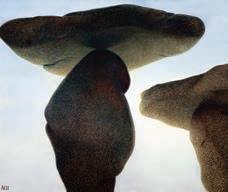
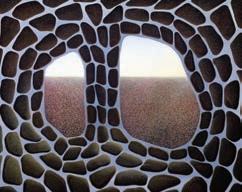

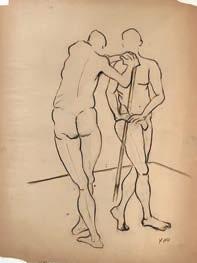

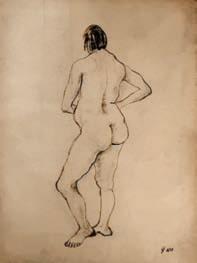

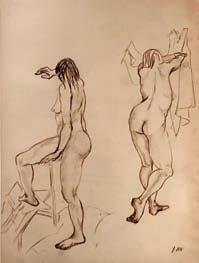
Art and Achievements












Art and Achievements
C AtA log For t HE YUKo NII rE troSPEC t IVE
A Special Exhibition in Celebration of the 20th Anniversary of the Williamsburg Art & Historical Center (WAH Center)
Part 1: Dune Paintings
November 5 – December 31, 2016
Part 2: Stone Paintings, Drawings and Writings
October 28 – December 10, 2017
135 Broadway, Brooklyn, NY 11211, USA. (718) 486-6012 & (718) 486-7372
www.wahcenter.net
wahcenter@earthlink.net
Copyright Yuko Nii Foundation, 2017
ISBN 0-9713874-0-0
Great appreciation to:
Dominique Nahas for the critical essays for this catalog
Orin Buck for book design & editing
Richard Sanchez for editing
Without a doubt, Yuko Nii is a great transformational leader, comparable to other great leaders through the ages, and someone who has achieved a place of high stature for all time.
No one has devoted his or her life, artistic talents and skills and keen judgment to the community more fully than Yuko Nii as she brought life to her art center, the Williamsburg Art & Historical Center (WAH Center). Her intention behind founding the art center was quite honorable: she wanted to fulfill her wish to express her sincere thanks to her generous American benefactors who offered their kind help when she needed. While thinking about how she could return her thanks, an idea was formed in 1996 upon seeing a beautiful historical building in Williamsburg, which excited her tremendously. By purchasing the building and founding the not-for-profit, multifaceted, multicultural art center, she knew that she could help many artists who wished to explore their artistic talents. She went forward to make her dream come true. Once she opened the WAH Center, she has totally committed to her job as an artistic director, creating, curating, accepting proposals from outside curators, and overseeing all art programs and also related business matters.
She also thought of another way to support artists by establishing a permanent collection as an important historical record of the constantly changing artistic climate in the contemporary New York art world. Since 1998 she has been selecting and collecting artworks, mainly those shown at the WAH Center and elsewhere in New York City. The permanent collection has gradually increased in number and now contains over 700 artworks, which have been kept in the Yuko Nii Foundation’s (established in 2008) permanent collection. (See the Yuko Nii Foundation’s Mission stated on the later page of this catalog)
Yuko devoted herself to writing philosophy and essays, encouraging other artists with her honest and wise opinions. She pursues her vision carefully and considerately, making good choices in shaping her vision and by living a good life for the common good of her fellow humans and doing her best in every endeavor.
Yuko is not like the worldly known American artists such as Jack Lenor Larsen, Joan Mitchell, Isamu Noguchi, Georgia O’Keeffe, Jackson Pollock, Andy Warhol and others who have established their own museums or foundations. Yuko,

a woman artist from Japan, has sacrificed her great artist’s career in order to devote the rest of her life to a benevolent cause. To wit, she purchased a monumental New York City historical landmark which is on the National Register of Historical Places with her own limited resources and turned it into a not-for-profit art center, the WAH Center, which serves the public by presenting various art programs.
The WAH Center’s mission is based upon her unique worldly view. She calls it “Bridge Concept” and it has been slowly realized over the last 20 years. Moreover, because of the WAH Center’s limited resources, Yuko has personally labored and made great effort on a daily basis to create exhibits and performing arts programs and many other artistic events with the kind help of many generous volunteers, some of whom have been with the center for more than 18 years, which in itself is remarkable. This must be due to other hidden qualities that Yuko possesses. Yuko often expresses her great appreciation by saying,” I am very thankful for having many kind loyal volunteers who offer their time, effort, energy and talents so generously without which the WAH Center could not have survived.” As far as I know, no women and no Asian artists have made such enormous achievements in the recent history of the New York art world.
Yuko likes to quote Heidegger who said, “We all wear mankind as our skin.” Although It is true in that we are encultured to our species and more locally to our group, some of us seek to explore beyond what is known around us and they seek new horizons. One such person is Yuko Nii who seeks beyond what is there, and explores new possibilities where her mind and heart lead her. She did this by coming
to America, a land where no boundaries of identity hold back a creative individual who believes in one’s self, their mission and their special identity.
Yuko left her country Japan at age of 20 determined to pursue an artist’s career in America. In 1963 she transferred from Aoyama Gakuin University in Tokyo to Macalester College n St. Paul, MN, and after graduated from Macalester College with a BFA in 1965, she came to New York in 1966 to enter Pratt Institute Graduate School, majoring in painting and minoring in art history. In exploring her new world in Minnesota and New York City, she encountered numerous hardships but also many wonderful creative and idealistic people, most of whom were older, more mature, and experienced.
In celebrating the WAH Center’s 5th anniversary in 2001 the WAH Center had a special exhibition “Friends & Mentors” to honor those outstanding individuals who have extended their genuine friendship to Yuko, which lasted for many years. Yuko honored these special individuals as her “friends and mentors” who have traveled a golden path in the arts with creative insights, energy, strong commitment and endurance, who can be looked upon as models of the highest ideals. (Please see the photos of Yuko’s friends and mentors on pages 3 & 4.)
For this special exhibit Yuko produced a catalogue in which she said, “Even during those difficult times, the wisdom I learned from my friends and mentors never escaped me. The accumulated wisdom was a sustaining force behind me. As Jack Lenor Larsen demonstrated, in order to realize one’s vision, one must do much of the work by oneself to make sure that each small detail is in place. From Isamu Noguchi, I learned that one must not limit one’s boundaries, but, ‘have an open view of the world to face challenges in many new directions.’ My art professor at Macalester College, Jerry Rudquist, taught me what it was to be a good leader, ‘never discourage, rather encourage others.’ From Toshiko Takaezu, I learned that while exploring the bridging of Eastern and Western traditions and the synthesis of many artistic disciplines, ‘one must take only the essentials, and balance them most harmoniously.’ The wonderful creative couple, Ansei and Toshiko Uchima, taught me that in creating something, ‘don’t waste time arguing; it only results in exhaustion, to no good end. Work lovingly!’ And Esteban Vicente taught me, one must work ‘persistently and consistently, with sureness of heart and mind.’ And I would like to express my heartfelt
appreciation to my greatest friends and mentors, my parents, who have provided me comfort and security, as well as deep love and understanding throughout my life, and who taught me values, respect, and broad-mindedness.”
Thus, Yuko learned the valuable wisdom from her great friends and mentors, which has nourished her development/growth to be a mature human being.
As E.E. Cummings said, “To be nobody-but-yourself—in a world which is doing its best, night and day, to make you everybody else—means to fight the hardest battle which any human being can fight; and never stop fighting.“
Thus Yuko never stops challenging herself in pursuing her dream and ideal goals. As she was not given everything she has achieved, she knew she had to start with nothing but intelligence, creativity, insight, and perseverance. While she was pursuing painting as her main career, she taught art and art history at a private high school in Manhattan and woodworking in Brooklyn. After quitting teaching she supporting herself as a printmaker, graphic designer, stage set and costume designer, fashion designer, and as a writer in journalism, poetry, fiction, essays and philosophy, and writing for newspapers and magazines. She said that all of this hard work has enriched her life with deeper understanding and appreciation for all human beings.
It’s historically important that the public should acknowledge Yuko Nii’s significant contribution to the art world. Her accomplishments should serve as an inspirational model for other people, especially artists, both men and women.
The WAH Center is pleased to present the art of Yuko Nii in celebration of the 20th Anniversary of the WAH Center. All of the energy and creativity that is reflected in Yuko’s creation of her art center springs from the same well that has created the remarkable and monumental paintings we see in this exhibit.
Her own art, her magnificent paintings, reflect her life, being serene, philosophical, graceful, imaginative, and spiritually endowed.
Here in this exhibit, “Stone and Dune,” we see the strength and spiritual vision that has carried Yuko far in life through great adventure and high achievement. One can see in her art why others have cherished her great qualities not only as an artist but also as a human being.

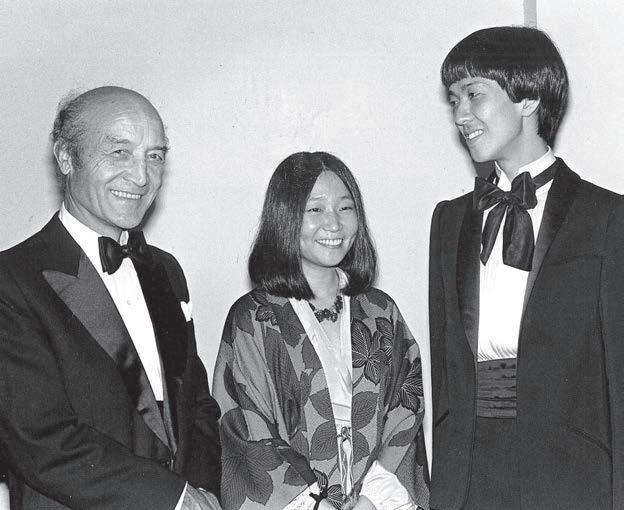
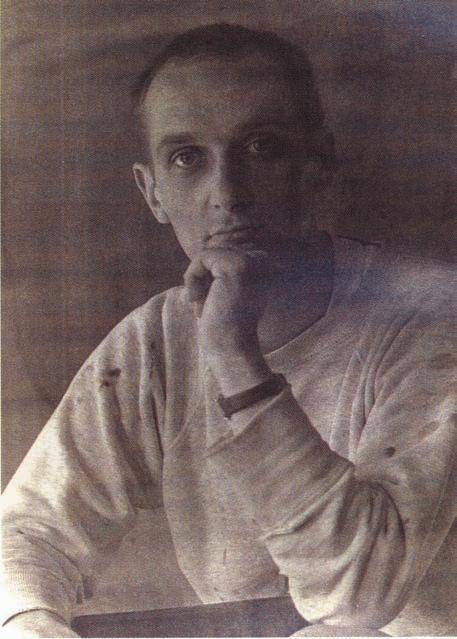
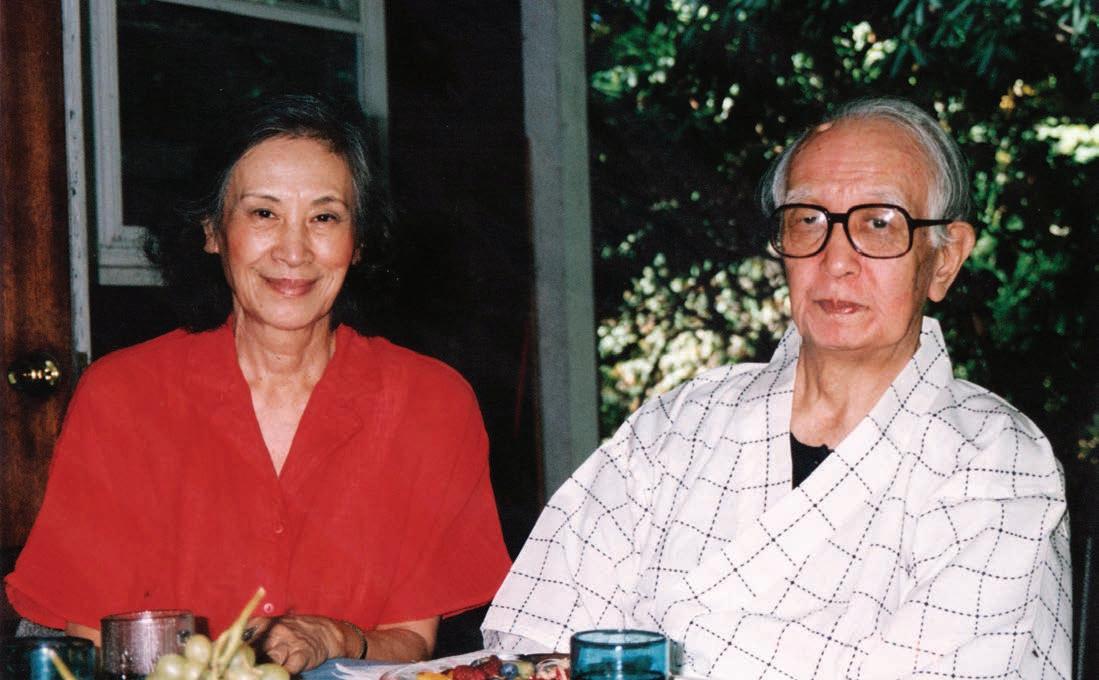
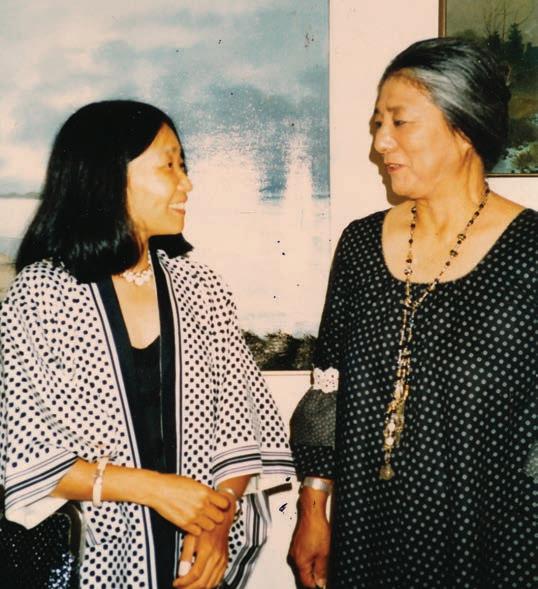

The success of a college is measured in the lives of its alumni. By that standard, Macalester College has much of which to be proud. Some of our alumni have had a very visible impact on the world, including Kofi Annan ’61, Secretary General of the United Nations; Walter Mondale ’50, Vice President of the United States; Tim O’Brien ’68, among the most important novelists of the past half-century; and Siah Armajani ’63, world-renowned sculptor. Many others have had an impact that might be less visible but is no less meaningful.
On any list of our most impressive graduates, we must include Yuko Nii, class of 1965.
Yuko has embodied in her life and work the values that are most central to Macalester. We are, and have long been, a college with a strong internationalist mission, and Yuko’s story of journeying from Japan to pursue her artistic dreams in Minnesota is a story that has been enacted by hundreds of Macalester students over the decades. Macalester was one of the first and only American colleges to enroll students from the Japanese internment camps during the second World War; we continue to enroll students from all over the world—ninety countries are represented in our student body—and to encourage all in our community to bridge cultural boundaries and barriers.
As an artist and a writer about art, Yuko exemplifies too the centrality of the fine arts to the liberal arts. Her work is both beautiful and meaningful. It is also breathtakingly ambitious, reminding us of the most famous lines from Robert Browning’s poem about the artist Andrea del Sarto: “…a man’s reach should exceed his grasp/Or what’s a heaven for?” Clearly the same is true for a woman.
Finally, Yuko’s effort to establish the Williamsburg Art & Historical Center, which helped transform the northern part of Brooklyn and expand access to the arts, embodies the commitment to service that is also central to the mission of Macalester. The extent to which she has made others more important than herself is a model for us all and reminds us that there is no work more valuable than the building of strong communities.
All of us at Macalester are deeply proud and honored to have been part of the life of Yuko Nii and congratulate her on the occasion of this celebration of her life and work.
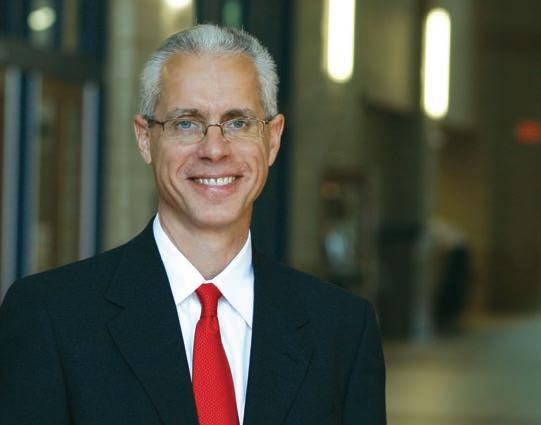
In my 23-year tenure as President of Pratt Institute, I have had the opportunity to meet many of the Institute’s illustrious alumni. Among them, Yuko Nii, a 1968 graduate of Pratt’s School of Art and Design, stands out as an outstanding example of Pratt’s mission to educate creative professionals to be responsible contributors to society.
Throughout her time at Pratt and since, Yuko has demonstrated the habits of intellect and quality of character that spurred her to try harder and care more, to question what others simply accept, and to persevere, rather than retreat, when faced with challenges. Each of these attributes contributed to the success of the Williamsburg Art & Historical Center, the 20th Anniversary of which is celebrated with this remarkable retrospective of Yuko’s work.
Pratt Institute was proud to present Yuko with the 2013 Alumni Achievement Award for her commitment to community in recognition of her work to establish and oversee the WAH Center. Today, I am equally proud to recognize Yuko on this occasion, for her work aligns with so many of the Institute’s values and tenets, particularly its commitment to historic preservation, its interdisciplinary approach to creative education, and its long history of benefitting the community of which it is a part. From recognizing a need within the fledgling North Brooklyn artistic community and seeing the potential in the historic Kings County Savings Bank to founding and running a thriving multipurpose art center that brings together artists and art aficionados from a range of backgrounds and creative practices, Yuko’s work is a testament to her tremendous vision, perseverance, and determination. These are qualities that Pratt aims to instill in each of its graduates—and Yuko is a wonderful example of the transformational impact that one person can have. Indeed, Yuko Nii’s significant contributions to the arts in Brooklyn have made her a remarkable role model for the entire Pratt community.
On behalf of everyone at Pratt, I extend heartfelt congratulations to Yuko Nii and best wishes for another exceptional 20 years!


November 5, 2016
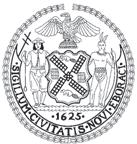
Dear Friends:
I am delighted to welcome everyone to the opening reception for “Stone and Dune,” the Yuko Nii Retrospective in honor of 20th Anniversary of the Williamsburg Art & Historical Center.
New York’s diverse cultural energy has long attracted and inspired artists of all backgrounds. Founded in 1996 and housed in an exquisite landmarked building in one of Brooklyn’s most vibrant neighborhoods, the WAH Center exemplifies our city’s global creative mindset through its multi-disciplinary programs that showcase works of all genres by talented established and emerging artists from the borough and far beyond. As you gather this evening to celebrate the Center’s milestone anniversary and pay tribute to its founder, Yuko Nii, for her visionary leadership, I applaud all those associated with this wonderful organization for their efforts to unite and lift up the Williamsburg community and enrich the cultural vitality of our great city.
On behalf of all New Yorkers, congratulations on 20 wonderful years and best wishes for continued success.
Sincerely,

Bill de Blasio Mayor

By Dominique Nahas
It is fascinating to look at Yuko Nii’s earliest work (1963-5), completed at Macalester College. Her geometric abstractions with their crystalline constructed facets throb with coloristic intensity against pungent, dream-like backgrounds. Later, these hard-edged formats seem to have melted and liquefied into biomorphic, ovoid and amoebic forms whose embracing curls and curves swirl together and sensually pulsate in her “Fluid” works of 1965-6. These remarkably billowing and sensual paintings have nesting interiorities that recall fluids within an amniotic sac. The floating embryonic quality also suggests an airy and dreamlike imagination at play, in which a gravity-less, lubricious world delights as it seduces the eye. Nii’s mind-set has created painterly forms, colors and passages that recall wisps of clouds which in turn recall a condition of reverie, defined by Gaston Bachelard in On Poetic Imagination and Reverie as “…an oneiric activity in which a glimmer of consciousness subsists, [in which] the dreamer and [her] reverie enter totally into the substance of happiness.” Yuko Nii’s vivid, numinous vision, one that she has nurtured and honed over years of mindfulness and devotional care, embodies Herbert Marcuse’s apt commentary on the creative imagination in One Dimensional Man. He writes that art is a location, a designated imaginative space as well as a psychic location where one allows for a recombination of experiences where freedom is experienced. He continues by describing art as embodying a tension that keeps hope alive—a “memory of the happiness that once was, and that seeks its return.”
Throughout her painting practice Yuko Nii has created worlds of beauty in which longing is strongly felt. The artist’s creation of worlds has a stilled, primordial, timeless quality that somehow is imbued with a yearning for connection and continuity while accommodating a ceaseless presence of change. Nii has used her visual work as a means of grounding herself in a meditative work while providing herself with an activity that serves as a field of inquiry and as a vehicle for a profound sense of wonderment. Her work as a whole uses natural signifiers (rocks, sand, sky) as a means to ask perhaps imponderable questions about the origins of mankind, of our planet, of the cosmos and our place in it. While Nii has painted the appearances of realworld objects, conditions or terrain on closer examination we can see that such investment in depicting Nature seems more as a means than an end in itself. Nii‘s paintings have a
strong symbolic dimension and are captivating explorations into perception, sensations and essences. Her visual work reflects complex inner states (often conflicted) as much as they are outer visual manifestations that might nominally be called landscapes. Thus, they appeal as much to the eye, the mind’s eye as well as to the entire body of the beholder. In this sense Nii’s objective has been to make her work and her work’s vision as dynamic and immersive as possible. In order to do this the artist has applied over the years several strategies conceptually and pictorially. One method invokes a sense of drama and mystery by suggestively playing with scale within the pictorial field itself, using a finessed sense of spatial ambiguity. It is not coincidental then that the strong quality of presencing permeates all of her painterly work; and that a strong animistic aura radiates in and through Nii’s work in which scale is explored as a basic key to Buddhist thought. Another technique is depicting light (or darkness) with a marked sense of distilled equivocalness that seems to transfigure her forms and compositional elements. Yet another is to create vast painted panoramas, energetic fields that encourage a reaction on the part of the viewer that Joseph Campbell termed “aesthetic arrest”—a condition in which, as part of the aesthetic experience, one experiences a radiance through the experience of simply beholding the object.
Yuko Nii’s pictorial, compositional, coloristic and scalar strategies have allowed her to create unforgettable images that vibrate with energy. In large measure this has been due to the artist’s capacity to magicalize her painterly surfaces through her distinctive touch and in doing so to energize her artworks with a pronounced animistic aura. Nii creates highly distilled atmospheres that seem distanciated and unnervingly Other. Moreover the artist has gone to great lengths to induce a sense of ensoulement that permeates her forms and scenes.
Yuko Nii’s paintings from each of her stages of development have as a marked quality a suggestion that the ground of life is immaterial soul rather than the material body itself. For example, it is quite clear that ensoulement and dualisms pervade Nii’s decade-long “Stone” series originally produced as part of the artist’s graduate studies at Pratt Institute in 1966. The co-incidence of opposites in this series operates on different levels. The depicted stones themselves are ambiguously scaled. It is never quite clear if the stones are magnified pebbles or stones or if they are the
size of boulders as they exist in a world of soft lighting and undifferentiated backgrounds. Furthermore Nii begins to develop a system of painting using clusters of individual dots to create the illusion of three-dimensional form. She writes in her notes: “Each stone is depicted as a full form made up of aggregates of smaller material, numerous grains of mineral chemically compounded and bonded as solids to form what we see as a stone object.” This series philosophically intimates a pantheistic frame of mind in step with a transcendental doctrine of knowledge that is idealistic and intuitive and that posits the immanence of the divine in finite existence. The coincidence of opposites is further explored compositionally in this series as references to the precarious balance of a stacked pile of individual rock entities reaching toward the sky as in the painting The Way Is Up, is matched by a unitary view of a stable rock mass (Edge of Evening). These two types of stability, in turn is matched by images of destabilization such as Flux, which ambiguously depicts monoliths either floating up or descending from the sky and Over the Abyss in which Nii paints various contoured rock forms of unspecifiable dimensions hurtle downwards from the sky, evoking the terror of dissolution or the awe of eternity.
Yuko Nii’s “dotism”—her self-described mark-making system, with its creation of softly flickering surfaces, reaches its apogee in her unfinished magnus opus “Spectrum Planet Dune Series” the last of her overall “Dunes” series, a collection of paintings that stretched over two decades (1976-1996) of work. The “Spectrum Planet Dune” series consists of 9 paintings spreading horizontally along a 63-foot length with the spectrum colors Black, Purple, Indigo, Blue Green, Yellow, Orange, Red and White. With its points of color as well as the repetitive motifs and imbricated patterns that circulate in this otherworldly landscape “Spectrum Planet Dune” seems to be the capstone to Nii’s advanced, directed kind of self-awareness. Her last work seems poised to raise the ultimate metaphysical riddle: does a greater inward awareness allow one to become one with “all space”?
Nii’s laboriously intensive meditative technique of placing small dots next to each other to create contour, form and shadow recalls George Seurat’s Divisionism yet Nii’s visual harmonics and her unique touch are distinctly her own and belong to the new century as her paintings suggest emanations from large-format digital projection screens.
This post-modern technological inference is contradicted, paradoxically, by the aura surrounding each of Nii’s handmade, unique works (large or small) which seem imbued with the intimate and devotional feel of pre-modern sacred art forms that are decidedly not-Western, such as Tibetan Sand Mandalas created incrementally by Buddhist monks over a number of days, using millions of grains of colored sands and also “ karesansui”—Japanese Zen gardens of raked sand and stone. Each grain of sand (each “dot”) in Nii’s painterly universe is viewed through the notion of correspondences (think William Blake and the Hermetics) that proposes that if one could really see, everything would be double, micro- and macro-cosmic. And that really “seeing” means seeing the non-visible, which in turn implies an understanding of cosmogony as incarnated and enlivened through the effects of opposites working on each other, among them the “as above, so below” dualities participating in enantiodromia. Enantriodromia is similar to the principle of equilibrium in the natural world, in that any extreme is opposed by the system in order to restore balance. When things get to their extreme, they turn into their opposite. This principle, explored in antiquity by Stobaeus, Heraclitus and Plato points to the reflexive tensions that hold harmonies together (think principles of traditional Chinese religion—as in Taoism and yin-yang). Carl Jung re-introduced this principle as it pertains to the make up the psychic world in which there is an emergence of the unconscious opposite in the course of time; a dynamic, an attribute, a sensation transmogrifies into its shadow opposite.
Yuko Nii’s aesthetic vision, seen as a whole, has affinities with the creator’s personal characteristics of strength and generosity. For Nii, painting as entrancement and as devotional object has been key to her vision as is her ethic of sharing and connecting. Ultimately Yuko Nii’s singularly evocative painting practice embodies a collective realization of our dependency on something greater than ourselves.
Dominique Nahas ©2016
Dominique Nahas is an independent curator and critic based in Brooklyn. Mr. Nahas, a former museum director and curator and New York Editor of dART International, teaches critical theory at Pratt Institute. He was one of the contributing essayists in the recently published monograph “Unfinished Memories: 30 Years of EXIT ART” (Steidl Verlag, 2016)
My approach to art might be considered a combination of Zen ideas with Western philosophy. Zen teaches that the word is timeless, the moment of “now” is eternal, and the past and the future are merely illusions. Normally when we see things as “having happened” or about to happen, we are just seeing different aspects of the one eternal Now. The view from our individual aspect in the eternal gives us the illusion of linear time with past and future. But actually all events occur at the same time, the one time.
Looking from the oneness of things to the duality through which we view the world, by which we are able to distinguish among things and act within it, I am always consciously aware of that Western concept of dualism (opposites) such as hot/cold, soft/hard, expansion/contraction, stable/ unstable, tranquility/uneasiness, etc. It is through the relationships and interactions of these opposites that life takes form to create living activity and dynamism. And it is the tension between these opposites that gives you a feeling of expansion and lyricism.
As Kandinsky tried to interpret music into the visual language of painting, I wanted to express the concept of the philosophical synthesis of Zen and Western philosophy in my painting. It gave me a great challenge.
First, I chose stone as my subject matter, not as a copy from nature, but from imagination, for stone for me exists in the timeless, eternal world. I also feel close to stone, perhaps because it is a part of nature that has been so familiar to man throughout the ages, and also because I am originally from Japan, a country whose traditions, life, philosophy and spirit coexists harmoniously with that of stone.
In my stonescapes, monumentally large stones are piled one upon the other, making precarious balance, or falling down, or shooting up into the air. This feeling of uneasiness or instability of movement is lessened by the eternal soft lighting behind the canvas, thus creating a tension between stability and instability, tranquility and uneasiness, giving the feeling of expansion and lyricism. At the beginning, the stones in my paintings were quite large. But as I continued to paint more of the stone series, the size of the stones became smaller and smaller, changing to pebbles, and finally became grains of sand, just as nature causes weathering phenomenon over a long period. After that, I started painting dunescapes. Dune is how nature shapes grains of sand.
It is interesting to note that stone and dunes are made of the same substance, but they are quite different in appearance and characteristics. Stone seems immutable, solid, heavy, powerful and monumental, which suggest a masculine nature —“Yin.” And stone goes through long weathering process to transform into sand and dunes with soft lyrical flowing appearance which suggest a feminine nature —“Yang.”
In my stone and dunescapes I use a technique called “dotism.” For the stone work, I used the “dot” technique only on the surface of the stones, leaving the atmospheric background plain with no “dot” texture as we see on the stone. But for the dune series, I applied dots not only to the dune images, but also to the atmosphere in the overarching sky. I realized that since atmosphere is in fact composed of millions of invisible molecules, it was therefore appropriate to express that molecular quality of the atmosphere with numerous dots, and that this also helped bind the entire surface of the painting together By painting innumerable dots with complimentary colors side-by-side, optical repulsion and fusion elicit a tension and excitement in the eye and mind. The dunes’ undulating surface, like ocean n waves, dissolving and reforming, evoke a sense of uneasiness which is enhanced and held together by the precisely controlled use of dots, creating a poetic lyrical quality. The concept has to do with the substratum of life itself, eternal newness and change, all at once and together one, the parts and process creating a monumental whole. For in Zen, all is one thing, even the multiform transformational dualism of Western thinking.
The dunes represent open spaces with infinite possibilities, endless empty stillness within which change take place at an immutably slow pace, well beyond our ability to perceive. When I paint I am totally absorbed, and hours go by as if in fugue, I am neither hungry nor thirsty. I feel I am in a deep meditation, in a timeless world, far removed from immediate natural human concerns. Stone and dunescapes allow me to find inner peace, retreat from the hasty crowded world we live in.

In this exhibit we start with her most “recent” paintings on the theme of Dunes. I put “recent” in quotes because Yuko stopped painting around 20 years ago when she opened her art center.
The very last dune series Yuko worked on was “Spectrum Planet Dune” series which consists of 9 paintings (84” x 60” each), spreading horizontally along a 63 foot length with the spectrum colors in order from left to right: Black, Purple, Indigo, Blue, Green, Yellow, Orange, Red and White.
Since she had already done the imaginative Earthy Dune Series, the four seasons “A Quartet Dune Series,” and also the “Planet Dune Series,” she was challenged by the idea of the “Spectrum Color Dune Series” since she is a painter always dealing with the spectrum of colors on her palette.
Yuko’s subject matter gradually transitioned from her stone series to imaginative dunes and she continued to use the dotting technique in this next phase. This transition was a very natural step just as, in natural weathering process, stone transforms into pebbles and eventually and naturally to grains of sand, forming dunescapes.
The scale of the work is as important as the technique itself. The paintings are large enough (over 5 feet) so that the viewer standing before the work can actually feel himself or herself in the physical presence of the dune landscape, though imaginary. It is almost a virtual reality done without the use of goggles and computers. Monet’s water lilies have the same effect although done with a totally different “impressionist” technique called “pointillism.”
The ultimate measure of Yuko’s ambition and achievement is seen in her 63-foot long Spectrum Dune Series. The series is composed of 9 large paintings. There would have been more except that Yuko’s vision embraced further monumental tasks in the creation of her Williamsburg Art & Historical Center and her Yuko Nii Foundation.
The series is her “magnus opus,” a grand unfinished symphony.
The video documentary on Yuko Nii by Petar Talijancic, entitled My WAH, covers the scope of the great challenges Yuko has undertaken, both artistically and professionally.
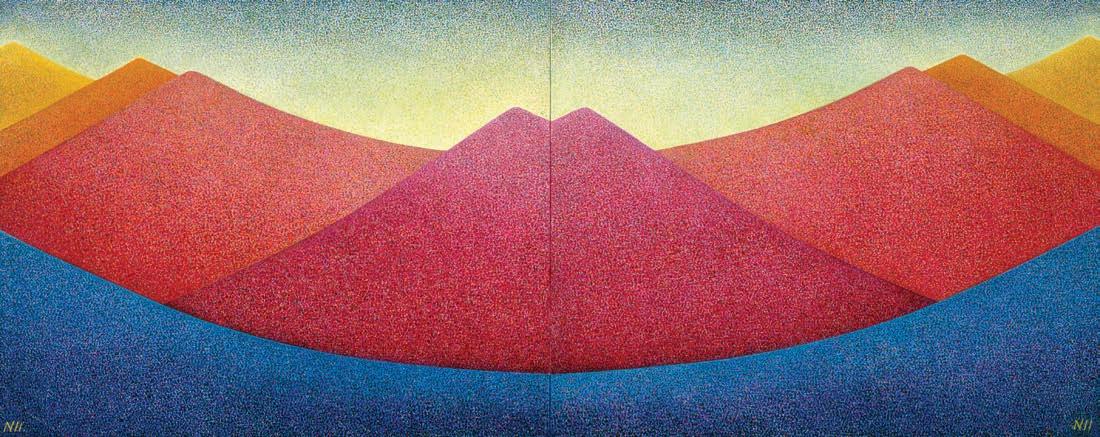
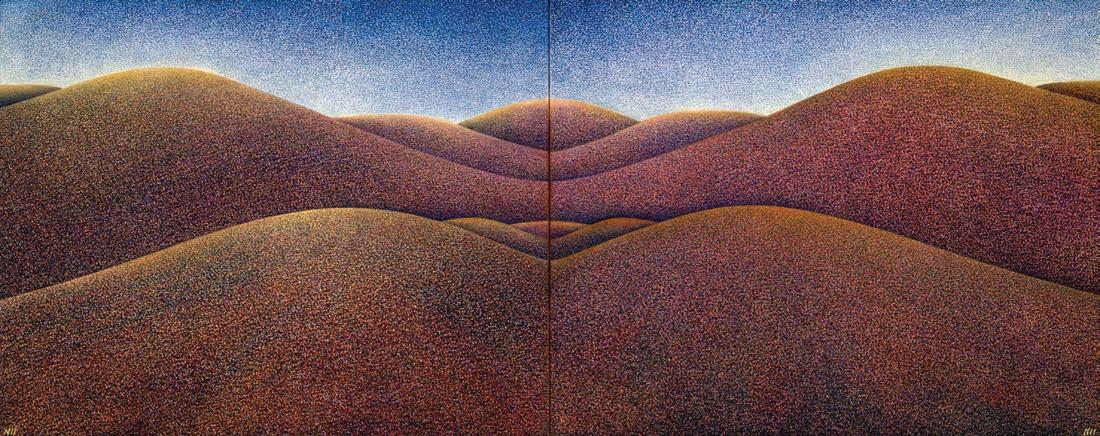
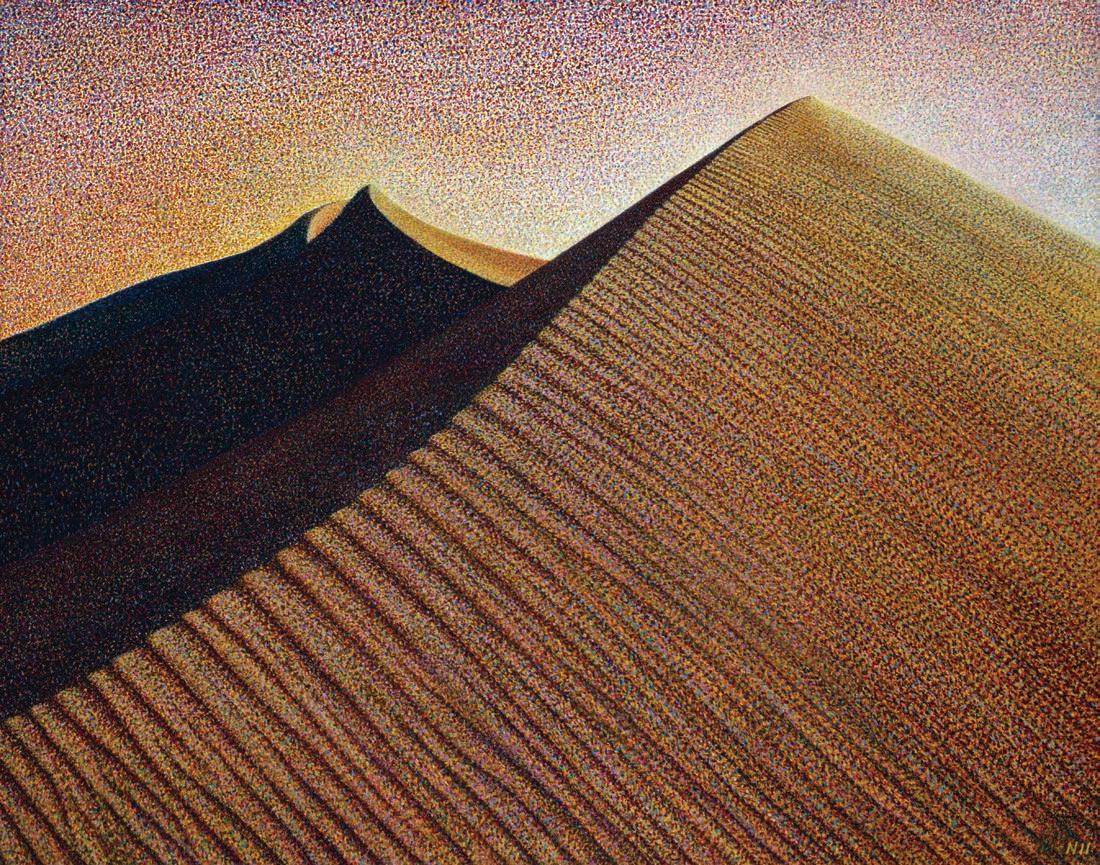
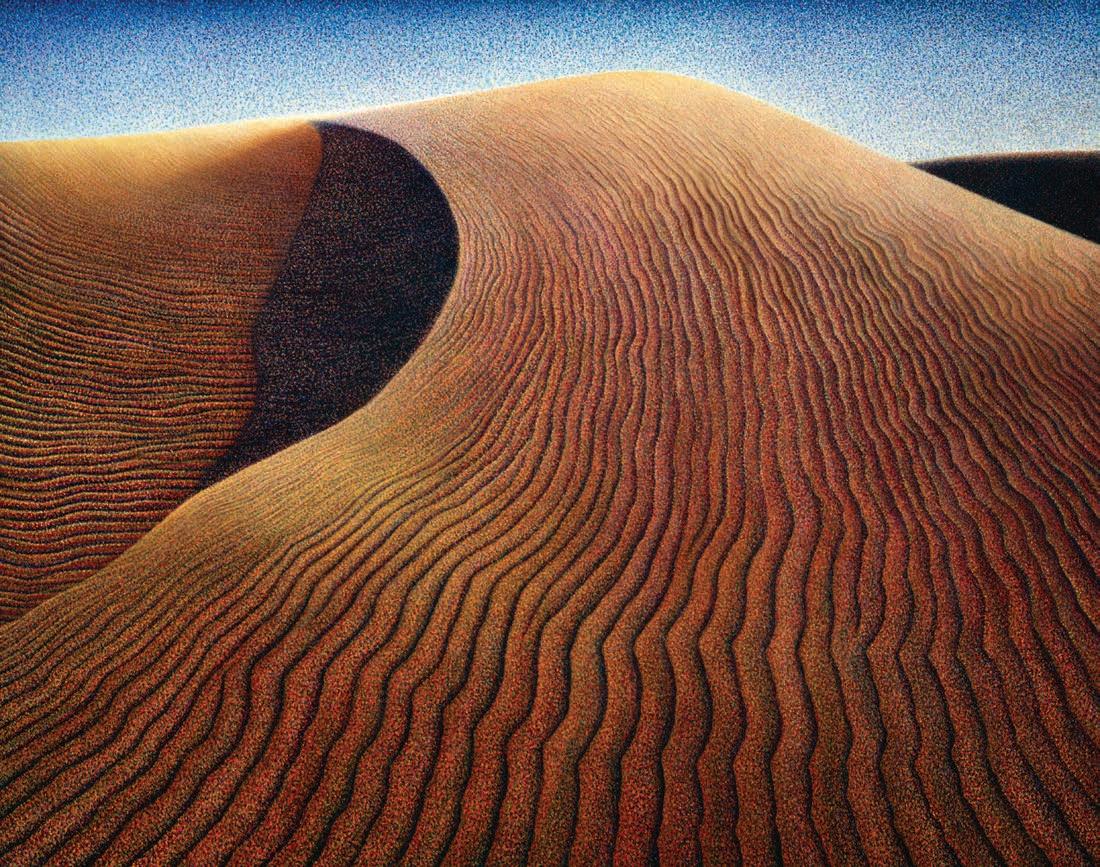
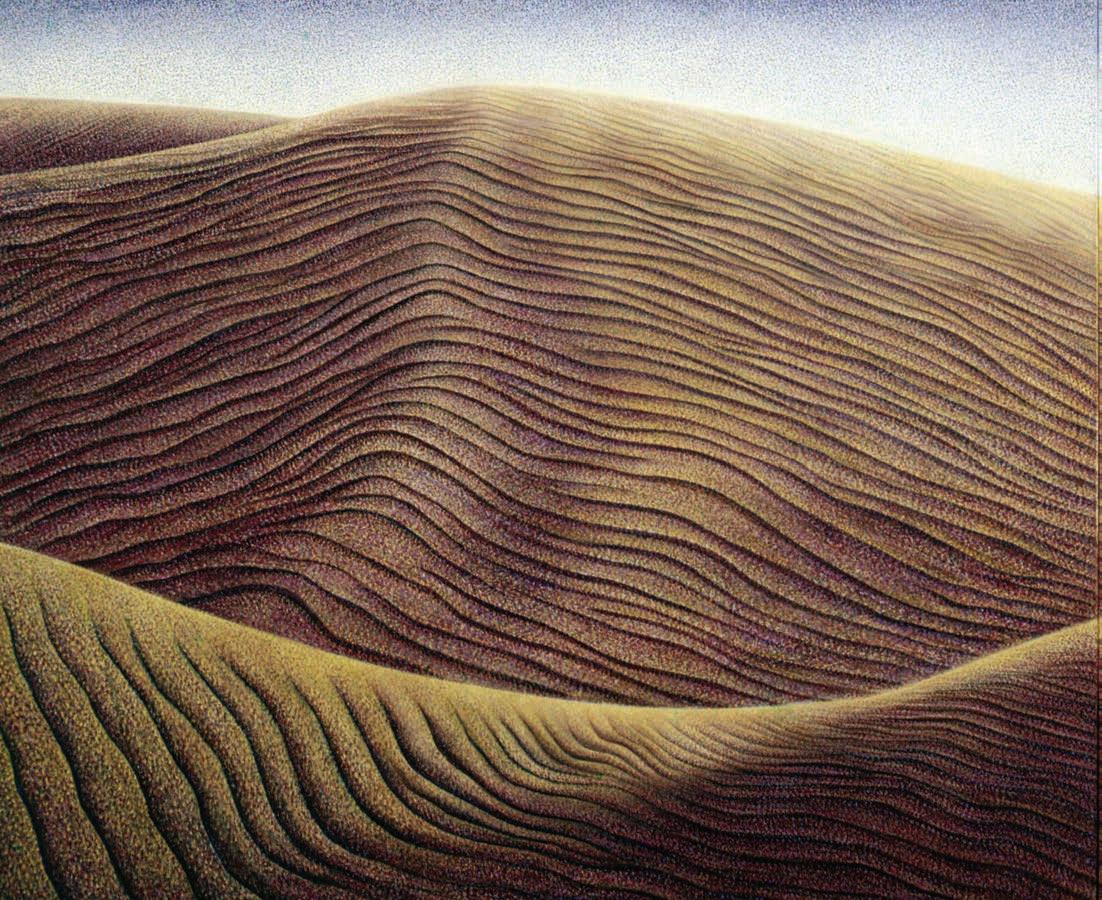
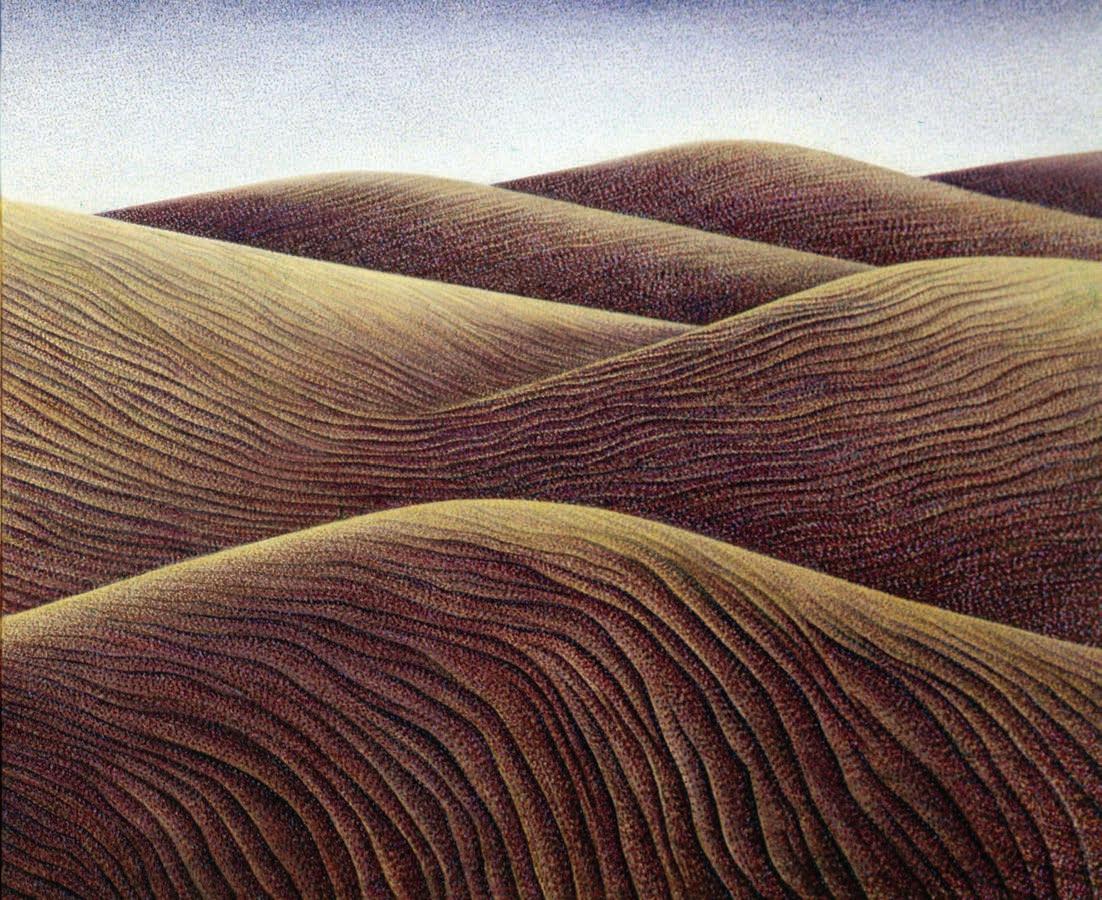


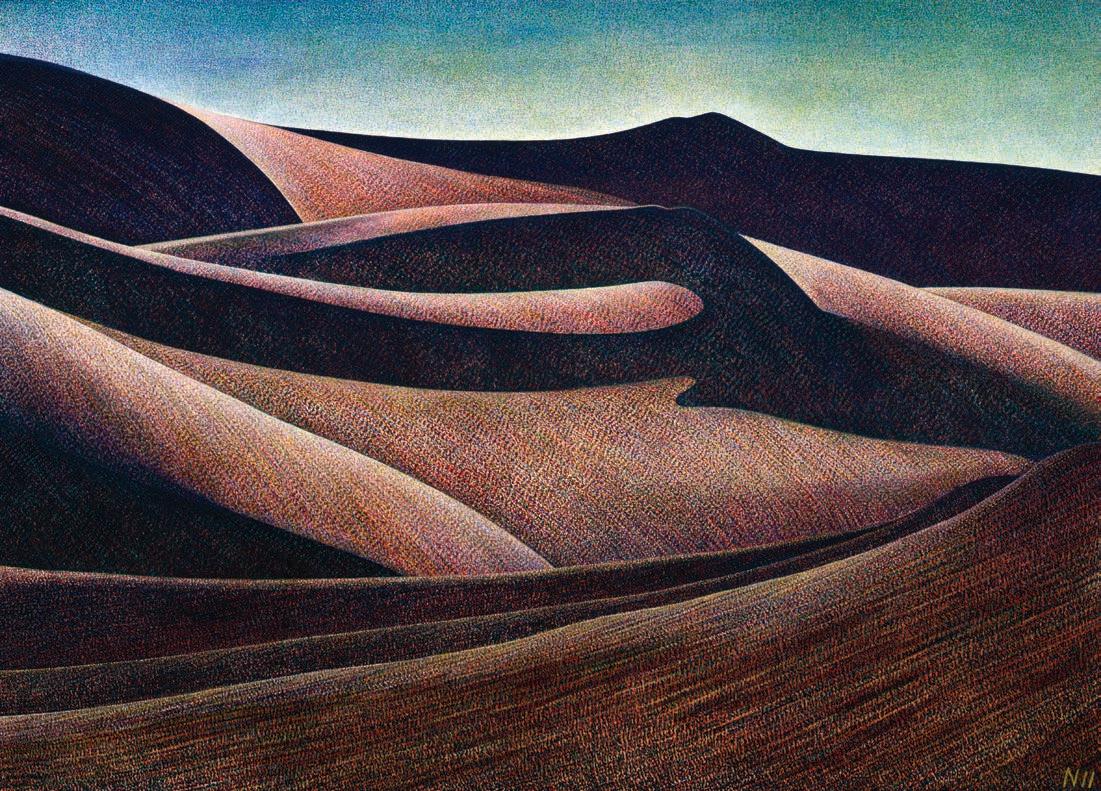

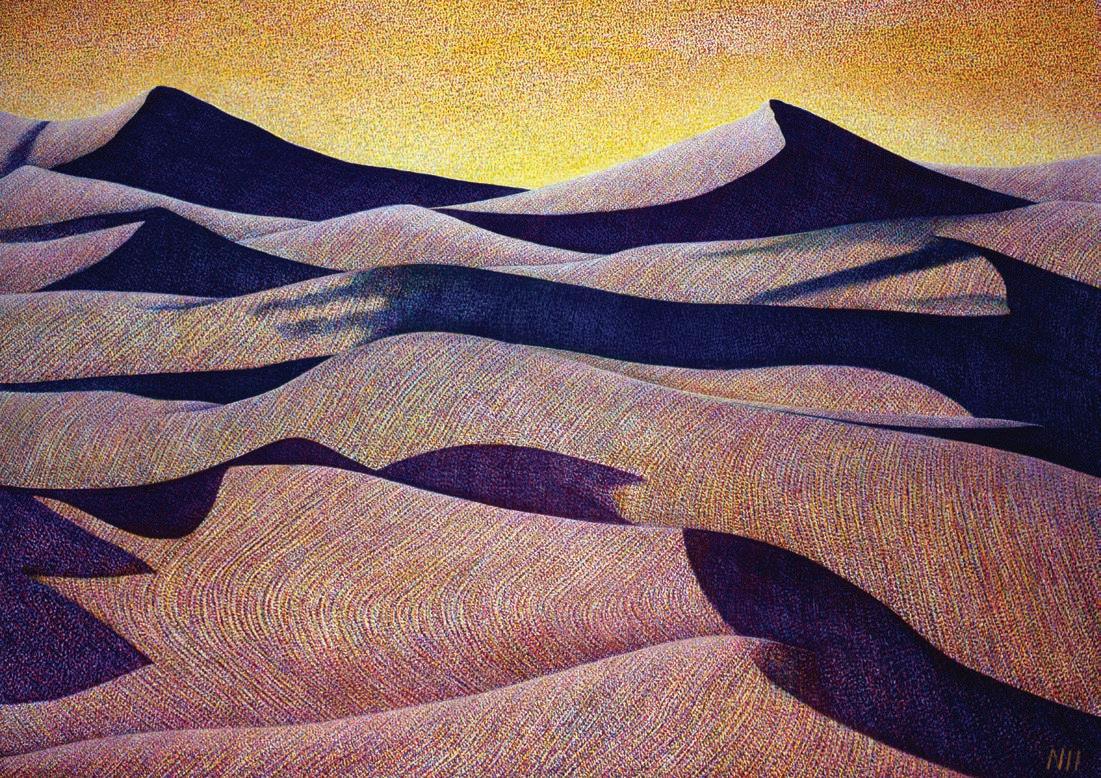

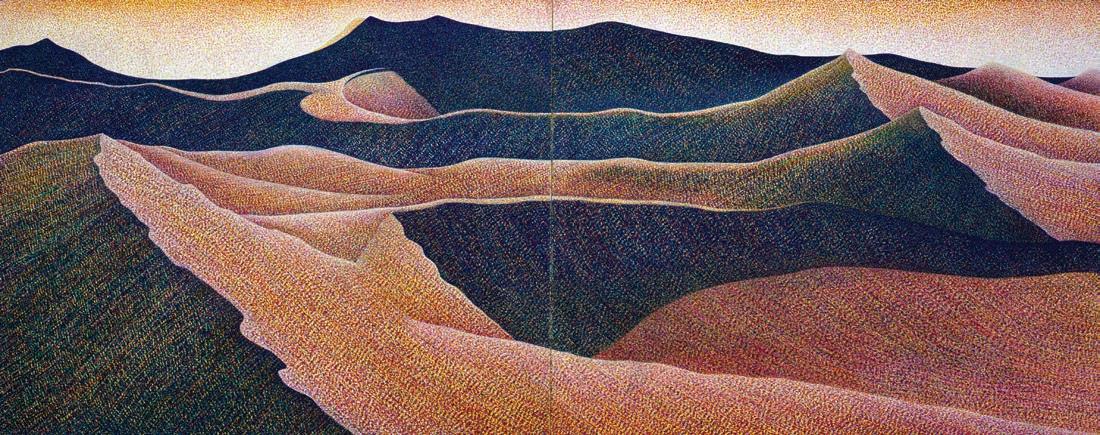
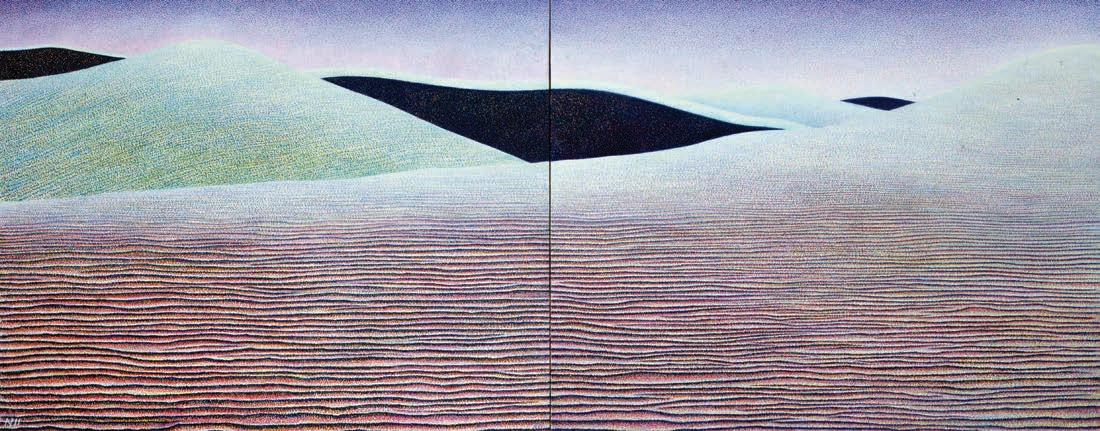
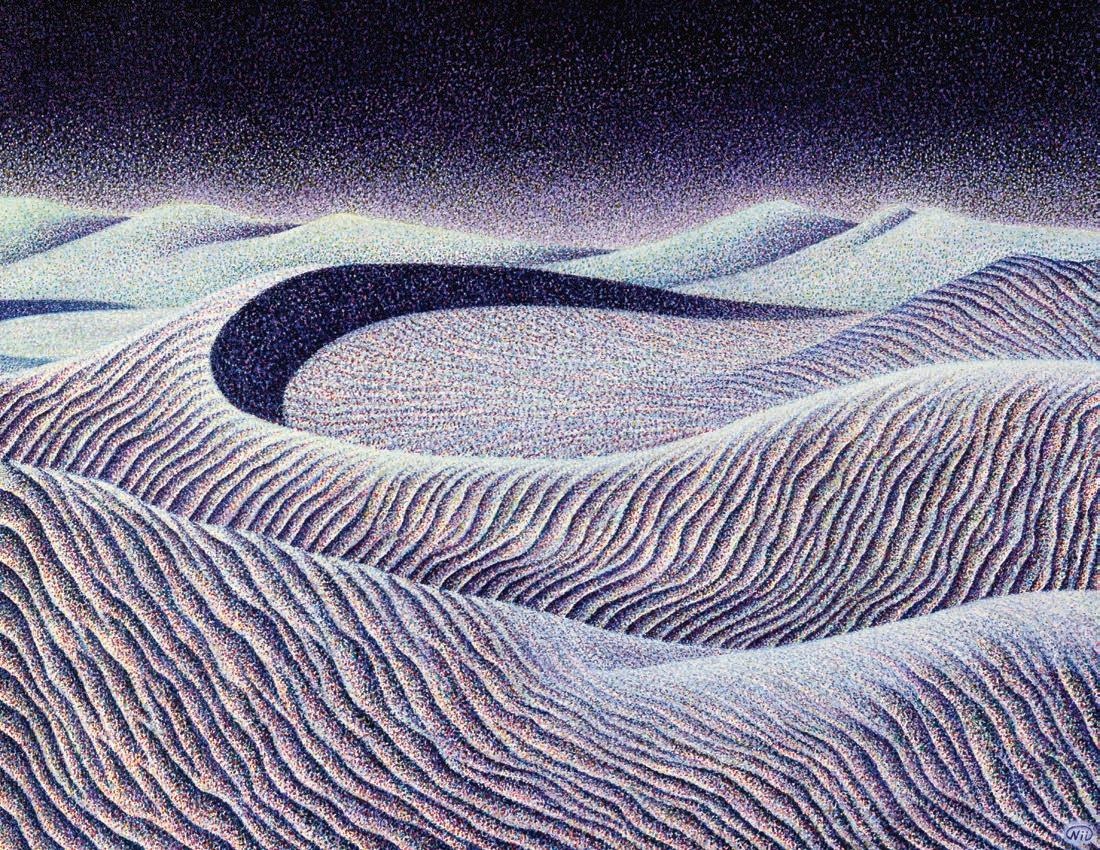


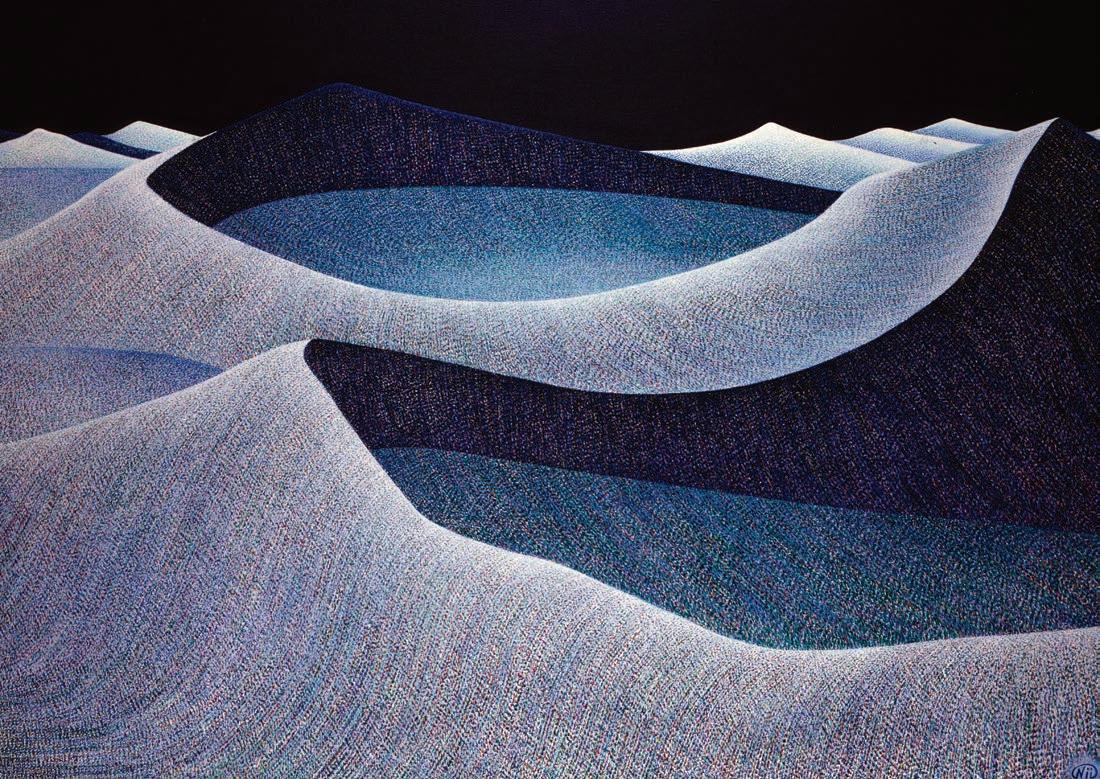
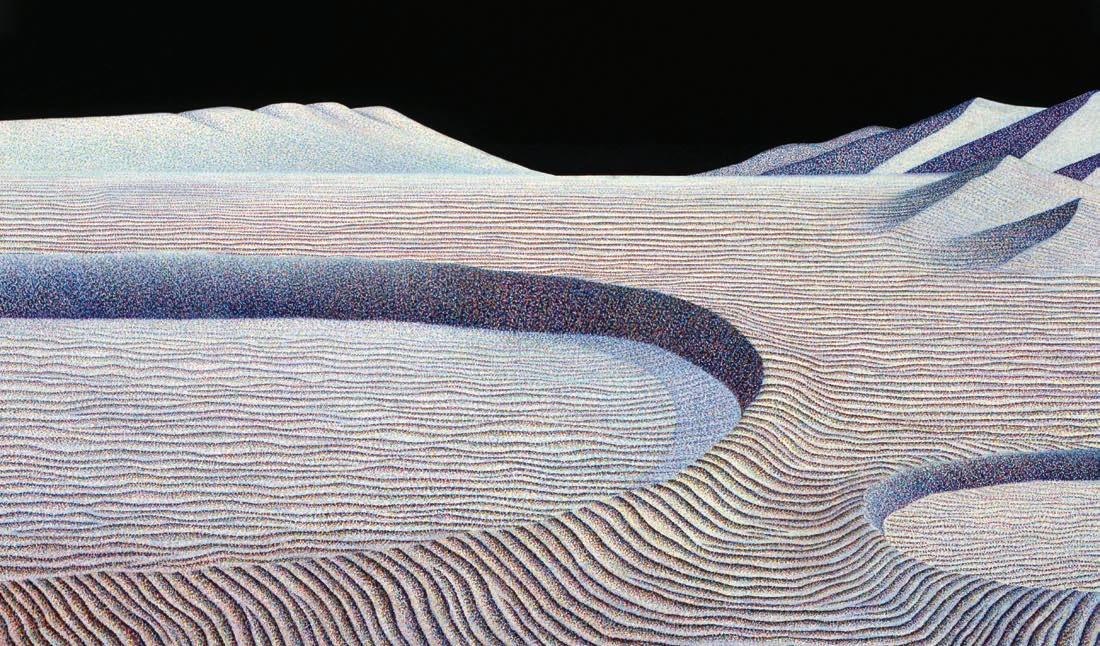


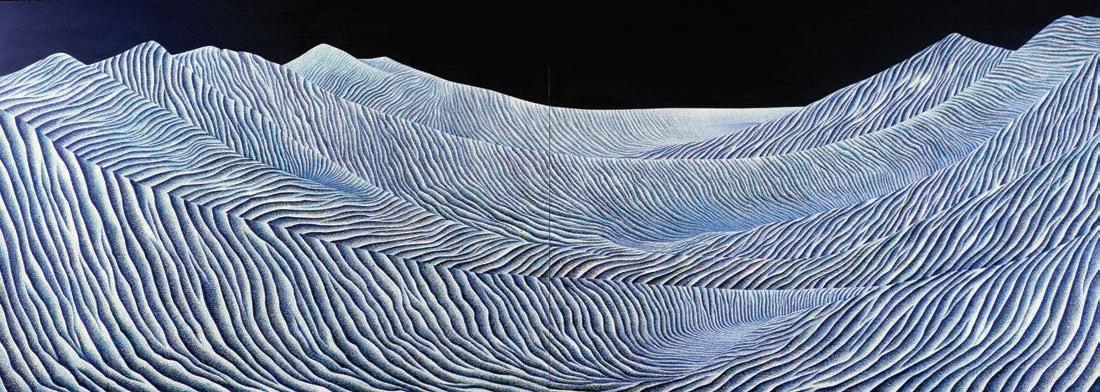




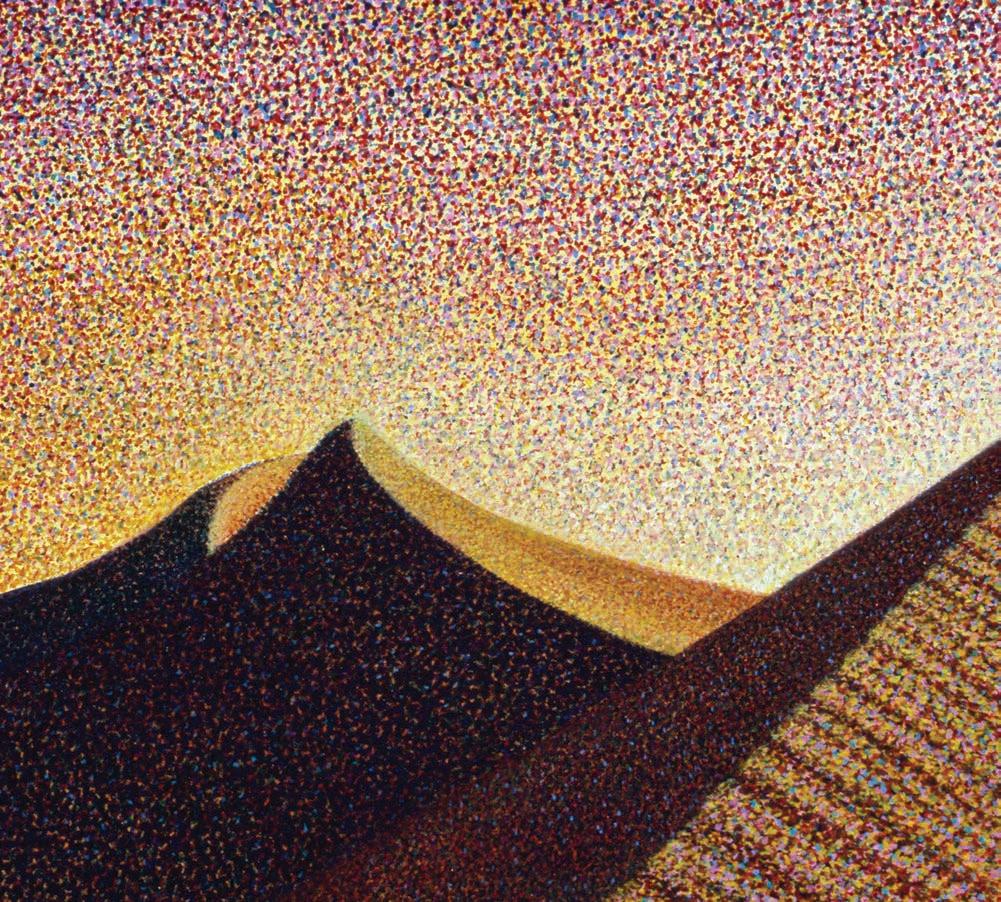

Yuko Nii’s MFA t hesis on Stone,
By Yuko Nii
Man’s life, from birth to death, is a continuous stream of motions and perceptions in limited time and space.
Part of this awareness is an awareness of motivation. Only by the experience of a sequence of events can one have a notion of time. When a man awakens intellectually and begins to be aware of time, he knows his life to be limited. Death is inevitable!
The universe, and each thing it contains, is engaged in the process of either organization and development or decay or degeneration. The larger universe entropies and after this larger process, so follows each of the elements of which it is made. So with time and the entropic process the beautiful machine of one’s life decays.
To prevent the decay of his own body, man attempts to create an order of nature’s tendency to disorder. As bodily life wanes, he must restore it. He must shelter himself from the eroding elements of nature.
What then does each man necessarily and consciously oppose: The natural tendency to chaos and disorder.
With respect to his fellow animals, man has a seemingly vast intellect. It has aided him in his struggle for survival, yet he has reached a point where it now indicates to him the futility of his conflict with nature. The permanence of his existence he knows to be an illusion.
Man has a psychological mechanism that protects him from destructive fears and realizations. He can preoccupy himself with everyday affairs: he can create fantasies of reincarnation and eternal life in religion.
Religion assures him of immortality by maintaining that man transcends the physical world and that the physical world is only one aspect of existence. Science searches for means to lengthen man’s life by controlling nature.
There is another means to delay the impermanence of his existence and that is by re-establishing himself in a permanent world of his own creation through art.
The artist recreates nature—an imaginative and unnatural world of permanent states with harmonious rhythms and
orders—an order which cannot degenerate. The imagination dominates reason and this imagination does not necessarily have to have a logical relationship to the empirical world—it can be a denial of reason that ceases to draw a firm distinction between what is real and what is lies within his world of imaginative fantasy. A work of art itself creates a world of seeming reality by illusion, and this world has a life of its own through which the artist lives the way he prefers. Art releases the intense life of reality into a dream world of imagination.
Therefore, for me art is a means of lessening the full burden of an absurd existence. If I do not paint, what will I do? Eat, sleep, work and seek to be entertained. But I have a mind, a certain intellect and it must function, it must apply itself to some meaningful task. If I choose my task from an objective empirical realty, I must submit to the horror of this temporality that implies that my consciousness (the nature of which is “nowness”) is a nothingness that lies between the future and the past. As Sartre says:
There is a peculiar paradox in this present: On the one hand, we willingly define it as being: what is present is in contrast to the future which is not yet and to the past which is no longer. But on the other hand, a rigorous analysis which would attempt to rid the present of all which is not it—i.e., of the past and of the immediate future—would find that nothing remained but an infinitesimal instant. As Husserl remarks in his Essays on the Inner Consciousness of Time, the ideal limit of a division pushed to Infinity is a nothingness. 1
The nature of my conscious being is to be anxiously pursuing future possibilities with my intellect, realizing that it is never to become “now” except in death.
Indeed, I find that if I am about to consummate some activity such as drinking a glass of water, that activity passes so swiftly into a past activity that it seems impossible to grasp and hold that moment of “now” when I might have said, “I am drinking.” There is the illusion then that the future possible actions which I pursue are never realized in my present but rather slip immediately from the future to the past without ever becoming a real “now.”
To avoid this painful awareness, I must find a means to re-structure my values: I must create for myself a non-temporal world in which my intellect can function freely, indifferent to the truth and finality of death which time implies and the non-ness of my present being.
As Kant says, art is a free play of imagination and intellect: The cognitive powers, which are involved by this representation, are here in free play, because no definite concept limits them to a particular rule of cognition. Hence the state of mind in this representation must be a feeling of the free play of the representative powers in a given representation with reference to a cognition in general. Now a representation by which an object is given that is to become a cognition in general requires imagination for the gathering together the manifold of intuition, and understanding for the unity of the concept uniting the representations. 2
Thus I paint—an application of the intellect and imaginations in molding a world to the form of my desires. In painting, my awareness of the future before me and the past behind me wanes. “Now-ness” expands to become palpable and breathable in the creation of my world.
On high, remote in the sky, above and beyond successive circles of increasingly lofty peaks buries under whiter and whiter snows, in a splendor the eye cannot look on, invisible through excess of light, rises the uttermost pinnacle of Mount Analogue.
There, on a summit more pointed than the finest needle,
He who fills all spaces resides unto himself.
Oh high in the most rarefied air where all freezes into stone, The supreme and immutable crystal alone subsists.
Up there, exposed to the full fire of the firmament where all is consumed in flame, subsists the perpetual incandescence. There, at the center of all creation, is he who sees each thing accomplished in its beginning and it’s end. 3
When I am alone in my studio, I would like to associate with another world—a free world where I can fly with spiritual wings, where I can cry, sing or laugh until the world cracks. The summit of Mount Analogue is my world! ”Where all space resides unto myself—where the supreme and
immutable alone subsists and I can watch each thing accomplished in its beginning and in its end.”
The themes of my works are the three states of matter— fluid, solid, and ether. All of these in their quiescence are isolated in regions beyond the reach of this reality. All is consumed in the incandescence of being—it permeates all substance. It is diffused throughout the volumes of atmosphere and lends its soft radiance and life to the fluid organs and solids that it envelops. This is the ether of being, the vehicle of living substance.
The fluids have pulsating sensuous rhythm spread throughout a vast ethereal gulf. Vaporizing, coagulating, the forms undergo continuous organic change. Here there is a sensual awareness of being.
Last, there is the supreme and immutable rock, which alters all things by the eternal gaze from its opaque eye.
Pendulous in air at the summit of Mount Analogue, its weight looks gigantically down with prophetic silence.
So the atmosphere is the vehicle for all being. The coagulating fluids are the organic and sensual rhythms of change. And the rock is the ponderous weight of quiescent intellect.
Though the general nature of the universe is to entropy, the process is a rhythm of ebb and flow. In some places, there is organization and birth, and in others disintegration and end—there is rhythmic life in this whole process of decay that shows itself in all things.
In my art, I am emphasizing important rhythms and demonstrate them in their purest form.
To see these pure rhythms, I must climb Mount Analogue.
1. Jean Paul Sartre, Being and Nothingness, Trans. Hazel E. Barness (New York: the citadel Press, 1966), p.96.
2. Karl Ascehnbrenner and Arnold Isenberg, Aesthetics Theories: Studies in the Philosophy of Art. (Englewood Cliff, N.J: Frentica-Hall, 1965), p.179
3. René Daumal, Mount Analogue, Trans. Roger Shattuck, (San Francisco: City Lights Books, 1968), p. 39.
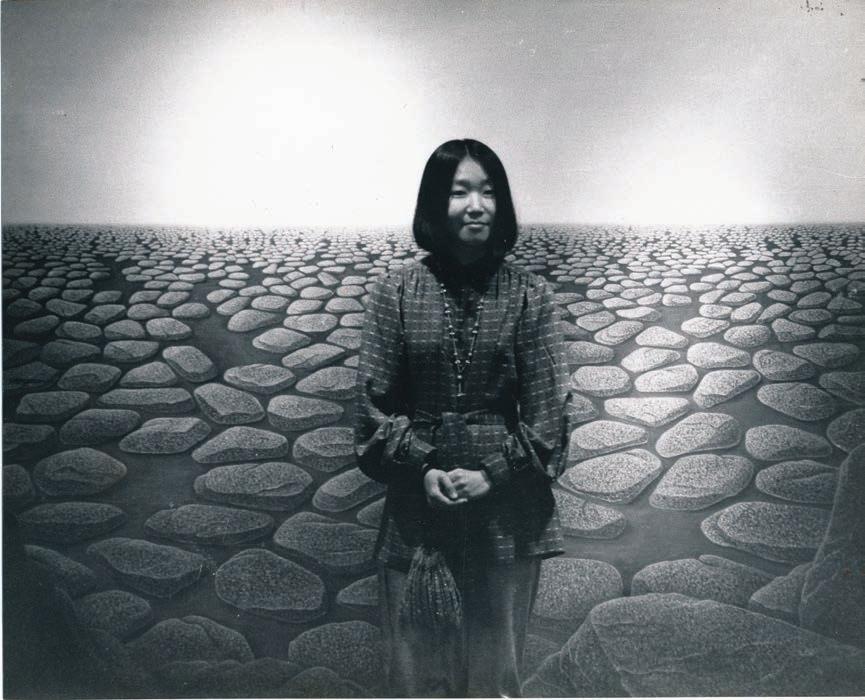
During Yuko’s sojourn in Minnesota, Yuko worked primarily in abstract geometries or expressionistic abstract forms. However, after leaving Minnesota in 1966 to attend Pratt Institute Graduate School in Brooklyn, NY for her MFA, she developed a different style whose subject matter involved more concrete and philosophical concepts. There, at Pratt, Yuko chose Stone as her subject matter, and applied her own technique that has been mentioned previously as “dotism” to her stone paintings.
Yuko states, “…most stones appear to be solid and heavy units, but they are in fact composed of numerous grains of mineral chemically compounded and bonded as solids to form what we see as the stone object.” Yuko’s numerous “dots” appearing on the surface of stone depict this abundance of bonded granular minerals in a stone, and also the texture on the stone surface.
Yuko’s stones are not copies from nature. She is not a landscape artist. The subject of stone is purely symbolic and imaginative. It is an artistic imagination special to Yuko that derives from an amalgamated philosophy combining Eastern and Western traditions.
Yuko says, “…stone for me exists in the timeless, eternal world. In my stonescapes, monumentally large stones are piled one upon the other, making precarious balance, or falling down, or shooting up into the air. This feeling of uneasiness or instability of movement is lessened by the eternal soft lighting of the atmosphere above, thus creating a tension between stability and instability, tranquility and uneasiness, giving the feeling of expansion and lyricism.”
The “expansion and lyricism” of which she speaks is akin to poetry. In fact, Yuko both read and wrote much poetry in her lonely hours of study or when not at work painting in her studio.
As she worked on her stones, the idea of what they meant eventually extrapolated into the concept of dunes, an extension of the life of stone in another spiritual form or dimension, lyrical, forever changing, like life itself.
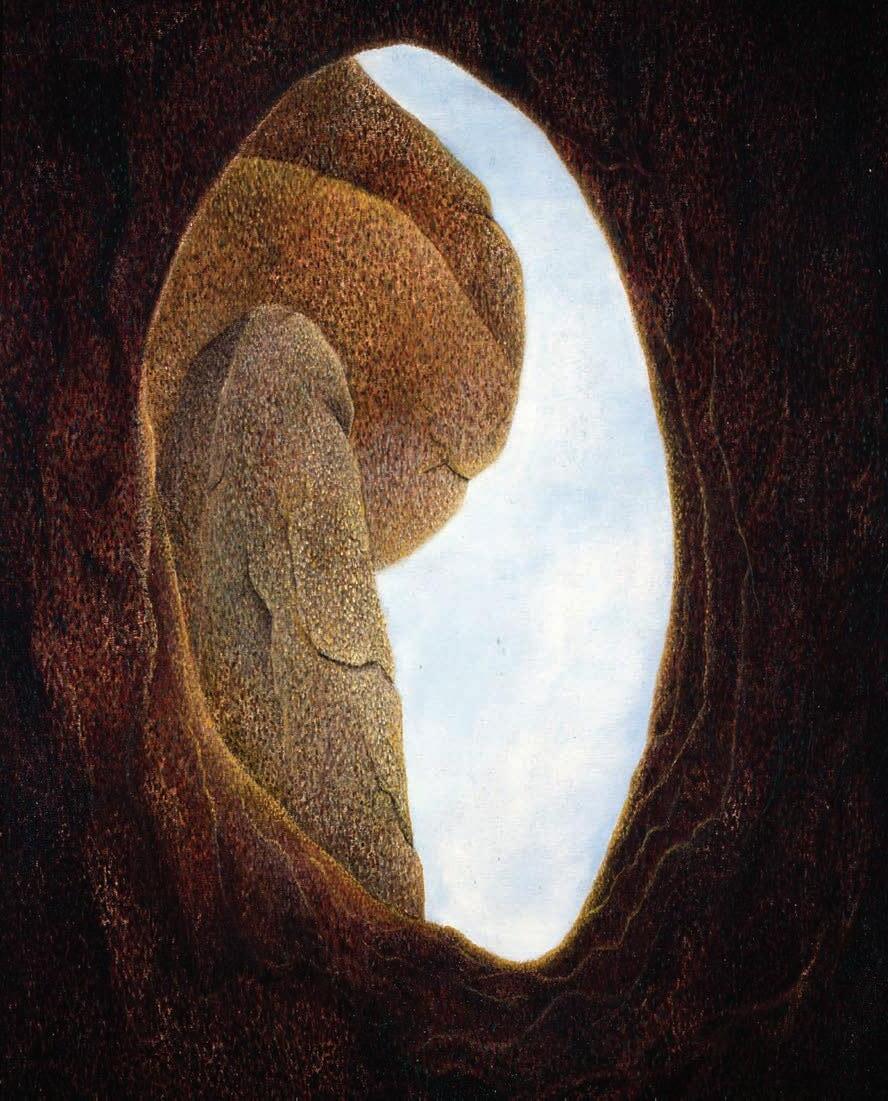
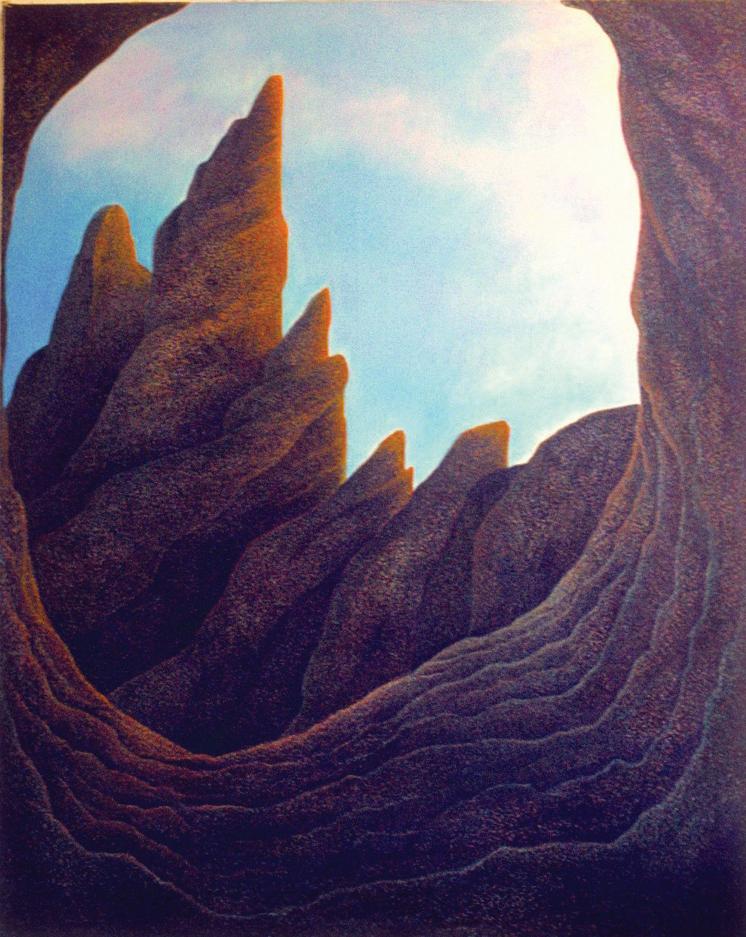



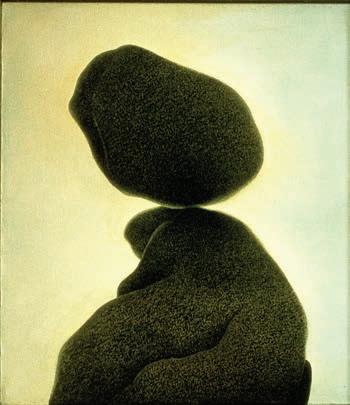
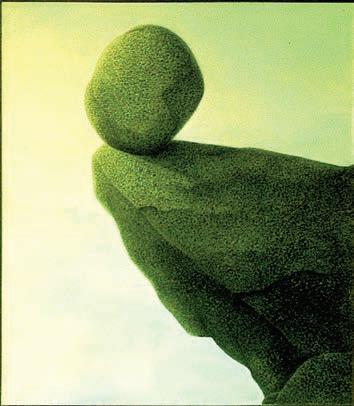
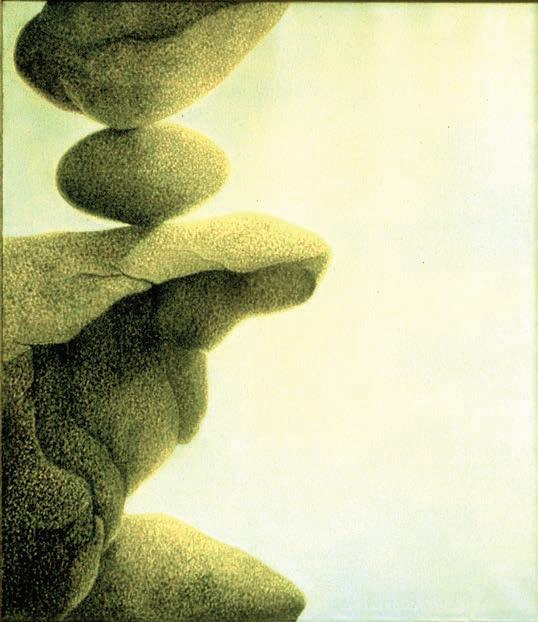
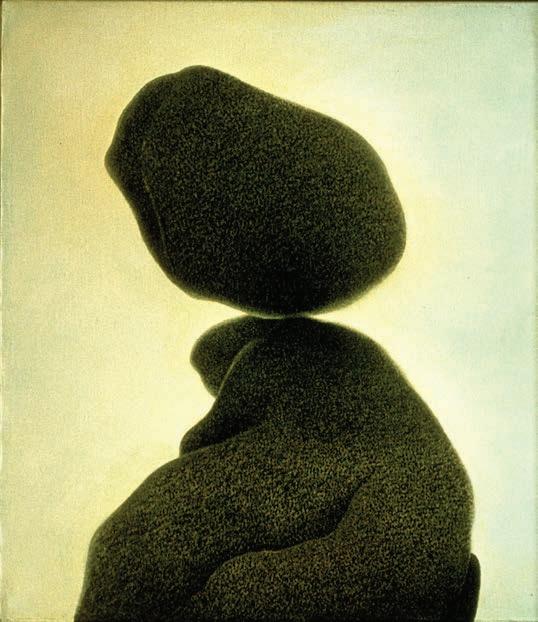



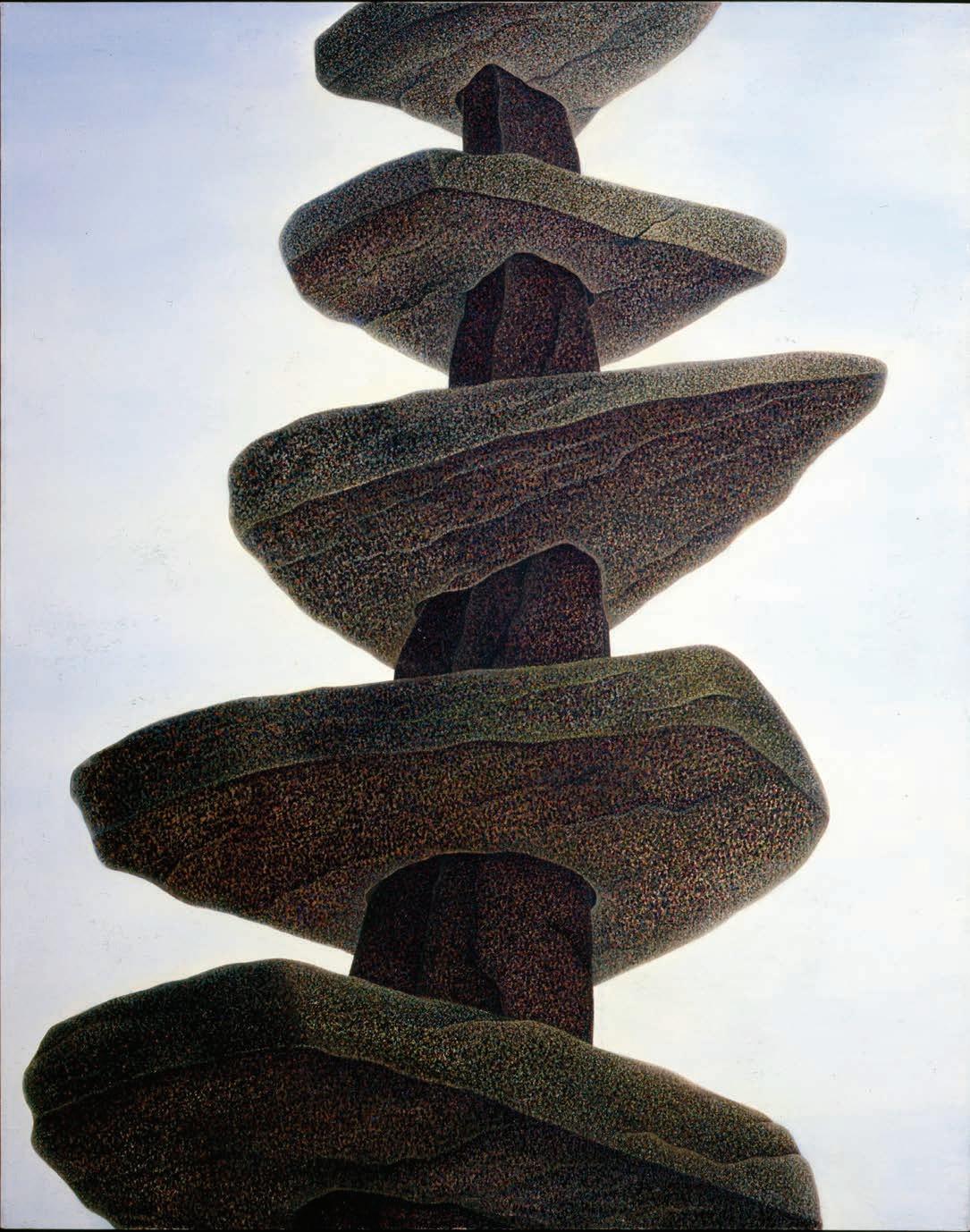

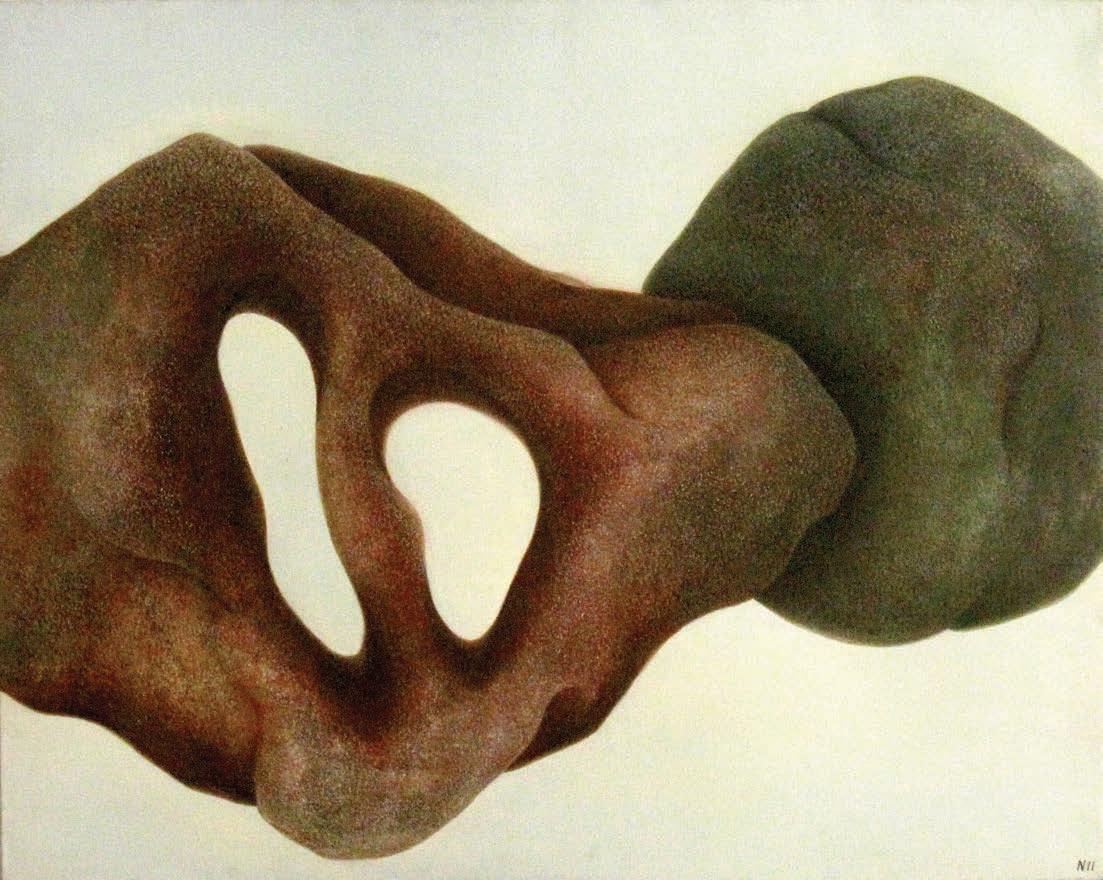
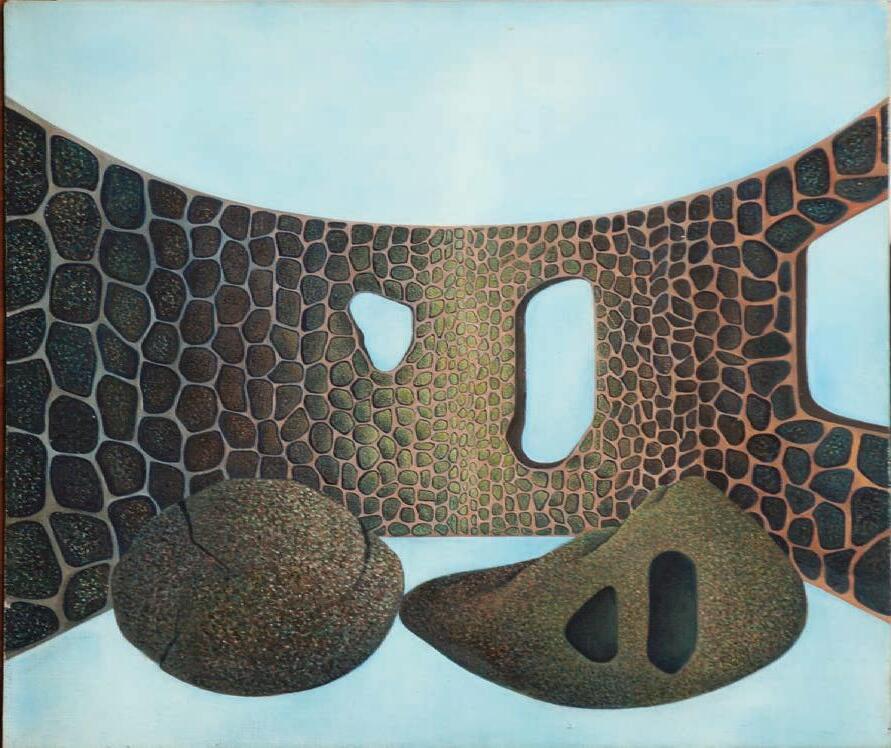

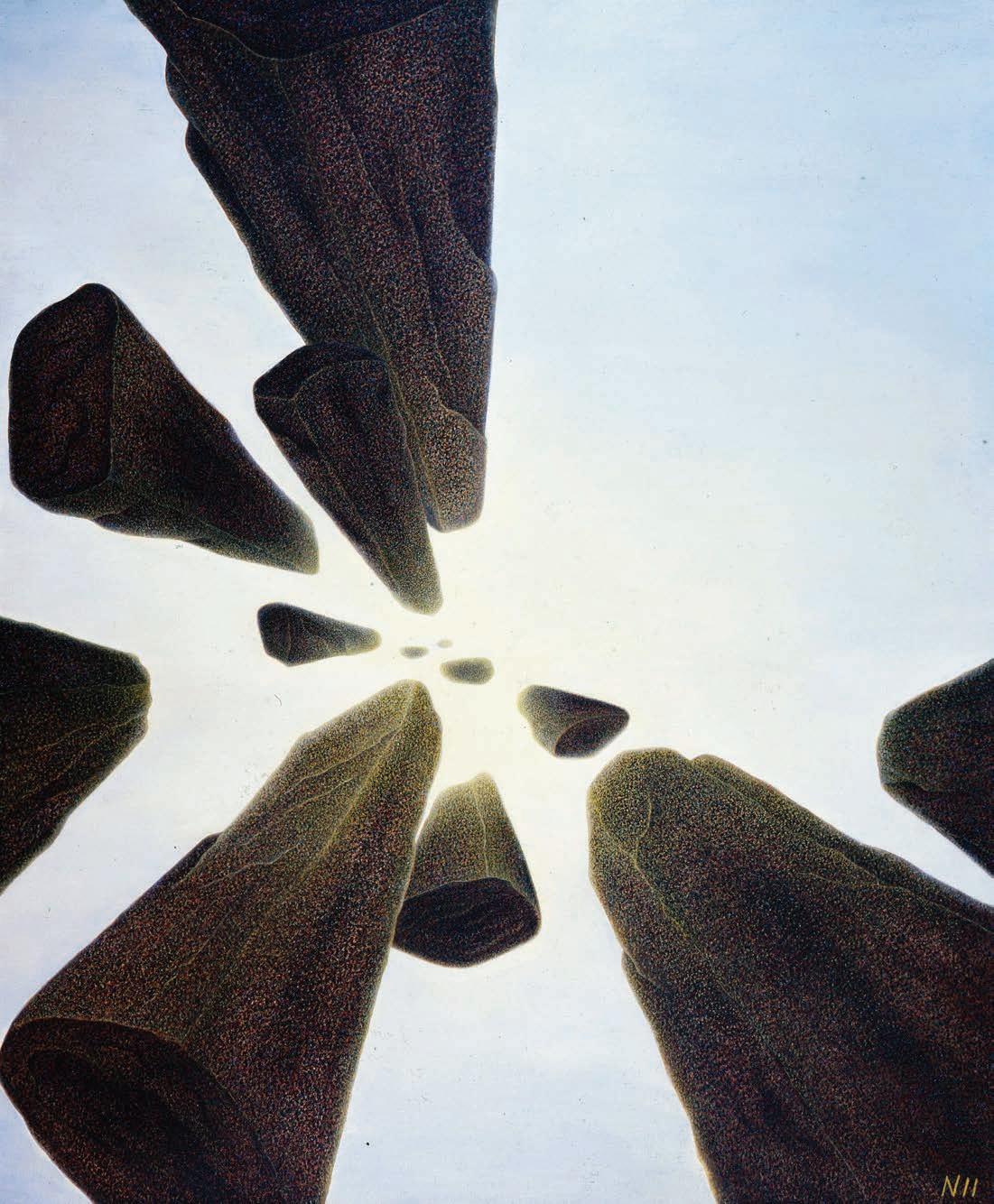
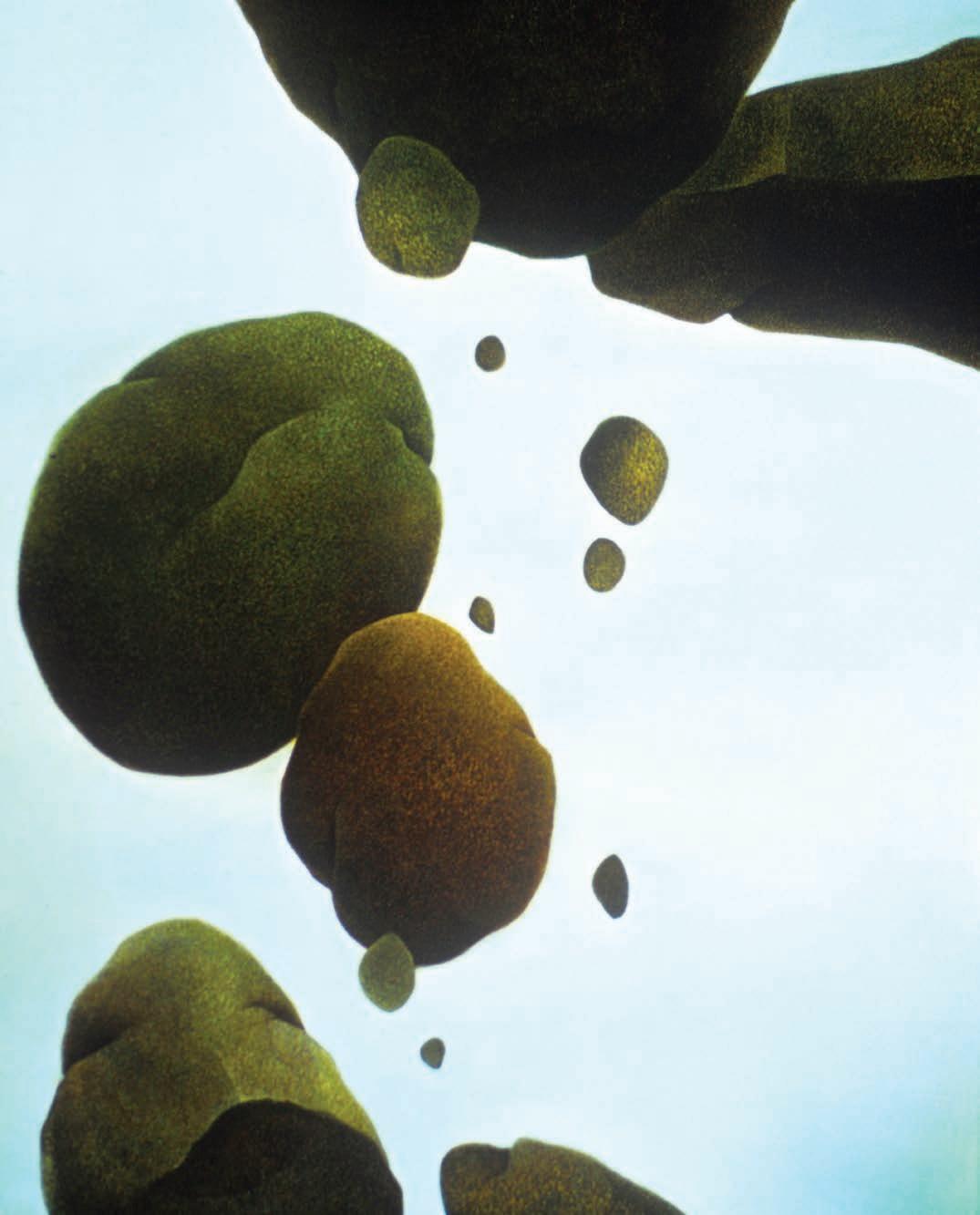

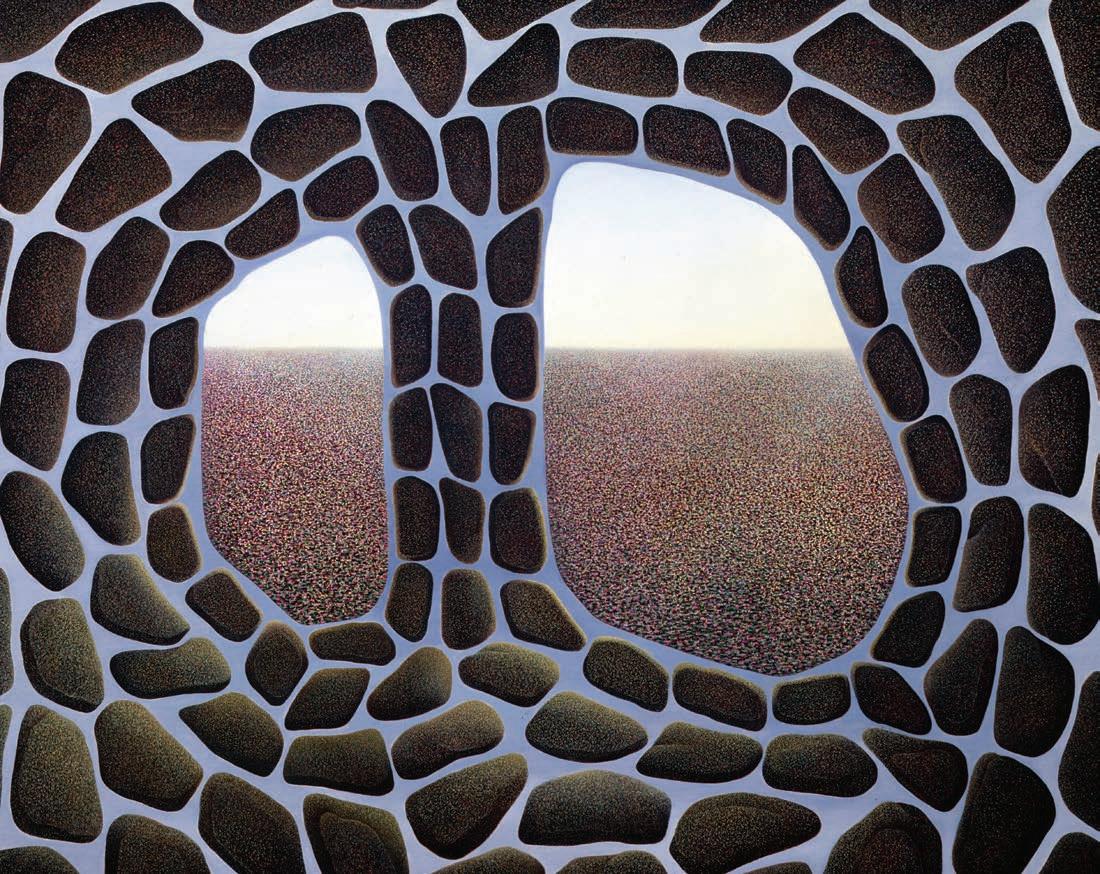
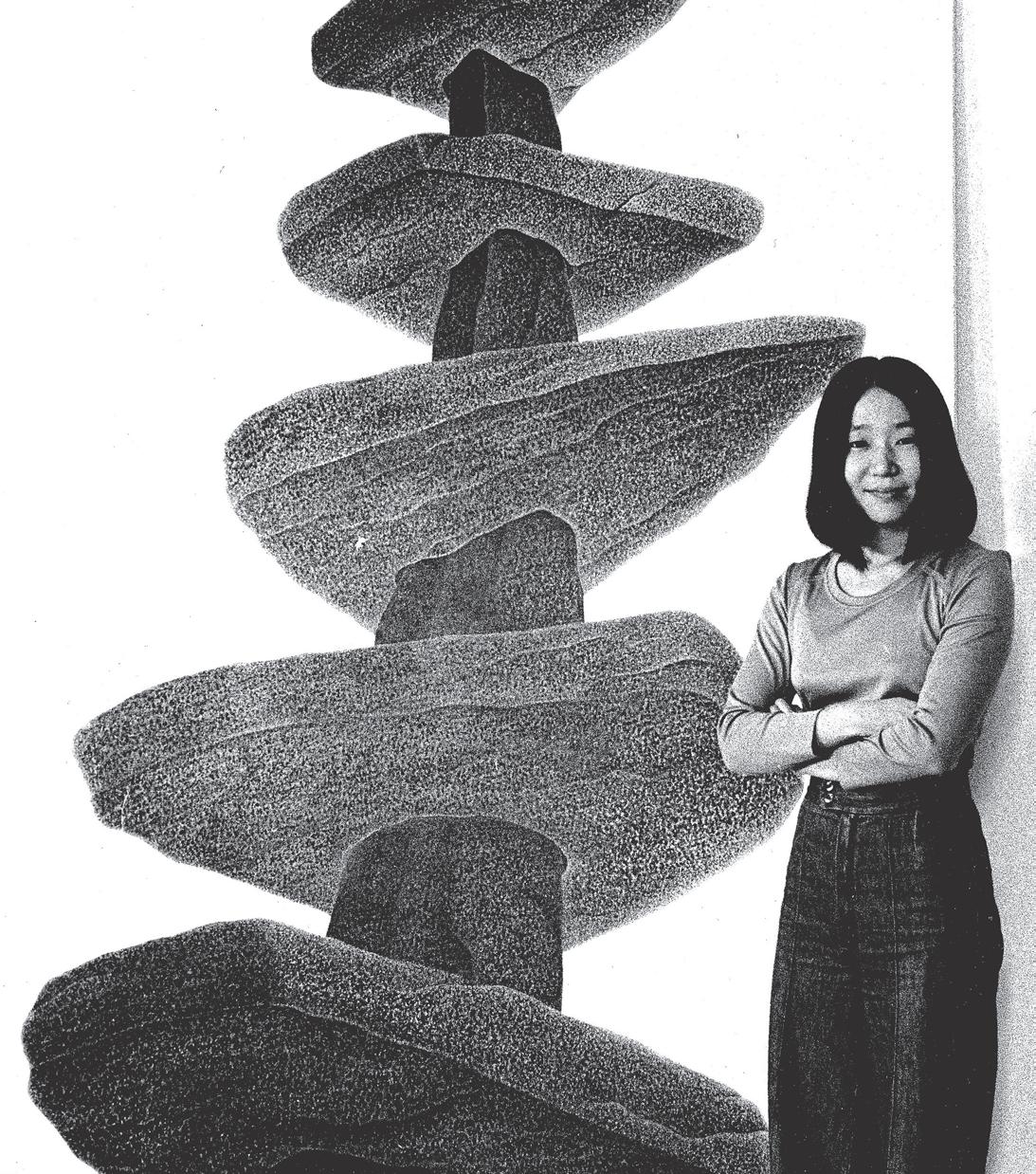

By Terrance Lindall September, 2017
The Yuko Nii that we know best is the one who painted a monumental, nearly mural size, cycle of Dunes. Seen last year during The Yuko Nii Retrospective, Part 1: Dunes, it expresses Nii’s breadth of artistic style and ability. In the Dune Series, Nii maintains a certain precision and a strong sense of volume using a pointillist style that she calls “dotism.” Aware of the relation between pictorial space and how it must be viewed as poetic landscape, Nii was able to successfully establish a dialogue between art, landscape, and audience.
Following her graduation from Pratt Institute, Nii’s works contained a new level of sophistication that was most immediately apparent in her first major dune work. This is her “most dramatic vision of a spiritual nature.”
At Pratt Institute, Nii was best known for her large-scale stone paintings. However, because she never had a drawing training, even during her undergraduate years at Macalester College, she decided to take figure drawing as part of her MFA coursework. Using charcoal and occasionally ink with live, nude models, these studies show evidence of an emerging formal organization.
Nii’s switching between figures in her drawings and the large canvas landscapes of stone is interesting, as both are equally volumetric and plastic. She is able to balance stark contrasts between black and white compositions in drawing as deftly as she is able to create entirely volumetric surfaces in her stones. Nii tempers different intensities and rhythms, embodying them in the finished process. Thus, one can find solemn and serene works with religious connotations in the paintings, next to very fleshy, human figures in her drawings. When seen in their totality, they register a broad thematic spectrum: epic (in her lyrical dunes), and in her figurative work, satirical, compassionate, with a humanistic inspiration and a strong impact. Accustomed to working on a grand scale in her paintings, she carries a humanistic sensibility into her smaller black and white works.
Truth in her drawings is incarnated as human form; the energetic and expressionistic handling in these works testifies to a rational and practical assessment of its subject matter. Nothing is graphically or plastically hidden.
Ever since moving to New York City in 1966, Nii was able to see exhibits of significant creative movements: both American and German Abstract Expressionisms, Pop Art, Hard Edge, Field Paintings, Flux, Social Realism, Regionalism, the
Harlem Renaissance, Cubism, Dada, Fauvism, Impressionism, etc., During a period when she could have imitated a host of styles, she was able to successfully negotiate diverse European and American influences to construct a wholly unique artistic and uniquely Japanese identity for herself. Well-read and intellectual, she not only learned from her peers about theater, literature and philosophy, she absorbed avant-garde art by visiting galleries and museums in New York and traveling the entire USA and abroad to Russia, Europe, Latin America, and Asia.
Nii’s art evades specific classification owing to a unique subject matter and symbolism. The modern viewer may find certain sympathy with the universalizing goals and themes of mankind as it is seen reflected in a spiritually universality of peace and harmony in Nii’s work. Nii’s public character can be labeled as reflective, composed, and apolitical, and her inner creative force produced an art that can be seen as a yearning for a harmonious beauty that all people find appealing.
Yuko says, “…the world is changing dramatically today and so is the art world. One day they were on the top of the art news, but next day the new ones replaced them. Monetary value is the top criteria everywhere even in the art world. Yes, it has been always throughout the human history that money moves the world. I hope to believe that real art moves people, human hearts as it has always done so.” With that belief, her WAH Center will keep going fulfilling the mission. Nii continues, “Through the international language of art, we come to understand, respect and love each other.”
By Dominique Nahas
One’s first possible impulse, in looking over Yuko Nii’s figure drawings from graduate school with their blend of elementariness, spontaneity, restless uninhibitedness and purposeful exaggeration, might be to point how radically different they are as a point of departure leading to Nii’s later, more regimented and more abstracted work absent of overt references to the human figure. After all, Nii’s geometric abstractions and later her biomorphic and amoebic forms of her “Fluid “works of 1965-6, even her graduate work, her “Stone “ series could not be seen to be more different than the approaches to form-making, or the subject itself, the human physical body, as we see in her drawings. Additionally one might argue that Nii’s fully mature pantheistic vision, and the animistic sensations that cling to it, one might argue, could only be is ignited, generated and energized not through figural representation or figurative depictions but only through her abstracted through her dotism technique of embodying “prima materia.” To advance this persuasion one might recall Nii’s early readings of parasurrealist René Daumal’s “Mount Analogue” which seems to have stirred up something deep within her, namely seeing herself as a traveler, a pilgrim, an adventurer of the spirit advancing through a mixed and steep terrain towards selfrealization. As an emerging (and later, as a mature) artist, Nii seems to have been drawn to search for aspects of the metaphysical within the physical universe while invoking the allegory of the search of the soul along the path of heightened awareness, an imaginary terrain alluding to a cosmic of the self and selves into the Self of a higher order. Towards that development she was singularly affected and influenced by the visionary quests for integration of the spiritual within the material, the individuation of the soul and the body, as exemplified by mentor-artists Ansei and Toshiko Uchima, Esteban Vicente, Toshiko Takaezu, Jack Lenor Larsen, and Isamu Noguchi. In her notes the artist inferred her search to penetrate into macro/micro antimonies as she wrote, “Each stone is depicted as a full form made up of aggregates of smaller material, numerous grains of mineral chemically compounded and bonded as solids to form what we see as a stone.” Similarly it might be hard to see overt relevancies between Nii’s early figure drawings and her elegiac, rhythmical “Dunes” series (1976-1996) with the mathematical precisions of their sedimentary layerings. These works with their resonating tonalities and patterns imply an imaginary cosmic journeying of the self’s soul.
Such recursive and uninflected patterns could be seen to be analogous to with minimal music of Philip Glass and the critical reception of his work that included references that were seen in his work to the Buddhist Void doctrine.
Yet even with this back-story context fully exposed I submit that Nii’s attaching herself during her graduate training to a rigorous scopic regime of perception in which sight, memory and mark making are yoked together in figurative body drawings had a vital role to play in her development as an artist. In analyzing Yuko Nii’s graduate school studies of the body it is clear that by undergoing this painstaking regime of observing forms in space and slowly and incrementally learning to make marks that track her visual memory Nii started her way in acquiring considerable will power and a will to concentrate on what she is perceiving—mentally, spiritually, emotionally, psychically. Nii’s early figure drawings in effect “prepared the ground” of her consciousness one might say. Her experiences in depicting with full authenticity the subject of the body in space allowed her in her later developments to trust her instincts entirely in regards to mark making and to obviate any judgment or inner-inhibition that might otherwise allowed her to express herself with so much freedom and single-minded rigor. These powers of visualization would become manifest as she began to create works of spectral astringency such as “Flux” a 1974 oil on linen and, later, in the mid-nineties, after assuming extraordinary powers of concentration, she was led by a force of self-will and devotion to create totemic works such as “The Dark Region of Spectrum Planet” an oil on linen painting. To understand how such fierce concentration is developed it’s important to step back and see how figure drawing actually “works” in helping to build attention span and developing self-confidence and internal exactness.
Conventional figure drawing takes place as a form of visual transcription when the perceiving artist encodes a visual image, large or small, to visual memory before that artist turns to the paper to execute the drawing. In this process there is an alternation between two phases, the first is the phase of visual information gathering and the second phase occurs through executing the gathered information onto paper.
Using this approach can lead to naturalistic renderings of the subject as in Yuko Nii’s drawing 14 (p.73) in which it is clear that Nii is taking a great deal of time and care to go steadily through a series of multiple alternation between
these two phases. Once the thin drawing pencil line has rendered the outlines of the figure’s body, the intricate details of the face, hair line, nipples as well as the stool and the cushion on which the model is sitting as Nii adds volume to the figure using dramatic shifts between darks and lights and also nuanced areas that are attended to with gossamer touch of the charcoal stump and broad edge of the pencil.
In drawing 16 (p.74) a similar feel of a perceptual battle well fought in which periods of patient accumulation of information on the model and periods of acquiring information on the paper have been gathered in bits and pieces, incrementally—one even might say these separate perceptual and mark making-events have been harvested, alternatively, and cyclically—over a duration of time. The impact of these efforts on the part of Nii is clear. In effect a meditation on mindfulness produces a coherent image of a full-bodied, powerful female nude sitting on a chair, one leg elevated, knee bent as the foot of her right leg is placed on the lower cross bars of the stool. The rendering depicts her unusual posture: The model rests her right elbow on an elevated stool as she looks impassively straight out at the viewer, her lifted arms have encircled her head as her upper torso, twisted and lowered, leans to the viewer’s left. What is impactful here is Yuko Nii’s dynamic composition that reveals a suggestive interplay of dualities. Such dualisms will be explored, intensified and magnified to near-hallucinatory heights in her later works, particularly in her Dune series: those of soft and hard, the geometric and the biomorphic, the diffused and concentrated. In work on paper 16 (p.74) the viewer senses that a dialectical allegory is being played: between the machined and the natural, an embrace between the feminine and the masculine, the fleshy and the hard, the soft curves of the female form and the architectonic lines and planes of the chair and stool.
As Nii challenges herself towards greater depths of expressivity as she does in work on paper drawing 4 something remarkable occurs. The demarcation between the two phases starts to recede as the direct visuo-motor process that ordinarily governs the transformation of perception into drawing takes place without recourse to memory. The darker, re-iterated visual traces and lines that Nii creates around the hair area and the blouse’s sleeve area, these impressions she leaves on the paper suggest a constantly renewed flow of information through the eye to a continuously moving hand.
Two fluidly dynamic examples of drawings where Yuko Nii has trained herself to trust her instincts entirely are workson-paper drawing 3 (p.70) and drawing 2 (p.70). Nii is guided by interior impulses that she translates as they take shape rather than by the exterior cues given to her and on which her eyes are fixed. Her hand, in effect, has learned the material. Most impressive in regards to Nii’s constantly evolving individuated visual expressivity (in which Nii’s confidence in herself and her sense of self seems most secure) is “Struggle” (p.77), a oil painting. Here, while the painting might be loosely based on an initial recognition of the presence of two sitters’ poised and positioned with one subject is standing up while touching the torso of the other model who is in a supine position, the final visual result is a manifestation of an artist who seems to have gradually assimilated the external world within her. The visuomotor process has transformed visual information directly into the executed figure painting without recourse to visual memory. “Self Portrait” (p.67), in which the artist has depicted her self-portrait using strongly modeled and modulated planes of gray, dark gray and black offers a prismatic effect that provides an overall feeling of herself peers unflinchingly back at the beholder, caught in her deepest recesses of her subjectivity.
If we look, really look, at Yuko Nii’s intense drawings we see a reflection, exploration and depiction of somatic energies. A process of self-knowledge ensues as these energies course throughout this body of work that involves Nii’s intense looking and learning at—through encountering and acceptance—of the body/soul of herself and the Other. As Nii depicts the contours and shapes of her subjects’ nude bodies (including, as has been mentioned earlier, selfportraits that have a sense of resolute implacability about them as in “Self Portrait” (p.67) we can reflect on those ruminations of French philosopher Jean-Luc Nancy on the corporeal body and its relation to the soul and the mind. In Corpus he writes:
“…the body is precision, it is here, nowhere else. It’s at the top of the right toe, it’s at the base of the sternum, it’s in the nipple of the breast, it’s on the right, the left, above, below, deep or on the surface, diffuse or punctual. It is pain or pleasure, or just a simple mechanical transmission, like the keys on a keyboard under the pads of my fingers. Even what’s described as diffuse in one or the another sensation keeps the precision of the “diffuse,” which irradiates each time in a very precise way…[the] spirit’s precision is mathematical; the
soul’s is physical; its exposed in grams and millimeters, in a fraction of ejection and with the speed of sedimentation, in a respiratory co-efficient. There’s nothing reductive about anatomy; contrary to the claim of spiritualists, indeed it’s the soul’s extreme precision.”
He continues: “…In any case it’s no wonder the body inspires so much hatred….It’s no wonder the world’s so pinched, narrow, wretched, distant and disgusted—but also disgusting, fat, squinting, obscene, pornoscopic….Maybe this world could be saved by beautiful geometrical designs in three or n dimensions, with elegant axonometries: but then everything would have to float, hanging in mid-air, and bodies must touch the ground.”
Indeed, Yuko Nii’s figure drawings were a necessary and vital means (and measure) for her to ground herself and her ideations in the here and now and through moving lines and narratives of making and “reading” bodies in space. In a very distinctive way Nii’s “real time” drawing(s) using lines afforded her (and we as viewers) the capability of tracking within herself a visible action of consciousness and in the process creating a dynamic time-trace that contains within it actuality and illusion, inherent movement (or lack of it) and implied motion and emotion. In regards to the energy of the rendered line and its signification Roland Barthes has wonderful insights. He describes it like this “…a line, however supple, light or uncertain it might be, always refers to a force, to a direction; it is an energon, a labor which reveals—which makes legible—the trace of its pulsion and its expenditure.”
Nii’s moving/moveable lines, her reductive outlines, her volumetric shadings reinforced her penetrating and analytical eye and mind. The artist’s visual transcriptions tell stories: inferring momentary pauses for eye and hand, at other times connoting a practiced velocity of hand and eye coordination that in some measure can be seen as a form of intensification and as a form of release and satiation (as in drawing 19, p.75). Sometimes Nii’s drawing over a line repeatedly can have a hypnotic effect on the viewer. Re-inscription of this type can be seen as a type of re-invigorated investment on the part of the artist so as to induce an amplified sculptural dimension to the drawing at hand, as in drawing 4 (p.70) and drawing 15 (p.74). Nii’s different line-works in effect, “write time ” in different speeds. Her drawings allow us to see how she imbues her drawings empathetically with projected notions of obsession drawing
16 (p.74), or inward reflection (drawing 18, p.75), or remoteness (“Struggle,” p.77).
In conclusion one must look at Yuko Nii’s early figure drawings as manifestations that allowed her to fully enter into and take psychic ownership of her later more abstracted works. Looking at Nii’s drawings offers the viewer insights into how Nii proceeded to clarify her mind and re-direct her energies towards full potentiality. In so doing the artist found—or came across through her paths of experience, it seems—deep subject and significant content. In Yuko Nii’s matured expressions we see the embodiment of her susceptibilities now fully blossomed in the service of envisaging a utopian world. Such a world could circumscribe her fears and joys as a searching and artist committed to the not-known, while allowing her to climb the heights of selffulfillment and individuation.
Dominique Nahas ©2017
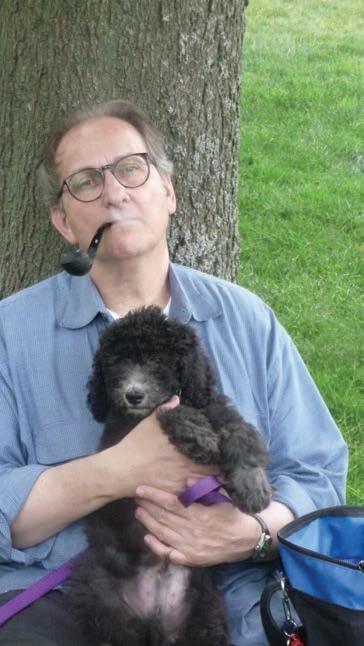
By Yuko Nii September 2017
In drawing the human figure, I tried to capture what is basic and unchanging in the drama of today’s world. We humans are basically flesh and feelings, and we are in essence unchanged since the beginnings of human history. No science, no war, no fashion, no computerized super world can change what is intrinsically human. In the drawing of the nude human body, without the appurtenances of modern inventions and prosthetics, it is revealed to us that in spite of racial, ethic, or cultural differences we are basically the same. We should be able to reconcile our differences in that common humanity, and find agreement in discord, common understanding, and possibly appreciation. There is a lot of talk today about tolerance, inclusivity, and diversity. Tolerance is perhaps the least desirable since it implies “putting up with a quality we might find repugnant.” We are indeed inclusive in a common humanity, our human bodies and minds express themselves in common ways. We might disagree, but we express that disagreement in common forms of expression, whether argument or war. Thus, we are not all at as diverse as some think we are. It is in the black and white drawings that the human commonality is best expressed, without the trappings of artificial fashion or architecture.
To sum it up, just as drawing is a basic beginning to art, so the human body, unencumbered, is basic to all cultures, all races.
At the WAH Center, I choose shows that are timely, fitting to what’s going on people’s minds and hearts. Or they raise conscious awareness, or are educational or philosophical to make us think and question, or they are outrageously super real, etc. Because the WAH Center’s Gallery space is large enough to have big group shows, more artists can participate at once. By viewing variety of expressions in thematic or non-thematic shows, we can grasp the wider views of the current artists’ conscious minds. As put forth in our mission statement, we try to offer performance programs related to the fine art shows, bridging these different forms of artistic expression. It is interesting to relate the extension of artistic expression that grows out of the basic human types in black and white drawings of the human body.
Black and white is perhaps the most powerfully expressive means in art. I once had a dream where I was walking down a track toward a vanishing horizon. To my left it was all black, and to my right was all white. I was skipping along hopping into the black and back into the white. Enjoying

it, playful with free spirit…that one could experience both the white and the black. Soon a train appeared before me, rushing. I knew that I had to make a choice of where to go, the black or the white. I knew then that I would lose myself whichever way I took. I then heard the sound of screeching breaks and saw sparks as the train barreled down on me. I woke up.
Somehow that dream always meant a lot to me. The essential basic philosophy in the world is black and white, the dualism in which all things can be described. Adding color can obfuscate or hide things, or make you miss something essential, but the black and white drawing of the human form can tell you something more powerful. Like the Black and White films I used to enjoy, and I still enjoy today more than colored films, the use of only black and white allow our imaginations to expand. The human body does not have a choice in breathing or not breathing, eating or not eating.
Not to choose those is to die, perhaps to choose the black. It is an argument that one has with one’s self every moment to choose this action or that. But we are pushed into one direction or another by forces that we cannot always control. Your family pressures you. The society pressures you into this direction or that. One of my favorite sayings from Heidegger is that “we all wear mankind as our own skin,” imposed on us every moment we live. Man is a social animal and we try to accommodate ourselves to the expectations of others. In other words, we lose ourselves to others, just as in my dream I was compelled to lose myself. The train of being in the world, the world of mankind, makes us lose our playful changes of possible identities. It is like when one is a child we pretend to be a doctor or lawyer or cowboy. It is in that play that we are forming what we will choose to become. But at bottom of our identity, we are all just human bodies with a basic human spirit expressing our basic
human qualities. These black and white drawings express in very powerful terms what we truly are as humans.
The black and the white! Through this basic tool of drawing we can still express infinite possibilities like the permutations and combinations of a game of chess with its black and white pieces. As one makes a move in chess, the deed is done, moving down an inexorable path to win or lose, fame, fortune or loss, and no turning back. What a strange world; the black and the white. Compelled by desires or pressures, the basic human body type exercises choices of free will to change form, perhaps to become something greater that the body it wears. But we cannot escape our basic humanity. That is what the black and white drawings of the human body mean to me.
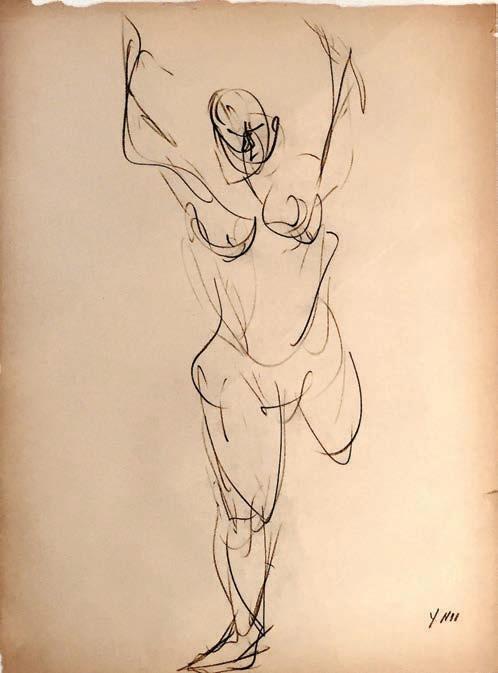
All drawing pages 67 – 76, charcoal on paper, 24” x 18” except drawing 18, p.75, ink on paper, 24” x 18”.
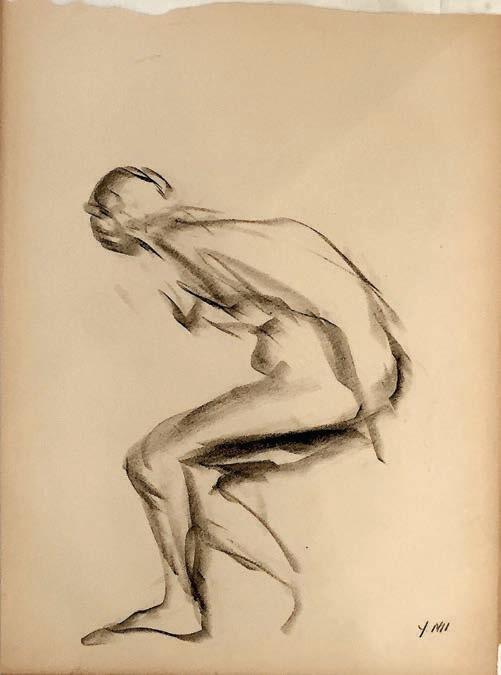
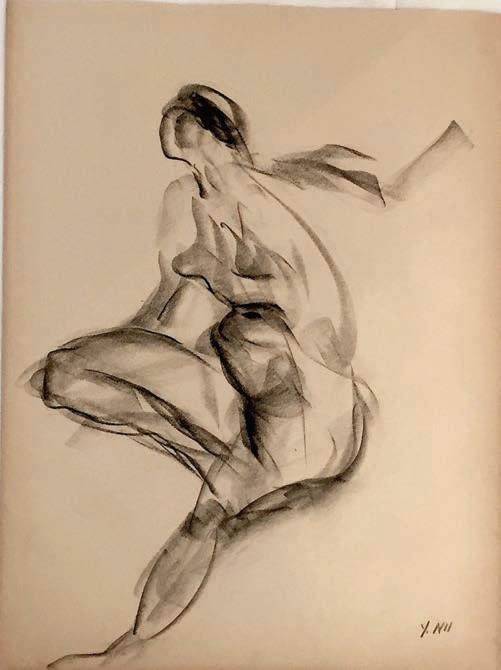
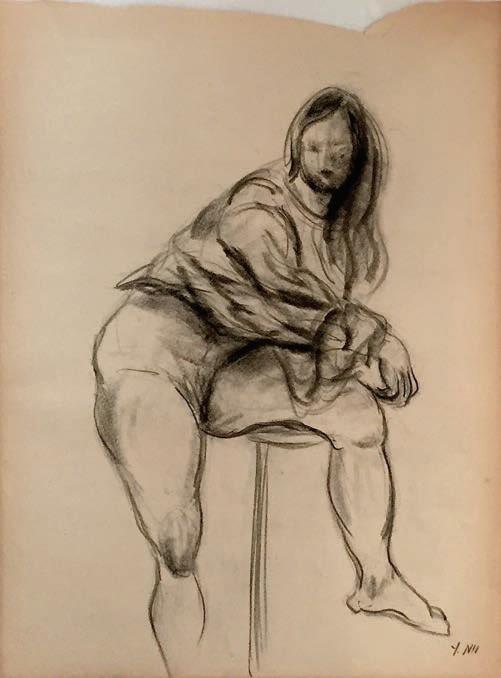
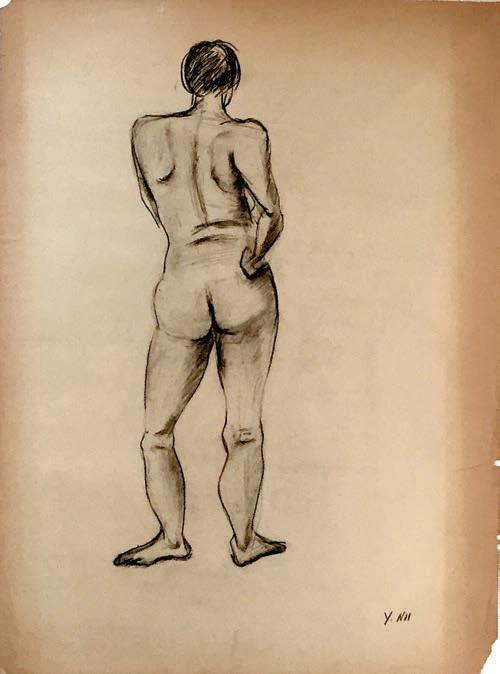
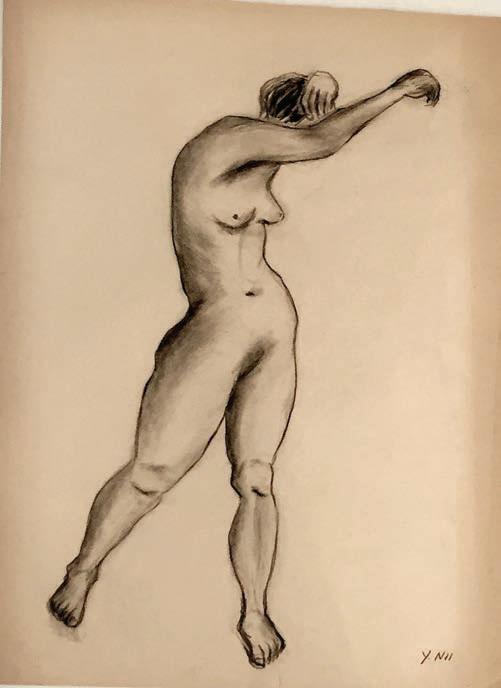



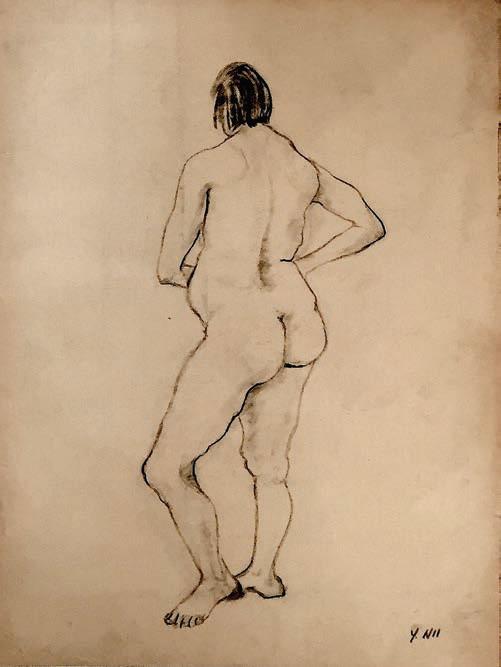



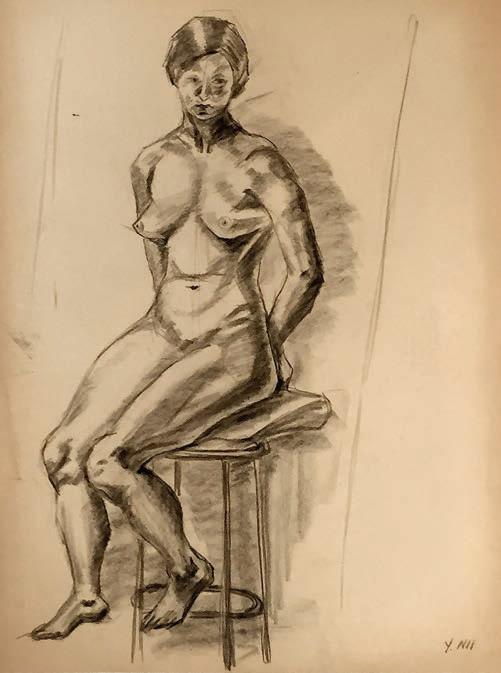

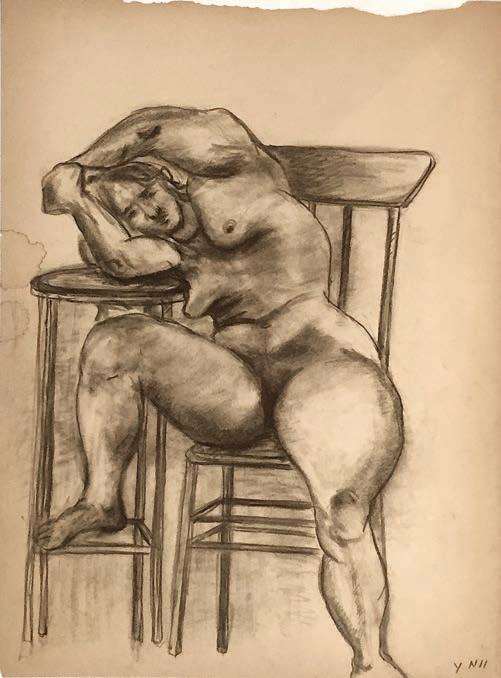
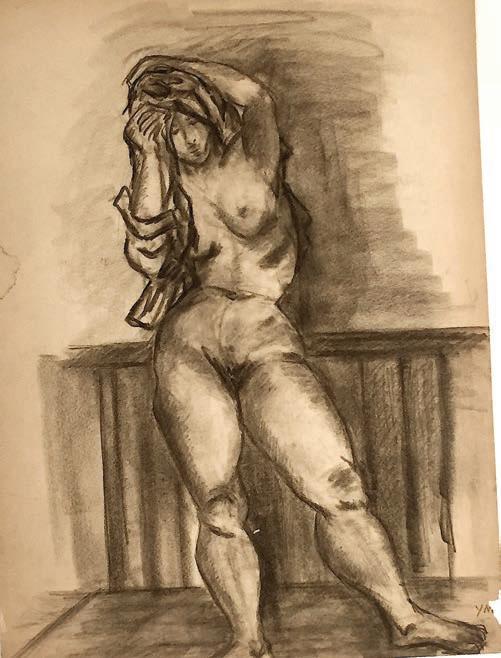
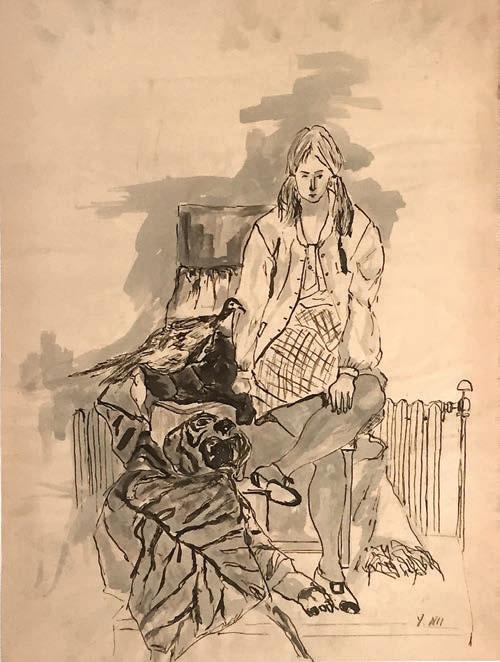

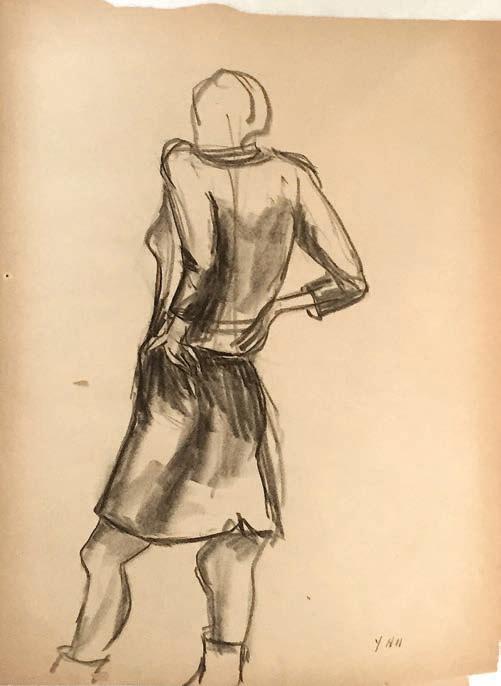

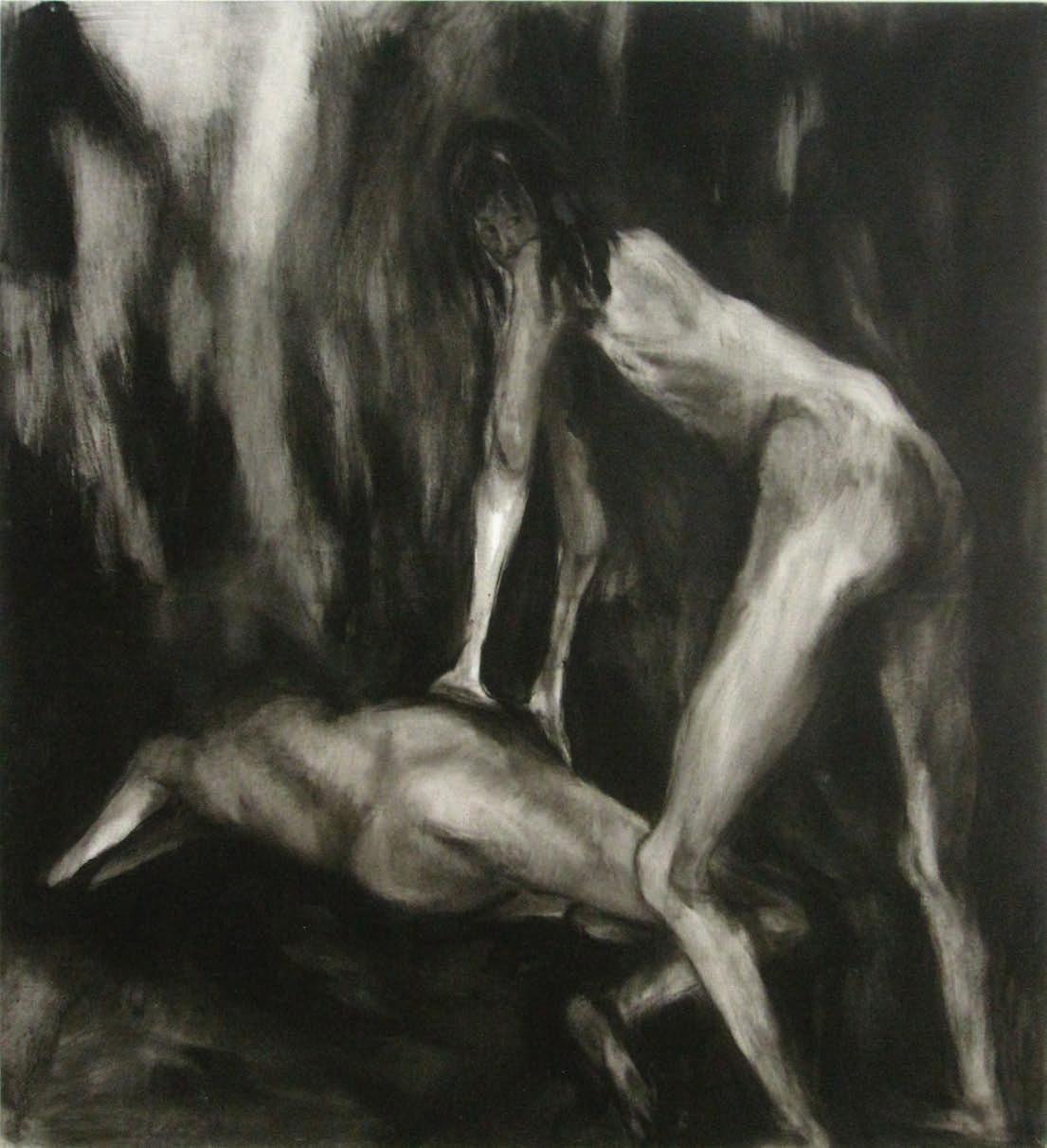
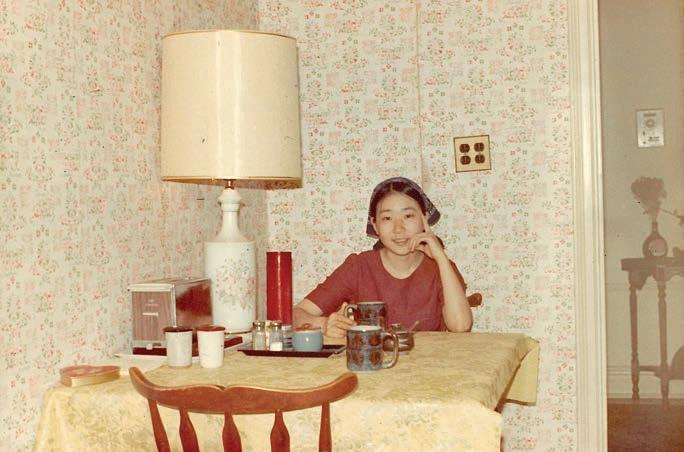
After graduating from Macalester College, Yuko attended the Minneapolis Institute of Art in Minneapolis, Minnesota for one year, and she started figurative work as well as expressionistic forms which led to her more “Fluid” style, which carried on into her early period at Pratt Institute. Here we see that she is transitioning into and formulating the more fluid concepts that will dominate her art for a brief period when she started at Pratt Institute.
These paintings are large 5 x 6 foot abstract paintings that are lyrical and expansive, reflecting the poetic and symbolic side of her nature.
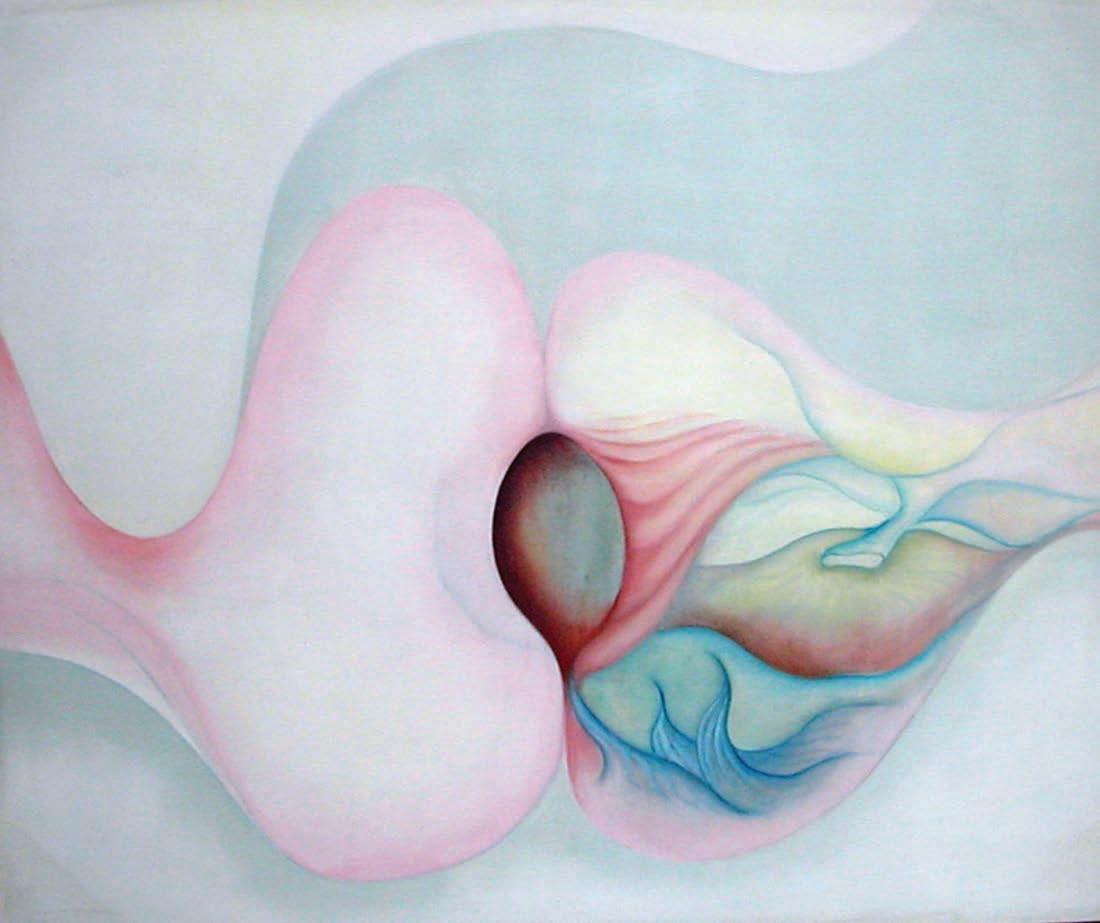

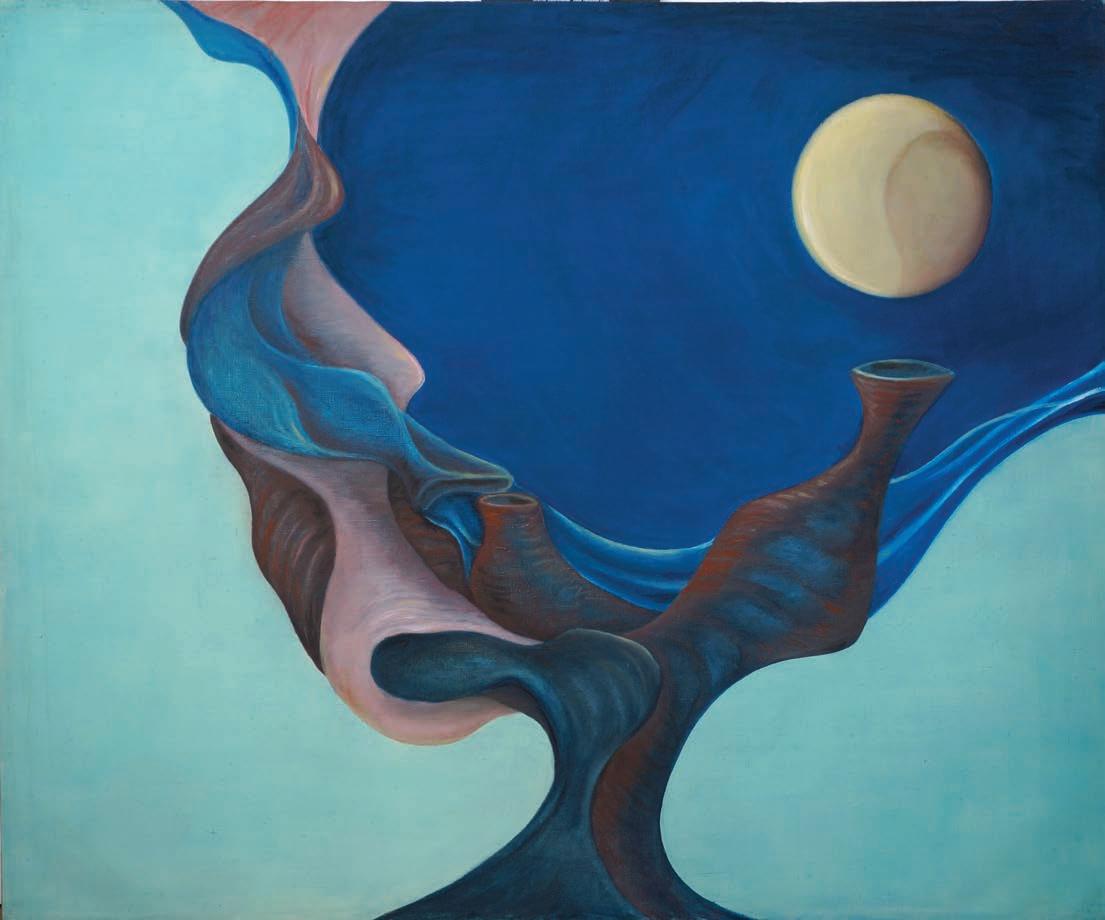

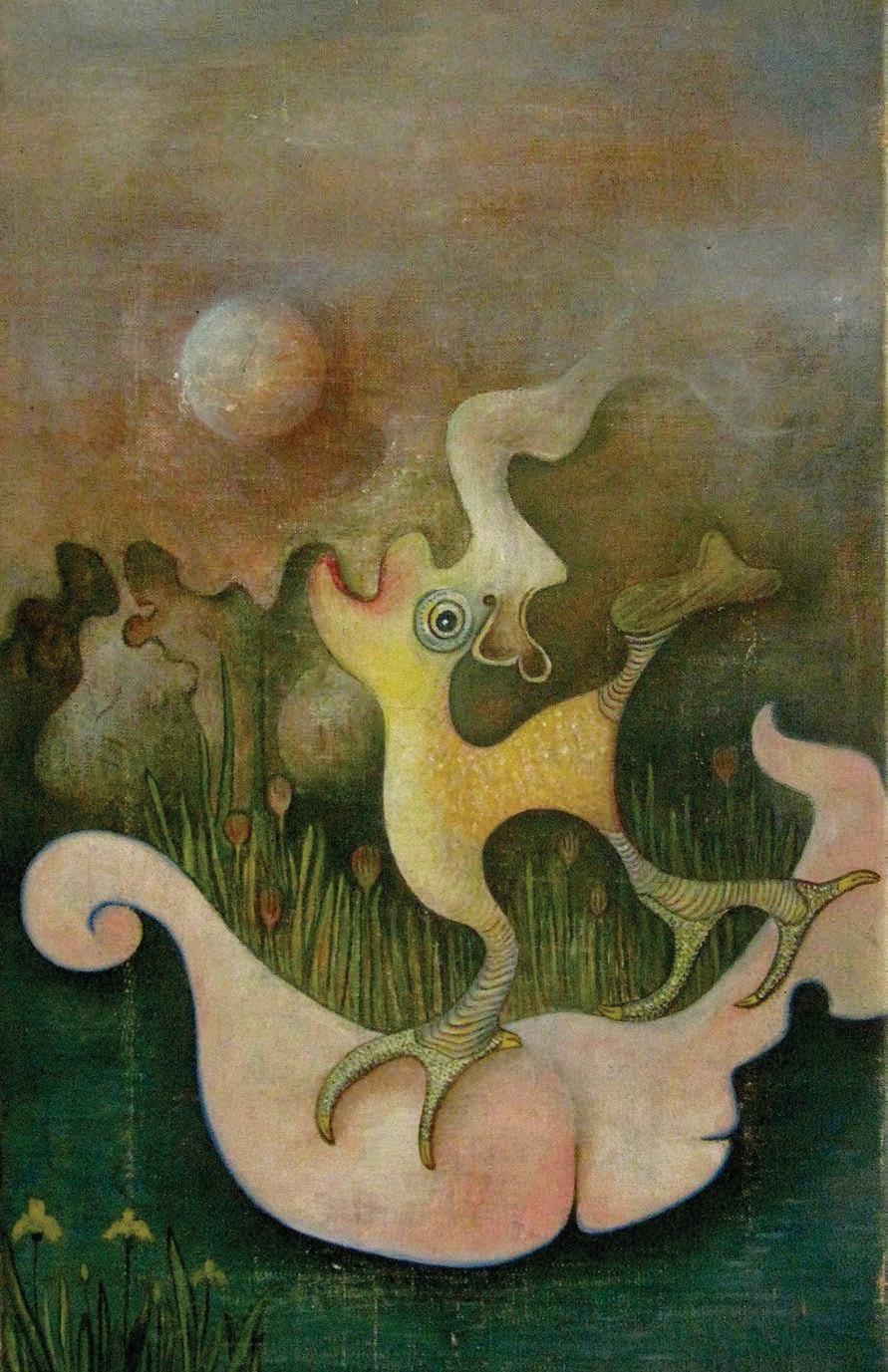
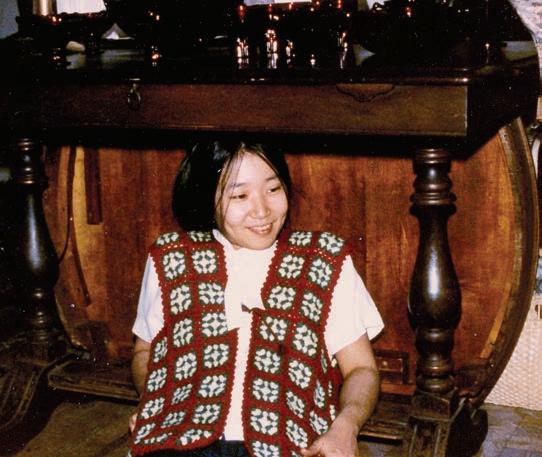
Yuko started her new life in America. Her paintings changed from the traditional classic paintings she pursued in Japan to the totally new geometrical abstract expressions.
She won first prize in the Mid-Western College Competition 1965 with the painting “Connection” (next page).
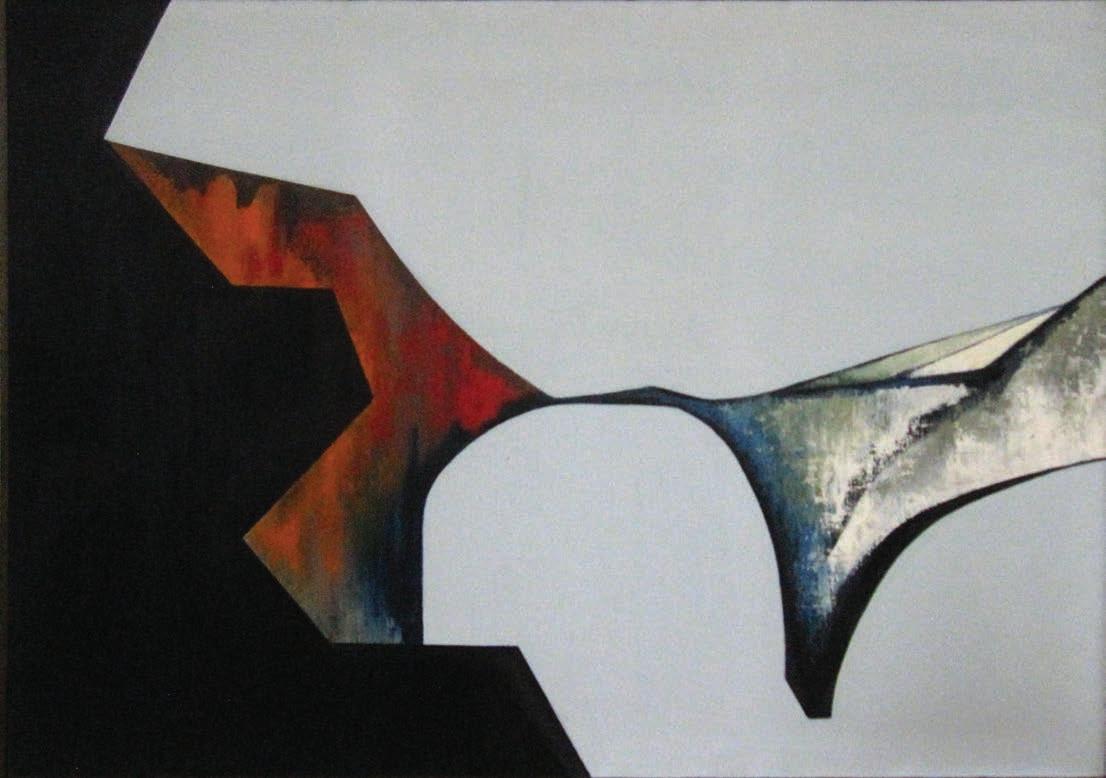
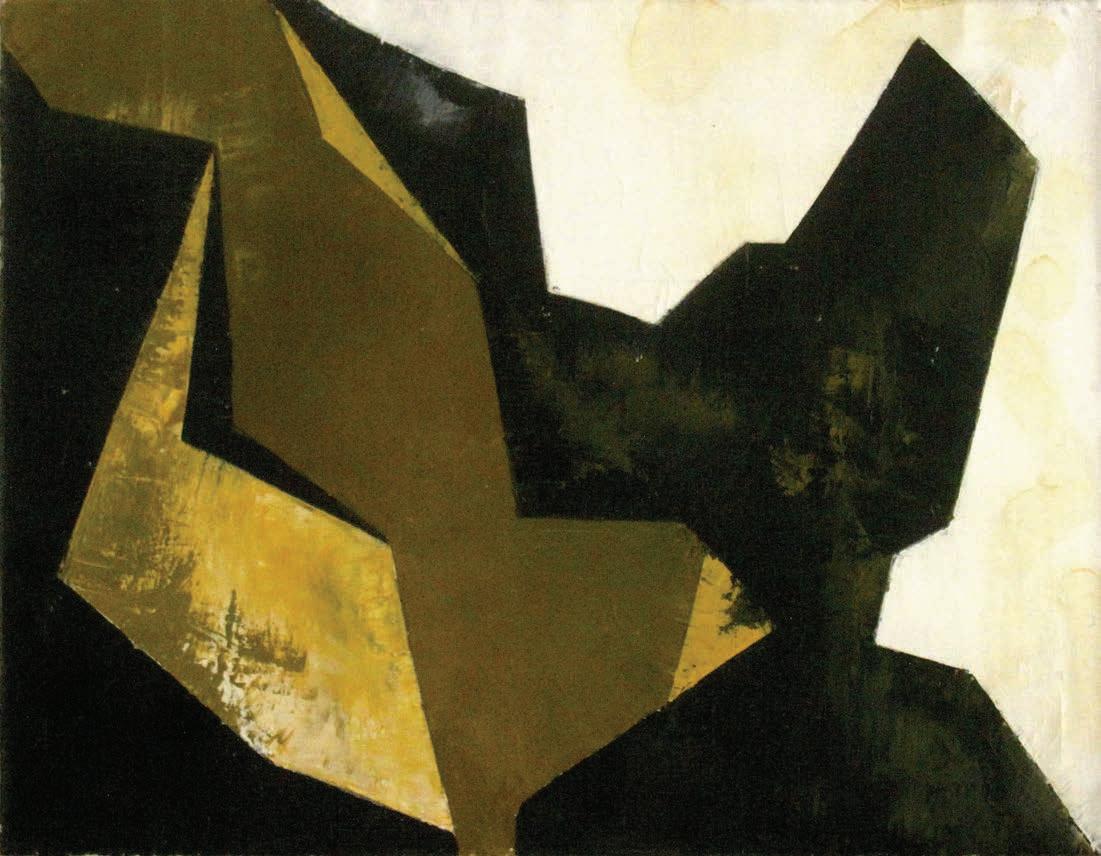
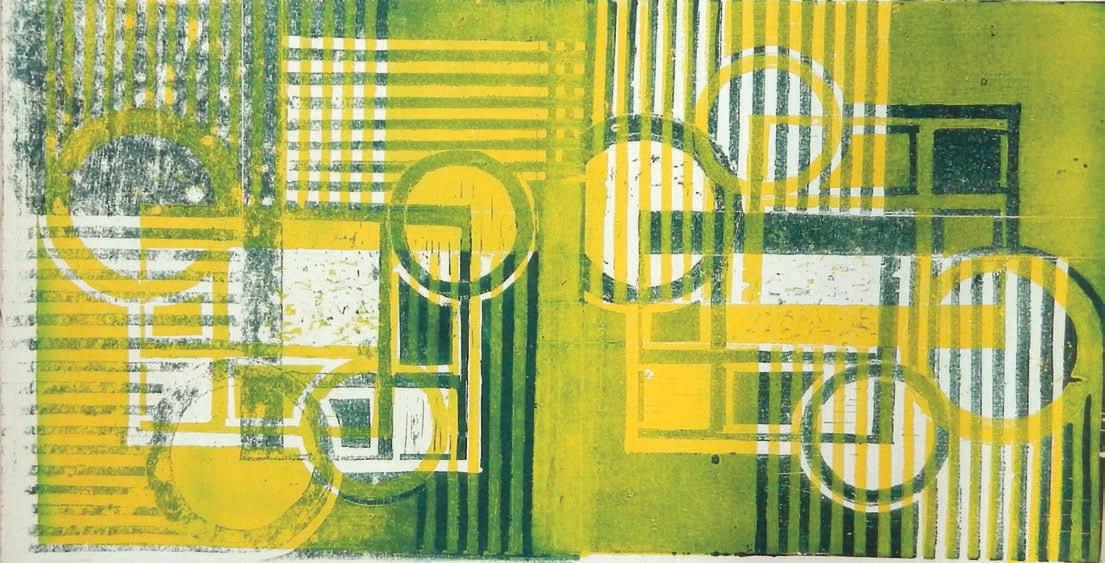
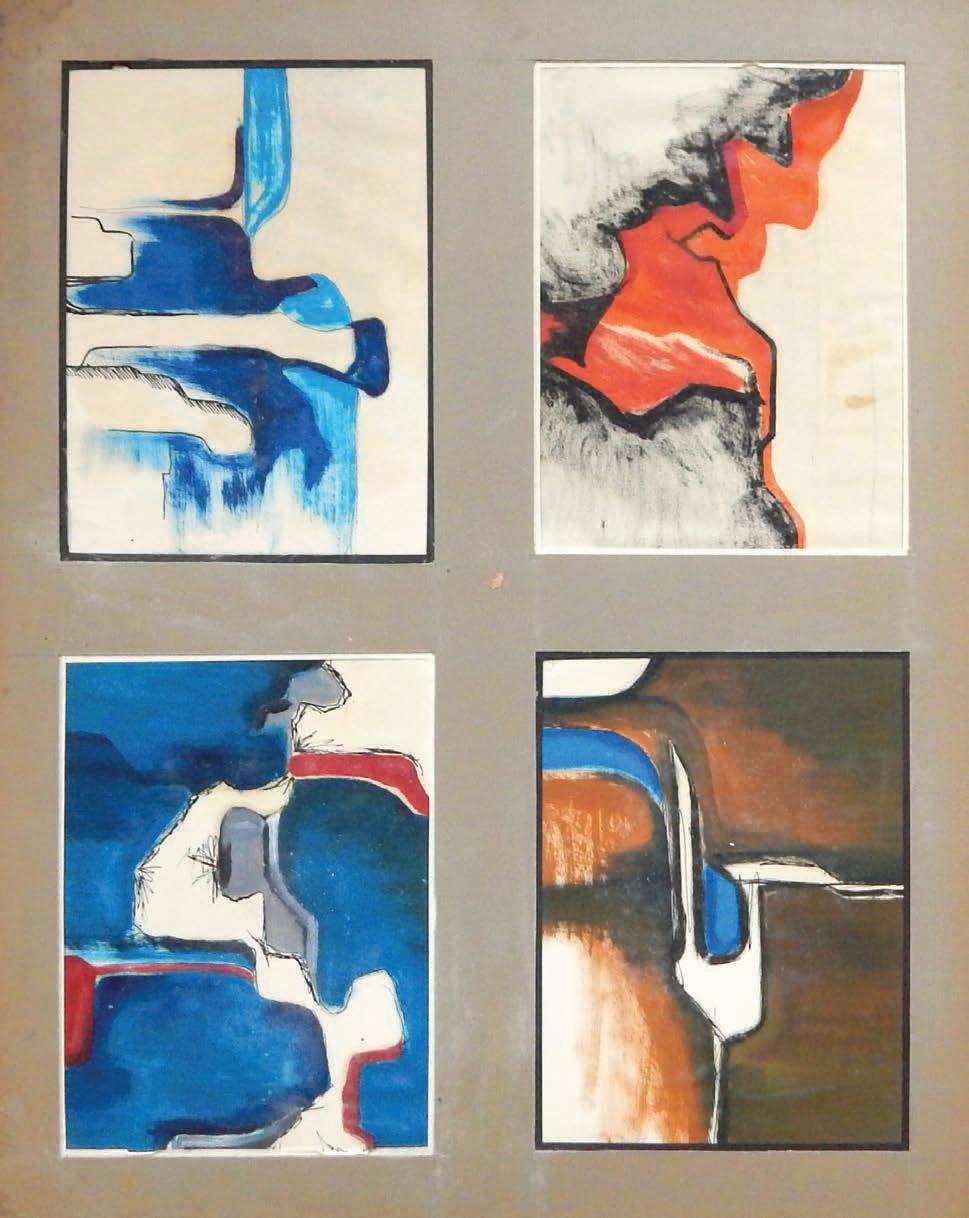
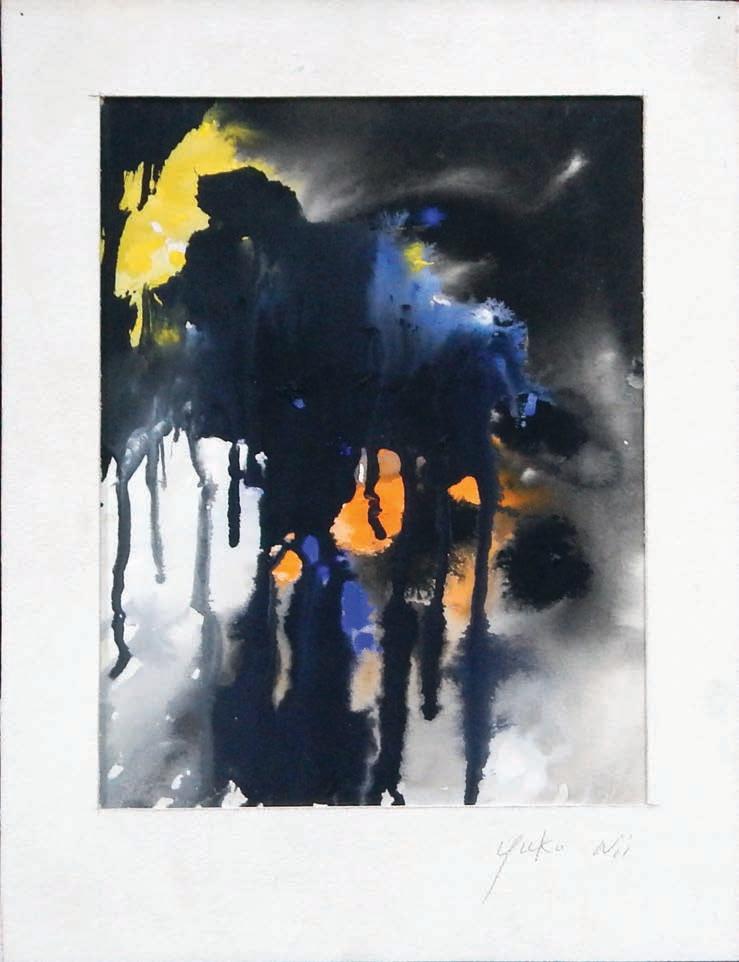
Watercolor on paper, 14” x 11”

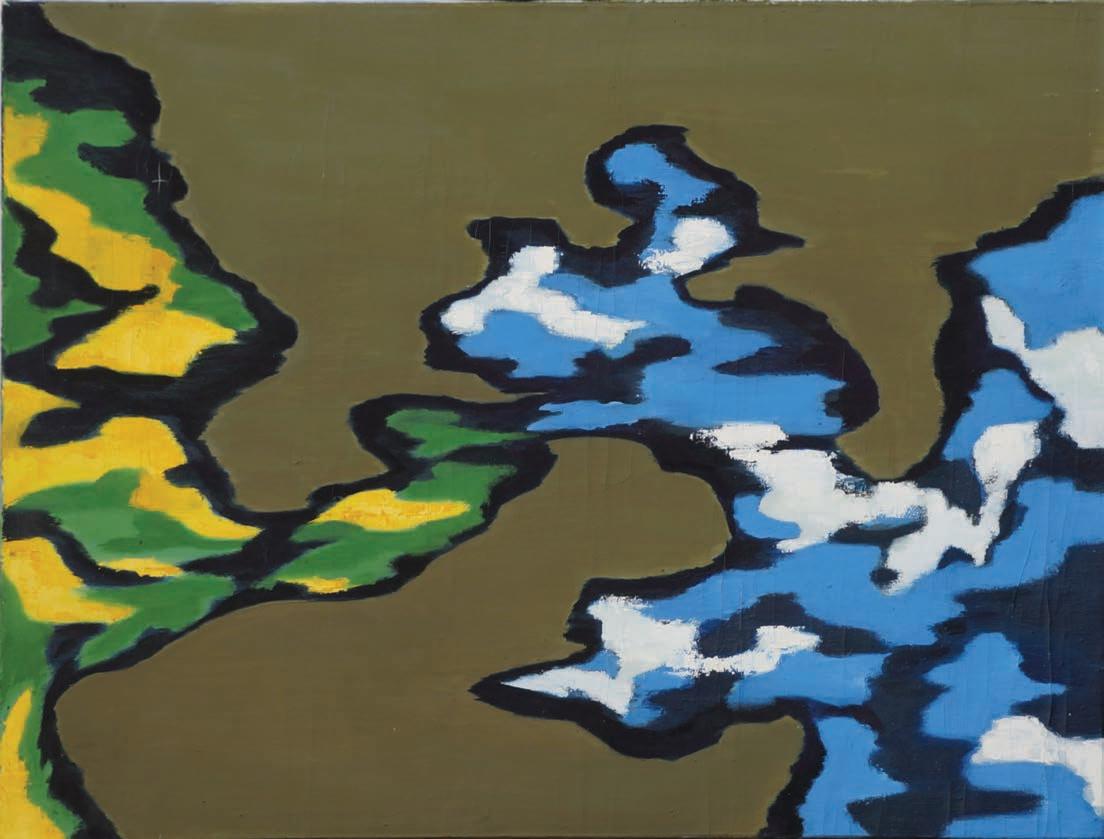


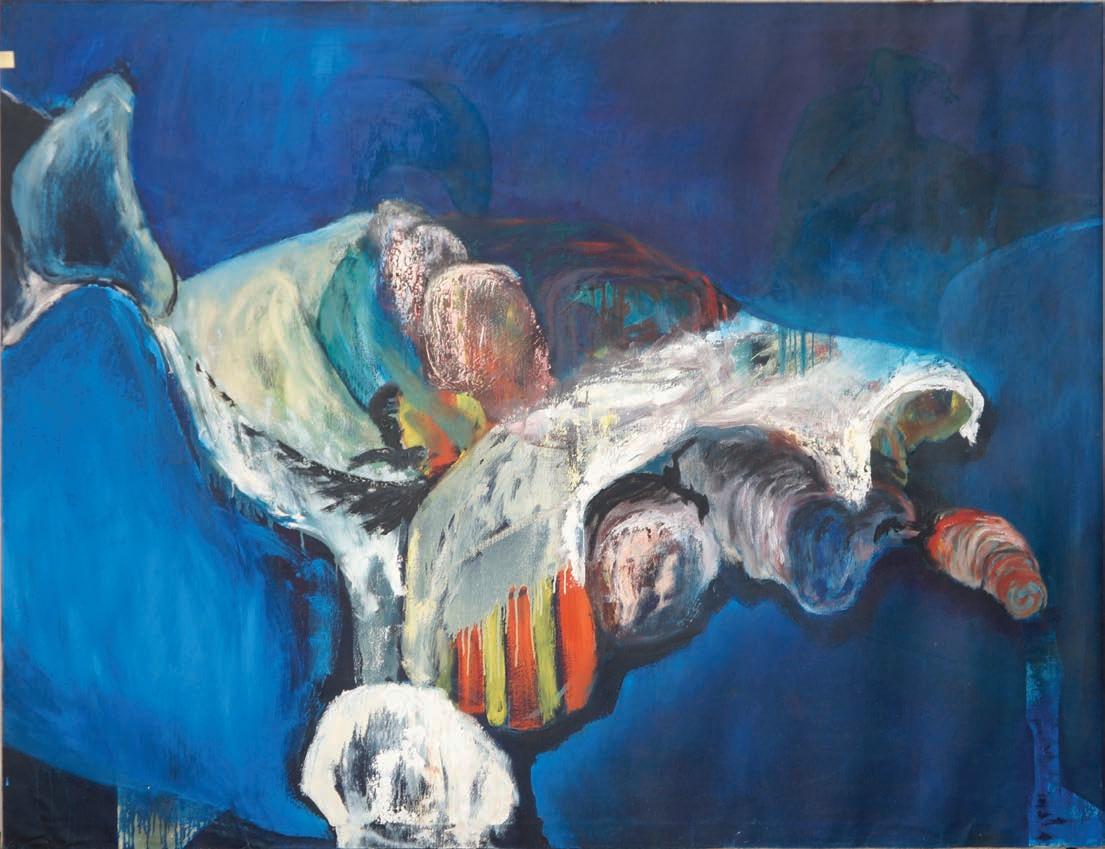
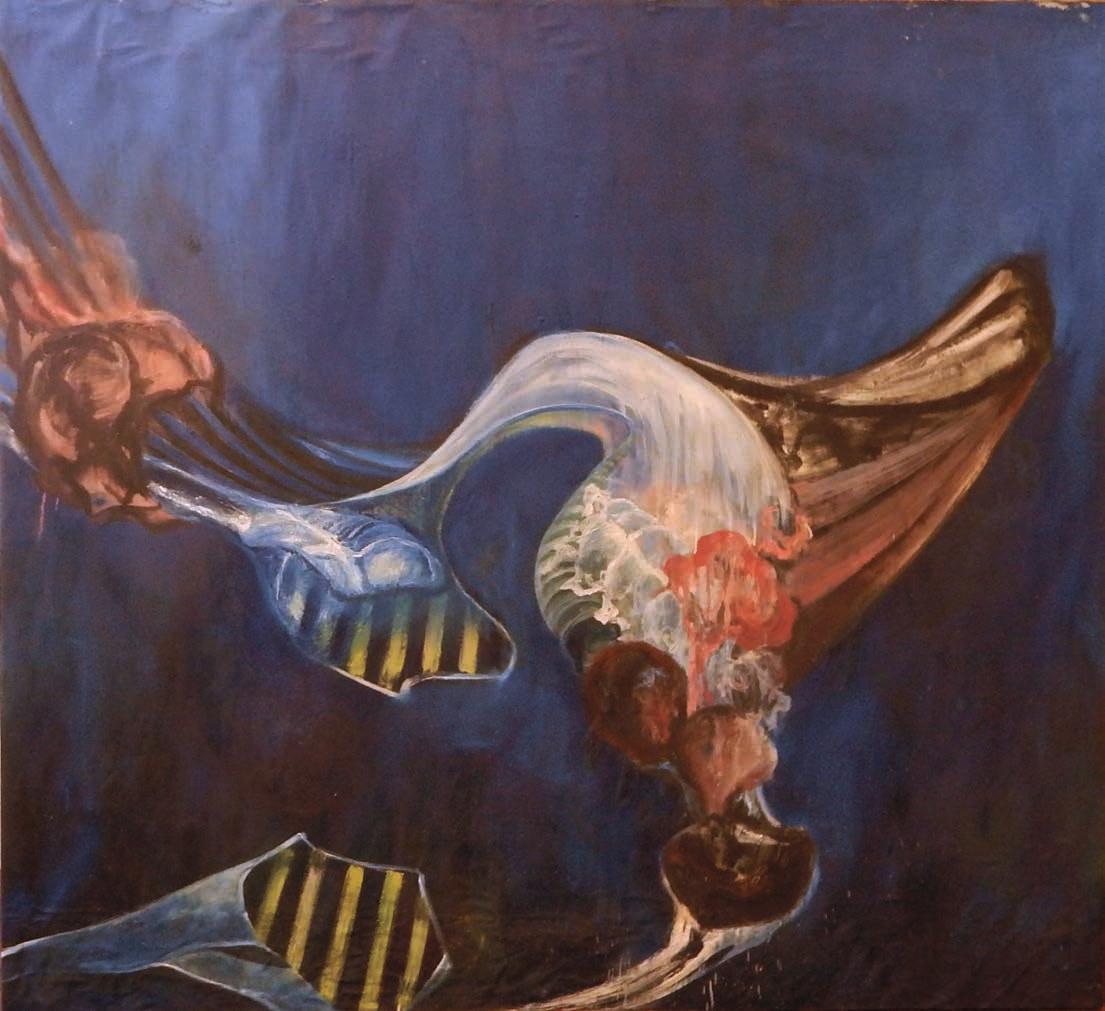
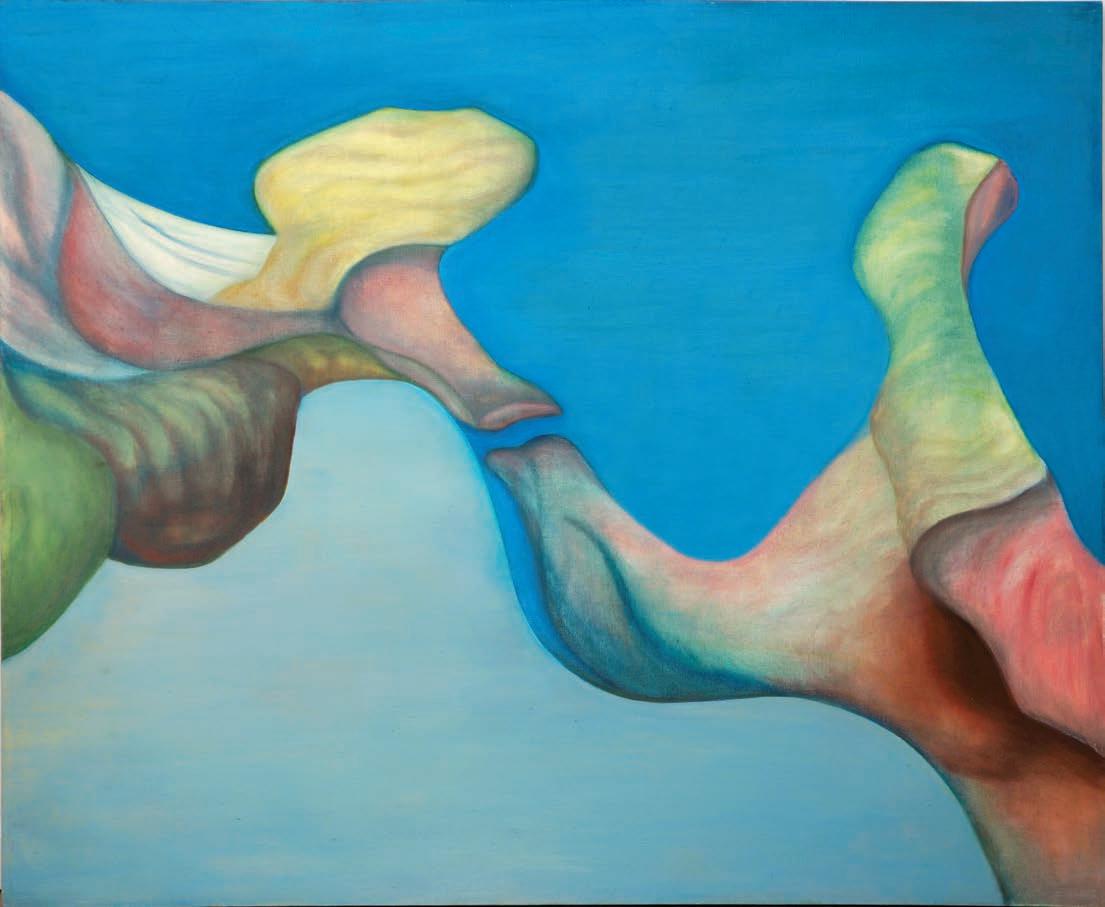


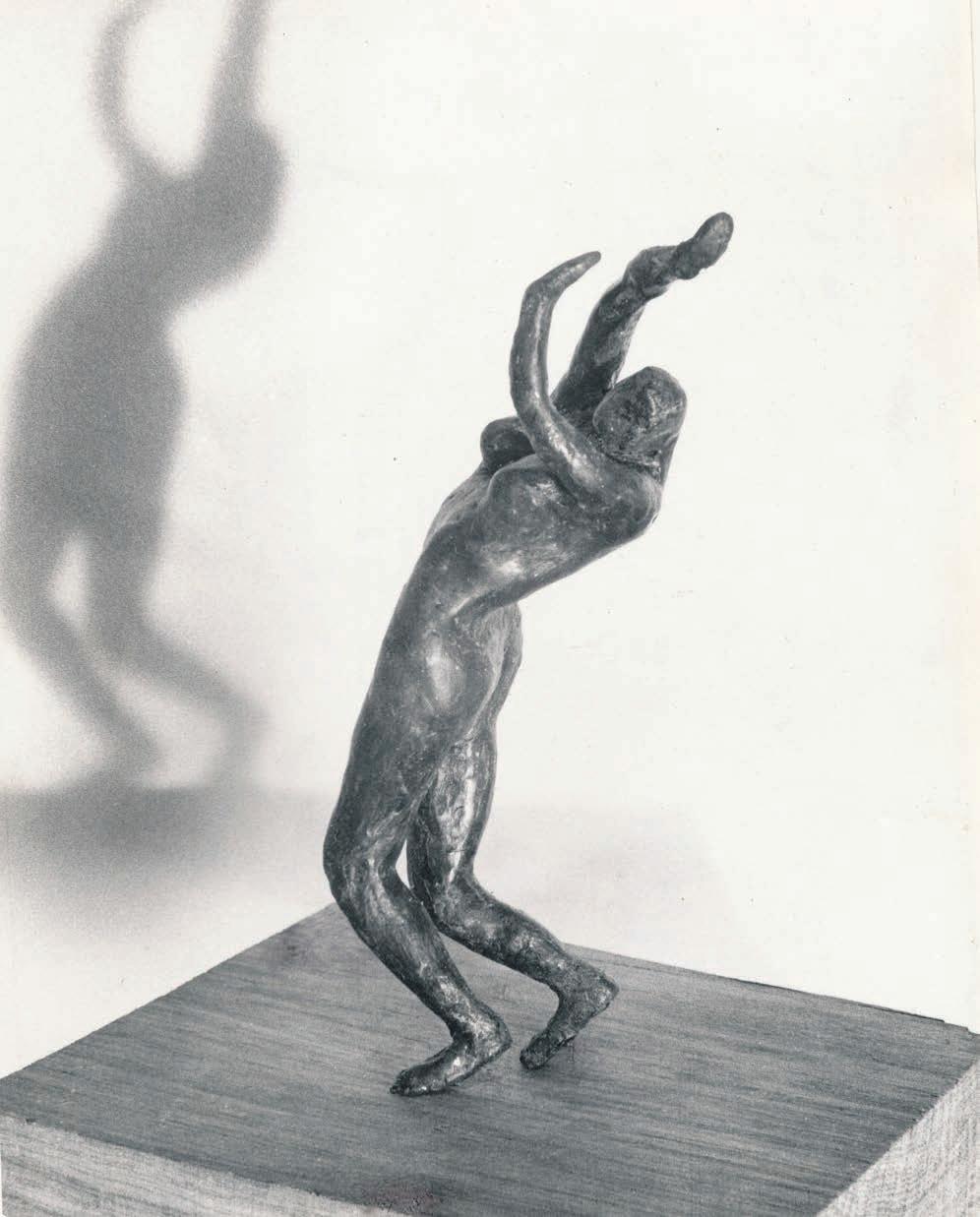


9.5 H x 10.5 x6.5 in.

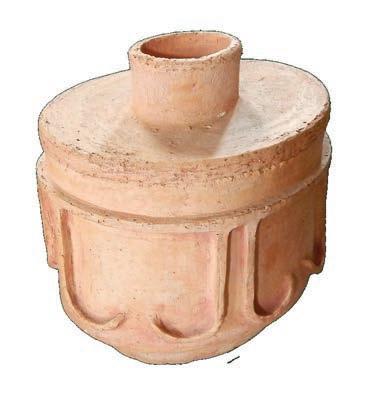

Yuko’s pottery at Pratt Institute were architectonic, solidly massive like buildings. They are engineered. One can imagine them build as huge modernist structures with doors sand windows, able to withstand earthquakes.
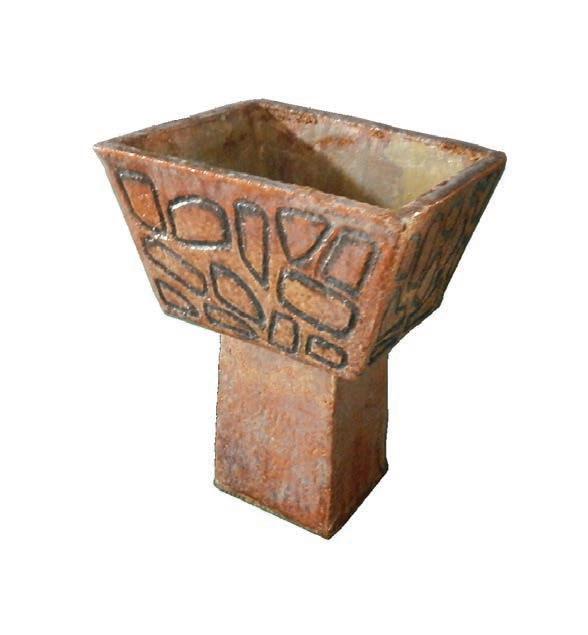
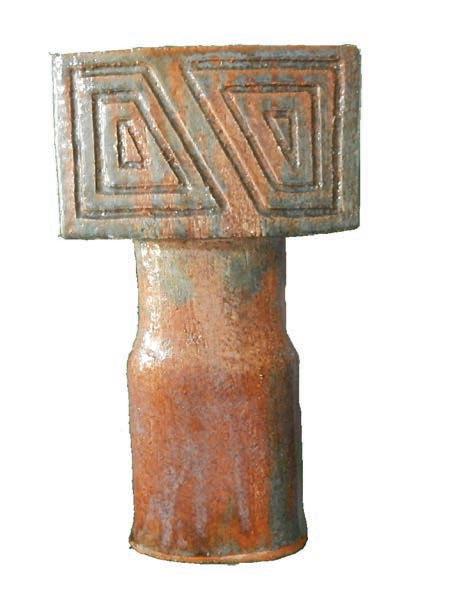
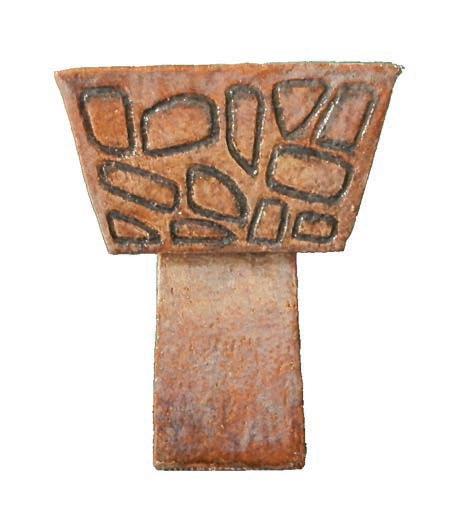
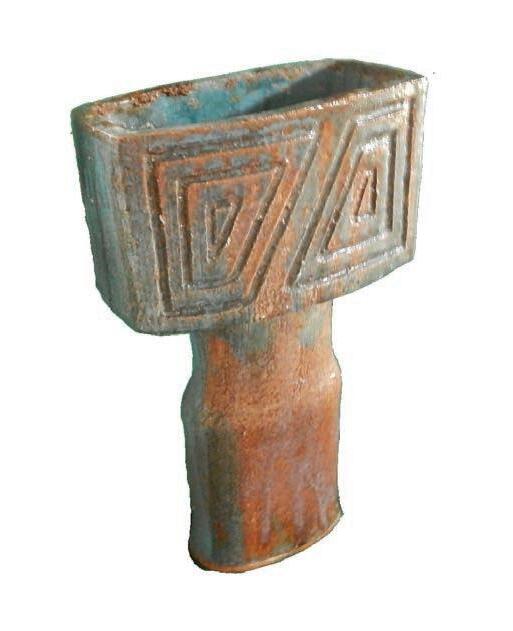
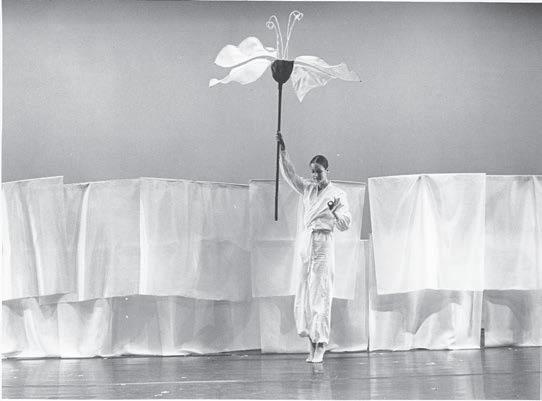
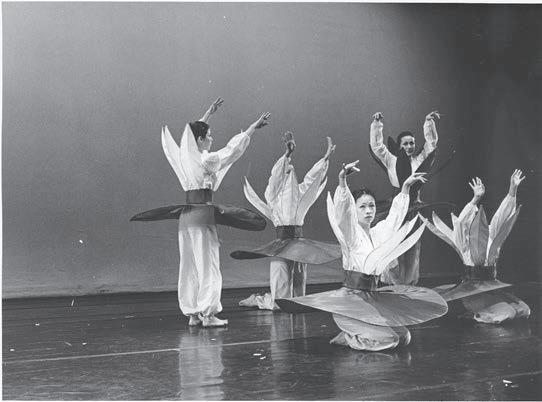
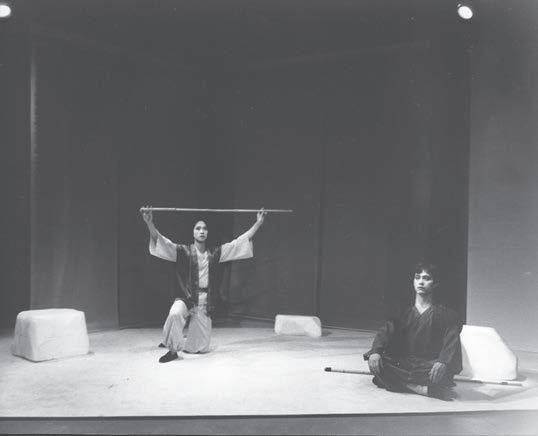
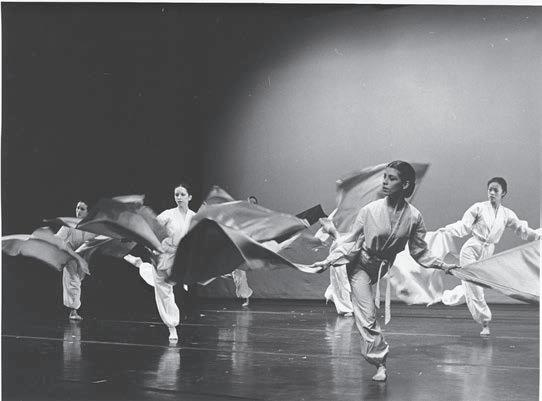
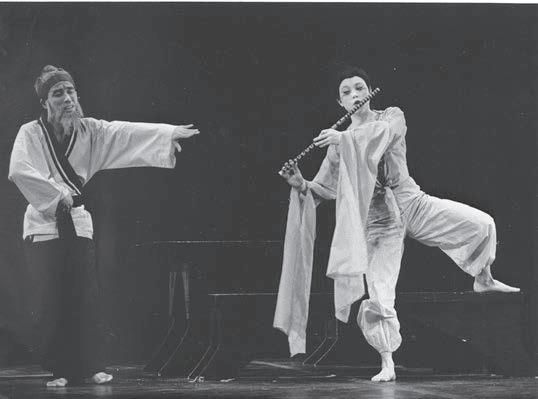

“Movement,” 1981, White Space gallery, Soho, New York City
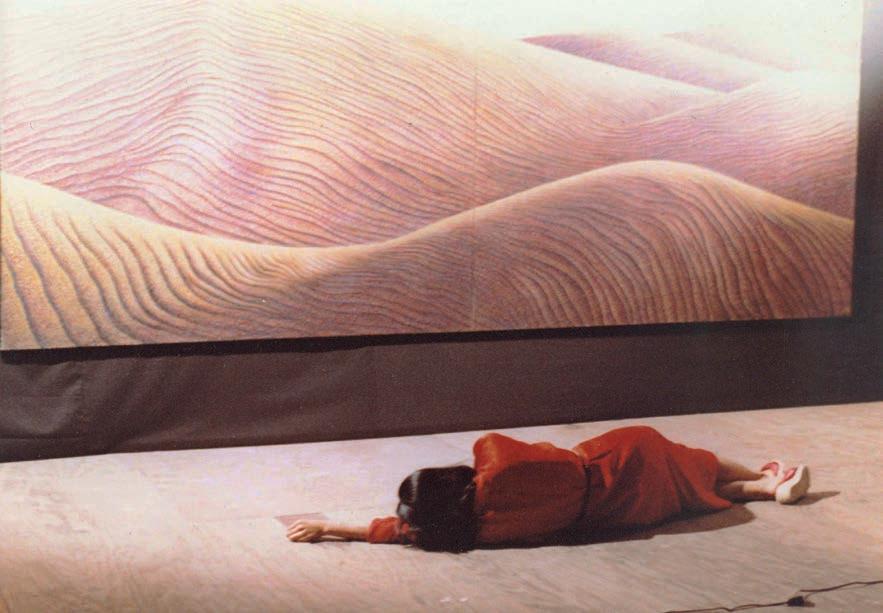
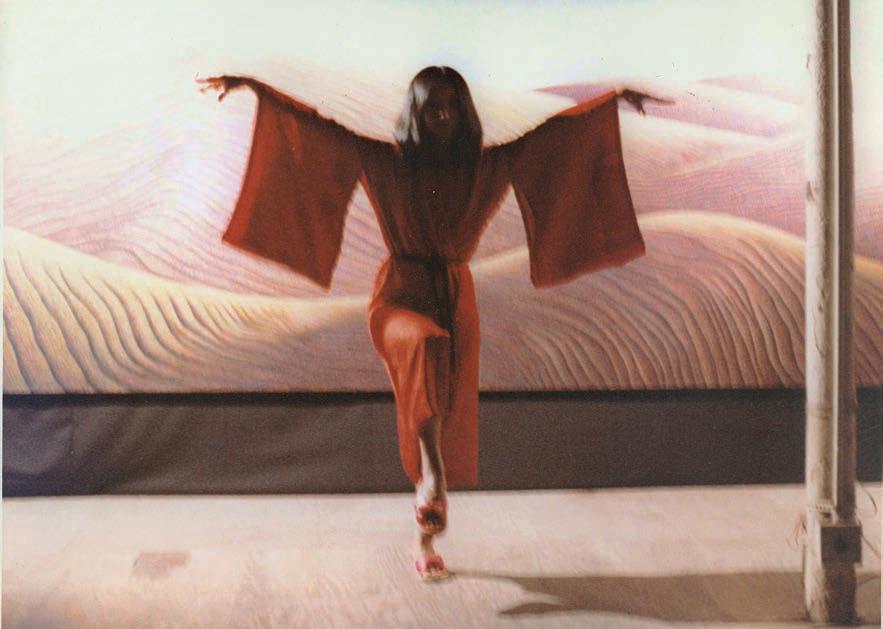
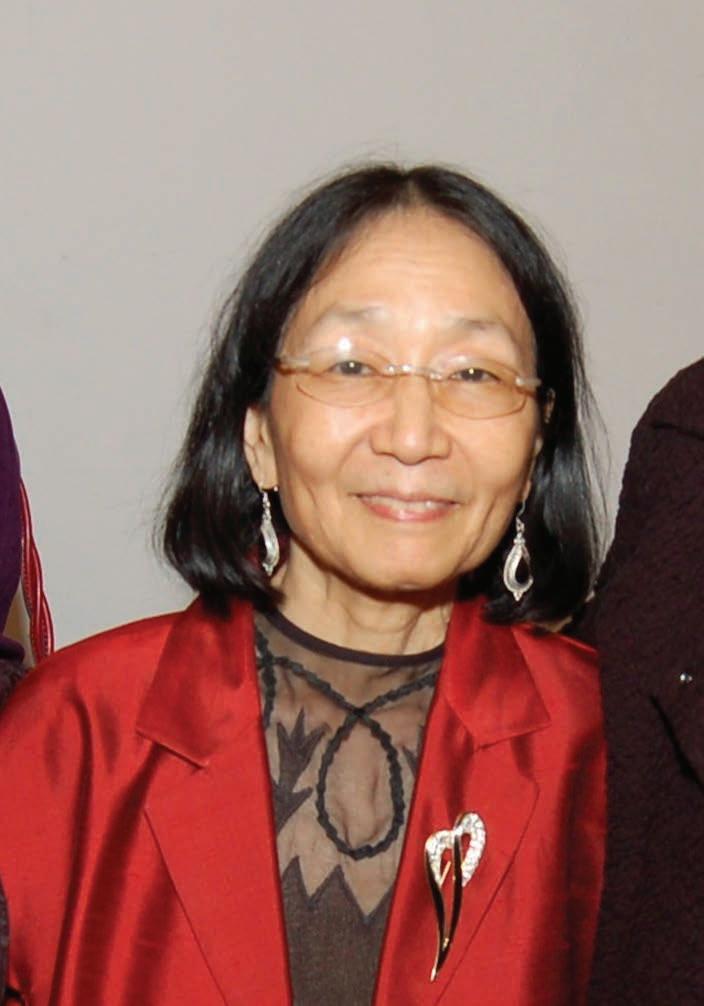

My mother told me that ever since I was young, I kept asking too many questions of why, what and how, etc., to my parents, and when they were too busy to answer me, they used to tell me, “Go ask grandpa and grandma.” I can imagine it must have been annoying sometimes to my busy parents. My questions were as she gave me some examples, why the sky was blue, and would change to pink and red sometimes, and to black at night with sparkling lights, what is all that white stuff coming down from sky when it gets cold, why it rains, why do flowers bloom, why are summers hot and why do the leaves change to brown and disappear, etc. and why I have to go to a kindergarten, etc. why, why, why....
After I was able to read, my parents bought me the entire encyclopedia for me to read and learn...I was left alone quietly. And they also told me to write down whatever came to my mind.
So, my writing and drawing became my habit, and my liking to write and draw started at my young age. But I have to admit that I am not an expert writer or scholar. I write what comes to my mind in a simple, spontaneous, and amateurish way just like I talk conversationally with people. I do it for the sake of fun, maybe you might call it as a hobby.
Before I opened the WAH Center, because I had more time to spend on writing, I was able to write on various topics: some were more serious philosophical thoughts, fictions, my travelling experiences, poems, etc. And I kept all of the original document in a binding. One day a friend of mine who became very interested in reading my writing, I lent him the booklet. Unfortunate and the least unexpected thing could happen in our life, my friend’s house was burnt by a big fire, and he lost practically everything in his house including my booklet! I learned a good lesson: one has to keep a copy of any important documents just in case….
So, what I have here in this booklet is very limited version, because after the Center was opened. I became awfully busy with the same reason I quit painting.
My writing in this booklet varies from philosophical thoughts to simple story telling, poems, and light-hearted jokes, etc. Sometimes I quit writing half way and leave it as was so there is no conclusion or sometimes incomprehensible what so ever. As long as I write for myself to keep me focused or even out of focus, I am satisfied just like I painted for myself to satisfy my own selfish desire. I call my act of writing and painting as “Haji-kaki” behavior in Japanese, which means “shameful behavior” or “shameless self- exposure.”
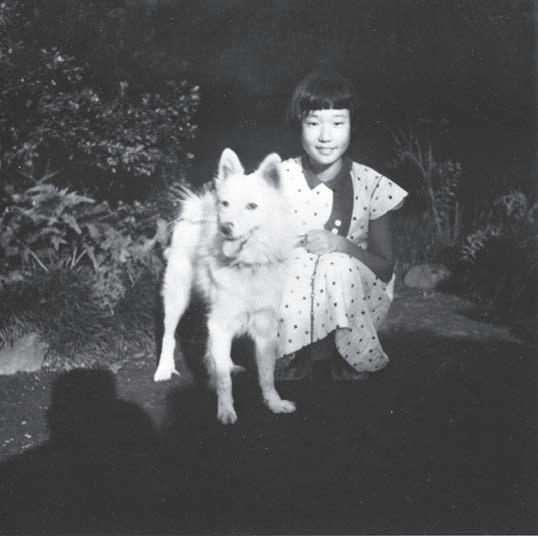
Nonetheless, I hope you will find some of my thoughts interesting.
Yuko Nii
October, 1996
To write about the Williamsburg Art & Historical Center’s mission and my vision in creating it, I have to go back to my past. In 1876 the American missionary, Dr. Williams S. Clark founded the Sapporo Agricultural College (currently Hokkaido University) in Hokkaido, Japan. From a very early age, I was struck by his famous words, “Boys, Be Ambitious!” His words have always been a driving force in me, both encouraging and influential. This is especially so because I had seen the great misery and devastation in Japan during and after World War II, where I spent the first twenty years of my life. I saw how my people, my country struggled and survived one of the worst periods of human history. Japan is a nation of beautiful culture—well structured and respectful of tradition, but rigid in many ways.
I dreamt a big dream. I dreamt of a big country. I felt a strong force tugging at me. And in 1963, at the age of 20, I left my country for the United States, “the land of opportunity” and a country of freedom and democracy. So I wanted to go there and pursue my dream of being an artist. When I decided to leave, my parents told me, “Yuko, you have a good life here, why do you choose a hard life in a foreign country?” But when they saw my strong determination, they finally concurred; a hard life at a young age enriches your future if you are willing to learn from it.
Needless to say, my new life in America, first as a foreign student and later as an artist, especially as a woman, was not easy. I never expected it to be. I encountered endless hardship, but in the process of learning and creating, there is always a challenge and struggle. There is also joy and satisfaction, for to create is to encompass one’s collective life experiences that result in the discovery of one’s self. It is a pleasure to see one’s own growth in the process of learning and creating.
I chose to be a painter, but I was also deeply interested in other creative areas: dance, music, theater, literature, classics as well as contemporary works. I took advantage of what New York City had to offer—this richly diverse cultural center of the world. My heart and mind belongs here! While I was earning a living teaching fine art and woodworking, I pursued painting, stage set and costume design, graphic design, performance art, and writing. As they say, “An artist may be poor in pocketbook but is rich in heart.” I was no exception.
During my period of struggle, I met many insightful, interesting and wonderful people who supported and helped
me in many ways. They were and continue to be my dearest friends and mentors. I could never thank them enough for what they offered me. I would occasionally present them with small gifts, but some would refuse the gifts saying, “Yuko, we happily did what we were able to do for you. We do not expect anything in return. Instead, we hope that you will do the same for others in the future, if possible.” These wise words moved me so much that I started thinking seriously about how to fulfill their wish and express my gratitude. And, at the same time I started to appreciate the unique American spirit of “Charity and Volunteerism.”
There are numerous individuals, organizations, foundations and corporations in this country, donating their time, labor, goods and money to needy people. And I was a recipient of some of their American goodwill and generosity for which I was very thankful.
I was using my living room as my studio for several years after my graduation from Pratt Institute Graduate School In January 1969. I started teaching part time art and art history at a private high school in Manhattan, while I was pursuing my painting. But as the size of my paintings started to grow and the number of my artworks increased, I needed to find a larger studio to work on large projects during summer vacation away from school teaching in the city. Since I couldn’t afford a studio space in the city, I started looking elsewhere. To my delight I found one in upstate New York with a good size brick building, having a storefront and 2 apartments on the 2nd floor. Right away I bought it. It was 1976 and I was 34 years old. Since the condition of the building was very poor, I had to renovate it totally by myself and sometimes with the help of my friends. The newly renovated space became my studio and summer residence to get away from the city’s hectic life and heat so that I could concentrate on my work in the spacious studio and in the peaceful quite country. I was happy.
But, I started feeling uncomfortable in living in the environment of my summer studio. I had to look for some other places. I repeated this several times: first in Michigan, twice in upstate New York, next in Long Island. Each time I sold the renovated property, I gained some profit. I started realizing that my wish to express thanks to her kind American benefactors might come true someday. I decided to establish my own foundation for artists in need of help.
I looked forward to the day that these assets would enable me to establish a modest, but well-endowed foundation in Brooklyn where my art career began. You see, in 1969 I finished my Master’s Degree at Pratt institute in Brooklyn, New York. I consider Brooklyn my home.
In 1976 I quit teaching in order to more seriously pursue my art career. Because of my need for a year-round studio in
the city, I started looking for an affordable property. I found one in Williamsburg, Brooklyn through a New York Times ad. I purchased it right away without thinking twice. I didn’t know that Williamsburg was known as one of the heaviest drug dealing places, and therefore, one of the most dangerous places in New York City. No decent person wanted to buy the properties or move here. No wonder the property was indeed cheap! After an extensive renovation, I started living and working in the top floor loft, while I started renting other floors to young artists. This was 1986.
Sooner or later, I started recognizing that many more young artists were moving in to live and work, and some started to perform in run down vacant factory buildings or opened up small galleries. Williamsburg was beginning to flourish as an active international artist community with artists not only from the U.S.A. but also from abroad. But there were still only a few places for them to exhibit or perform. I started to realize more and more that there was a strong need for a larger scale exhibition and performance space.
Walking around the neighborhood, I discovered a vacant looking old three-story mansion standing quietly on Broadway at Bedford Avenue. A bronze plaque on the front façade (soon disappeared) said “New York City’s Landmark, 1966.” Ever since I became very curious about this mysterious building, and wishing to see the inside became my obsession. The front doors were always closed, showing no sign of any activities in the building. But one day in early 1996, I saw a sign on one of the windows, “Building for Sale.” My heart jumped with delight. I called the telephone number on the sign, and made an appointment with the owner of the building. Finally I was able to enter it! Each floor had it’s own distinctively unique character, as attractive as the exterior. I fell in love with this New York City Landmark, and the national Register of Historical Places, a French Second Empire masterpiece dating back to 1867.
A vision started to form in my mind immediately: the vision of a multi faceted art center.
So, I put aside my future plan of establishing my foundation so that I could pursue the art center first. Coincidentally, Terrance Lindall, an artist and old friend, expressed his desire to collaborate in the establishment of a non-profit arts center. In late 1996, my multifaceted, multicultural art center opened, and I named it the “Williamsburg Art and Historical Center” (WAH Center). WAH means in Japanese, Harmony or Peace or Unity. I wanted the WAH Center to be a place where art and people meet in peace and harmony, making unity through the universal language of art.
Although the Center is a huge undertaking, my wish to satisfy the obligation to my good American benefactors for
their kindness kept encouraging me to go forward. As soon as the Center opened in 1996, some artists started coming in to volunteer to offer us their time, energy, experience, skills, and spiritual support, etc. I was overwhelmed with their genuine support and enthusiasm.
I have no doubt in our ability to produce excellent, diverse and stimulating programs.
As you see, Dr. Clark’s words, “Boys, Be Ambitious,” has stayed with me well beyond my youth! And I firmly believe that the fulfillment of big dreams is still possible in America, “the land of opportunity.”
With this project I wish to express my heartfelt appreciation to this wonderful country, it’s generous people, and also my parents, who have provided me comfort and security, as well as deep love and understanding throughout my life. All of those made this Center possible.
Please join us.
With Gratitude, Yuko Nii
Founder & Artistic Director
Williamsburg Art & Historical Center (WAH Center)
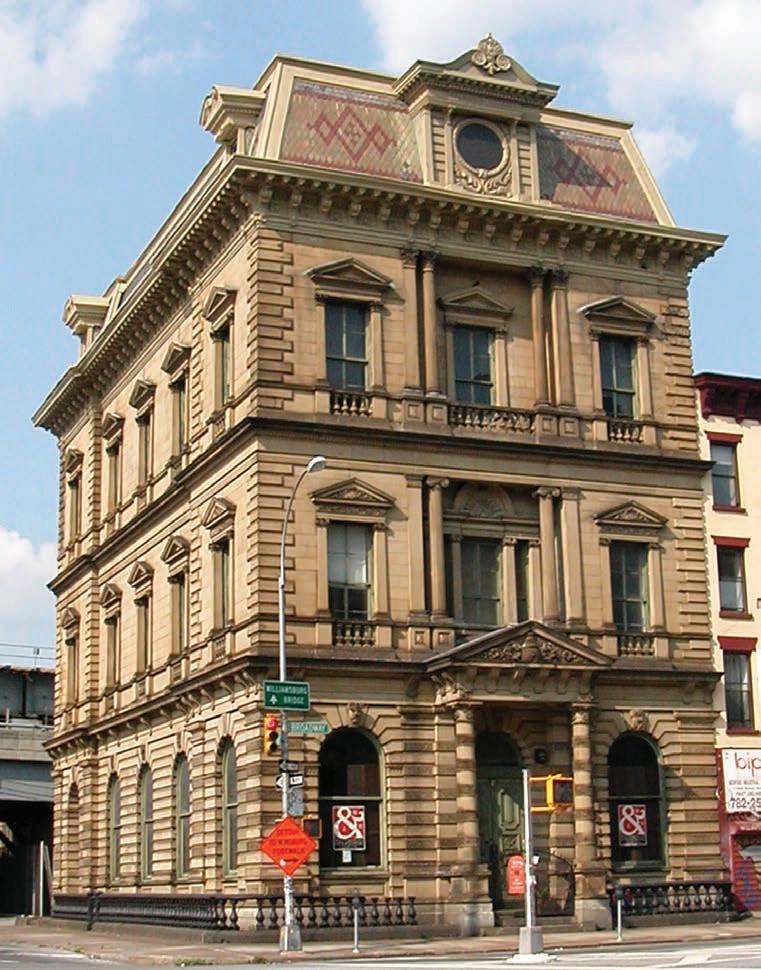
By Yuko Nii, Founder
I came from Japan, crossing a physical space and a gap of race and culture. I built a bridge of desire in my heart to understand and experience new ways of thinking and being, a desire to discover. Long Before me the Europeans had built a bridge of ships to America based upon their desire to discover. All human beings whether divided by oceans, mountains deserts or culture possess in their hearts an intangible net of bridges through the unconscious awareness, perhaps genetic, certainly spiritual, that binds us as a species and as creatures of the earth.
Look at the tendencies of things in this diverse culture of America where all peoples and types mix. We are moving forward always building bridges of understanding among peoples. Mankind is a bridge builder, and even today he is attempting to build a bridge to the stars! Who knows where man might go then, physically and spiritually.
And here is the Art Center at the foot of the Williamsburg Bridge in Brooklyn. Built by those who built the Bridge from Europe to America. Here again from just below the surface of my conscious mind came the idea of reaching out and crossing over, of discovery and meetings of minds and spirits. Here I realized it was possible to take the multitude of individual artistic energies here in Williamsburg and to coalesce them into a bright constellation of creative energy to be a star in the firmament of the City and perhaps even the world. Here then is the Bridge: This is the place where the art lover can meet the artist…on the bridge of space provided at the Center!
What an ideal location is the Center, easy access to Manhattan and thus to the International Art Community. Here we can build a bridge to the local, national and international communities, bringing artists and art lovers together! Here, those who cross this bridge to meet at the Center are emerging as well as established artists, artists who can inspire and enrich each other. Here, fine art can meet functional art (craft) and performing art can meet the other arts. Even technology can give means to artistic expression. All things meet at the point of the bridge called “The Center!” We are the hub of the net, we are the bright nexus of ideas that inspire new visions. All expressions, mental, physical, visual, aural will enrich our experiences, young and old, poor or rich. And we will bridge the gap of time showing how we came to be, how our art came to be from those who have gone before and taught us the way.
The Center will have art education programs. Children, teachers, parents, patrons, peers…together we will learn
to give and take (share) from each other at the “Center” of the bridge. We come to understand from each other what brings respect and love…by well connected bridges of art.
Yuko Nii and the Williamsburg Bridge
We are:
Art Center and Community
Art Center and (Chamber of) Commerce
Art Center and …let your imagination run!
All social fabrics fashion the cable of this bridge. We have a coat of many colors. A rainbow bridge leading to a pot of gold at its end. The colors of the artist’s palette. And the bridges are the thoughts which soar into new dimensions.
We are not politically bound. All ideas are welcome here when they are expressed sincerely and in peace. We have no agenda at the Center except for the free expression of good art. All people, if they have been blessed by the gift of life deserve to be welcomed and heard. Our expanding population and our technology has made the world small indeed. To live in close proximity with each other, we must not see the limits of our space, but the limitlessness of our ideas and our hearts. This can be found in the realms of discovery through art!
We invite everybody to come and visit us and to judge for yourself our merit!
October 22, 1996
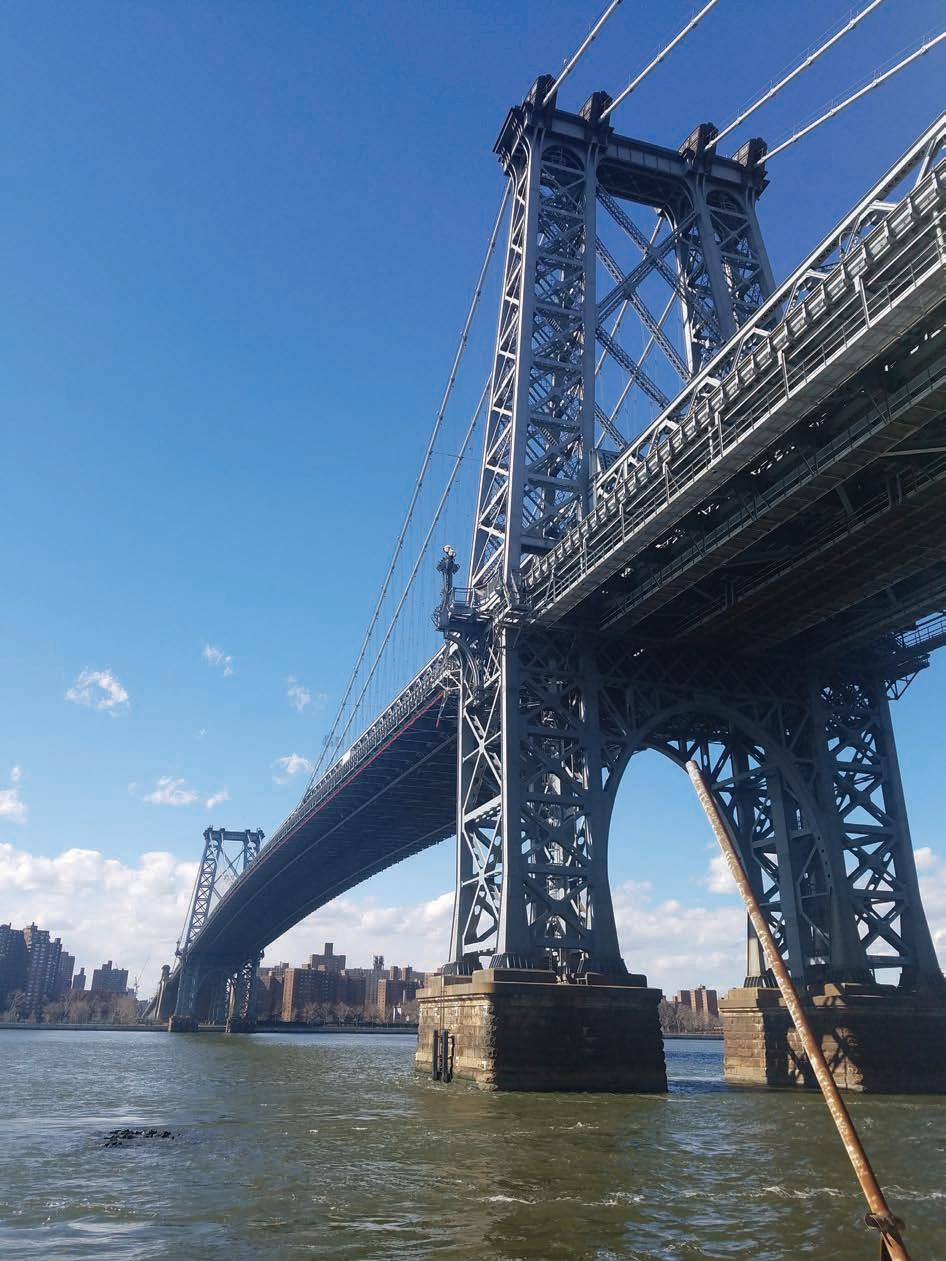
The WAH Center is housed in a significant historical building, the New York City Landmark Kings County Savings Bank Building built in 1867. It is also on the National Register of Historic Places and in the heart of the historical district of Williamsburg, Brooklyn, NY. I would like to see the unique hidden historical facts of the building be known and the WAH Center's legacy be passed on to future generations. People can then enjoy and value one of the important architectural and historical treasures in the heart of Williamsburg, Brooklyn. Also significantly, we are near the East River where millions of new immigrants have crossed over the Williamsburg Bridge from Manhattan since the turn of the last century to settle down and make Williamsburg a wonderful place to live and enjoy. I also happen to be one of the new comers who treasure this historically rich Williamsburg! And learning about Williamsburg is just as fascinating as reading some of the amazing stories of the wild wild West. Just to hear about the fact that 10% of the US wealth came from Williamsburg at one point in the 19th century and Williamsburg's subsequent decline after the Williamsburg Bridge was erected in 1903 is a great tale. We can see why there are several beautiful old bank buildings clustered in Williamsburg and then later tenements. A quick American transformation in a city such as this or like the Gold Rush or Homesteading across the American frontier is unthinkable in Japan or Europe.
Let me explain further about what is for me is an interesting coincidence. In late 1996 when I founded the WAH Center I promulgated the "Bridge Concept" and implemented it as the WAH Center's mission statement. In the back of my mind was the historical fact that the USA and Japan had already bridged their cultures long before I came to acquire the building and make it a functional venue for art and culture. The WAH Center's building is a French Second Empire masterpiece built in 1867. This was during the American
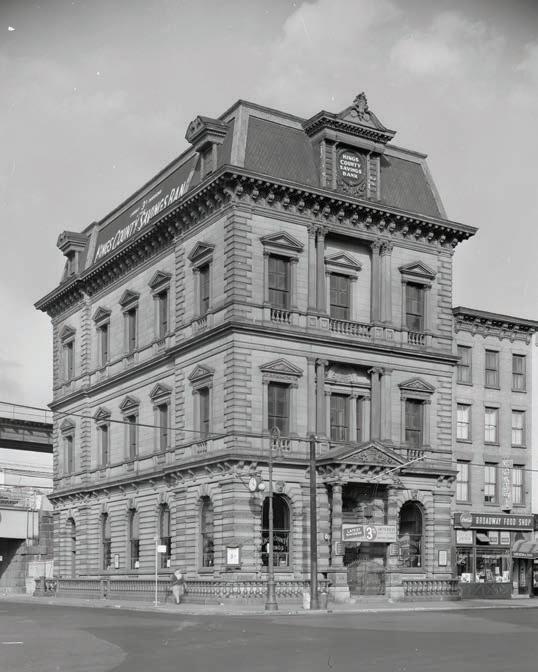
Civil War period, while in Japan it was the year of the defeat of the Shogun's army and the beginning of the new Meiji (enlightenment) era. During the Meiji Revolution, new Japanese policies were implemented, one of which was an open door policy toward other countries after the long lasting Edo Period of over 250 years that represented Japan's total isolation from the world. Thus, through the voyages of America’s Commodore Matthew Perry in 1852 and 1854, and during the new Meiji era (1868-1912) the Western way of thinking was introduced which influenced and transformed Japanese politics, education and the economy.
So the WAH Center's building, for me, symbolizes the “Cultural House of Enlightenment of the New Meiji Period.” It’s been housing cultural and art activities since the WAH Center opened 15 years ago, enlightening the community.
In the collections of the Yuko Nii Foundation we have a vast collection of art, books, porcelain, kimonos and more. In its library we have this original illustration of President Ford and Emperor Hirohito honoring Perry's world changing voyage to Japan. The illustration is actually signed by President Ford in 1974 and the illustrator Lloyd Ostendorf. Ostendorf was the 20th century's pre-eminent authority on Lincoln photographs and most famous illustrator of the life of Lincoln.

And yes that is a first edition, 1956, of Perry's voyage. There was one previous large format version presented only to members of congress. It contained an infamous nude bathing scene that scandalized the capitol.
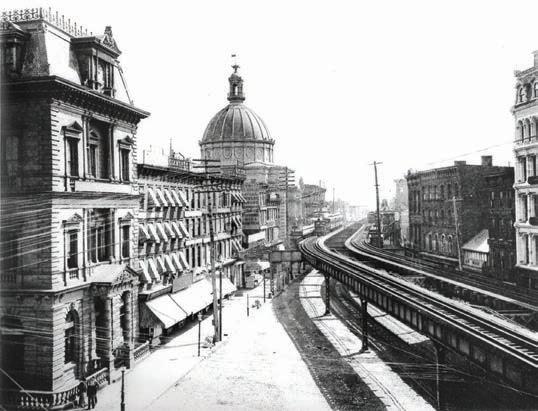
I wanted to buy another place as my studio and I did not have a lot of money, so I scanned the New York Times for something inexpensive. In Williamsburg Brooklyn there was a three-story building that seemed to fit the bill. I checked it out. It was a rough neighborhood with dark streets with garbage all around and a lot of graffiti. Local thugs hanging on the street told me “you better not hang around here Chino (they thought I was Chinese) or you’ll get hurt. I took my chance and bought the building. Gangs of kids played stickball on the street during the day. Next door a store opened up. It had various brands of laundry boxes in the window. I went I once and wanted to buy something. They just glared at me and told me to go away. I found out that it was a front to sell drugs. One day I went outside and there was a dead body on the sidewalk. Another day I hears a lot of gunshots. The police had closed the sidewalk next door and had fired many rounds into the windows without results. The gangsters had installed bulletproof glass!
It all started when Williamsburg was a no man’s land with empty factory buildings, roaming gangs and garbage everywhere. Poor artists needed a place to live and work that wasn’t too expensive. Only in run down Williamsburg could you find cheap rent, unless you were lucky to be able to crash an empty building and live free. Yuko discovered Williamsburg in the 1980s when she was looking for real estate and found a nice building that wasn’t too expensive on Grand Street. With sweat equity and a pioneering spirit she fixed the property, mostly with her own labor, and rented it out to artists. At that time there were not a lot of artists living in the area, but as the years passed this changed dramatically.
The artists at that time were a wild bunch. They invaded and occupied empty factory buildings on streets rife with drug dealing gangs and burnt out cars skeletons to avoid paying rent. They had all night parties. They were care free, careless, and reckless; their camaraderie made them a big gang in themselves. Not all artists were that way, but most were. Whether or not they were good artist, most came to Williamsburg to live cheap and have a good time while in their heyday. (Now they are in their ’50s or ’60s. Tempus Fugit!) But then they were all part of “the scene.” Most knew each other. It was a regular steaming soup of creativity and happenings, mostly unknown outside of Williamsburg itself.
The artists had “open studio” events from time to time and gallery owners and art aficionados from Manhattan would come to the area to look and maybe pick up an artist for their stable. The trickle of “tourists” gave some artists the bright idea of opening restaurants. One of the first artistrun restaurants was Stacie’s on the corner of Broadway and Berry.
Slowly at first, the trickle of artists into Williamsburg began to accelerate; more artists, more visitors, more interest from the public.
Yuko, who was at the time an already established working artist, was living in the building she had purchased and restored in the 1980s. She worked with local police and the community to improve safety in the neighborhood, as things were pretty bad. One would walk out the door in the morning and find dead bodies. The storefront next to her building was occupied by drug dealers who camouflaged their operation by putting boxes of detergent and other things in the window pretending they were small groceries. One day there was a shootout between police and the drug
dealers. The police attempted to shoot out the windows, but the dealers had installed bulletproof glass.
Early on, Williamsburg had two art galleries, Minor Injury and Brand Name Damages, and bars such as The Right Bank, Teddy's, The Ship's Mast, and theaters such as The Open Window and Epoché. Newspapers began to pop up such as Word of Mouth (WOM), late called “WORM.” Another called The Nose (or The Brooklyn Nose), was compiled and published by Ethan Petit and included poetry, philosophy, and critical theory. Original issues are in the WAH Center’s archives. Waterfront Week was a legal-size Xeroxable gossip/info newspaper also started with the help of Ethan Petit, although later it was taken over by others and made into a more conventional magazine. Genia Gould who now publishes the Greenpoint Gazette wrote for them.
In May 1981, the Monumental Show was launched. It was a show of over 150 artists in a former Civil War munitions factory near the Gowanus Canal. As one of the first mega shows, Monumental included well-known artists like Keith Haring, Carl Andre, and many lesser-known artists, as well as the totally unknown. The opening party featured rock bands and other performances.
The following year, another exhibit called All-Fools Show continued the trend.
Certain buildings became havens for dozens of artists such as the old potato chip factory in Greenpoint.
Some early galleries were A Place Apart Gallery, Brand Name Damages, Minor Injury, The New Waterfront Museum, with LedisFlam on North 6th Street being billed as the first “commercial” gallery. A Place Apart Gallery (formerly Sirovich Gallery) opened in 1982 and was operated by Marguerite Munch. Annie Herron—sometimes called the "doyenne" of Williamsburg—is also said to have founded the commercial gallery, Test Site, in 1991. There is a lot of contradictory information out there being touted as the factual history of the Williamsburg Art Scene. What is and is not accurate is difficult to determine from oral histories of the artists who were there at the time since they all seem to think that what they were doing was what created the scene and was a world-class phenomenon. Mostly it is a matter of which “gang” of artists or galleries the writer belonged to or has adopted. And indeed there were and are still some major rivalries among artists and galleries who are not that all important outside of Williamsburg itself, even though they thought or think they are.
Other early galleries were State of the Arts Gallery, 4 Walls Project, founded by Mike Ballou, Adam Simon and Michele Araujo. “Organism” was created by a group of Williamsburg art activists revolving around Ebon Fisher who occupied the
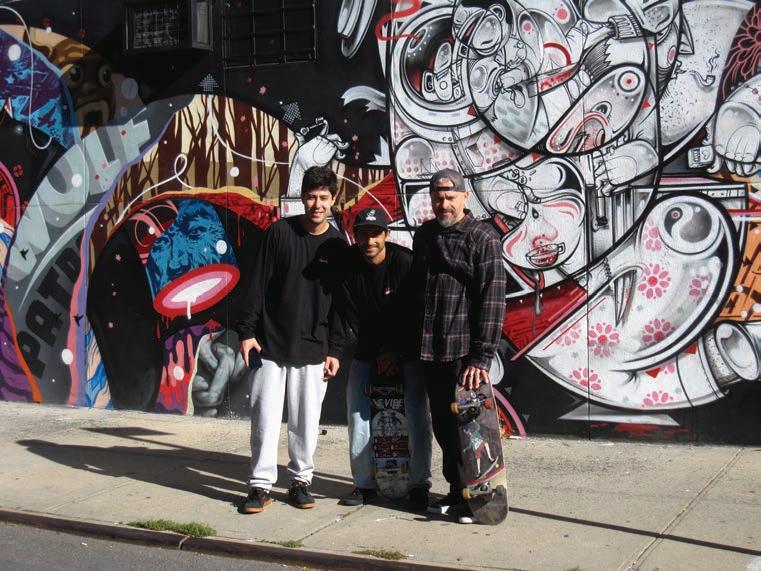
vacant Old Dutch Mustard Factory where an estimated 2400 revelers joined in for an all-night party, common occurrences throughout the 1980s and ’90s. One of the early figures in Williamsburg who influenced a lot of the artists at that time was Ebon Fisher a transmedia artist working at the intersection of art, biology and digital media. Informed by his exposure to cybernetics and feedback systems at the MIT Media Lab in the mid-1980s, Fisher approached his work as an evolving collaboration with the world.Fisher invented the concept of “Wigglism” part of whose manifesto is “At this twist in the orgy of Mystery we are drunk with the sweat of the stars, with that which seems alive, with lunges, lickings and startled presences. We fuse with the creatures of our devotion, becoming everything we encounter, becoming devotion itself.” Fascinating! I have not heard much about his concepts influencing anyone broadly. It remains to be seen. [I moved this paragraph, but I’m not sure the section in blue is even necessary as it does not get into the galleries/ history of the Williamsburg art scene]
1992 Annie Herron created Salon of Mating Spiders, an art extravaganza at her influential Willamsburg gallery Test-Site that included a street fair, music performances, picnics and happenings. But she was too soon on a scene that had not hit its stride commercially. And Test-Site folded.
The WAH Center was never really a part of that early scene. Although we were a founding member of the Williamsburg Gallery Association, our appearance was not really appreciated. Some of the smaller early galleries did not like the idea
of being suddenly overshadowed by a major art center among them. We were stealing the thunder their “scene” created over the previous 15 or so years! Eventually we left that the Gallery Association since it seemed it was only using its resources for the benefit of a few and so we did not renew our membership. Later it expired, but was revivified by Front Room Gallery in a more equitable manner.
Other venues that should be mentioned include Joe Amrhein’s Pierogi 2000, and even Roebling Hall that became, for a short while, the apple of the eye of Art Forum and some art critics. That made the Williamsburg scene even more appealing. More galleries began to open and more artists flooded in. But time passes on and today one hears less abut Pierogi in the major press. And Roebling Hall moved to Chelsea where it folded shortly thereafter.
Other galleries that should be mentioned are Becky Smith’s Bellwether, Momenta Art, begun by Eric Heist and Laura Parness, Feed, founded in 1992 by Lisa Schroeder and Barry Hylton, Flip Side, Dam & Stuhltrager, Front Room (a very stable influence on the ‘Burg), Black and White, Naked Duck The Dollhaus, Dabora Gallery, Brooklyn Fire Proof, Side Show, Janet Kurnatowski, English Kills, Pocket Utopia, Ad Hoc Art, and Jessica Murray Projects. After her gallery folded, Annie Herron teamed up with Larry Walczak’s “eyewash” in 1998. They all played their part making a very rich and attractive alternative art scene.
James Kalm of The Brooklyn Rail says that he has documented nearly 140 art venues in Williamsburg since the 1980s. Most are gone. The successful ones are those that own their own buildings since selling art or getting grants is difficult.
The reasons why I think Williamsburg attracts people are:
Because it is an international artists’ community the town is filled with creative positive energy, dispersing uplifting good pleasant and healthy spirit so that one feels welcome upon his or her arrival to Williamburg. Because this is a small human-scaled town like a village, people are warm and friendly with “Down to Earth” spirit, not pretentious, but in a genuinely natural way.
Having many wonderful affordable international restaurants, interesting charming shops, variety of art galleries and performing spaces, the visitors as well as the residents can enjoy art and cultural events.
Because it is an artists community with constant flow of creative energy Williamsburg is organically evolving its environment to make Williamsburg an interesting place for many outsiders to visit and revisit and for residence to live and enjoy life.
It is not the city with concrete and metal where sounds bounce back and where its people are rather harsh and cold, but it is the village with wooden materials and natural fibers where sounds absorb and its people are soft, warm, and friendly. It’s not an overcrowded noisy fast paced restless town. It is a special kind of place where human bodies, minds and souls can rest leisurely and harmoniously in a cozy and an intimate environment. I call it a home and some call it an oasis.
I rented out two of the apartments in my new building to artists who are always looking for low rent places, even in a bad neighborhood. That helped to pay the mortgage and upgrade the building. I worked with some of my good neighbors and the police and eventually the character of the street began to change. Another factor in the change was that artists had discovered Williamsburg. They were being priced out of Soho and the East Village and they discovered that one subway stop into Brooklyn was a place of empty loft buildings or former factories where they could squat and live free or pay the landlord minimal rent for heatless large factory floors. Sure there were burnt out cars and garbage and street gangs, but artists will take a chance.
Over the next few years, the trickle of artists became a deluge. It was now in the late 1980s and 1990s and Williamsburg was the Bohemian grunge jungle. Friends of the artists would come into Williamsburg on weekends to have parties. Gallery owners in Manhattan would visit the artist’s lofts and maybe sign them to their stable of artists to show in glitzy Manhattan galleries or museums. Some enterprising artists opened up their studios as galleries. Some artists opened restaurants to accommodate the increasing influx of tourists. The word was getting out, even abroad. Articles began to appear in the New York Times, Time Out Magazine and other outlets such as radio and TV about the Williamsburg art scene. It was a big happening. By the early 1990s there were nearly 10,000 artists and over 80 galleries in Williamsburg.
Then things really started popping…the real estate predators arrived and began to buy and build condominiums because not only did artists want to live here, but culture minded art aficionados wanted to live here too. They were yogis, doctors, lawyers, real estate developers and business people of all types, but generally young. Now all kinds of businesses opened up to accommodate the new-money residents. Fancy apparel shops opened, and fine cuisine international restaurants. The City took notice and started paving the potholed streets and hauling away the burnt out cars. Money and influence had come to Brooklyn!
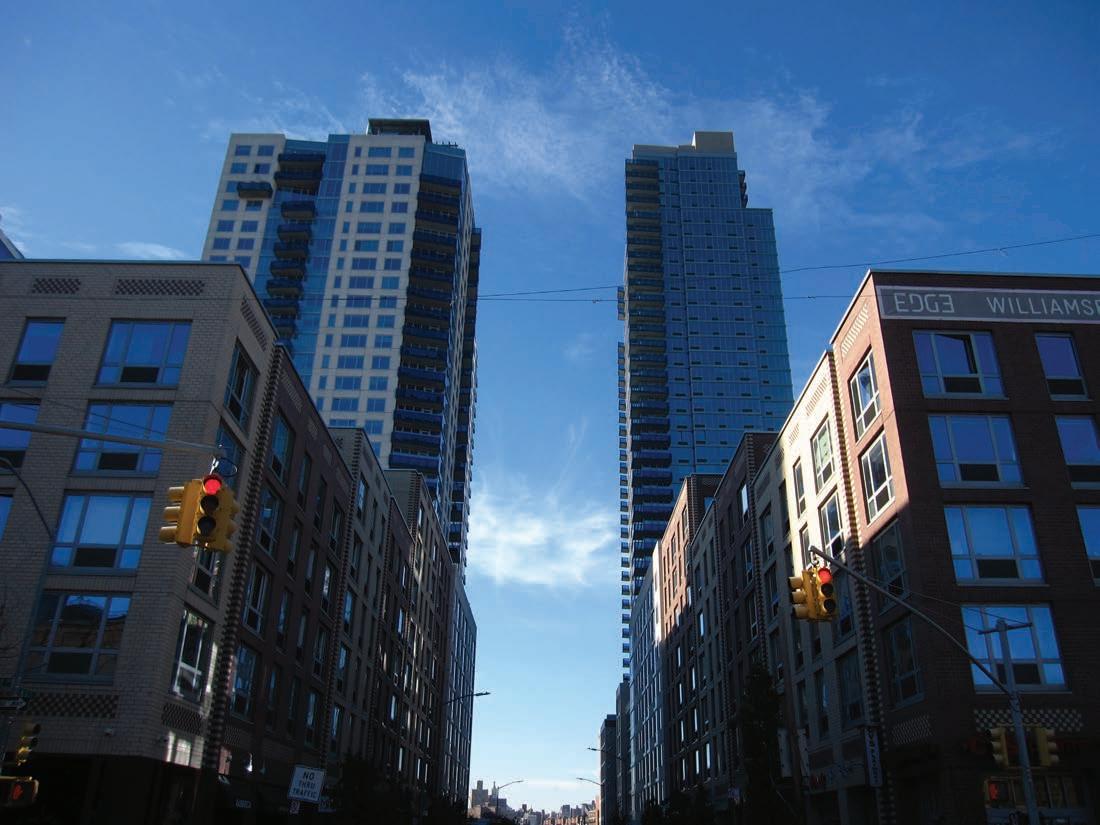
The WAH Centerʼs 16 years have given us all enough fascinating adventures for several lifetimes. We have met thousands of artists and performers, not to mention many wonderful guests and friends who have shown their interests, enthusiasm and faith in what we've been doing and have given us warm support for which we are very grateful. We are especially pleased to have helped launch the careers of some artists who are becoming well known.
What is known as “The Williamsburg Artists Community” all started when Williamsburg was a no manʼs land with empty factory buildings, roaming gangs, violence, and garbage everywhere. When a gentrification effort started in the 1980s in Soho and some other parts of New York City, the rents became too expensive for many artists to live and work in Manhattan. They had to find less expensive places to live, and Williamsburg was where they found their "Heavenly Oasis," since the rent was very low for spacious factory buildings or houses, and conveniently located, only one station away to Manhattan by L train. Williamsburg became their beloved tree where they could nest and where not only fine artists but also performers could pour their creative energy freely without worrying about making noise or other residential restrictions. Most of the artists were committed serious artists searching for an authentic artistic language of their own and not necessarily looking for commercial success. Their interest was purely directed to creative acts, and therefore, their art was fresh, raw and strong! After the first artists discovered Williamsburg, more artists started moving in.
The artists had open studios from time to time and artist run galleries opened up. Art aficionados would come to the Burg to look and maybe pick up an artist for their stable. The first trickle of artists into Wʼburg began to accelerate. More artists, more visitors, more interest from the public. By 1998 Williamsburg, especially the north side on Bedford Avenue (close to the Bedford Ave L train station), became the "hot place" to be where creative artists made unique happenings and shared the experience with all who showed up.
Yuko Nii was a serious mid-career working artist in search for a spacious studio. She found a building in Williamsburg
in 1986 through a New York Time's real estate ad, and bought a reasonably priced building. She restored it mostly through her own labor. She did not realize that Williamsburg was known as one of the most dangerous "drug trafficking" neighborhoods in New York City. She found that out later by living and experiencing. She took up the challenge and worked steadfastly with local police and the community to improve safety to build a good neighborhood. The attention that she and other community members brought to stabilizing the neighborhood eventually made the neighborhood unfit for criminals and slowly crime was diminished. Yuko saw how change could be possible with good and serious effort by citizens and their strong commitment to achieve a better place to live.
Driving through Williamsburg Yuko always noticed an impressive building standing on the corner of Broadway and Bedford Avenue. One day in 1996 there was a “For Sale” sign in the window. Yuko promptly called to take a look inside. She fell in love with the building immediately and her vision of creating a multi-faceted multi cultural art center was formed right on the spot.
Meanwhile, since her 40th birthday, she had set a big dream to establish her own foundation in the future to help support artists or art organizations. And from that point on she had been diligently working towards her dream. However, upon seeing the impressive landmark building her vision to create an art center in this building became an urgent necessity as she sensed there were numerous artists in Williamsburg, but not enough places to show their talents. She realized that she had to put off the foundation project for a while. The owner of the building took a look at this petite Japanese lady and did not take here seriously. Because of Yuko's strong commitment and wish to found an art center and preserve the old landmark, lo and behold, the owner finally gave in. Yuko took all of her ready cash, plunked it down, and the building was hers. Yuko had only $50 left in her bank. A Japanese lady, an artist, had acquired a national landmark building, one of the greatest pieces of architecture in the City of New York, the 7th building to be named a New York City landmark.
Meanwhile, an old good friend of Yukoʼs, Terrance (Terry) Lindall, had at that time a small museum at a Quaker meeting house in upstate New York, the Upperville Meeting House.
Terry came along to support Yuko's new endeavor. Since he was an expert in not-for-profit law, and at the time was the business manager for the American Numismatic Society, he filed the federal and state charities papers for the name Yuko had chosen, The Williamsburg Art & Historical Center, and so the WAH Center was launched! Terry also gave the
Quaker meetinghouse back to the Quakers in Hamilton New York in order to devote all of his energies to the WAH Center.
While pursuing Yuko's mission based upon her "Bridge Concept", the idea of which is to coalesce diverse artistic communities and create a global bridge with emerging and established artists of all disciplines, the WAH Center actively produced numerous art programs by working together with many artists and performers who helped develop ideas for programs. Early on several mature artists participated in the WAH Centerʼs programs and they offered to stay on as volunteers all this time, helping to develop the organization. We are very grateful for their generous and kind volunteer spirit.
Over the years the WAH Center has produced over 250 fine arts exhibitions and numerous performance programs. The WAH Center has had some of the largest international exhibits of their kind and has exhibited art from some of the foremost artists in the world. However, for the most part we have exhibited emerging and mid-career artists and performers who need venues like ours for support of ongoing work.
Thus, all throughout our 16 years we have had an ambitious program of art exhibitions, dance, music, theater, film, poetry readings, symposiums, lecture, open studios, Williamsburg Historical Tours, Chris Gray of the New York Times said, in October, 2000, that the WAH “...pursued a furious schedule, with symposiums, chamber music concerts, art exhibitions, juried shows, poetry series, dance festivals and related presentations.”
In 1999 we created on behalf of all Williamsburg the WILLIAMSBURG ARTS & CULTURE FESTIVAL (WAC Fest) to introduce Williamsburg's entire smorgasbord of offerings to the world in one great happening. We had shuttle buses running from Soho to Williamsburg and back. The weekend was highly successful with over 50 participating galleries, restaurants & local businesses plus 150 artists' open studios! The New York State Council on the Arts Chairman Richard Schwartz and his wife Sheila paid us a visit & took a walk to see some open studios. The following year, the north side galleries and artists formed The Elsewhere Festival and we joined them.
All of this was the beginning of a great presence in Williamsburg and Brooklyn. Over the course of the first years the leaders of the broader community recognized Yuko.
In 1998, Howard Golden, then Brooklyn Borough President, named Yuko Brooklynʼs “Woman of the Year” for her “unparalleled devotion to her art and commitment to the artist community of Williamsburg/Greenpoint.” And he said that the WAH Centerʼs activities have resulted in “tremendous
cultural & economic activity throughout the northern Brooklyn area.”
In 2001, Governor George Pataki named Yuko one of New York State's "women of the year" and called her a “Woman of Excellence with Vision and Courage.” He also congratulated Nii on turning the historic Kings County Savings Bank into a multipurpose art center that serves the needs of artists and art aficionados of diverse backgrounds.
In 2003, Borough President Marty Markowitz gave Nii the Betty Smith Arts Award for her outstanding achievements and contributions to the arts in Brooklyn. And also City Councilwoman Tracy Boyland gave her Outstanding Citizen award.
In 2008, Borough President Marty Markowitz named Nii as one of the six Asians “who provide dynamic leadership and demonstrate outstanding commitment to the betterment of our community and the Borough of Brooklyn,” and gave her the “Asian Cultural Award” along with John Liu, the current City Controller and Carol Enseki, then President of the Brooklyn Children's Museum.
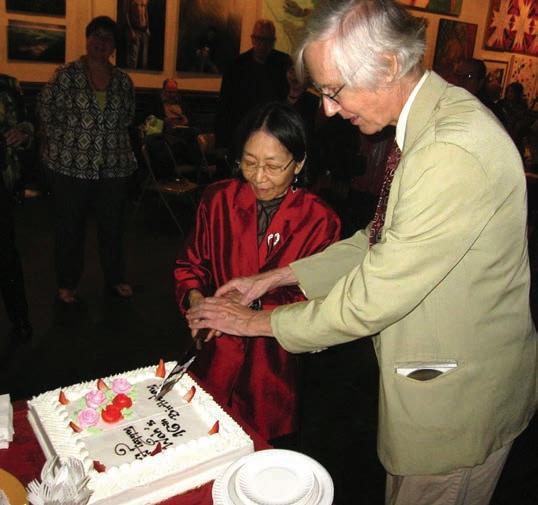
October 27, 2012
The WAH Center’s 16th Anniversary Celebration Message
From Yuko Nii, October, 27, 2012 for video
When I founded the non- profit Williamsburg Art & Historical Center (WAH Center) 16 years ago, Williamsburg, especially the south side where we are was a very dangerous place for strangers to visit.
But, gradually even in the south side we’ve started seeing a positive change and today it has become a totally different place, an alive, thriving vigorous neighborhood for many to enjoy.
We’ve tried to fulfill our “Bridge Concept” to merge diverse artistic communities and create a global bridge with emerging, mid-career and established artists of all disciplines.
So, thanks to the talented artists’ participations in various programs, we’ve been able to present to the public numerous rich and colorful programs.
I would like to thank the hidden supporters, such as long lasting staff members and volunteers, young interns from colleges, who’ve provided their talents, labor and time, and advisors who’ve guided us with their insightful knowledge and valuable experiences, and many donors either with goods or foods or financial aids. And further more, the government officials who have supported us financially and as well as spiritually.
Especially I want to thank the current Borough President Marty Markowitz, the former Borough president, Howard Golden, Former NY State Governor George Pataki who game me the honorable “Woman of the Year” awards, City Council members, Ken Fisher, who gave us program grants and Tracy Boyland who gave me a outstanding citizens’ awards, all of which up-lifted me.
We are now joyously celebrating our 16th anniversary, reflecting what we’ve done and thinking how to improve for the future, looking forward to make many wonderful things happen at the WAH Center. To achieve our goal, I hope you will continue to support us!
The word, “ WAH” means in Japanese, “Peace,” “Harmony” and “Unity. Through the international language of art, we come to understand each other, respect and love each other.” Please join us.
Thank you very much.
Yuko Nii, WAH Center’s Founder and Artistic Director

1 TO THE WAH: W WONDERFUL WONDROUS WOW! A AMAZING ASTONISHING AWESOME H HALLELUJAH HORAAY HAPPY BIRTHDAY!!!! WITH MUCH LOVE, Claire Jean Satin
2
*****Happy 16th Birthday*****
The Williamsburg Historical Arts Center WAH has created a home for emergent and established artists alike. WAH is the place where kindred spirits who share a love of art can gather and enjoy the experience of showcasing their work and appreciating the work of fellow artists. Thanks to Yuko,
her vision and her warmth all who enter WAH feel warm and welcome.
Happy 16th Birthday
Laura Conliffe
3
Happy 16th Birthday to WAH Center and Yuko! Founding the organization and leading it for 16 years is a tremendous accomplishment. It's all because Yuko's great talent as a curator, passion to move forward and her kindness to artists. This was not possible without Terrance's teamwork.
Jim and Yumiko Nolan
4
Dear WAH Center,
At age 16 I did not have a "voice". Now I do. You "heard" me and embraced me! Happy Birthday!!
Gloria Schuster
5
Happy Sweet 16! Brooklyn is very lucky to have you.
Grace Azar
6
Sweet Sixteen...brava WAH! Wishing you a creative future filled with many accomplishments...
Oxford Dictionary of English "wahexclam. Indian used typically to express admiration:
WAH, you look handsome enough to gladden my mother's heart! <ORIGIN> from Hindivāh." ~ • ~ • ~
7
Have a creative day,
CHUCK BERK Fine Art Studio...
8
Thanks Yuko! You have a wonderful space, much lock with all the wonderful things I know you will do.
Jocelyn Toffic T
9
Look what the WAH Center has accomplished in sixteen
years; imagine what the next sixteen years will bring! Congratulations and best wishes to a powerful force in the art scene of New York City. It is a privilege to be a part of such a vital organization.
Happy, happy birthday.
Mary Westring
10
Who knew there was such a little gem hidden away in Willamsburg!!!, and so accessible too, and fun!!
Amanda Husberg
11
Tra la-la-la-la-la-la-la-la, Happy birthday sweet sixteen.
Richie Lund
12
Dear Yuko Nii, staff, and artists at the WAH center
My connections began with the WAH center, when I first came to New York, and visited the gallery to see a group show including one of my favorite NY artists. The connection continues, as I have been able to show my own work at the gallery. I hope that Yuko's joyful vision will continue to flourish in Williamsburg for many many more years, bringing artists of different generations and backgrounds together in a vibrant community. Thank you WAH!
Katherine Toukhy
13
Birthdays are a wonderful time to look back and celebrate all that has been accomplished.
Thank you WAH Center for what you are doing for Artists and the Arts!
I'm certain that all will warmly appreciate your impact and significance for generations.
Happy Birthday WAH Center! Cheers!!
With love and peace, Jania Vanderwerff
14
Regardless, I wish WAH one super slammin’ sixteenth birthday and then sixteen hundred more just like it. Yuko, thank
you so much for all you are doing for your community and for the arts. May WAH still be strong and thriving long after us. Take care and I hope to see you soon.
Linda Billet
15
Dear Yuko,
Congratulations on your 16.WAH birthday. Have a happy birthday party, Love, Kerrin Grafin von Schwerin
16
Apio Verde to you; apio verde to you; apio verde, apio verde, apio verde to you!
It’s a Puerto Rican way that some people sing for Birthdays. Wish you the best for the great labor you have done all these years especially with people like me. Thanks,
Carmen Porfido
17
HAPPY BIRTHDAY, dear Yuko Superwoman! And many more.
Anita Corey
18
This is sent in appreciation of my dear friend Yuko Nii, who I hope is not so modest as to not to post this tribute. Many years ago Yuko shared this vision for the WAH Center with me and friends at a weekend in the Hamptons. Yuko was then a new friend but I sensed this deep spirituality and strong purpose of being. I am not surprised that in fulfilling her dream she has created this amazing cultural center. Yuko is a treasure that we are fortunate enough to call an adopted American and claim her as part of our heritage. What a miracle that her dear father had a love for this country and instilled it in his daughter so that she sought her future here and put down roots in New York. I am so proud of my friend and her generosity and example of goodwill and charm....May we all learn from her example.
Happy Birthday WAH Center and many more triumphs ahead! Sincerely,
Carol J. Becker
19
!!! Happy Sweet 16th Birthday WAH Center and Yuko & Terry!!!
!!! Congratulations for your survival with good works !!! !!! LONG LIVE THE WAH CENTER !!!
Best wishes, Tamiko Kawata
20
Hello lovely people of WAH Center!!!
"Happy Birthday!" and "Many more!" The friendship; the warm welcome; the showcasing of the well-known and the undiscovered; the performances and exhibitions; poetry; dance and music are some of the reasons why I go to the WAH many times a year. I know I miss a great deal, but that's because I have a hard time getting out. Otherwise, you would see me more often. As artists, we are all very grateful to all the galleries and museums and wall spaces and project rooms that show our work. And the WAH Center is on top of my gratitude list! And we should have a birthday party and celebrate and invite all the collectors and curators and the big wheels and the wonderful smaller wheels and watch it RUN!!!
Gülsen Calik
Who knew there was such a little gem hidden away in Willamsburg!!!, and so accessible too, and fun!!
Amanda Husberg
22
On WAH's Sweet 16th Anniversary HAPPY ANNIVERSARY YUKO!
TIME FOR HARVESTING!
Love, Carmen Frank
23
I want to send my best wishes with a reading for WAH: The Williamsburg Art and Historical Center is a rare gem among the monolith artistic institutions destined for the pages of history for centuries to come. I share my vision for the WAH which at first took my breath away when I felt its influence and foresight which grew stronger in not only cultural and educational value but for its multicultural
expressions of dance, poetry, theatrical and musical performance and a wide spectrum of visual arts: paintings drawings and sculpture, and for its magnificent collection of art. Yuko Nii, Terrance Lindall; your generous spirit planted the seeds of great achievement in the garden of cultural excellence. Happy Birthday WAH!
Sharyne E. Walker, Artist
24
The Williamsburg Art and Historical Center (WAH) has brought art alive in exciting new ways while leading the way in rejuvenating an area known as Williamsburg, Brooklyn, now a center for art and artists and others who want to live in a vibrant community. This dramatic renewal has been the result of the strong and dedicated leadership of the WAH Center and Yuko Nii and Terrance Lindall over 16 magical and inspiring years. Happy 16th and many more wonderful birthdays in your even more exciting years ahead!
Congratulations, Yuko and Terrance, on this grand event and its wonderful success, and also on the tremendous influence you have had on art and culture not just in your area, but throughout New York City and throughout our country! Your vision and dreams have served you and everyone else profoundly well and because of your vision and dreams we are all so very much better. Your tremendous belief and commitment have proven to be the basis for your great success as well as the powerful influence you have had on many, many generations—past, present and future.
With much admiration, Robert J. Wickenheiser
Milton aficionado and scholar, 19th President of St. Bonaventure University, and Chair of Williamsburg Circle of International Arts and Letter of the WAH Center.
25
Dear Yuko and Terry,
Enjoy and a very Happy Birthday
RoCa, Rodriguez Calero Visual Artist
26
Happy 16th birthday to the WAH Ctr.! Kudos to Yuko Nii and Terrance Lindall for helping to keep Brooklyn in the forefront as one of the world’s greatest art meccas!! Your dedication, hard work, and genuine care for the community have proved to be invaluable!!!
Chris O'Brien
27
May the WAH center live in peace, harmony and unity! May the shows of the WAH center bring to the people love, growth, joy, peace harmony and unity!
Happy birthday!
Francine Demeulenaere
28
Dear WAH Center,
You've come such a long way! May the bridges you have built through creativity, love, and solidarity continue to sustain artistic growth and a strong sense of community for years to come!
My best love and wishes, Raquel Guarino
29
Dear Sir Terrance Lindall & Ma'am Yuko Nii, WAH CENTER!!
YES! ITS A GRAND CELEBRATION WAH CENTER AND SWEET 16TH BIRTHDAY!
HAPPY BIRTHDAY WAH-16TH! or SWEET WAH 16TH BIRTHDAY!
MORE BLESSING TO COME! WAH Forever!
Your Brother Bienvenido Bones Banez Jr.
30
Dear Yuko & Terrance, Happy Sweet 16! The WAH Center has been a consistently progressive force for opening eyes and minds of the community to the stirring visions of its community of artists. It has offered an exhibition space to artists whose visions are not always the most commercially viable ones, but whose originality deserves to be celebrated. I have always found much of the work that you exhibit as well as the performances that you put on, to be revelatory and inspiring. May you go on and on in your present course.
Joel Simpson
31
Yuko Nii is an Art Santa Claus. She’s grown the WAH over all these years. It has become a special Art Center I support
with Pride and Devotion. The WAH’s poignant value is: GOOD ART WILL RECEIVE EXPOSURE …giving Artists a place to show whatever their hearts create. The WAH burst through Yuko’s Heart, became the WAH Center and gave Artists’ Hearts the chance TO BE FREE and TO CREATE. From my Heart to the WAH’s Heart to Yuko’s Heart comes my Heartfelt THANKS because the WAH is here to grow, flourish and mentor artists forever.
Estelle Levy
32
Dear Nii-sama,
I am always happy to hear that you are doing well. Congratulations, WAH Center's Sweet 16th Birthday! I wish if I could come there and join the wonderful show.
Much Love Always, Shungo Shimizu
33
I have known Yuko Nii slightly longer than the WAH Center and have witnessed steady growth, enviable success, and achieved ambition each passing year. Happy 16th and many more to come!
Your friend, Ellen K. Levy
34
Happy Birthday to the Williamsburg Art & Historical Center and to its loving caretakers Yuko and Terrance.
WAH as an institution can look back in pride at its accomplishments and the impact it has made on the artistic community. The gallery shows are a perpetual showcase for this planet's finest artists both emerging and recognizably established. WAH makes Williamsburg and New York City a richer experience with innumerable artistic pleasures and experiences. As an artist fortunate enough to participate in its gallery offerings I can say that I've met and continue to enjoy the company of fellow WAH artists whose diligent pursuit of creating world-class art is an both inspiration and humbling experience.
May this and every birthday that follows celebrate enjoy a prosperous and growing influence in the world's art scene.
Cheers and balloons, Frank Krasicki
35
Yuko, My heartiest congratulations for a great "Sweet 16" birthday for the WAH Center and wishes for continued success! Like a fine wine, it continues to get better and better as time goes on. I look forward to celebrating this important achievement with you and our fellow artists. Warm Regards,
Jeff Watts
36
Hi Yuko,
Great to hear of all the wonderful successes of WAH Center, and a "Very Happy Birthday to WAH!"
All the best,
Richard Hatter
37
Happy 16th Birthday WAH Center!
May your Brave Destiny to bring arts to many flourish for many years to come.
Cheers!
Matthew Turov
38
Happy 16th Birthday WAH Center! WAH is a beautiful, eclectic, and historic site for artists. Cheers!
Courtney Lee Weida
39
Dear Yuko & Terry,
As we celebrate the 16th Anniversary of the Williamsburg Art & Historical Center, we look back at the 16 years of community-oriented achievements of Brooklyn's own unparalleled cultural institution; but we also look forward to the future of the WAH Center as it expands its scope as a multidisciplinary art center bridging the gap between young and old, local and global. I am so honored to be involved with the WAH Center at its most dynamic phase yet.
I congratulate you two as the pioneers of the Brooklyn art world, introducing so much more than a museum to the Williamsburg community at a time when Brooklyn was in its darkest era. You have undoubtedly been instrumental in the transformation of society by shining the light of culture and reason on a neighborhood in the shadows. I admire what
you have done, and your energy and devotion to this cause never cease to amaze me. I love you both very much.
With all my heart, Rebecca Cuoma
40
Thank you for all you have done for us and so many artists over the years. Your WAH is truly a loving bridge that connect us diverse humans. Happy Birthday and congratulations to you both.
Linda Smith
41
Dear Yuko and Terry
Congratulations on your "Sweet 16" celebration. Because of your amazing contributions Williamsburg and Brooklyn have emerged as international powerhouses in the art world. It was not always so. The dedication and hard work that you have shown over the years helped to make it so. Because of this our City is so much richer both culturally and intellectually. It took a great deal of courage to open the center 16 years ago. On a personal note, in Dec. 2003, Yuko took a chance and gave me my first one woman show. Since that time I have had 5 others including one with the National Park service. I have another one coming up in Feb. at a National Landmark in Florida. I have shown in countless galleries all over America including a Smithsonian Affiliate in Maryland and the Attleboro Arts Museum in Mass. The opportunity that the WAH center gave to me helped to make all of this possible. The WAH center has always helped emerging artists to establish their careers and I am so proud to say that my work has been shown at the WAH center with many prominent, internationally famous artists as well.
Thanks for loving artists so much and being a true friend to them.
Yours,
Beryl Brenner
October 7, 2012
The reasons why I think Williamsburg attracts people are:
Because it is an international artists’ community, the town is filled with creative positive energy, dispersing up-lifting, good, pleasant, and healthy spirit that one feels welcomed upon their arrival to Williamsburg. Because this is a small human scaled town like a village, people are warm and friendly with “Down to Earth” spirit, not pretentious, but genuine and natural.
Having many wonderful affordable international restaurants, interesting charming shops, variety of art galleries and performing spaces, the visitors as well as the residence can enjoy art and cultural events.
Because it is an artist’s community with constant flow of creative energy, Williamsburg is an organically evolving environment making it an interesting place for many outsiders to visit and revisit and for residents to live and enjoy life.
It is not the city with concrete and metal where sounds bounce back and where it’s people are rather harsh and cold, but it is the village with wooden materials and natural fibers where sounds absorb and its’ people are soft, warm, and friendly. It's not an over crowded noisy fast paced restless town. It is a special kind of place where human body, minds, and souls can rest leisurely and harmoniously in a cozy and an intimate environment. I call it a home and some call it an Oasis.
The world is changing with increasing speed today and so is the art world. The nature of the avant-garde in art is that the next avant-garde artist or movement will supersede the successful artist of the moment. And the “progress” it represents is happening faster and faster. One day they were on the top of the art news, but next day the new ones replace them. Monetary value is the top criteria everywhere even in the art world. Yes, it has been always the case throughout human history that money moves the world. But, I hope and believe strongly that real art moves people. Great true art will touch human hearts as it has always done. With that belief, the WAH Center will keep on going, fulfilling its mission. Through the international language of art, we come to understand, respect and love each other. Art makes our life worthwhile.
A major figure in the art world once told me that the WAH Center is known as one of the most low-key and the least noticeable art organizations in the city. However, once one gets inside the building, people are amazed to find what's going on—the WAH Center is offering one of the most unique and high quality cultural programs they've ever experienced.
Yes, no doubt that the WAH Center is a low-key organization, as it was founded by a rather low-key person striving to provide excellent cultural programs to the public, conceived and screened by a critical artistic director, myself, and another artist, Terrance Lindall, who is the President of the WAH Center. Up to now, I have tried to fulfill a very meaningful mission that I envisioned 18 years ago. Only through the real experience does one know what it takes to run a gallery. But presenting quality exhibits, performance programs, and events to the public is not enough. We have to let more people know that we exist and show our excellent programs to a wider audience.
This has been a difficult task for us to do. We need someone to focus on promoting our programs and bring in larger audiences. It is our next challenge.
As I believe "one does not grow unless they are facing a big challenge," I should face the challenge to find a good PR person.
I always enjoy working with young people who are willing to challenge with new and big tasks, because through trying to overcome hardships, they gain great satisfaction with the results. That is a growing stage that everybody should go through, and hopefully one continues to do it until the end of his or her life.
In trying to communicate with others it is important for us to express our opinions directly and straightforwardly so that a clear understanding is reached. So, I have been willing to listen to other’s opinions or ideas with open-mindedly and objectively as much as possible, and I respond to them. Because I am too direct and too honest in expressing my opinions some may feel offended and even get hurt by my simple and blunt approach. Of course, it is not my intension to offend or hurt people. But, if that happens, it hurts me in return. So, I have to learn how to communicate with others in a more sensitive, softer, and caring way so that people appreciate my honest opinions.
My parents used to tell me when I was young that the most difficult assignment in our life was how to get along well with the others. They reasoned to me by saying that because everybody had his or her own opinion all based upon the individual life experiences, and his life experiences were all different from everybody else. And the individual’s opinion is always right in his own right. Nobody can deny that. So, in our denying someone’s opinion is to create a conflict between the individual and ourselves. Because of the differences between individuals, societies, and nations, because of the differences in religions, races, and genders, we have are living in a great conflict throughout the world. So, how to accept the individual difference is the challenge we constantly face in life.
I started realizing my parents’ wise view about the important human relationship and I have started appreciating much more what they had told me by running the art center where I meet many people with different backgrounds and their life experiences. If I had continued to pursue my artist career which required working in isolation most of the time, it’s more likely that I wouldn’t have met as many people as I have met at the WAH Center, and I wouldn’t have learned the important lesson of the human relationship. I feel thankful for having received an unexpected opportunity to encounter many interesting individuals coming from all different corners of the life.
I started an internship with the WAH Center organization, which plays an active role in the fine arts field. During my time at The WAH Center I investigated the organization’s services, and sources of support. I investigated The WAH Center’s mission and purpose for forming a non-profit arts organization. I was particularly interested in The Bridge Concept created by founder Yuko Nii, which attempts to connect a diversified community of artists from all disciplines and locations. The WAH Center organization creates links between community and artistic practices. It does this by creating a socially engaged practice in which artists can experience and impact their community and surrounding environment in a more significant way. Additionally, it creates links between artists who come from different disciplines and from varied locations around the world to promotes a sense of connection and allows these artists to experience other modes of practice. By preserving the WAH Center building, Nii is creating a locus for this alternative practice.…
From the experience I had at the WAH Center I believe that the Center does fulfill the mission it has set out for itself through the “Bridge Concept.” During my time at the WAH Center, the Center hosted gallery shows that directly correspond to the mission they have set out for themselves. These gallery shows created exposure for local artists and provided a space for international artists to display their work.
As an intern at the WAH Center I was able to see how a non-profit arts organization was run and I gained hands on experience from working closely with the administration and constituents. My supervisor was very knowledgeable and tailored my internship experience to my interest in the way that non-profits were funded. I was able to provide needed assistance to the administration because of its small size. I feel like I have gained knowledge from this experience and I really enjoyed my time at the WAH Center. 2
My overall experience at the WAH Center has been both fulfilling and exciting. I have told just about everyone I know about this internship and about The WAH Center’s message. I felt extremely honored to have the opportunity
of participating in an organization that was purely for the art and the people. Thursday’s and Friday’s had genuinely become my favorite days of the week. For me, this internship has been an amazing adventure. Traveling into the city and navigating it on my own for the first time was much different than my monotonous suburb upbringing. I have nothing but the best regards for The WAH Center and this internship.
The most exceptional moments I had at The WAH Center was interacting personally with the art itself. Throughout the internship, I had carried around a small notebook, and took note of innovative materials I had never seen used before and artists whom I admire.
3
Dear Yuko,
You have done so much to me, but I couldn’t be of any help... I’m disappointed in myself! Because of my health challenges, I’ve had to slow down things and I got to have some time to think and reflect. I thought of the time I met you, you kindly offered me a job to ne n intern and rescued me from hardships, helped me live my first New York City life, told me many great stories over tea, and I remember how much I appreciated your generosity and how much I respected your wisdom and admired strength to survive the world. Then I thought of how much you contributed to the local community through WAH Center. I was so lucky to have met you and learned so much from you. I just wanted to tell you I always remember your kindness over me and I will try to remind myself that, some day, I would like to give something back to a community wherever it will be, like you have given me so much.
4
My Internship at the WAH Center was an excellent experience. I enjoyed coming to work every Friday, developed marketable skills, networked with interesting individuals and was guided in the direction that I want to go career-wise. Not only did I gain valuable experience working in a gallery and a nonprofit, but I also learned about communication, project management, and the relationships between galleries and artists.
I was able to practice very transferable skills such as research, communication, organization, marketing, filing, and social media, but also participate in very unique opportunities such as assisting a curator, writing exhibition reviews, preparing the gallery for exhibition openings,
installing and handling artworks, and networking with working artists.
What I loved most about this internship was the opportunity to prepare the gallery for the exhibition openings. I was given responsibilities such as unpacking artworks, installing them, and offering my opinions while the curator selected works. It was great to watch how a curator selects and displays artworks. I learned a lot about the curating process, and how it is just as much an artistic project as the artworks themselves.I am very interested in curating and excited to continue learning about it.
The WAH Center is a very nurturing and inclusive community and the staff aims for interns to have a valuable and marketable experience.Specifically Richard Sanchez, the assistant Art Director, acted as a mentor for WAH Center interns, Richard always presented tasks that were engaging as well as relatable to my unique skills. Richard always gave clear step-by-step instructions on how to begin a project he asked me to do.However, I was also expected to work independently and learned how to solve problems before corresponding with Richard.I also learned how to professionally communicate with others by following Richard’s example.By paying attention to his email correspondences, how he communicates on the WAH Center main phone, and by his demeanor when helping gallery guests I learned the professional behavior that is expected at the WAH Center and all workplaces.
I loved the WAH Centers wonderful and warm culture. Although the WAH Center exhibits artists from all over the world, the staff creates a close knit home that gives international artists an opportunity to make friends in New York. I really admire the WAH Centers inviting nature.As an intern at the WAH Center, I had the opportunity to work with a very diverse range of people who I may never have met before.I was exposed to beautiful and diverse artworks that served as a huge influence and inspiration for my own work.
I also improved my writing skills by writing exhibition reviews for the WAH Center Blog. Writing exhibition reviews is something that I am required to do for my studies as BFA student, and being able to practice writing, and have my reviews published on a blog, as well as gain feedback from Richard was very beneficial and prevalent to my schoolwork.
The Internship program at the WAH Center is extremely rewarding.I learned a great deal about how to manage a gallery, a nonprofit, and the facets of curating and installing a show, as well as how to act as a professional, network, and improve my writing skills.I would urge any student interested in pursuing any aspect of art as a career path to intern at the WAH Center.
...Over the past year at the WAH Center I have been able to gain much knowledge on how a nonprofit operates. I have been given the opportunity to practice and strengthen a multitude of skills—such as event and exhibition planning, curating, administrative duties, marketing, organization, as well as many others. I am grateful for the opportunity to work closely with two very knowledgeable and experienced individuals who are a key part to the nonprofit and art world. Yuko and Terry have become great mentors and close friends and they feel like family!
I am very appreciative that the WAH Center has such a welcoming, warm and understanding environment, which makes this center stand out from other organizations. Yuko and Terry are always concerned and caring for the wellbeing of others whereas other organizations seem to treat those that work closely with them as robots. If only more people in the world were like Yuko and Terry!
Working at the WAH Center alongside Yuko and Terry has really allowed me to push myself to see how far I can actually go and has allowed me to grow immensely through each experience. I am very happy with the challenges that Yuko has given me—she has taught me that the strength lies within one’s self and that each experience is a learning experience. I feel like I grow more confident and comfortable with each completed task and this is quite a rewarding feeling to have.I have also come to realize that these invaluable learned experiences can be applied to life and relationships even outside of the center.
The WAH Center has not only broadened my worldview by exposing to me all different types of artwork by all different artists from all different places, but it has also allowed me to bridge myself to this universal language—which is art. There are so many individuals that inhabit planet Earth and to be able to learn and understand a little piece of them through their artwork is amazing.
I am very happy with the assignments and tasks that are given to me and very much enjoy how they vary and are not just set to one narrow subject. I enjoy being busy and working on different projects, as it allows me to feel that my time has been well spent. I also very much appreciate how every idea is listened to and how Yuko and Terry always encourage feedback. Another area in which I have grown interest in through my time here at the center is grant-writing, which is something that I would like to explore further for the center in the near future. I would love to learn and exercise grantwriting skills and to help the WAH Center receive the grant funding it very much deserves.
As my time at the WAH Center was only a short two months, I really wish I could have stayed longer. I wish I had known about the WAH Center when I was in high school, so I could have interned here throughout the year. Although it would have been more interesting and hands-on for me to be an intern during the months where events and exhibitions take place, I have learned that the basis for any running organization or business is the mundane aspects of it, such as data entry and sitting at a computer. However, it’s becoming clear to me that this work is vital for places such as the WAH Center to keep doing the creative and wonderful things that they do. In no way do I feel like my summer has been wasted. I feel grateful to have been welcomed by Richard and Yuko to this center to help out in any way, and I am happy to now have a relationship with this center.
Coming into this internship, I was student from the International Relations major with an Asian Studies minor, but I am leaving with the mindset of becoming a Communications major with an Art History or Museum Studies minor. Although the actual work of typing into the database or creating spreadsheets wasn’t too stimulating or interesting, going through all of the works from the permanent collection made me curious about what the art looks like. The clever and amusing titles of some of the art, as well as some of the mediums I had never heard of before, were a part of what made me realize that I enjoy being in a space that is close to art.
I do not have much feedback for improvement, since the work and the directions for my work were very straightforward. Overall, I enjoyed my time here, especially since Yuko and Richard were very pleasant and gracious people to work with. My experience would have been better if I only could have stayed longer for the busier months! I will be sure to visit again when I am home from school so I can see the WAH Center in action.
At the WAH Center I was able to gain a working understanding of a non-profit art organization, the many tasks and activities that I participated in and was responsible for helped greatly to advance my knowledge of behind the scenes activity. Clearly, I would say that the single most rewarding experience was being able to organize and curate my own exhibition, this was an invaluable experience. However, the many simpler day to day activities also turned out to be rewarding and productive aspects of the internship overall.
Preparing for exhibitions was always an interesting affair, as I was tasked with making up price-lists and organizing artist information, even making the exhibition labels. Organizing this information and preparing it for public viewing but also to be archived within the WAH Center’s records, allowed me to see how important record keeping and documentation is to maintaining the organization. It also became apparent to me through this work, how much effort it takes just to convert data on artists, purchases, prices and contacts, from one format to another. As part of this preparation process, I was also able to gain hands on experience in hanging an exhibition that contained a diverse set of wall pieces. The particular show where I and another volunteer hung a large photographic print that spanned over 15’ long, and had to figure out on the fly a way to balance and position it without damaging its delicate nature. There were also several other pieces that took great maneuvering, measurement and preparation to hang, all in all an instructive experience.
The exhibition openings, were another facet of my experience at the WAH Center, here I was engaged as the bartender, and my position behind the refreshment stand was a nice discrete way to meet the Center’s artists and patrons as they came up to get drinks. It also gave me a good vantage point from which I could unassumingly observe the viewing public as they moved around the exhibition and discussed the work amongst themselves, in short, I was a fly on the wall. At the openings I was responsible for setting up and taking down the concessions in a timely manner and seeing that the funds and donations were watched over. This position also allowed me to mentally prepare for the next stage, post-opening, where I would be writing reviews for the WAH blog to preserve the moment and archive the experience and reception of the show.
Writing for the WAH blog was a great experiment in reviewing and critiquing the shows that were put on display. When writing my reviews of the exhibitions I attempted to take on multiple perspectives and really treat each piece of writing as an exercise in formal analyses with some light historical reference. This was the best practice that I could have asked for with regard to gallery and exhibition review and criticism, which is one of my interests and passions. Also I can now, moving forward, point to these reviews as experience I’ve had writing for an art organization. All reviews are published online so that they are on view for all and any that are interested, this is a great thing.
The final event in my time at the WAH Center was an exhibition that I was able to curate myself. … In this way I gained the experience of curating my own show with a diverse variety of artwork, ranging from sculptural, installation and wall hanging pieces. Curatorial work really is a process of
arranging and balancing the art that is given to be shown within the unique exhibition space one has to work with. It is no easy task. The reward is in the difficulty and in the honing of specific detail, fine tuning the space so that each work has room to breathe and speak its piece. In making my own price list, labels, artist information sheet and putting together a binder with images and artists resumes/ statements, I got a full picture of curatorial work. It was also an exceptional experience to be able to look at the body of work I had chosen and organize a guiding conceptual frame that would inform the viewers about the issues dealt with in the work. I drafted my own curatorial statement which I then condensed and displayed on the exhibition poster as well as in printed form in a handout at the opening.
All in all, I believe that I received more than I thought I would in the way of training and experience from the WAH. I also stayed longer than expected and was able to really connect with everyone involved in the Center’s upkeep and promotion. There is not too much that I have in the way of criticism. Yet, reflecting back it would have been nice to have more experience with archival processes and working with an archival database, but this was something I really didn’t inquire about. Also, I would rather be curating a show, and dealing directly with artists and their work, producing something beautiful for the viewing public to enjoy, than anything else. And that was ultimately what I did, so I am very satisfied overall. It was wonderful as a final send off to the show to be able to host an intimate artist talk that was small but successful. Hearing first hand from the artists about their unique vision was a wonderful thing of which to be apart.
I wanted to thank you Yuko and Richard for letting me be a part of the WAH Center. These past few months were an incredible and rewarding experience. I enjoyed working with you two and I learned a lot. In addition to sharpening my writing and communication skills, being able to express my thoughts in the blog posts for WAH Center, I really enjoyed working with such a great team. I am very grateful to Richard for assigning me tasks to work on each week and helping me improve my skills. He was always giving me feedback when I had to change something, for example in the blog posts. The experience was more than I expected and I actually felt like I was a major contributor to the events at WAH center. I have gained valuable insight into the art world over the past few months.
My favorite part was definitely being able to see the artwork before the show opened. As we were preparing for a show, Richard and I were unwrapping the canvases, it felt amazing
to be able to see them before all the guests arrived for the show opening. The pieces made a very different impression before they were hung up on the walls of the gallery. Being able to see that was great. I have wonderful memories from the opening reception. I really appreciate the opportunity of meeting the artist himself.
I enjoyed being able to see what it is like to run a gallery, prepare for the show, etc. I was able to see what needs to be done before a show opening, how to manage all the administrative matters, etc. I saw how hectic it could be and that there are situations when various problems come up and you have to deal with them on the spot. It was a great opportunity to see what it’s like to be behind the scenes.
I think there is only one thing that I would suggest to change in the future- sometimes, when we were at the WAH Center, it felt like there was not enough work to do for the both of the interns. Since only one person was gallery sitting, sometimes there were not many other tasks for us. Especially in between shows, when the gallery was closed. I think it would be best to have more interns/volunteers at the WAH Center for events like show openings (when there is a lot to prepare and set up for the show) and when the show closes. Overall, I had a great experience and really enjoyed the time spent at the WAH Center! Also, I would love to stay in touch with you both regarding future events!
Dear Ms. Nii,
I am happy that last year I became a part of WAH Center’s team. Thank you for this wonderful opportunity. My work during the show preparation gave me a chance to talk to the artists featured in the show and hear their comments on their and others’ work and get involved directly with installation of the pieces. This experience was priceless; in addition to this, I learned a lot from working with our volunteers and especially from the assistant, who was always patient and acted professionally in every situation. I was also able to witness the preparations for the performances, which I was interested in since high school. Perhaps the most valuable experience during my internship was seeing the process of putting so many different artworks together in such an organic way from beginning to end, which gave me many important insights into curating a group show. I am also thankful for the insights and explanations you gave us regarding the operations of a non-profit organization like the WAH Center. Attending the staff meeting and talking to you gave me a better understanding of how a small art institution operates and what challenges it faces. In general, my brief internship introduced me to things I have been
extremely interested in since I began my studies: curating a show and working at a museum, which was exactly the experience I was looking for. Yet besides all the amazing practical aspects of my internship, the most wonderful was the warm, welcoming and friendly atmosphere that I felt at the WAH Center from the day of my interview and every time I came to the Center since. I am sure visitors can feel it as well, and along with the Center’s great programs, it is definitely one of its strongest points.
As we have discussed in person, I think it is very important to promote WAH Center in the local Brooklyn community and in New York City. Internet activities—Facebook, Twitter, Youtube, etc.—might be supplemented with distribution of printed materials about the Center and its events around Williamsburg. I feel that we should regularly inform the surrounding community, which includes so many art-minded people, about our wonderful exhibitions and performances.
Another thing that WAH Center might benefit from is organization of events in conjunction with its exhibitions—artist talks, lectures, discussions, etc. These events promote the exhibitions and the Center. The third-floor space seems to be perfect for them.
As I have mentioned at our dinner, I would love to be involved with curating shows if I ever get a chance to become an employee of the WAH Center. Becoming a curator is my main career goal, but I would also be extremely interested in working on events programming, PR and promotion.
I am very happy and grateful that I had a chance to work with WAH Center and its team, and I hope to continue my brief internship next Fall. WAH Center is a truly unique place that I never expected to become a part of, but was lucky to.
Hi Yuko,
Working at the WAH Center from June-November 2014 was an incredible learning experience. The first few summer months allowed for a nice transition into my position as Yuko’s Assistant, as well as Curator and Co-Curator of the shows, respectively. I truly enjoyed working at the WAH Center over the summer, and was able to focus on planning/ preparing the administration for the fall 2014 season, as well as brainstorm about some long-term solutions to increase productivity and efficiency at the WAH Center. I also enjoyed spending time with Yuko outside of the WAH Center, …going various exhibition opening receptions….
Once the season started in September with the show things became much busier, not only in the sense that there was
more activity at the center but also administrative responsibilities increased as the shows with which I was involved with as a curator approached. Though WAH Center interns and volunteers are, for the most part, reliable and hardworking, I feel that the Center could benefit from having at least one more permanent staff member, in addition to Yuko’s assistant.... I think that the WAH Center would benefit from having at least 1 additional person to assist with administration so that both immediate solutions as well as long-term development initiatives can be cultivated.
Throughout my experience at the WAH Center, some areas of improvement that I see are technological, community outreach, and financial. With technology, the WAH Center would benefit significantly and substantially from a database….
In terms of community outreach, the WAH Center would benefit from better signage, because many people who live in the neighborhood & pass the building on a regular basis are unaware of its existence, hours of operation, and how to access the building. Also, I think more programs that engage the public—such as talks, social mixers, lectures, performances, etc.—would be beneficial, and going back to my previous point about adding an additional staff member, facilitating these kinds of programs would perhaps necessitate another person to help with planning, preparation, and execution. Increasing presence in the community through outreach to local businesses and artisans, as well as virtual presence on social media and online, would also be useful so that the public can become increasingly aware of WAH Center programs & excited about engaging with the organization. So, community outreach could be improved in terms of physical presence and readily-available visitor information, more programs that engage the community, and greater online presence.
As far as financial, what I mean when I suggest this as an area of improvement is that the WAH Center could benefit from grants or outside sources of funding. This is another area where an additional staff member could contribute.
All that I have just discussed are more suggestive reflections for the future, so now I will take some time to discuss my specific experience working at the WAH Center. As I hope you already know, I truly love the Center with all my heart and see huge potential for growth and evolution in the future. I feel a connection to the building itself as well as the mission and goals that were originally envisioned and defined by Yuko. The WAH Center will always hold a special place in my heart. Working as Yuko’s assistant, as I mentioned in the very beginning, was an amazing learning experience. I admire and respect Yuko’s hard-work, dedication, tenacity, strength, sense of humor, and wisdom.
The highlight of working at the WAH Center these past few months was without a doubt curating the exhibition. It was the most challenging, exciting, tiring, and educational experience because I was given pretty much total freedom on this project. I met some absolutely incredible, talented & promising artists with whom I hope to work in the near future, and am eternally grateful to Yuko for providing the platform and opportunity for me to realize my dream of being a curator.
With gratitude & much love
11 Hi Yuko,
I wanted to reach out in regards to my involvement with the WAH over the summer. So far, I’ve had a really incredible experience participating and assisting with your beautifully curated exhibitions. It’s truly been an inspiration working alongside you these past few months. I’ve especially appreciated the opportunity you’ve given me to explore and refine my theoretical writing, as well as to pursue my growing passion for photography. I’ve never felt so at home and a part of close knit art community.
…I would love to help out with exhibit openings and contribute some of my writing (exhibit critiques) once the WAH opens again for the fall.
It’s truly been an honor to work with you, and I hope to continue these pursuits in the near future. Looking forward to hearing back from you.
When we speak the charming phrase “Mother Earth” we are saying something of great significance. The Earth is indeed our mother. We are creatures born of the elements of which the Earth is composed, the same elements that make up plants, the other animals, the minerals, the natural chemicals and compounds of this heavenly body we know as our earth and our dear mother. The universe is a great thing, and we are just beginning to understand things about it. Scientists speculate that this universe started with a “big bang.” For we Easterners it was something like the “sound of One Hand Clapping.” There were no creatures such as us to hear it...and the question is sometimes asked, “if a tree falls in the forest, and there is no one to hear it, does it make a sound?” If the birthing of our universe was violent, is the preciousness and beauty of life any less for it? If life is brief is it any less meaningful or beautiful? If the self dies and becomes another part of nature should we be unhappy? We are all as God made us in that first “WORD.” The destiny of the universe and all of it’s parts was determined to the end of time until the expanding universe recedes and collapses upon itself to generate the inconceivable power for creation for the next universe. Every new universe created has infinite possibilities for new forms of being. There are an infinite number of universes created. We certainly will reappear in different forms in this universe or the next.
The Buddhist says “When you hear someone knocking, go to the door and greet yourself.” In the same way, when you see a cat or a dog or a tree or a flower, remember that you are greeting what you have been or what you will become. We are all one thing, just different aspects of it. And, we are all bonded together on this spaceship Earth: if the plants die, we die, if the animals die, we die. Our aboriginal brothers and sisters speak of “the One Tree.” Their vision is right, we are all living in one tree, our home in the forest of the universe. Our Mother Earth, in her infinite silent wisdom through the billions of years of expansion through time knows how to balance her children for their greatest good. Malthus said that a population would expand to the limits of its resources. We see that in the Petrie dish with bacteria. The bacteria grow in the center of the gelatin and expand outward. The bacteria in the center die from the poisons
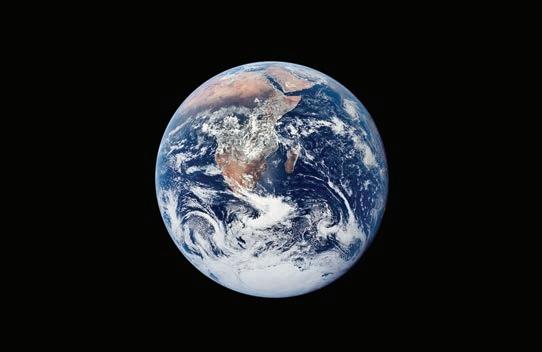
excreted by the living processes of the bacteria. The bacteria near the fresh gelatin on the outer ring have resources and live until they have expanded their population to the limit and all of the bacteria on the dish die. Although we think we are more aware and more considerate of our circumstance than mere bacteria, the human population continues to expand. We create so much refuse by our activities, and cities, such as New York, are running out of places to dump the garbage. Some of our rivers in the 1960s could not support life. We have temporarily slowed the progress of the poisoning of our environment, but the population continues to grow and so does the refuse. As with bacteria, humans will find themselves held in check by disease or war as Mother Nature comes to make adjustments to bring things back to balance. We work upon our selves with the hand of nature when we make war! We reduce our populations to make room for those who survive. Most of us think that when we reach a crisis, unlike the bacteria we will “figure it out.” Perhaps we can, but we should start preparing as soon as we can. But one imagines that this takes a foresight few of us have right now, for we mostly only consider our immediate needs. Imagine this: a world-shattering asteroid is passing within 600,000 miles of the Earth right now. You may think that this is not very close, but it is, in fact, very close indeed. And there are many unseen and very large asteroids out there. It is very likely we will have an “event” in our future. Who knows when? And as individuals we will die, humanity may die. Eventually the universe will end anyway. But we will all live as part of this incredible universe and the next. That we existed once is a Truth, and that we are Eternal and in the Mind of the God which creates all universes, an incomprehensible IDEA. Therefore, let us create our lives as works of great beauty since our lives are eternal. This beauty that we should seek is a harmony among things. I was pleased that people started to call our Center the WAH Center, because “WAH” in Japanese means “Peace” “Harmony,” and “Unity.”
In one of my recurring dreams, I was walking down a track towards a vanishing horizon. To my left was all black, to my right was all white. I was skipping along, hopping into the black and back into the white. I enjoyed it, playful with free spirit…experiencing both the white and the black. Soon a train appeared before me, rushing. I knew that I had to
what you are. All this is bound up with the notion of free will. Do we have free will? To what degree? We do not have a choice in breathing or not breathing, eating or not eating. Not to choose is to die, to perhaps choose the black. It is an argument that one has with one’s self every moment to choose this action or that. But we are pushed into one direction or anther by forces that we cannot always control; your family pressures you, society pressures you into this direction or that. One of my favorite sayings from Heidegger is that “we all wear mankind as our own skin,” imposed on us every moment we live. Man is a social animal that tries to accommodate oneself to the expectations of others. We lose ourselves to others, just as in my dream I was com-
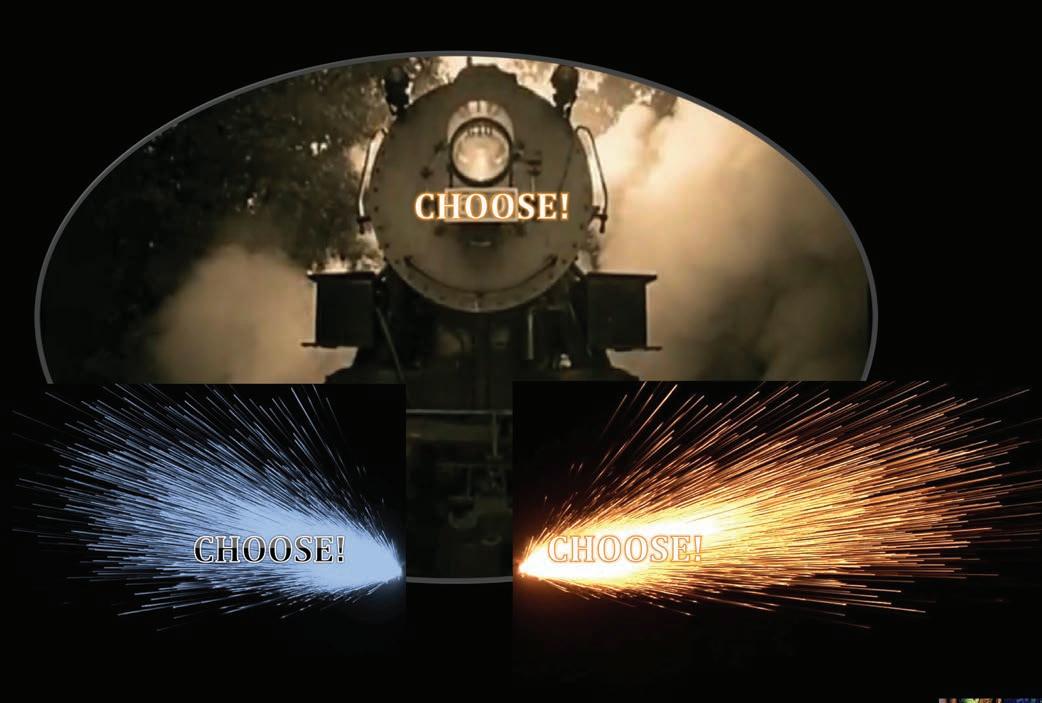
make a choice of where to go, the black or the white, and I would lose myself whichever way I took. I heard the sound of screeching breaks and saw sparks as the train barreled down on me. I woke up.
For some reason that dream always meant a lot to me. I do not think in Freudian terms, but philosophically, it had something to do with choices and self-identity. In life, one must make choices and in so doing one becomes the person that he or she is. Thinking, doing, being is all tied up with the choices that, once made, make you and define who and
pelled to lose myself. Being in the world, we lose our playful changes of possible identities. It is like when one is a child pretending to be a doctor or lawyer or cowboy. It is in that play that we are forming what we will choose to become.
I was interested in many things when I was young: math, science, architecture, dance, music, art, poetry, philosophy and writing. One cannot do everything, so one must choose. In choosing art I lost a piece of what I was enjoying in those other things. The ability to dabble in everything, have enough time to do it all well, and enjoy it all thoroughly
is not given to any man or woman…and so I chose art. While doing art I incorporated philosophy in my “Stone” paintings, which in turn led to my “Dune” paintings later on. Some of my professors at Pratt Institute did not like my paintings at all, believing that they were too philosophical and didn’t consider it to be art. They asked me to paint in the Abstract Expressionistic trend so that they could understand my paintings better. As I couldn’t comply with their requests, I had to change my painting professors a couple times until I finally found one who wholeheartedly appreciated my work. Those professors thought that painting should be painting, not philosophy; I did not see it that way. I used art in many ways, as a stage set designer, costume and clothing designer, installation artist, and even performed in front of my big dune painting in a gallery in SoHo. It was a rich and rewarding time in New York City where I met many wonderful great people who became my friends, and mentors, such as Esteban Vicente, Isamu Noguchi, Toshiko Takaezu, Ansei and Toshiko Uchima, who were part of a much older generation and were already well known in the international art world. But they were warm, open-minded and personable who considered me to their equal. It was a great honor and joy to be around them.
Choices: I was making a choice by doing, and by doing I was my becoming what I was. I was asking myself, by doing, what did I lose? What experiences and friends have I lost by not “becoming” in another mode of myself? What joys did I not experience by not devoting myself to music or poetry? I could have become so many versions of myself. There are infinite possibilities like the permutations and combinations in a game of chess. But one makes a move in chess and the deed is done, moving down an inexorable path to win or lose, fame, fortune, or loss, with no turning back. What a strange world! The black and the white. Compelled by desires or pressures, to what degree are these choices of free will or driven by fears, or hormones, or what?
The sparks of that impending train of life bearing down on us are the pressures that make us decide to jump here or there. The sparks are the crash that is one’s life that explodes into the constellation of being that I have become. I am in that collision with the world, the formation that is the glory of being human in some capacity. Every human is perfection to his or her self in the great glorious whole; we each of us make up the story that is the human story, the world that is our world, the universe that is our universe.
Recently, one of the artists at my art center was doing work involved with the butterfly effect. In chaos theory, the butterfly effect suggests that a small change at one place in a closed system can result in large differences in other parts of that system. Coined by Edward Lorenz, the butterfly
effect is derived from the idea that a hurricane’s formation depends on whether or not a distant butterfly had flapped its wings several weeks earlier.
In the notion of time travel, points at which the storyline diverges due to a seemingly minor event results in outcomes different than what would have occurred without the divergence. This is an example of the butterfly effect. Thus, the black and white of my dream had something to do with chaos theory and the butterfly effect. The choices I made resulted in my story becoming more static and unchangeable as each subsequent choice entrenched my being. It seemed I was becoming less free as I moved along the line of my life. Should I be frightened? In my dream, I was frightened of the impending doom. Was this the doom of my having to be one thing or another? Of losing the beauty of the possibilities that I held clustered in my hand like grapes?
In my life I have made many choices. If I were to go back perhaps some choices I would not have made in lieu of others. What would that butterfly effect have yielded? I have achieved many good things; I have built an art center that serves many artists and the public, for which I have received many awards. What butterfly effect have I had on the careers of any artists? Had I simply remained a painter, my butterfly effect on the art world might have been less. But I have not created as many arts works as I could have because of my work is establishing an arts center.
It all distills to the question of whether or not I really have free will, if my life is the absolute result of a metaphorical butterfly flapping his wings in some distant place or past?
William James, the American philosopher had just such a dilemma. It drove him mad and he ended up in an asylum. He had thought about free will and determinism and concluded that there was no free will. With that, he folded his hands and stopped doing anything. But as he was vegetating, he had a revelation, and with it came the statement “my first act of free will is to believe in free will!” And forth he rose up to become a great philosopher. In other words, we operate by belief systems—without belief, everything is absurd!!
I believe that I have free will and it is my belief that I must try my best to be true to myself as a good member of society. I try not to harm others. I have developed my own philosophy and guiding principles based upon the motto of “peace, harmony and unity.” It is the great dialectic suggested by the choices in my dream of the black and the white. Of these choices I have made a colorful rich and satisfying world, knowing that I have done my best in the world despite the limitations of impending forces and limitless choices. We are all butterflies, what a beautiful idea!
As a child, I was a butterfly to my future self. I am a butterfly to others. Just as I have felt the effects of those who taught me, so I have had a butterfly effect on others. And others have had a butterfly effect cascading through others around them. That is the wonder of humanity. We wear the effects of others and the totality becomes human culture, shared values, and shared appreciation of things. But this shared sensibility has ebbs and flows. It is an amoeba always taking a new shape. The appreciation of art in one generation becomes under-appreciated in the next. Ideals held closely by one generation are not the same as the next. And it is not only growth or advancement that we see. We have to ask why do we value this now and not something else. Just like when I was a child and had so many questions that seemed so tedious to my parents, so I continue to have questions now. I will probably have questions to the end of my days.
Mandelbrot’s Fractal Geometry has deep relevance, not just to the so-called physical world but the social cultural world as well. If we look into the hearts and minds of men in a given culture we see a repeating pattern that displays at every scale. Again, we see resonance theory at work. In celestial mechanics, an orbital resonance occurs when two orbiting bodies exert a regular, periodic gravitational influence on each other, usually due to their orbital periods being related. Humans in their activities together in a group influence each other. The bodies exchange momentum and shift orbits until the resonance no longer exists. Under some circumstances, a resonant system can be stable and self-correcting, so that the bodies remain in resonance. One can imagine how government social engineers the social resonance to harness the energies of the masses to productive use.
Here am I, Yuko, in New York, feeling the tug of culture in the mainstream art world, wanting to jump in and swim, see everything, concerts, theater, art films. Jazz! And yet I too wanted to be unique and special and rise to the pinnacle of possibilities. I had been reading René Daumal (March 1908 – 21 May 1944) a French spiritual para-surrealist writer and poet, best known for his posthumously published novel Mount Analogue (1952) as well as for being an early, outspoken practitioner of “pataphysics.” Mount Analogue appealed to me: “You cannot stay on the summit forever; you have to come down again. So why bother in the first place? Just this: What is above knows what is below, but what is below does not know what is above. One climbs, one sees. One descends, one sees no longer, but one has seen. There is an art of conducting oneself in the lower regions by the memory of what one saw higher up. When one can no longer see, one can at least still know.” René Daumal
In the Williamsburg Papers we are debating the issue of free will or determinism. Some of us claim that we have free will or choice in what we do. Others say no, that there is a vast historical will determining the destiny of all things. I would say that the Big Bang is a EX NIHILO declaration of a Will “TO BE!” (to exist to live) and that indeed all things were willed from that big bang. What choices do we really have when we are limited by the materials of which we are made and the forces of the universe, which determine how those materials will act and interact?
Therefore our will is merely the will of our universe, the Historical Will. And yet, intelligent men think that they are freely creating their destinies on earth. They look at what nature has provided them and remake it by some vision they intuitively or consciously possess. They think their vision is theirs, but it is rooted in what Mother Earth has made them to be. Mankind is merely an extension of the Earth, the universe, and her materials. When a man puts his hand to a task, it is Mother Earth who whispers in his ear to guide him and the One Hand that clapped that holds the trowel! And when great thoughts are thought, it is the will of “Word” the incredible “IDEA” that created the universe at the beginning. The universe creates itself anew every second. Creativity comes from the essential nature of the universe as infinitely variable. Yes, every day all things are different than they were before since this universe was born. As Heraclitus said, “One cannot step into the same river twice.” Man, in his youthful energy (Homo Habilis is only 30,000 years old) invented the wheel, the automobile, the airplane, and has split the atom. And he considers himself very “creative.” Our artists think of themselves as “Creative.” But has not nature already split the atom, have we not merely looked on nature and repeated what nature and the universe has done for billions of years and have we not done so as extensions of nature ourselves? As for the airplane and automobile, and the rocket ship, is this not Mother Earth inventing these things, are we not animals of the earth taking the unconscious thoughts of our Mother and applying them to the WORLD AROUND US?
We are all a process of the Will(!) that created us in the first light that was energy becoming matter, the matter of which we are made. The universe can take hydrogen and build from it in it’s furnaces oxygen, carbon and the heavier elements. And yet we call these new elements part of nature. But when man, who is part of nature himself, pulls from his furnaces his products of plastic and steel and plutonium
we call these “man-made.” Thus we separate “natural” and “man-made.” Language is an interesting thing that divides things that are really one. So here in Brooklyn there is much discussion in the Williamsburg Papers about language and meaning and how it relates to art. We know that we are always creating dualities and oppositions with our thinking and language. As some of our writers have pointed out everything we think is in terms of duality: good/evil, love/ hate, live/die, up/down, being/nothingness, light/dark. Everything we think or speak seems based upon duality and our reasoning is based upon a formula describing that duality: Aristotle’s principle of non-contradiction. The dialectic of reason is that ideas should oppose each other until the weak one dies away and the true idea prevails. But the “one or the other, but not both” ideas of our duality sometimes delude us. The dualism in the thinking of Xeno would make us believe that we cannot move from where we are standing to a point across the room, but we know that we can. And now that we have made a distinction between natural and man-made we are deceived into thinking that these things are fundamentally different when they are not. Plastic and steel are quite natural! Nature has made them just as nature through bees makes honey, or nature through birds builds nests from twigs...and do we not consider honey and bird’s nests natural? The duality of opposites in our Tree or the Spaceship Earth a goodly-shared environment. Western Man, one imagines, thinks of everything not human as dead material to be molded to his desire for his use. The American Indian and other cultures think of everything as conscious living things, even the rocks of the earth, and that if we do not respect their “spirits” they will turn on us in fury. They say we should respect nature and take only what we need to live and return something for its use to honor the spirit of life itself. I very much like this philosophy, for at one time in this world we are “user” and next time we may be the “used.” May the user treat us with as good grace as we treat the used! We as a community should also give to our fellow beings as well as take. And we should not hurt others in doing it. Let us treat nature in the same way so that nature will always be able to share its bounty with us. Let us bless and revere our dear “Mother Earth!”
My mother told me when I was 5 years old that because I was born in October and the year of the Horse in the Chinese calendar, she would lift me up once every year until I became 3 years old to look into the blue deep October sky, quoting the Japanese saying, “A leaping horse jumping, trying to reach the October deep Blue Infinite Sky!” She wished me to be always like the leaping horse, trying to reach into infinity.
Inspired by a poem by Li Po (also known as Li Bai A.D. 701 - 762)
I am endlessly yearning
To be there in the infinite blue!
Insects hum of autumn by the gold brim of the well; A bird sings and deeper grows my longing.
I see another bird, Single as a flower, gliding in the clouds.
Again my heart leaps for joy, As I see the blueness and deepness of October sky.
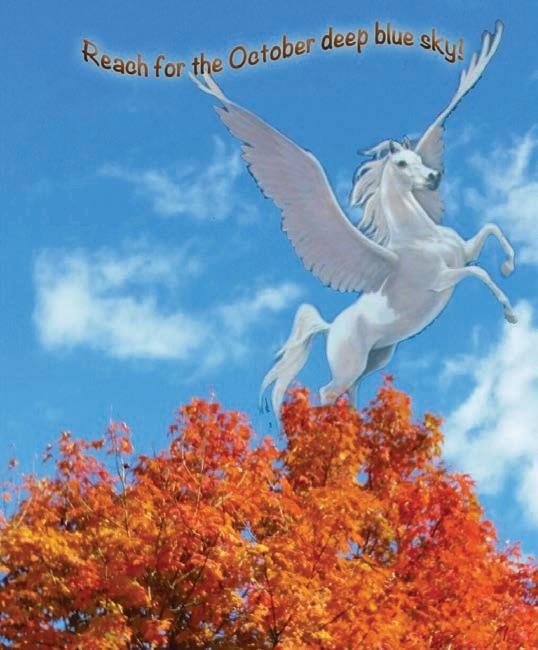
Heaven is high, earth wide; between them flies my longing. Where will my dreams take me? Can I dream through the gateway of the sky?
Endless longing Breaks my heart.
—Yuko Nii
Heraclitus said, “No man ever steps in the same river twice, for it’s not the same river and he’s not the same man…. There is nothing permanent except change” And Confucius said “What you do not want done to yourself, do not do to others.” And Jesus said, “Do unto others as you would have them do unto you,” in the context of a lesson about loving one’s enemies. This is a reversal of our common practice of “doing to others what they have done to us or giving them what they may deserve.”
What great ideas and wisdom are embodied in the minds of great men and women throughout history as revealed through books? We should study and honor those great people who have gone before and who provide guidance in our brief stay on this earth. And remember that if we do not honor the creative and wise men of the past, we ourselves will not be remembered either. Mankind cannot grow without the prior memories of mankind revealed through learning.
Everything around us is ever changing, being born or dying. Underlying all that change is something changeless that holds it all together. And is all of this change benevolent or malevolent? As Ghandi pointed out, “In the midst of death life persists, in the midst of untruth truth persists, in the midst of darkness light persists.” We must have faith in this dualism, faith that it enlightens and is the basis of existence, creation and destruction.
We all act upon one another, each hoping to have the other do what is in our own interests. We cajole, reason, or threaten until we get what we want to satisfy our desires or to satisfy a belief, perhaps supported by experience and reason, about what is in society’s best interest. It may seem good to us, but it may seem evil to others. That is where we stand today in an America that is divided between people who have demonized one another.
Yet, as Plato’s Socrates said “No man knowingly does evil.” He maintained that doing wrong always harmed the wrongdoer and that nobody seeks to harm themselves. In other words, all wrongdoing is the result of ignorance. Thus, learning from wise men of the past will help us avoid the ignorance that causes evil in the world.
It is my firm conviction that nothing enduring can be built upon violence. The true source of human rights that we all
seek, rich or poor, white or black, is duty. If we all discharge our duties, rights will not be far to seek. If we do not perform our duties and run after rights, as Ghandi said “…they will escape us like a will-o’-wisp. The more we pursue them, the farther will they fly.”
We all want some comfort in life, free from hunger and deprivation. Ideally, we should not create too many wants. To desire more and more becomes an obsessive/compulsive disease and does not result in happiness, rather an unhappy unease of unfulfilled longing.
I look upon an increase in the power of the democratic state with great fear. Our leaders claim that they wish to do good by minimizing exploitation, but they would achieve this by destroying the individuality that lies at the root of all progress.
The poor resent the rich who do not share their wealth. The democratic leaders wish to show that they have a social communal purpose in opposing and taxing the rich to create a fair and just society. If the state did indeed suppress capitalism “for the good of the people,” all will be poorer and no great benefit will result. The red flag waving can indeed awaken “the beast with many heads (the mob),” and the catastrophe for American society will be unrecoverable for a long time.
As Ghandi said, “the violence of private ownership is less injurious than the violence of the state.” Again I look to the great history of man that is revealed through books. The French Revolution and the Russian Revolution did not provide great benefits to those societies, rather tyranny and suffering. Capitalism is not evil; it is its wrong use that is evil. Capital in some will always be needed to advance civilization.
Really, the fundamental, ultimate mystery—the only thing you need to know to understand the deepest metaphysical secrets—is this: that for every outside there is an inside and for every inside there is an outside, and although they are different, they go together.
The world exists as two, for only so can there be known the Joy of Love, whereby are Two made One. Aught that is One is alone, and has little pain in making itself two, that it may know itself, and love itself, and rejoice therein.
"... for there is nothing either good or bad, but thinking makes it so." —William Shakespeare, Hamlet, Act II, scene ii 245
“The world is always changing, “one cannot step on the same stone twice in life” —Heraclitus
My thinking has been described as Dialectical monism, that reality is ultimately a unified whole. The wholeness/unity is of dynamic opposites that seem to be in opposition, but actually are necessary to create the reality of perception, emotional, sensual and intellectual. Further, the “seeming” is pure idea, with no material reality. Rather, it is consciousness manifesting itself, fulminating phenomena. It is historical will, or if you wish, the Mind of God creating appearance by the acts of thought (perception) through the dialectic.
Time is an illusion. All happenings or perceptions exist at all times or in one whole time in unity, but our consciousness separates them into dualistic forms. What we perceive as reality can only appear when dualism is present. This dualism is pure idea. Reality is dependent upon the mind.
“Form is emptiness; emptiness also is form. Emptiness is no other. This world is supported by a polarity, that of existence and non-existence. But when one sees the origination of the world as it actually is with right discernment, ‘non-existence’ with reference to the world does not occur to one. When one sees the cessation of the world as it actually is with right discernment, ‘existence’ with reference to the world does not occur to one.”
Heraclitus is a notable early exception to the Eastern monopoly on dialectical monism: “Men do not know how that which is drawn in different directions harmonizes with itself. The harmonious structure of the world depends upon opposite tension like that of the bow and the lyre.”
One must realize that war is shared and conflict is justice, and that all things come to pass in accordance with conflict
The world, represented by historical will as the mind of God, has no permanent order. The ceaseless becoming is an overarching balance, rhythm, and regularity: one provided by and constituted by the Mind of God; ceaseless, cyclical oscillation of polar yet complementary opposites. These include: being and not-being, order and disorder, life and death, light and darkness, masculine and feminine, dry and wet, hot and cold, and active and passive. Life and death, for example, are mutually arising, interdependent, and complementary aspects of one process
“What men dislike is to be orphans, to have little virtue.”
“You cannot stay on the summit forever; you have to come down again. So why bother in the first place? Just this: What is above knows what is below, but what is below does not know what is above. One climbs, one sees. One descends, one sees no longer, but one has seen. There is an art of conducting oneself in the lower regions by the memory of what one saw higher up. When one can no longer see, one can at least still know.”
― RENE DUMAL
To create is to encompass one’s life experiences, resulting in the discovery of one’s self. It is a pleasure to see one’s own growth in the process of learning and creating. Art is something like philosophy, a searching for Truth, not through reason or logic, but rather through intuition. One must experience things first. Where better than in New York City?
And here I was n New York, feeling the tug of culture in the mainstream art world, wanting to jump in and swim, see everything, concerts, theater, art, and films. Jazz! And yet I too wanted to be unique and special and rise to the pinnacle
of possibilities. I had been reading René Daumal (March 1908 – 21 May 1944) a French spiritual para-surrealist writer and poet, best known for his posthumously published novel Mount Analogue (1952) as well as for being an early, outspoken practitioner of “pataphysics.” Mount Analogue appealed to me: “On high remote in the sky lies the utmost pinnacle of Mount Analogue. There, He who sees each thing in its beginnings and in its end resides unto Himself.”
This was the heyday of Abstract Expressionism and Pop Art. My art was more surreal and of a poetic nature, possibly Japanese in sentiment. I took the mandatory courses in art history and studio painting, drawing, ceramics, bronze casting etc., and it was a broadening experience. While doing this, I visited museums and galleries and had dinner and went places with other students.
In Minnesota, one is more aware of the physical and the mundane, whereas in New York one finds that the mind is in a heightened state of being, at least I found it to be the case with me. One thinks of what things signify or mean to self and others. One asks, “What is important and why? What is art? What is life all about?” It was like when I was a child and wanted to know why the sky was blue. Of course that is why we seek education, to learn what others have thought or discovered about these things. But I found that all of the others, even the greatest minds, only seem to approach the truth. Or perhaps they point the way, but the destination still seems on the horizon and we must travel further still. It was like Zeno’s Paradox.
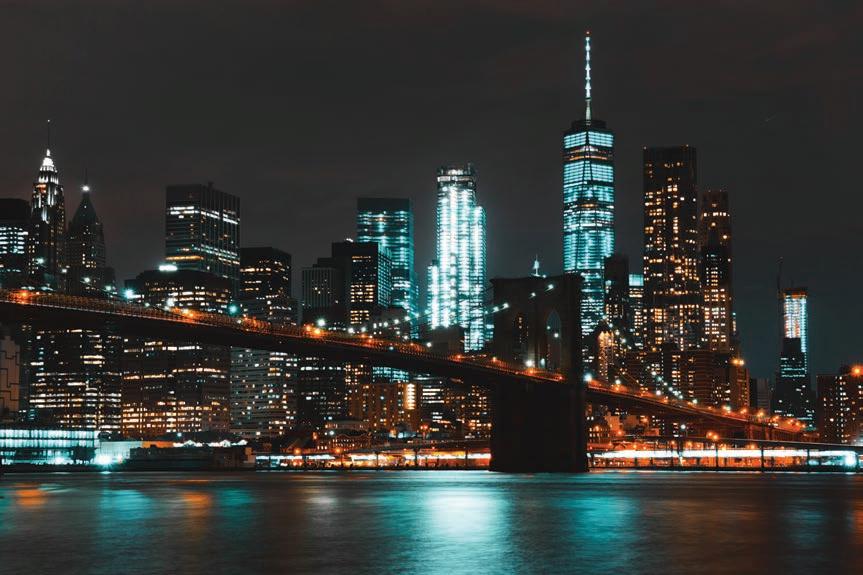
Once upon a time there was king who lived in Mid-Manhattan. His name was Empire. He was so wise and powerful that everybody looked up to him. As a result he was lifted way up in the sky, and became the tallest person in the entire Manhattan Island so that he could see his land and people clearly, all always in good order according to his wish.
There was a beautiful and elegant lady who lived just a few blocks away from King Empire. Her name was Chrysler. Her beauty, her mind, and her heart were so admired and adored by everybody that she was also elevated sky-high almost as high as King Empire so that she could see the peaceful and beautiful kingdom of Empire.
The King Empire was very much aware of Lady Chrysler’s beauty and charm, and wished to talk to her some day. The Lady Chrysler was also aware of the Empire’s good heart and wished to get to know him. But she was so shy she did not know how and when to let Empire know her wish.
One day she decided to wear a lighted up tiara on the top of he head so that even at night people could see her. The first
person to see the light was King Empire, as he was so tall that he spotted the lights right away. He smiled gently and whispered softly, “I am going to marry the Lady Chrysler, and she will be my queen.” The first person who heard him was, of course, the Lady Chrysler, she being so tall and so close to him. She nodded silently…..
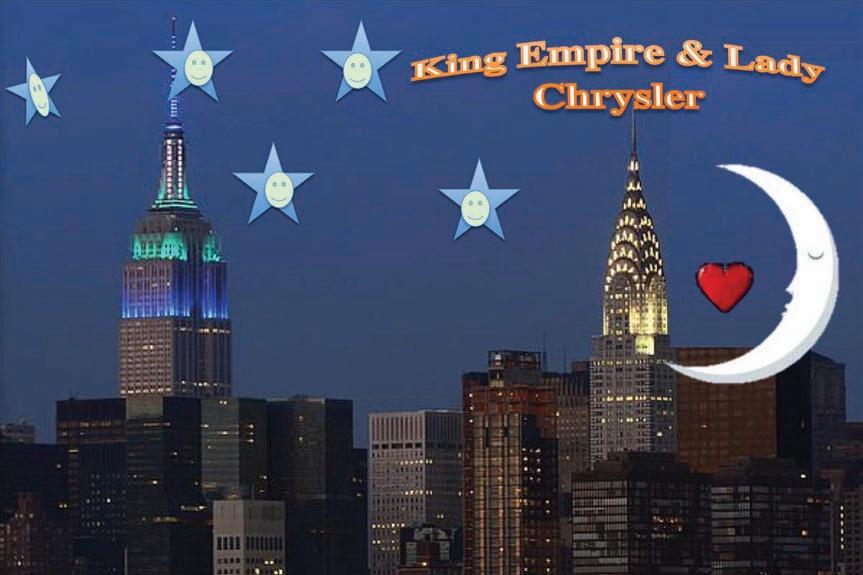

In the late 1970s, at the peak of the disco dancing and music trend, the STUDIO 54 became a world-famous nightclub and discotheque.
Between the years of 1977 – 1979 frequent regulars at Studio 54 included Andy Warhol, Liza Minnelli, Bianca Jagger, Elizabeth Taylor, Mick Jagger, Michael Jackson, Calvin Klein, Elton John, etc., and I knew it was a special place to which only special people were invited.
One day a friend of mine who was working as a stage decorator invited me to Mick Jagger’s birthday party. As it was a ‘strictly privileged private’ invitation only party, and there were several guards in uniforms at the entrance to see the attendees’ “special guest” tickets, which was a time consuming process to get through the long line before getting into the building.
Upon entering the studio, the loud disco music was heard and glittering disco mirror ball lights were flashing all over so brightly that our eyes were blinded at first until they adjusted to the darkness. Colorful flowers were all over and there was a huge lounge in which a lavish cocktail bar was welcoming the guests. Some early arrivals were in dressy outfits already enjoying the party’s atmosphere while socializing… Sooner or later the disco music got louder and the people started moving inside the huge studio. Because I am very small and short, my friend gave me special consideration and took me to the central front area where I could see everything well with what was going on under the rotating mirror lights.
At first I couldn’t distinguish who was there disco dancing below the rotating flickering lights, but soon I was able to spot some celebrities talking, moving, and dancing, and among them was Liza Minnelli. She spotted Andy Warhol
standing and tried to get Andy to dance by yelling in a loud voice towards me, “Hey! Andy why don’t you come join us and dance?” I didn’t know that Andy Warhol was standing behind me watching people dancing. And I looked right behind me, and sure enough Andy Warhol was standing still behind me with his arms crossed. But, he staunchly refused. He cleverly answered, “The world is spinning, so by standing still I am dancing among the stars anyway.” I was startled with his sharp quick answer that reflected his twisted interesting worldview. I was so impressed that afterwards I began to look at his work more carefully and read about his background and got to know the concept behind his art. I started appreciating Warhol’s groundbreaking unique approach to his art, which was far different from other contemporary artists. I was not particularly fond of his work, but understood where he was coming from and what he wanted to say in his art.
In the 1970s I started having some exhibitions of my work at various galleries, mainly in the Hamptons in Long Island including East Hampton, Bridgehampton, and Southampton. I met quite a few artists who had their summer homes in these artistic communities. They often invited me to stay overnight at their homes as it was too far for me to drive back to my Brooklyn home after the opening receptions. During my stays at their homes, they kept telling me that I should move to the Hamptons during the summer to paint.
During the 1970s I started looking for a summer studio in a cooler area than New York City such as upstate New York. I found an old run down building and renovated it to make a nice studio and summer home, but I was not totally satisfied with this environment in the countryside.
So, I decided to look for a place on Long Island to work in the summer. I purchased a charming house on the Peconic River in Riverhead, located on the Peconic Bay, which separated the North Shore facing Connecticut and the South Side on the Atlantic Ocean. I wanted to be left alone quietly so that I could spend my time to paint, not socializing too much like many fellow artists did in the Hampton’s communities. If I wished to go to enjoy a social and cultural life, I could easily drive over to the both locations, the Hamptons and the North Shore. The properties in Riverhead were cheaper than the other 2 areas, and besides it was conveniently located, being much closer to the New York City.
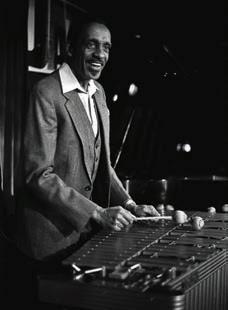
As it was the same reason why I continued to live in Brooklyn even after I graduated from Pratt in 1968. If I moved to Manhattan, I would have lost so much time to paint, because I would have been kept too busy with entertaining my friend visitors from abroad and elsewhere. Everybody knew that Brooklyn was a dangerous place to visit, and so my friends dared not to come to visit me in Brooklyn. I was the one who drove over to meet them in Manhattan and after having great times with them for a couple
of hours, I drove back home to Brooklyn. Driving over the bridge, leaving behind the “sleepless city of Manhattan” was a special delightfully liberating feeling, knowing that “I am coming home to rest.”
After the renovation of my summer home, I shopped at the local antiques stores or Salvation Army to buy furniture and some necessary domestic items. The Peconic River was running right next to my backyard, and it was peaceful and beautiful. On the river, swans and ducks glided past and carp would come to the surface; It was an idyllic setting. I loved that isolated life alone so much that I decided to go to Riverhead throughout the year. I drove out every weekend on Friday and came back to Brooklyn on Sunday evenings.

When I was in Brooklyn, besides teaching part time at school during weekdays, I would spend my nights attending concerts, Jazz nightclubs, and theaters and I also enjoyed going to galleries and museums on my not teaching days with my friends experiencing the rich New York culture scenes.
I especially enjoyed Jazz, which is the most unique American music and one of the most outstanding aspects of American Art. I got to appreciate Jazz so much that I went to listen to Jazz events at least once a week, during which time I got to know many renowned Jazz musicians, including Dizzy Gillespie, Max Roach, Tommy Flanagan, Art Blakey, McCoy Tyner, Cecil Taylor, Illinois Jacquet, Horace Silver, Lionell Hampton, Milt Jackson, Ray Brown, Kenny Barron, Ron Carter, etc.
The 1970s were the most exciting, invigorating and liberating period in the New York Art World, and upon arriving in New York City one immediately felt a special kind of energy dispersing through the air, that was due to pulsating creative energy.
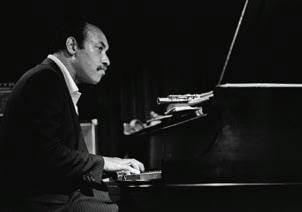
After graduating from Macalester College in 1965, I spent a year studying at the Minneapolis Institute of Art to acquire additional art credits in order to apply for a graduate school. I was happy to move to a bigger city, Minneapolis, where I was expecting to have more cultural exposure. St. Paul, where Macalester College was located, didn’t have any performance spaces, theaters or museums, etc.
I missed enjoying performance programs, which I used to appreciate in Tokyo. In Minneapolis I found the Gutherie Theater. Founded in 1963, they offered theater performances, productions, education, and professional training. I was very excited about finding what kinds of programs they are offering. Many of the programs sounded quite new to me and as I had been always “a curious Yellow,” so I started going to the theater performances quite often,
One of the programs that interested me was an AvantGarde performance event. It was 1966 when I heard John Cage’s “unsound” music for the first time with Merce Cunningham’s performance. John Cage was sitting on a piano bench in front of the piano as if he would start playing the piano as normally expected. However no sound was heard for several minutes, just pure long silence. Some in the audience left the theater, but I intensely listened to his unsound music, enjoying it. It was a totally unique experience to me, of course!
Meanwhile, the dancer, Merce Cunningham, was making his idiosyncratic movement by himself, not necessarily following John Cage’s unsound music. I could not identify his special style of movement at first, but while observing his movement I started finding a vague connection with the Japanese Butoh style of dance, with which I was so familiar. It was a very refreshing experience for me to listen to the unsound sounds and to observe the non-movement movement. I found a kinship between their performance and the Japanese “Zen” concept and the Japanese “Butoh” dance. Only after reading the backgrounds I found that John Cage studied “Zen” and he was attempting to apply “Zen” to his music. And Merce Cunningham’s dance performance was totally unique again that his body language had nothing to do with the conventional dance movements that usually interpret literal stories with the use of their suitable music. My assumption was that he must have been influenced or inspired by the Japanese “Butoh” dance.
But, I found out later that the both performers were life partners and Merce Cunningham was very much influenced by John Cage’s “Zen” teaching that “nothing-ness” or “emptyness” is also a part of “being,” and they both are one and the same thing.
It is very heartbreaking to know that the numerous victims in the Tohoku are still suffering from the devastation of the natural disaster, and yet still the Fukushima Nuclear Power Plants’ serious problems haven’t been completely solved! We do not hear any progress on the news or social media. That nightmarish incident has become a thing of the past, the horrible images disappearing from our memories. We are too busy with chasing after or being chased by the current chapters of our lives.
Ever since, the world has been quickly sliding down and slipping off. Look at the economical downslides, political and religious conflicts, and social turmoil, in addition to the other catastrophic natural disasters such as earthquakes, Tsunamis, floods, tornados, droughts, forest fires, all of which are beyond our human control. Our life is affected one way or another. We are all interconnected with each other on this small planet, the Earth, from which we cannot escape. While we all wish to strive for a happy and peaceful life, it seems like an endless struggle for the world’s population to achieve their ideal goal in a short time.
While life goes on, we are witnessing on or in various media one of the worst kinds of life threatening crises taking places in front of our very eyes as if we are watching a surrealistic film, not wishing or even believing that they are actually happening in our reality.
But, as we know, nothing stays the same forever, we hope to see a bright future in our life time.

Katsushika Hokusai (Japanese, 1760–1849). "Under the Wave off Kanagawa (Kanagawa oki nami ura)," also known as "the Great Wave," from the series Thirty-six Views of Mount Fuji (Fugaku sanjūrokkei), ca. 1830–32
A fisherman who could not get any fish saw a man standing next to him, catching basketfuls of fish. He asked the man, “Are you a fisherman? What do you use for a bait?”
The man answered, “No, I am a doctor. I use appendixes.”
Then he turned to his other side the man next to him was catching sackfuls of fish, and asked him, “Are you also a doctor?”
He said, “Yes, I use tonsils.”
Then he saw another man catching more fish than any of the two. He asked, “Are you also a doctor?”
He said, “No, I am a rabbi.”
An Italian friend of mine, a curator at the Metropolitan Museum of Art, once asked me, “Yuko, you’ve been living in this country for a long time, you can tell me about something which has been puzzling me for some time. Whenever I come to America, after working day ends, my colleagues often ask me to join their ‘Happy Hour’ before they go home.”
Her question was “Why do they call it ‘Happy Hour’?”
My answer was: After a hard day of work, people need to relax or wind down a bit by going out with their friends to have drinks at bars or at restaurants before they go home. Many bars or restaurants are rather quiet and empty before dinner and the restaurants want to attract more people by offering discounted drinks. Because the drinks are cheaper than normal, people might also stay longer to drink more while enjoying a few social hours. So, it’s good for the business and it’s good for the customers. Both are HAPPY!
I told my friend that alcohol makes one “Happy and Jolly” for most of people, but it also makes some somber and may even make them cry. She said she got depressed a couple times when she joined her friends’ invitations to their “Happy Hour.” So, maybe they shouldn’t call it “Happy Hour,” and should call it something else, like “emotional hour.”
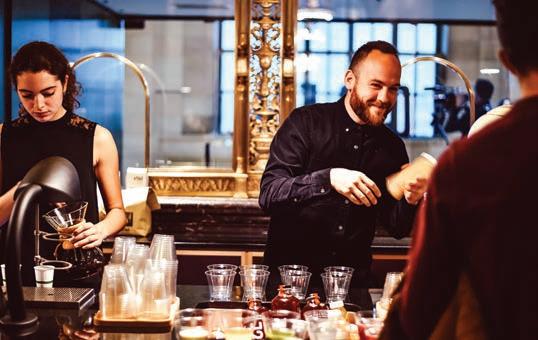
I also told her about the expression, “Thank God It’s Friday” or “TGIF.” Many workers are looking forward to the end of the workweek on Friday so that they can relax and enjoy the Friday night without worrying about the next day, because they have the entire weekend to fix any problems and relax. She said, “It is quite different from the way we Italians do things. We go home straight after work so that we can relax
at home with our wives or husbands over a glass of wine before dinner, because we enjoy that quiet moment to relax at home, not in an exciting atmosphere with loud voices, laughter, and loud music in the background while television is blasting noise and entertaining no one. That is insane!”
“Socializing” is also very important in America. If you do not mingle with people or if you do not belong to a group, you are considered to be “not normal,” and they feel sorry for you. Yet, “socializing” does not necessary mean having conversations, but rather just being among others. It is not necessary to listen to others, as often times they are busy talking about themselves just to hear themselves talk.”
Relating to the topic of “Happiness,” I told her about an interesting article I read in Time magazine on “THE PURSUIT OF HAPPINESS—Why Americans are wired to be happy— and what that’s doing to us” by Jeffrey Kluger.
And I also told her about some of my past experiences.
An artist friend of mine used to throw big parties at her boyfriend’s estate in Amagansett, L.I. During summer, the parties were held in the big garden, and in winter she would have them inside. As she was the party’s hostess, she wanted to make sure that everybody was enjoying the party. Whenever she got people together, and served great appetizers and drinks generously, the guests would enjoy socializing with each other, creating a joyous atmosphere with loud voices and laughter. It was as if nothing could interrupt the joyous party and it would go one forever…. But, my friend, the hostess, wearing a Mumu dress which disguised her fat belly, would start walking around slowly, holding a glass of vodka in her left hand and a cigarette in her right hand, approaching her guests from behind, asking each with her whispering sandy low voice and a very serious look on her face, “ARE You HAAA-PPP-YYY?.” We were all enjoying our moment until the voice came from behind us, asking us if we were “Happy,” and suddenly our happy moment was taken away, and we all got depressed.
Why did she bother to ask when she knew her guests were happily enjoying the party?
My saying goes, “When people are happy, leave them alone, and when people are sad, leave them alone. Don’t ask, they will come to you when they want to and show what they are feeling.”
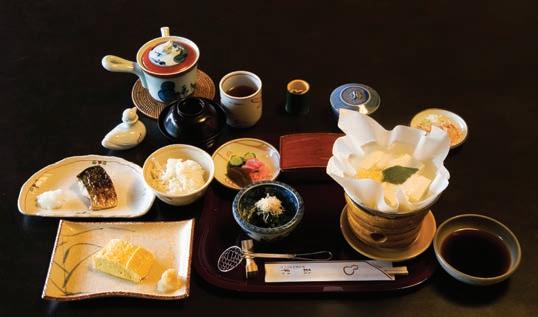
I got this note from my intern:
“Hi, Yuko,
Hope everything is wonderful and you are having a nice day. No worries—a lighthearted kidding nature is needed in times of pain and sadness sometimes to lighten the mood! You always make me smile even when I want to cry!” B.
I replied:
Dear B:
Bitterness, sadness, sweetness, happiness/joy are the ingredients of life. If we did not experience all of those emotions, our life would be quite dull, don’t you think?
It is just like the Japanese cooking. There are 5 basic seasonings or ingredients that are essential in most Japanese cooking. There is Sa (sweet from Sato in Japanese for Sugar), Shi (salty from Shio for Salt), Su (sour from Su for vinegar), Se (Shoyu for soy sauce) and So (Miso for miso).
They are listed according to scale from light to strong flavors and it is important to follow this order. Sa, Shi, Su, Se, So are the “S” row of the phonetic alphabets in Japanese. We have 51 phonetic alphabets altogether. We use this ‘S” row when cooking the Japanese foods, because it is easier to remember and we follow this to add these spices in the order of the phonetic alphabets while cooking.
Thus as we use all of these varieties to flavor our food, so all of our emotions give richness and flavor to our lives.
Now “Life and the Japanese Cooking Lesson, #1” is over…
Have a good day!
Love Yuko
As human beings, we are meant to make mistakes. The Almighty God made us different from God Himself.
Fred Astaire said, “The higher you go up, the more mistakes you are allowed. Right at the top, if you make enough of them, it’s considered to be your style.”
I was a close classmate with the son of Soichiro Honda, Founder & President of Honda Motor Company. Soichiro Honda used to tell his son, Hiro, and me, “If you want to succeed, make many mistakes.” I’ve followed his advice ever since, but no success has come yet even at my good old age! I want to tell him, “You forgot to add the important last part—you have to learn something from each mistake!” But now it’s too late, he’s gone!!
Now, I realize that missing that last phrase was his own mistake in teaching us. Furthermore, I hate to admit the stupidity of not having learned anything from my own many mistakes during my life. Do I have to agree with Fred Astaire, “If you make enough mistakes, it’s considered to be your style?”
There was a saying from a book I once read, “…we are all as God made us and many of us much worse.”
September 23, 2013.
We are a little bit crazy, rushing to find immediate results, while the rest of the world doesn’t seem to sense any urgency. One has to be awfully patient when melted lead is being poured out from a container.
This reminds me of my father’s comment: He couldn’t get over the fact that the American Tomato Ketchup Companies such as Heinz or Del Monte have never improved their original tomato ketchup bottle designs. During his many visits to the USA over 60 years, their ketchup bottles have never shown any improvements, having the unchanged familiar bottle shapes with small openings on top. Tomato ketchup is quite thick so that it does not come out smoothly and fast enough when one needs it. One shakes the bottle vigorously while holding the bottle upside down, but the ketchup refuses to come out. And by the time a tiny bit of ketchup comes out quite reluctantly, one’s hamburger or French fries are already cold.
However, he started seeing a bit of improvement, when they changed from a glass container to plastic. But even so, you have to squeeze hard enough to get the ketchup out. Sometimes, nothing comes out no matter how hard one squeezes the bottle or pound and pound the bottom (and here he would demonstrate). When you unscrew the top, you would find the small opening clogged up with old dry ketchup.
He concluded that Americans were very patient with regard to Tomato Ketchup. He himself was very patient in many ways, but when it comes to practical matters, he would be the first person who makes the things workable with great efficiency. He always believed “Form Follows Function,” not the reverse.
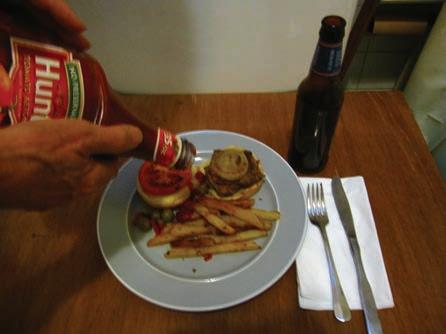
I was invited by a musician/composer friend of mine to his dinner party. His wife was an artist and she was the one who cooked for the party. She was a super cook!
Before dinner everybody was chatting casually having drinks and appetizers, introducing each to one another among his friends. It was a very interesting group of people, and they were much older than me and they looked comfortable in their positions. They were lively with humor and wit, and constant laughter filled in the room as they made clever jokes or comments.
I was told that my musician friend invited all of his friends who were from different professions, including musicians, artists, filmmakers, poets, writers, philosophers, a restaurant owner and a business man, but one thing which was common among them was they all loved his musical compositions. I was not an exception as my friend knew I liked his music very much.
When dinner time came, the 10 of us sat and continued to talk. I didn't know how the conversation changed suddenly, but a philosophy professor from Rutgers University started talking about me, and so everybody looked at me with very friendly looks on their faces as many adults do to their young kids. I was very shy and wished to hide away. The professor concluded by saying “ When Yuko started cooking, she was like a Jewish mother, when Yuko started talking, she sounded like a Chinese philosopher, but when she is quiet, she is a cute Japanese doll.” One person said, “I can have her as my cook!” And another said, “I will take her home tonight” or “I like the quiet Japanese girl,” and still another one said, “I can enjoy learning about Chinese philosophy,” etc. But then the professor said to everybody, “No! You cannot have her, because she is mine!”
My friend’s wife said to the gentlemen, “You cannot have her as Yuko refuses to belong to anybody. Watch out, she has iron hands and a velvet gloves.” And some said,” Let me hold your hands, Yuko.”
St. Paul, Minnesota, Summer 1964
I was living at Professor Hugo Thompson’s home for one year after arriving at Macalester College in St. Paul. MN in 1963. Dr.Thompson had a sabbatical leave for one year to write a book and Dr. and Mrs. Thompson left for Germany to spend time with their daughter’s family in Black Forest. I could not stay at the Thompson home, so this gave me an opportunity to live alone. I had to find an apartment near the campus. I got to know a French Fulbright student pretty well. She was from Sorbonne University in Paris. Her name was Regine. She was also looking for a place to live for a couple summer months. So we decided to share an apartment together. Luckily we found a nice apartment only one block away from the campus. The apartment was on the top floor of a medical doctor’s home. Regine was a couple years older than me, but she was small like me. She was a character with strong opinions on everything and we always disputed each other’s point of view, but we respected and loved each other. So, my new life adventure started with Regine.
The summer in Minnesota was unbearably hot with high humidity, but beautiful with many lakes all over, which is why it is called “State of 10,000 Lakes.”
In the morning we started out biking to a nearby lake, at a time when not too many people might bother us, except perhaps dogs and their walkers, and when we could avoid many big mosquitoes on the lakes that came around in the afternoon. People in Minnesota call mosquitoes “The State Bird” because they are so large. After swimming for a while, we headed back home and we both left to attend a couple summer courses at school. I took French Conversation class and English writing.
Our French teacher was from Paris, and she was teaching us the standard French accent conversation, and she gave me high praise by saying that my French pronunciation was “Excellent,” and I was quite proud of myself.
As soon as I finished classes after 3 PM, I rushed home where Regine awaited my return with a cold iced coffee for me to quench my thirst on a hot afternoon. Then both of us sat face to face and she would look into my textbook and helped me to exercise and learn my French lesson I had at school. When it came to my pronunciation, she was very critical and she constantly corrected me and I had to follow precisely the way she pronounced the words and I had to repeat them over and over until she said, “Bon.”
The next morning sitting in front of my French teacher in the class, each student was asked to repeat what he or she had

learned the day before. When my turn came to pronounce the words, she showed a disapproving frown, saying, “Your pronunciation was perfect yesterday, but today you have a southern accent. I never taught you that, Mademoiselle! Nii. It turned out that my roommate was from Toulouse (?), the southern part of France having a strong southern accent that Parisians do not consider French at all!
Over the two months of summer I learned the correct French pronunciation from my teacher from Paris and another one with the strong southern accent from my roommate. I thought it was a nice idea to be flexible.
After the severe French lesson, Regine and I could no longer do anything, because we were both exhausted in the sweltering heat. So, we both went straight to our bathroom, and sank ourselves in a tub-full of cold water.
Like the French revolutionary Jean-Paul Marat, who spent most of this time in his bathtub prior to his assassination because of a skin ailment, Regine used to sit in a big bathtub brimming with cold water and put a wooden board across the tub to use it as a table so that she could read books and write, have dinner, and drink wine. The bathtub was so big and we were small that we could both fit in it quite nicely. We both sat comfortably in the tub with cold water, and enjoyed cooling ourselves off, doing whatever our hearts pleased. I read a lot and wrote letters to my parents and friends in Japan, and Regine read and wrote a lot as well.
But we fought over who was going to serve the dinner and wine, either the Japanese maid or the French chef? We definitely needed a good maid! We thought that our German foreign exchange student would be perfect! Because she was practical and punctual, she would serve dinner and drinks at a regular hour upon which we could depend.
Although it was only 2 months of sharing the apartment together, we enjoyed each other’s companionship, learning a lot about each country’s culture and life style, which helped to enrich my life experiences beyond my expectations.
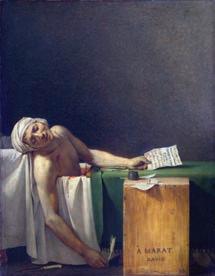
When it was time for her to leave St. Paul and head back home to France at the end of July, I was very lonely and sad.
JacquesLouis David, 1793
It was a hot Sunday afternoon on the very last day of May. After a short easy ride to Sheepshead Bay, Joemni and I were heading back on Ocean Avenue in the heart of good old Brooklyn. At a big intersection we stopped for a red traffic light, and Joemni pointed out by saying, “Look!” So I looked and I could not believe my eyes. We saw one of the most unforgettable scenes in our whole life! A LIME MAN walking across the street! It was not more than three minutes to capture the scene, but this image was so clearly and vividly etched in our minds that we will we shall never forget it for another century to come, event though we might forget our own names and ages.
Just imagine! A man who was shaped like a lime—very round around the middle, wearing a soothing lime colored, specially tailored suit, and the top is his pointed, neatly laced, off white Panama hat. To complete his Sunday best, the very bottom is tightly closed with pointed toed, old-timey, shiny shoes of the same matching color as his hat. This LIME MAN stalked across the street slowly, but very haughtily. Is that all we saw? Oh No! I shouldn’t overlook something very important and meaningful. A few steps behind him was a French Poodilish woman, with an invisible leash on her neck, curly, reddish maroon colored hair, and a well trimmed, knee high, tight, white dress. And right behind her was a French poodle on a leash! Where were they going? Stepping into the future? Going back to the past? Or, heading toward the horizon where the past and the future meet and where dream and reality touch?
One of my ”friends and mentors” was Jack Leonor Larsen, a worldly renowned innovator in fabric design as a weaver, a scholar, author, gardener, world traveler, and one of the foremost authorities on contemporary craft. He is the founder of the not-for-profit art organization “Longhouse Reserve” in East Hampton, Long Island, New York.
In giving my own opinions, I have used these words to express my high praise for particular artist’s work by saying, “He has extraordinary fine/good taste.” That was the time Jack pointed out to me, “Yuko, you don’t need to say ‘good’ taste, because ‘taste’ means ‘good taste.’” That was the first time and the first person who told me what the word “taste’ really meant. And it was that awakening moment for me to realize how important it is for one to use the right words or proper expressions when conveying ones message to their listeners. Jack was not a great rhetorician like a politician, but it seemed that he felt more comfortable talking with a small group of people or with an individual “face to face” because in that circumstance he could express his opinions about arts, politics, social issues, health issues and family concerns, etc. more freely. Because his art speaks eloquently for itself, maybe he feels that he doesn’t need to say too much to the public.

February 13, 2011
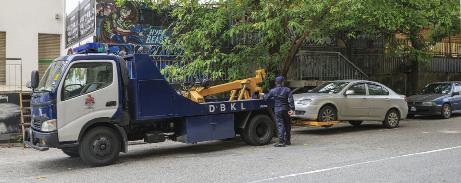
I left my apartment about 6 pm. I went to the place where I had parked my car night before, but I couldn’t find my car. I thought I must have parked somewhere else. I walked all over, over six blocks in the cold snowy evening, but couldn’t find it! I had to go back to my apartment to find out if my car had been toed away or stolen.
First, I called the Motor Vehicle Violation Bureau, but no record was found. I called the local police station to inform that my car might have been stolen. The police officer told me that I had to come to write a report. Walking alone at night to the police station in the worst section of Williamsburg was not a good idea. I decided to go back once again to the place where I thought I had parked. I was very watchful this time, and went closely to the car garage door, and I noticed a pink paper posted on a parking gate. The paper said, “Your Car was Towed Away, Please call, (718)…” Apparently, I parked my car blocking someone’s driveway. I hadn’t noticed the night before because it was so dark and a big pile of snow was covering it. When they answered they told me, “Come and pick up your car right away, and bring the cash $250.00.” He told me that he was a private towing company, which is located at the end of King’s Highway, right next to the Atlantic Ocean! Who wants to go to that strange place with the cash in hand? I decided to go by taxi next day. When I looked at my watch, it was already 8 pm. I was so exhausted with anxiety, and was cold and hungry as well. After that nightmare, I needed to relax a bit at home with a
good dinner and drinks. I watched TV and fell asleep, feeling much better to know that my car was not stolen. It was being kept safely near the ocean! What would have been worse was seeing my car towed away. At least that thought consoled me while I imbibed my stiff drink.
I took a taxi next day, and paid an extra storage fee of $40 as well as the $250 in cash to exchange with a Motor Vehicle Violation ticket of $95!
I felt sick, but more comfortable after a while to know that I could get my own car and drive away freely.
But I learned ever since, I have to watch where I park despite “snow, rain and dark of night” like the saying of the mailmen who deliver whatever the travails, and not block some one’s drive-way. Otherwise, as Milton’s Satan said who also made a little mistake, “…long is the way and hard that out of Hell leads up to light.”
“You’re traveling through another dimension, a dimension not only of sight and sound but of mind: a journey into a wondrous land whose boundaries are that of imagination—next stop, the Bell House!!”
I discover new things every day. The Bell House was one of them. I couldn’t believe such a place existed out in the middle of nowhere where the BAC (Brooklyn Arts Council) Benefit Party, “Alive with Art” would be held.
Searching for the right address in Brooklyn, heading endlessly westward toward the horizon as far as I could go, I was finally and inevitably forced to stop at the end of no man’s land because beyond that was the big water. Only Ted Kennedy would have gone further, or Jesus Christ who could walk on water.
Even after finding the Bell House sign, and looking for a parking place nearby, I felt I was coming through a ghost town with no single human being, not even a dog, or car in sight. It was like a surrealistic experience of watching one of my favorite TV programs, Rod Serling’s TWILIGHT ZONE! However, I had strong faith that something exciting would be happening under the surface. So, when I finally reached that rustic looking Bell House, and opened the door in a cold sweat with pounding heart I found exactly what I was looking for. Yes, indeed, a noisy joyous human crowd accompanied by music. When I found many familiar smiling faces, welcoming me near the door, I finally felt at home, and melted right into the crowd. One never knows what delights lie beneath the quiet surface.
My acquaintance, Helen Liu, sent me the invitation to a special lecture “Dialogue, Reflection on Art and Tao” by art critic Robert C. Morgan and artist Zheng Lianjie. The talk was being held on January 18, 2010, near Wall Street in New York’s financial district at 15 Broad Street.
I knew Broad Street is somewhere in the Wall Street area, but just before I left home I went on Google Search to look up the location map. Fine. I knew now how to get there. No problem. A short hop across the Williamsburg Bridge and a zip downtown.
Heading south on Broadway I knew I was approaching Broad St. To my surprise, there were several policemen blockading the street where I wanted to make a left turn. Of course it is not unusual since the event of 9/11, yet there seemed to be no special reason why at this time and place there should be police activity. One of the officers came up and told me that I would have to go further down on Broadway to Water Street, and make a left turn to Broad St. and then make another left turn in order to get to 15 Broad Street. I was a bit puzzled about his directions, but as I know better than to argue with a policeman, I followed his directions obediently.
I was able to go as far as 60 Broad St, but strangely enough there were big red and green blinking light boxes blocking the street and I could go no further. There was another group of several policemen standing nearby. It was as if I were sinking into a tale from the Twilight Zone. It felt strange and ominous on the quiet desolated street without a single human being walking or even a single car running after 6 pm. I was alone, abandoned without help. I had entered a “No man’s Land” with only the presence of policemen. One police officer came up to ask where I was going, and I

answered him “15 Broad St. Sir.” He pointed to a building a little further up the block, “That’s where you want to go,” he said, but he told me to turn that way and this way and that way as if I had to run a maze.
After following his directions, I ended up in the same place again right in front of the red and green blinking light boxes. It reminded me of the Twilight Zone story where all of the slot machines with flashing lights had gathered in front of the addicted gambler and crowded around him saying “feed me!” till he dropped dead. Another very serious looking officer approached me, telling me that he would let me pass through the blinking light boxes, but that I would have to wait in the area between this blockade and the another blockade of blinking boxes so that police officers could check the possessions in my trunk and let the dogs sniff everything in my car. Two huge German Shepherds sniffed in and around my trunk and everywhere. Of course, they found no suspicious items in my car!
I asked the policeman where to park my car. He answered casually, “Just anywhere.” I asked him what he meant by anywhere. He repeated, “Miss, Just anywhere.” I asked him “Why?” He replied, “ Today is Martin Luther King Day, and you can park anywhere.” Finally it made sense to me! No wonder there wasn’t a single person on the street and not many cars running around. There were so many policemen because they were there to protect the world’s holidayabandoned financial center, the Stock Exchange! I parked my car at the end of the narrow street where there was another strange looking, tall, massively unreal metal door. I was squeezed in among the dim narrow valleys of tall dark buildings with no way to escape. I was in “the pit.”
Finally and at last I was at my destination, hoping to leave the surreal world behind and find a gathering of warm welleducated people. I entered the 15 Broad St. building and a frightening, inhumanly cold looking security guard made me stop in the lobby. He asked me where I was going. I showed him the information for the evening event and he said,” Take the elevator to the 12th floor.” I landed on the 12th floor, but there was not a single human being there, and I felt chilled. But I kept going, looking for the room number. Then I heard women’s voices coming from somewhere, so I tried to follow where the voices were coming from. Finally, I found several women with odd plastic caps on their heads in the midst of changing their clothes in a small room. They were apparently the cleaning ladies who were just about to start their job. I asked them where Helen Liu’s place was. One half undressed woman popped out and started walking me toward Helen Liu’s room. It was a labyrinth of very long corridors turning left and right and right and left. She told me that nobody should be in this building, and wondered how
I was able get this far. She yelled with a loud voice, “Helen Liu!”
In the blink of an eye, out of thin air, Helen Liu appeared rushing over and wearing no shoes. She was rather shocked to see me. She said, “The lecture is on January 20th, and today is only the 18th.” She told me that she had already mentioned to Robert Morgan that I would be coming to his lecture and encouraged me come back again on Wednesday. I told her the nightmare story of getting to the building. She seemed to understand my difficulties and she showed a sympathetic face, an experienced denizen of this unreal world. She recommended taking a subway next time and going home by cab on Wednesday to avoid a similar mess. She easily led me to the ground floor and to the street just to make sure I was all right.
When I got back to my car, I drove up to the massive metal blockade that was standing like a drawbridge in front of me. A policeman came to tell me to wait till he could lower it electronically to the street level so that I can drive over the metal sheets. I had to stop in front of another blockade, so that he could repeat the process before I could finally return to the world of everyday streets and normal people.
Finally, I was back to the real world again! I returned home about 7 pm totally exhausted after going through a dark comedy adventure on Wall Street. I felt as if I were a terrorist having been captured and interrogated by the CIA or FBI and it was “ a long days journey into night.” I thought I would never see the light of day again!
I felt as though I was trying to enter East Berlin at Checkpoint Charlie during the Cold War!
As we grow older, we encounter more amazing unexpected incidents. Here are these moments that I like to call “Serendipity:”
Serendipity Story #1:
When I returned from Japan to New York, I found a sweet letter from one of our old interns concerning Terry’s eye surgery. She worked as a photographer who took photos of artworks in the Yuko Nii Foundation’s Permanent Collection.
Since we haven’t communicated with each other for more than several years, it was a big surprise for me to hear from her. Especially since at that very moment I was looking for the missing CD that contained all of the photos she took and I wanted to get in touch with her to find out if she had kept the copy of the photos. The very person I was about to reach out to that day sent a “Get Well” card to Terry!
Serendipity Story #2:
There was another experience I had while I was in Tokyo in the summer of 2015. I was riding the same train my dear old high school friend Hideko and I used to take going home together everyday until she had to transfer to another train at a certain stop. Looking outside from the train window as the train approached that certain station, I started feeling very nostalgic about my good old high school days, reminding me of my dear Hideko whom I hadn’t seen for years.
The train stopped quietly at the very station where we used to say “Good-bye” to each other. Because it was during the day, the train was not too crowded. As soon as Hideko’s face appeared in my mind, the real Hideko came onto the train to where I was sitting. I was startled to see the real Hideko, and she looked at me straight away. Both of us were speechless for a few seconds and we both uttered the same words, “I was just thinking of you!”
It had been more than 60 years since we last saw each other, yet we felt nothing had changed. She looked as sweet and as intelligent as she was in her high school time. We sat side by side together and we continued the conversations just as we used to. There was no feeling of time lapse or a missing gap between us. I later realized that we didn’t even talk about each other’s life updates. Instead we went straight to talk about the book each of us was reading in the train. We spoke so much that she forgot to get off the train! On top of it, she held my book to find out what I was reading, and I held her book in Japanese. She got out at the next station in such a great hurry, and we said the same words,
“See you tomorrow!” just like we used to say in our high school years. Imagine! We didn’t even exchange each other’s contact information! In the evening there was a call from Hideko at my mother’s place with a sweet voice, “Yuko-san, I finally found your mother’s phone number to reach you!! Did you realize that we both forgot to return each other’s book?” My answer was “We’ll meet at school and you will return my book in the train going home tomorrow!!” “That’s it!!” was her answer
When things like this happen, I cannot help believing in “Fatalism,” the pre-determined, pre-destined life that is beyond our control.
I was supposed to meet my artist friend while I was back home in Tokyo during the summer of 2015, but couldn’t meet him as I was very busy everyday. So, the only time we could meet each other was the very last moment before my flight would take off back to New York. Because the Japanese trains are always punctual and we could absolutely depend upon the train’s arrival and departure schedule, we decided to meet each other in the train (at the specified section we agreed upon), which I would be riding to get to the airport. He would get on the specified section of the train and we would meet and talk during the ride and he would get off before the train arrived at the airport station.
He told me that he would get to the station one hour earlier than my train was scheduled to arrive so that he wouldn’t miss the train.
A typhoon with heavy rain and strong wind arrived in the early morning on my departure day. I was planning to meet another friend of mine in Tokyo before meeting with my artist friend on the way to the airport, but since the weather was so bad, we decided not to see each other this time.
The lights went on and off and there was no TV reception to check the weather. Because I was concerned if my flight leaving to New York might had been cancelled, I called the DELTA Airline many times, but the line was constantly busy…
I decided to take a chance and go to the airport anyway. I left my mother’s a bit earlier with the fear that the train schedules might have been interrupted due to the stormy weather.
As I got in the train, the weather started to clear and everything started functioning as normal.
Since I had enough time before I was supposed to meet my artist friend, I decided to stop over to see a special exhibition of Japanese Historical Art from the 12th to 18th Centuries which I wanted to see while in Tokyo, but couldn’t
find the time to go to the museum. Luckily I arrived at the museum at 10 AM and was able to view the wonderful exhibit quietly with no audience. I had enough time left to stop at a small café to enjoy the last sip of good strong Japanese coffee. As I entered the café, the great smell of coffee and the beautiful Jazz music were quietly ready to send me back to New York!
I departed the café and I arrived at the station much earlier than the train was scheduled to arrive, so I sat on a bench for 30 minutes reading a book.
Meanwhile, my friend was also sitting on the same bench reading a newspaper waiting for the train. Neither he nor I noticed each other sitting on the same bench, because we both didn’t expect to meet each other at the station and we both were reading books. He stood up. I glanced at him, and he looked at me. We both couldn’t believe our eyes! He was assuming that we would meet each other in the train, not at the station. We chatted for over 20 minutes sitting on the bench together again. As expected, the train arrived on time and we got in the train and happily chatted for another hour until the train arrived at the last stop at Narita International Airport Station. We talked so much that he ended up staying with me until the train arrived at the destination, having forgotten to get off the train to return home. We had a great reunion chatting at the station and in the train about 2 hours just before my return flight to New York took off.
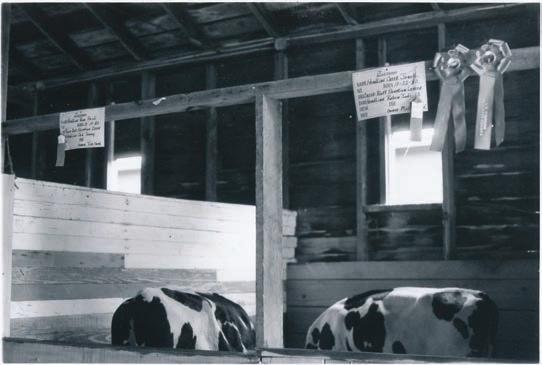
One autumn morning Terry and I decided to go out of the city, heading north to Upstate New York.
We left early in the morning to drive around in several country sites, stopping at some antique stores, flea markets, and some other interesting spots.
We arrived at a County State Fair where the farmers were proudly showcasing the autumn harvest from Mother
Nature. By the time we arrived there, there were already many people walking around, enjoying the big annual event. The joyous country music was blasting in the air, and the smoky smells of BBQ and all sorts of food were enticing people’s appetites, with so many different home made foods such as bread, cakes, cheese, sausages, jam and pies, and a full array of colorful vegetables, fruits, and flowers were on the display tables.
They also displayed the farm animals, such as turkeys, chickens, pigs, horses, and cows. You name it! Every animal you could think of being in the country was there to compete in the high award competitions. We went through the animal farm and the last stop was the cow section. We noticed a couple of peaceful looking, beautiful cows with a kind of friendly look on their faces. We both read the red tags around each neck where their birthdays were written. To our surprise, the dates, October 13th and October 22nd, matched with our own birthdays. Out of 365 days a year, both cows were born on our birthdays! More incredible still the cows names were Terri and Uko. It must mean something!
The more I think about these coincidences happening in my lifetime, I cannot help believing in “Fatalism,” where destiny is beyond our control. It is as if it is all predetermined.
May 10, 2014
I read about Kara Walker’s super gigantic Sugar Sphinx show at the old Domino Sugar Factory that took place before they would demolish the city’s historical landmark in Williamsburg, Brooklyn. I was familiar with some of Kara Walker’s works, but this monumental sculpture made out of bleached sugar evoked my curiosity more than ever before.
So, during the first opening day, May 10, 2014, I walked over to the famous Domino Sugar Factory only a few blocks away from my apartment. There was already a long line of people waiting outside of the fence under the hot spring mid-day sun.
It was an eye opening experience! The gigantic white statue of a black woman as a Sphinx sitting couchant in the dark interior of the monstrously tall old Domino Sugar Factory. The sculpture reminded me of The Great Buddha at Tojo-ji Temple in Nara, Japan and also The Great Buddha of Kamakura (a bronze statue of Amida Buddha sitting on the ground (outside) of Kotoku-in Temple in Kamakura in Japan. I had seen many times from the windows of the J and M trains the famous Domino Sugar Building standing on the edge of the East River, and I had passed by the building a million times in the past, but I had never seen the interior of the building.
Getting inside of the dark factory, I immediately smelt the sweet burnt sugar which reminded me of molasses. I understood that Kara Walker, by using the tons of bleached white sugar and resin, created the marvelous bare-breasted Sugar Sphinx with the head of a black mammy figure to evoke the sugar industry. In its heyday Williamsburg was the most well known as the biggest Sugar Refinery in the world since the 1840’s and as the best known “Havemeyer Sugar Refinery” that drove the slave trade. So the Sugar Sphinx was meant to challenge the art world establishment. It was a powerful political statement conveyed in this provocative sculpture.
I was told that this historical landmark in Williamsburg would soon be replaced with a big condo for trendy types mixed with some affordable housing for the poor. One of the wealthiest real estate development firms in Brooklyn, David Walentas or his son, bought the building and agreed to work with Mayor de Blasio whose idea was to build big affordable housing for the poor In New York City. The
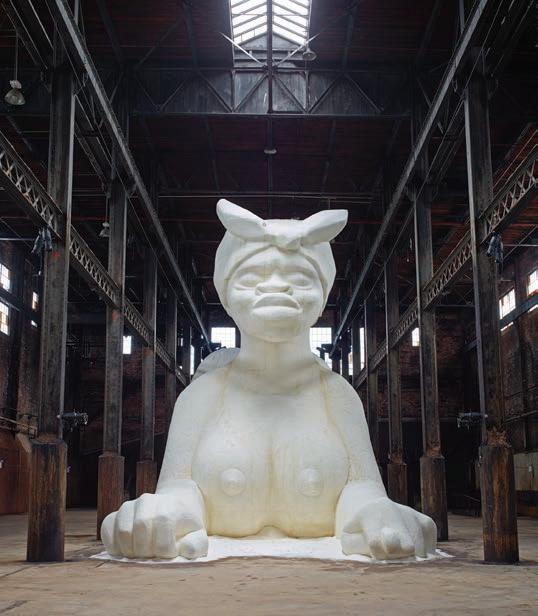
Williamsburg residences’ opinions were that nothing was wrong with building affordable houses for the poor, but using the building solely as a Gigantic Affordable Housing Project was not a good idea. They were afraid that it would become a monstrous prison, where no intimate, personal, and friendly atmosphere would exist and criminal behavior could not be watched closely or traced easily. Clearly we human beings feel most comfortable living in a human scale house/apt, and that was what people really need
The Former New York City Mayors Giuliani and Mayor Bloomberg knew the danger of building big housing projects for the poor as they saw enough bad experiences in the past, so they undertook furious efforts to make the city a much safer and cleaner place to live by building smaller more human scale apartments for the poor where the neighbors would know each other and could watch for any wrong doings. So now in these human scale neighborhoods more visitors started coming from everywhere, which also helped New York City’s economy. Now it would be very curious to see how the new City Mayor de Blasio will change our city. Very scary, indeed, especially when our economy is very bad and there are more criminals on the streets.
So maybe Kara Walker’s Sphinx mammy is a premonition of things to come, that is, big housing projects to house the poor and disenfranchised as a labor pool for the wealthy as janitors and service people…a new slavery.
Terry and I needed to do an errand and we knew the beautiful weather wouldn’t last too much longer, so we decided to leave our computers behind and start driving, letting our carefree spirits lead the way….
To avoid the usual weekend crowds on Bedford Ave, we drove all the way to Kent Ave, along the East River, heading north to the end of Greenpoint where a small canal separates Greenpoint and Long Island City. There a small park plaza that seemed to be recently created, just waiting to be discovered. This quiet and serene tip of Greenpoint is “no man’s land,” but across the narrow river the hovering Manhattan skyscrapers stand like sentinels. It was like watching a silent surrealistic science fiction movie.
An empty tugboat was stationed within our reach, tempting us to take off on a boat trip adventure to a far off land, perhaps the jungles of South America or even Shangri-La, just like the mysterious lands I used to see in James Bond, 007 films.
On the way back we visited our usual spot along a disheveled quiet street. There is a cat shelter where dozens of cathouses are neatly stacked up on shelves, each with a clean straw bed. It is very unsettling not to see a single cat every time we go there. Who takes care of the cats and where do the cats go? Being puzzled again about the cats’ existence, walking along the same street down less than 25 meters along the fence, we heard the most beautiful sound of a bird singing up in the trees. We never heard such a beautiful pure bird singing in our life before. We looked up where the sound was coming from, but no bird was seen. The bird singing was like an opera star singing with all different tones and rhythms…richly echoing in the air. We were the only listeners of the heavenly celestial solo opera. There was no single human being walking and no car running on the street, and that was where the invisible cats are kept undisturbed and heavenly birds find their rehearsal stage up in the trees in the totally abandoned, almost forgotten street on the tip of the northern Greenpoint.
Finally, we drove back to central Williamsburg and reality and walked through the golden autumn tree lined streets and paths along McCarren Park. Among the new condominiums that are sprouting up, the farmers’ market invited us to stop in. There we found an abundance of colorful products from Mother Nature: vegetables, fruits, home made jams, breads, cakes, sausages, cheese, etc. There were many young folks with kids and happy dogs doing their weekend
grocery shopping, yet still it was very quiet with no human voice heard nor dogs barking sounds, like an old silent movie, but not black and white but with full of colors! How strange it was again! We couldn’t resist doing some shopping ourselves and picked some fresh vegetables and a homemade pecan pie.
After our errands, we went back to our office and sat in front of our computers once more. We looked at the photos we took on this glorious afternoon, and immediately made a video. We call it “The Autumn Afternoon Discoveries in Williamsburg/Greenpoint.” The day was quite different from any other day, just because we were not punching the keyboard on the computer as we usually do.
How was your weekend?
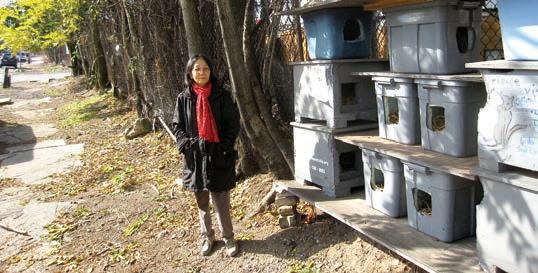
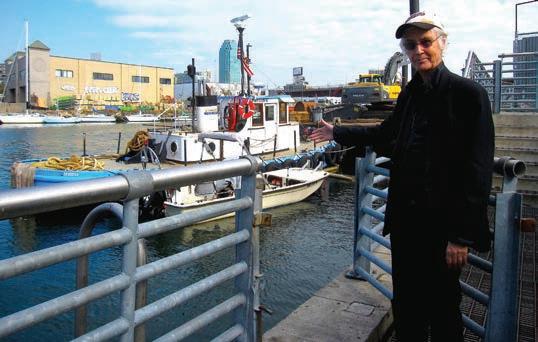
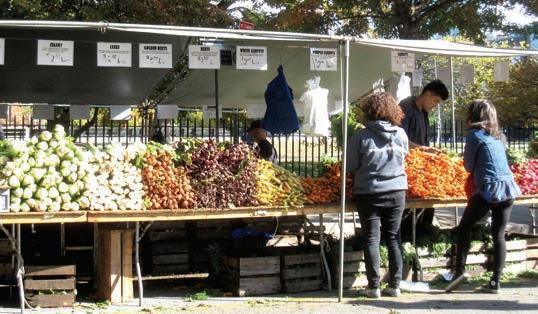
This story is about a fellow artist who is on a voyage of discovery regarding his body, his mind and his will—a voyage he did not seek and would not have wanted. But that is the curse and gift he has received from fate.
Gary Spradling was born in Springfield Missouri in 1951. In 1973 he received a BFA from Southwest Missouri State University, and in 1975 an MFA from the Rinehart School of Sculpture, Maryland Institute College of Art, Baltimore, MD. In 1978 he arrived in Williamsburg, a pioneer resident artist. It was, he says, ”the wild, wild west.“ To this day there remains a bullet hole beside the front door where he has lived for the past 26 years. Gangs roamed the streets shooting guns and this bullet hole is a stray bullet from one of those random shootings. He also found a bullet on the roof.
In 1997, through the Parsons School of Design, he was invited to teach 3-Dimensional Design and Modelmaking at a new school called “The Center for Advanced Design” in Kuala Lumpur, Malaysia for 18 months. During the school breaks he traveled extensively to China, Bali, Java, Borneo, Vietnam, Thailand, Japan, Hong Kong, Singapore, Australia, and Nepal, engaging in exotic experiences such as riding elephants and observing the sky becoming blackened by millions of bats pouring from caves. He even stayed with the Iban tribe, headhunters, who kept several human skulls on a rack in the long house. After he returned to New York in 1998, he became increasingly fatigued. After seeing a neurologist on June 5th, 2000, he was diagnosed with ALS, Lou Gehrig’s disease. ALS paralyzes the muscles and causes death, usually in 3 to 5 years. Gary is in a wheel chair today and speaks to us through a computer voice like the famous cosmologist Stephen Hawkings who also suffers from ALS.
I will never forget my first meeting with Gary. I believe it was sometime in the year 2000 when he came to the WAH Center with his friend (later found to be his assistant) to show me his portfolio. The voluminous portfolio was like a world encyclopedia, telling a visual story of one’s inner voyage. There were countless documentations of his psyche, the transitions of states of mind and body. Because he is a prolific artist, his art nicely fits into quite different thematic shows, and so he has shown quite a few times at the WAH Center. This was a time when Gary was fully ambulatory and able to walk up the stairs to our other floors. In the years

since, I have watched his decline, and have read his numerous poems, and listened to his poems in the WAH Center’s “Poetry Series.” He says his poems began to come to him in visions as he wakes from deep sleep in the early morning hours when he was first diagnosed with ALS.
Meanwhile, Gary continues to be a prolific artist and, since his diagnosis, has created 48 works of art and written to date 167 poems which he hopes to publish in three or four volumes. All of his art and writings now deal with matters of life and death, the eternal duality, and especially with time, since this artist has so much to say and there is so little of that important commodity for all of us.
Gary says in his statement dated April 6, 2004 “ My Illness has magnified my philosophic vision. I am intensely examining the ideas of life and death. Art is a system one can incorporate to investigate consciousness. Artwork is a documentation of that investigation.” The last two lines are his definition of art in his 1975 MFA thesis. Gary says those lines mean more to him now than when he wrote them 29 years ago. And he commented further, “Art is a lifelong process of discovery, interrupted by death.”
Some of the artwork he created before his illness seems prophetic, to say the least. He once took a photo of a family posing around one member in a wheelchair, a paraplegic victim of gang violence. Gary pasted his own enlarged face over the image of the victim. This collage sits in his studio today, an eerie premonition of what he has become. What might have seemed humorous at the time is now an astounding prophecy! “Be careful what you visualize,” Gary says.
Gary had always been a “hands on” artist, an artist of consummate craftsmanship and skill. Today those hands can do little and he can barely move his fingertips to press the button through which he operates his computer voice. “Today’” says Gary “all my art is conceptual.” He creates his art by describing what he needs to Michelle Spencer, his partner, whom I consider his angel, and she, or artist friend Yoshiko Kanai, will get the materials and follow his instructions. But this process is no different than what many artists do today. They are not “hands on” but describe ideas to assistants who do the work. In fact, Gary’s disability has not interfered with his creativity except that the daily ministrations to his ALS needs are sometimes time consuming or tedious. And yet he is still energized and excited about new ideas, and he has so many projects that his assistants cannot keep up with them. Gary’s triumph over adversity through his tremendous strength of will is indeed a profile in courage and creativity to be admired.
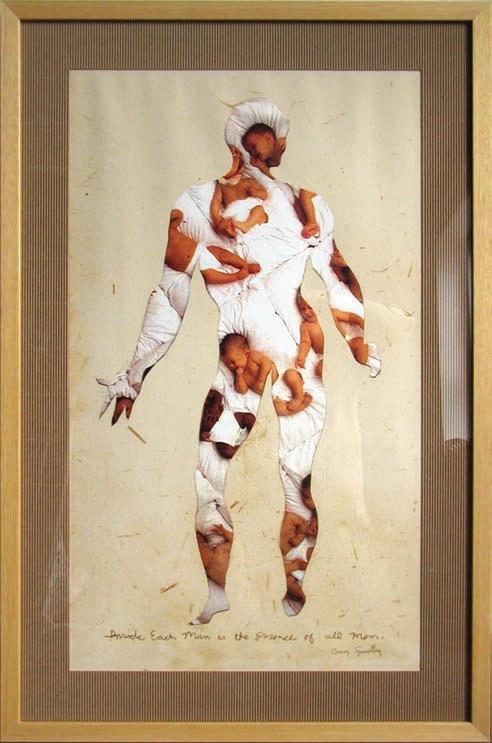
A commentary
Show curated by Shoko Kanai
Opening Reception Saturday April 3, 4–6 PM
April 3–25, 2004
Artists:
Hidenori Izumi, Sachiko Kobayashi, Namiyo Kubo, Teigi Tauchi, Hideo Murakami, Nana Ono, Hidenori Izumi
Since World War II, American Art, particularly New York, has dominated the art world, having gone through one new art movement after another, with distinctively characteristic styles and expressions. However, it is getting harder to find a particularly outstanding art “movement” existing today, if there are even any “movements” as characterized by a perceived new direction from what has gone before. Usually art historians or observers, not necessarily by artists, define “movements” after seeing that a number of artists are moving or have moved in the same direction at a given time— therefore we call it a “movement.” It does not necessarily mean that the “movement” is in “opposition” to, consciously or unconsciously, what has gone before.
It seems that with the constant and fast changing world, life does not easily allow us to stop and think, contemplate, meditate, examine, sort through and digest our accumulated life experiences to come up with a clear sense of direction. So whether or not artists are moving in a common direction is unclear. Often, artists cannot see the movement they are creating because they are unconsciously submerged in the ambiguity of its creation. It is only when artists make a clearly defined statement like a “manifesto” that there is a clear conscious recognition of the movement while it is being created.
We are living in the age of constant change, “Nothing is Permanent”—a “ready to move anytime” to the “next new thing” mentality. Additionally, it is an age of “Abundance of Material Goods” in which everything is disposable and replaceable. These notions are reflected especially in today’s
installation and multimedia art, some of which are made of materials that have been disposed of, are disposable and replaceable, mixing media in ways which do not allow us to know if their interaction is stable or permanent.
The six artists in this show have expressed, in abstract forms, concerns about today’s fragility and impermanence of life, by using traditional Japanese media, which are considered as and preserved by society as “more permanent and longer lasting” than the disposable material used by some contemporary artists today. The artists in this show use rice paper (non-acidic), ink, gold leaf, and ceramic powder, etc. This is interesting to compare to some of the contemporary multimedia artists who, whatever ideas they are trying to express in their art, nonetheless exist in a “disposable” society and have decided to use impermanent, fragile, disintegrating, and replaceable materials and media. This has caused alarm and concern among many museum conservators who are not certain what this might mean to their collection. In other words, some of today’s multimedia artists do not seem concerned too much with the permanency of the materials and media, as long as an immediate satisfaction is achieved visually and artistically, and they are not really concerned about the sale of the work or their preservation for the future, except possibly in documentation by photography or video.
It is comforting to know that in this hectic speedy changeable era we can still find some contemporary artists in Japan who appreciate and use the “permanent” old traditional Japanese media known for more than 700 years during the Daimyo period (1185-1868), sustaining the characteristic Japanese sensitivity and aesthetics so different from that of the West: qualities like Sabi (rustic—a look of aging), or Shibui (subtle—refined simplicity).

May 10, 2007

In the past, the Williamsburg Art & Historical Center has shown the work of Michael Krynski in several shows of Williamsburg’s “Avant-Garde.” His three-dimensional work expresses a monumental solidity and power through elegance that makes his work stand out among those of other artists. Krynski utilizes found objects, such as used pants, combined with industrial material, and objects found in nature such as driftwood tree branches or decomposing bunches of roses.
One of his series of works at our shows was “Stick Men.” The stick men are bundles of dried stick’s wearing worn aged denim pants, and set as if they were walking across the floor or street. This work/installation was also shown at the Park Plaza Hotel in London, outdoors on SoHo’s Houston Street in New York City as a public art project, and at the Brave Destiny show at The WAH Center. Featuring over 500 artists, Brave Destiny was the world’s largest show of Surrealist artists from around the world in 2003. Another powerful work/ installation were his large balls of barbed wire, formidably placed on the floors if waiting for someone to push them to initiate endless motion. Both the stick men and barbed wire balls express potential motion/energy. His work seems to deal with alienation of man from himself, the idea of things eternally about to happen, or happening without one’s ability to control, like the decay of beauteous roses in one of his most poignant installations, the existential dilemma of the modern age: living, decaying without purpose or control, without God, only humanism which is meeting the needs of neither body nor soul.
His photography works are mostly cityscapes of industrialized areas, electric companies with huge smokestacks surrounded by barbed wire, endless rows of new cars, waiting to be purchased in the consumer society and driven to emit
poisonous CO2, or industrial backgrounds as seen from the highway. The scenes hint at decay, danger of urban life, which is today’s challenging “environmental concern.”
In a press release from one of the shows it was said of his work: “Krynski’s work depicts the growing disconnection between the cycles that drive human behavior and the natural order of the rest of the world. They deal with the detachment of Mankind from natural progression of time.”
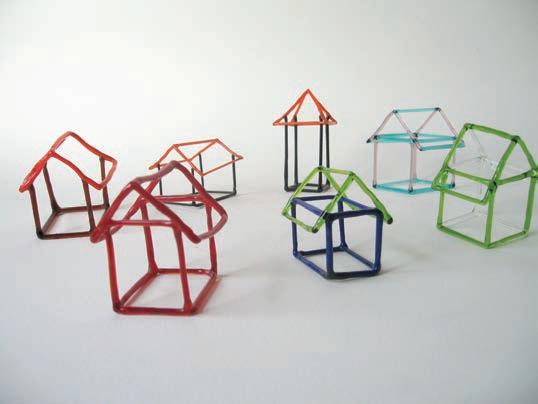
September, 2003
For an exhibition catalog
I was struck by the stark, wondrous world of Gloria Kisch’s studio, with its black painted ceilings and walls setting off the silver forest of hanging bells. In this other worldly atmosphere, one almost senses one is on another planet, expecting to experience something unique and uncanny. About a dozen large polished steel bells are quietly suspended in the stillness with steel chains from the ceiling. Though Gloria called her work “bells,” they are not conventional bells as we know them. Some are more like mobiles with single or double vertical hanging chain, different sizes of thin steel rods shaped like bone or twig balancing in a horizontal position, making harmony. Some look like the skeleton of a fish. Some have three dimensional round ball shapes or are oblong, pea pod like, or ring shaped. They are combined to give weight, volume, and accent. The overall appearance of the work suggests primordial organic nature.
The uniqueness of Gloria Kisch’s work is the use of the material. She has shifted the notion of steel being heavy and grounded, to being light and airily suspended in space, creating an ethereal, feminine appearance and feeling. At the same time the notion of the polished steel, which is mostly seen in geometric and sharp contemporary forms, Gloria has shifted to an organic, primordial appearance and feeling.
Even though her work is sculpture, she negates the volumetric to stress the linear aspect, which is more like drawing. Those quiet, still bells invite the human touch or perhaps a wind to bring the sound—which delightfully makes them 4th dimensional.
Gloria told me that even though much of her life is spent in cities like Los Angeles or New York, she loves to travel to countries in East Asia, Africa, or Latin America. In the current high tech oriented society, our pace of life has quickened, and we are surrounded with material abundance. One tends to overlook our spiritual nature. Gloria is in touch with what we are missing. Her work is an intuitive response to an inner voice rather than a search for logical answers.
Gloria returns once again to look into the basic need to connect nature and spirituality, which is universally shared by every living being.
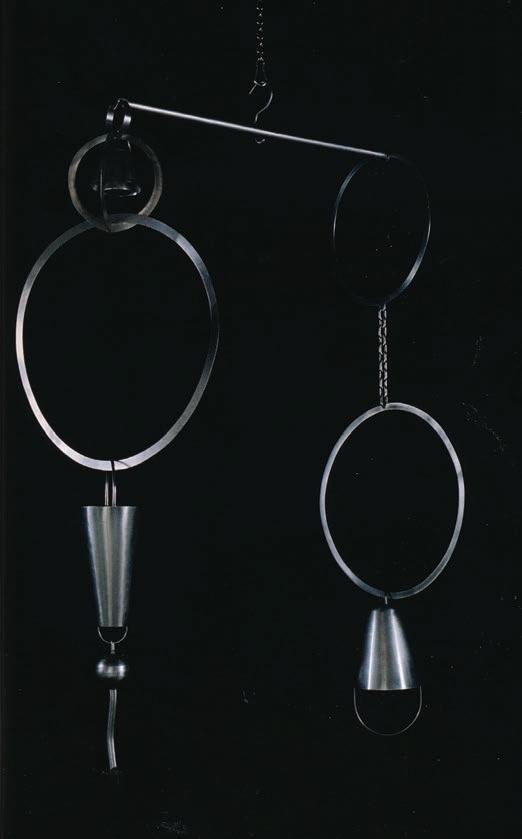
How well you expressed the feeling: “Now I understand that opening one’s heart to life and to love also means to open up to pain and death. There might be an awareness of life and death at the same time in every very moment. The seriousness of life brought along with this awareness is for me yet hard to face. I don’t even know how that works. It might be learned by the body and heart and consciousness.”
If one opens one’s self, one opens to Life and Love, but also opens to the opposite, Death and Pain. Then, for the first time one knows what it really means by Life and Death. Even though we are aware of “Life” and “Death” coexisting every second of our life, it’s hard for us to know what both means.
When we have hopes to achieve or something looking forward to, our will to live well is already with us, helping to take care of ourselves, but when we lose hope or a clear direction to life, it is very difficult to think of our well being. That’s why when one is totally lost, one has to make a special effort to watch out his or her well being, although it is not easy to do it.
I am thinking of you...hoping each day is less painful for you, and you will be able to celebrate your well being because of your mother who helped to bring you to the world. The world is a better place because of you!

I emailed Estelle by saying:
“You are a courageous whistleblower, so you understand why Terry and I do not appreciate unfair, unjustified matters going on in our life, especially when the matters are directly related to the WAH Center or to our artists. We try to let people hear our story based upon the facts. Besides that, it is important for us to keep clear, honest and correct records for future reference, and to also prevent our good reputation from being damaged by a false presentation or beliefs, and to prevent further misunderstandings on the issue. If we let it go without saying a word, people assume that what they heard was true. That’s why many unethical things can get by and are even repeated, as people don’t often wish to raise their voices or show their objections. People are too busy, or not interested in or even too scared to speak out with their honest points of view or to get involved with conflicts. Of course, it’s nice not to have any conflicts in life, but if an important enough unfair matter occurs, it’s necessary for conscientious individuals or organizations to try to speak out so the misunderstandings will be clarified. But, I also understand human nature: they try to avoid any headaches in life.”
Another email to her:
“Thank you for sharing your thoughts with me. By now I know something about human beings and life in general. Some people are genuinely open-minded, with kind generous hearts that share with others the good things about life and human relationships. Those will go far, further than one can expect. You know, and I know, that good energy always bring back better results.
“Those who keep everything to themselves without sharing goodness with others will stay forever where they are and who they have been. No growth. So, I don’t care and I
don’t have time to think about that. All I have to do is to go forward with the things I set my mind to achieve with positive energy and guess what... you came along, and those who you have recommended have come along. Thanks to the real, full-hearted people like you, the WAH Center has a wonderful group of artists as the jewels in our crown. I love them all, and most importantly I love you and I’ll never forget who you are, Estelle. You are special!!!”
Dear WAH Salon Members and Friends,
Today, I got a couple calls and emails from the WAH Salon members, telling me of the death of Estelle Levy. They told me that they had found the news from Facebbok.
Yes, Estelle Levy’s nephew, Ed Levy informed me yesterday that his aunt passed away on Tuesday May 27 from complications from Lung Cancer. We have lost one of the long-lasting WAH Salon members and a great supporter of the WAH Center for the past 17 years. And she was one of our dearest WAH family members!
According to Ed Levy that Estelle’s wish was to reach out to me and want to hear my advise as to what to do with her numerous artworks left in her apartment. Ed wants to make sure that her works will be kept in a good home.
After a serious consideration, Terry and I have decided the following: We will be extremely grateful for her works donated to the Yuko Nii Foundation and they will be kept in its permanent collection. We feel strongly that Ed wish will be fulfilled, and Estelle would be also happy to find a permanent home to which her work belongs and will be cared. Our home is the perfect place, after all she was born and raised in Williamsburg, Brooklyn and she is coming back to her “Home, Home My Old Sweet Home” in Williamsburg.
We would also like to give her “Memorial” show in the fall, October – November together with another artist and a friend of the WAH Center, Fernando Babot who also passed away recently. We think that Estelle’s wonderful ceramic sculpture pieces (3-D work) and Fernando’s unique paintings (2-D work) will go beautifully together in our spacious galleries. It’s a perfect show bridging man & woman, 2-D and 3-D works, an American artist and a French artist
on the Death of Estelle levy
An Email Letter to our WAH Followers
From Yuko Nii
I would like to share with you my memory of my beloved Estelle Levy.

She called us on May 5th, telling us that she was hospitalized, being diagnosed with lung cancer. I visited Estelle at the Lenox Hill Hospital twice during her stay at the hospital since May 5th: once on May 7th and another on last Sunday, May 25th.
My first visit to her was on May 7. To my great delight she looked well and beautiful, with her mind was as sharp as ever, unchanged. I stayed with her about one hour talking about how she ended up in the hospital, how she spends the days at the hospital, her medications and miserable hospital food (when I showed her the variety of different flavors of Yogurt in a paper bag, she looked very happy with a big smile on her face). And she also talked about her recent ceramic sculpture she created, I informed her the up-dates at the WAH Center, which she is always interested to know about, and the current art scenes in New York, and a bit of politics, of course, etc. We even laughed about the things as we did in the past. We enjoyed each other’s companionship as we have always done in the past 17 years. She told me that she would return home in a few days. I kept calling her at home, her cell phone, and also her private phone at the hospital but no answer, which worried me a lot. I found out that she was still in the hospital, having been moved from one room to another, four times altogether.
When I visited her last Sunday I was surprised to see her wearing an oxygen mask, sleeping soundly. Her nurse told me that I could wake her up and that she would be happy to see me. So, I reached out and held softly her cold hand, and then she opened her big eyes, smiling at me surprised. I showed her the Yogurt in a bag, and her eyes opened widely, and she kept saying “Oh, Yuko, Yuko…” despite her difficultly in raising her voice through the mask, but I could hear her quite well. I didn’t want to strain her or exhaust her too much by staying there too long. Before I left her, she said “I love you, Yuko! Thank you! Good-bye,” and I said, “I’ll be back again to make sure that you are off the mask and in better shape! We’ll walk together! I love you, Estelle!!” We looked at each other for a long while. My tears started to come. I left the hospital, feeling that this might be the last time for me to see her.
And it was indeed, it was the last time for me to see her alive!
Estelle was not only a uniquely talented artist, but she was
an extremely kind supporter of the WAH Center ever since the WAH Center was opened in late 1996. She understood the hardships I/we had to go through in establishing the notfor profit art organization, and she observed the center’s growth very closely, and also helped us grow in many ways. She introduced us to new talents and good human beings, and recommended them to be a member of the WAH Salon Art Club. She shared the joy whenever a good thing happened to the center, which gave me enormous encouragement and genuine support so that I/we could keep going forward.
My beloved Estelle, Terry also loved her so dearly. Her intelligence and sense of humor which Terry and I appreciated, and her understanding of the “absurdity in life” matched with ours. I valued and respected her strong personality and unique character. She was wise, creative, critical, straightforward, honest, and fair-minded with a sincere and warm heart. Everything about her was truly authentic! To me, her mind and heart were as big as the Sun!
The wisdom she passed on to me will stay with me forever, and furthermore, her artwork that we have acquired for our permanent collection will be treasured for many years to come.
We lost our precious friend and mentor, but she will be with us always, leaving the memory of her healthy laughing sound and big smiling face! One thing that made me happy was that she told me at the hospital that due to her medication, she was not suffering too much pain. She slept permanently “in peace,” I hope….
Her presence will be missed by all of us.
“Yes, Estelle was a “special character” with strong personality and opinions, and because her especially keen sensitivity which tended to over-read/misjudge/misunderstand people’s intentions (with no reason) sometimes she offended and frightened people, and people didn’t know how to take or respond to her idiosyncrasy. It is interesting to note that while she was a fair-minded person and stood for “justice” and fought against “political wrong-doing” in the society (as she called herself a “whistle blower”) when it comes to her personal relationship with her friends, she became blind not being able to accept what her friends meant. It happened to me once, and I confronted her in my straightforward manner. She deeply apologized and said to me, “You are quite right, you are so logical, and I will be more careful.” We all have a blind spot in which we do not see our own weaknesses, as we are blind.
“You are telling me about the current happenings of your close relatives’ endings, and the same as my own close friends who passed away or who got injured or disappeared, etc.
“Life, You Never Know” and “Life Is So Ephemeral”
“While ‘Death’ is occurring everywhere more than ever, including many in the war fields today, there are also amazing new beginnings—with no end for the increasing world population.
“Human Survival Instinct amazes me most!
“P.S. You wrote me an interesting letter about ‘Dubai’. I enjoyed it very much. Those countries are going through “a great transitional stage” like in the USA, way back with migrations from Europe, Asia and elsewhere. Forward to the ‘Wild, Wild, West’ ‘Searching for ‘Fortune, Gold, Adventure.’ Whenever possible they moved to better money making places, and they changed the ‘once wild but beautiful lands of nature’ into ‘monstrous tall inhuman gigantic smoke belching concrete skyscraper cityscapes.’
“In the Middle East, ‘Oil is Money’ and if the country has enough money, they can change their ‘Desert’ into ‘Oasis’ for human habitat, just like Israel did with the great financial help from the USA—once it was a dry harsh land, now it is a comfortable civilized place to enjoy living. Look at the ‘Man on the Moon’—racing to find somewhere where future human generations can live. It’s all a matter of human survival…just like mice and roaches, they survive by all means!”
Much Love, Yuko
I often think about why a particular animal loves one particular human being more than any others, or the other way around, why a human loves one particular animal more than any other animals.
The answer seems quite simple: humans and animals share the very basic primordial “animal instinct” for the sake of survival.
Instinct is a way of behaving, thinking, or feeling that is not learned: a natural desire or tendency that make one want to act in a particular way. There is no specific logical and rational reason why all living beings, either from the intellectual and culturally sophisticated society or the lowest primitive society, share the same basic natural, innate impulse, inclination, or tendency.
When I came to this country, I noticed that many people would stick to their familiar backgrounds of cultures, traditions, customs, climates, all of with which they have been so used to as a way of life. They feel comfortable and safe; they can function better in their life. One does not seek a harder life, as the ultimate human desire is to be happy and live peacefully.
Most animals, including domestic animals such as dogs and cats, share the same tendency that makes them act in a particular way as we humans do.
My experience with a friend makes me wonder why, what this is all about….
When my friend and I go out for a walk side by side, a dog spots us walking together and comes around right next to my side, wiggling his or her tail. While still walking along with us the dog goes around in front of my friend, trying to prevent us from walking together by barking at him with a severe face. My friend gets irritated and angry at the dog’s behavior. The dog challenges with him further and fearlessly continues to bark at him, but next moment amazingly he comes along right next to me, happily toddling along by my side. The dog must be saying something to me, by showing his disapproval of my friend as my companion. It is a warning sign, “Watch out! Don’t be together!!”
I had a cat whose name was Miss Marble. I saw her similar behavior reacting to my friend. She used to sit right next to me, happily making the sound of purring, but when my friend tries to touch her to show his affection, Miss Marble used to jump away. My friend was not too happy about that either.
Even a mouse, whenever I come to greet him, even in his sleep, he wakes up and tries to reach out me from his cage, but when my friend comes in, the little mouse never comes out from where he hides and continues to sleep or hide under the tissue paper.
Having experienced these instances several times, I can almost conclude that those animals can sense a kinship with me. They know instinctively I’m “safe” to be with, while they feel opposite towards my friend. I often think that in my previous life I must have been their family member and they have to protect me from endangering situations that I am confronting.
The Buddhist says, “When you hear someone knocking, go to the door and greet yourself.” In the same way, when you see a cat or a dog or a tree or a flower, remember that you are greeting what you have been or what you will become.
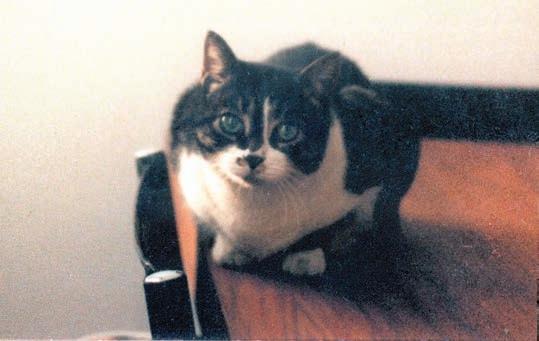
My Life Companionship lasted for 14 years
It was 1995 when a tiny creature became my family member, or I should say I became her obedient servant!
The way she entered into my life was by an accident or by a predestined fate. I prefer to call it “serendipity,” fortunate accident.
I placed an ad “Apartment for Rent” in the Real Estate sections of the newspapers, The New York Times and the Village Voice. I received some responses, and one of them was a fellow who introduced himself over the phone as a passionate animal lover, and he came to see my apartment. He told me that although he liked my apartment very much, unless he was allowed to bring his family members to live together with him, he could not move in to the apartment. I asked him how many family members he had, and he said his family members are quite different from what I might imagine. So I became very curious about this interesting character and I said to him, “Fine, you can move in with your family members.”
It took him about a week to complete the move from his previous apartment to my apartment. No wonder it took him that long…he had to transfer by cart one animal at a time and he did it only during the middle of the night when people were in deep sleep.
One week passed and he called me to tell me that he wanted to officially introduce his family members to me. So I went to meet them with great interest, my new tenants. To my great surprise, his family members were dog named Max, plus 2 cats, many birds, one snake, and a couple of mice, etc. and so many plants and flowers. And so he started living very happily as my tenant in my building.
His name was Chris H. He was a professional photographer working for Ralph Lauren, and we hit it off soon after he
moved in, simply because he had a great sense of humor and wit, and we could talk about anything which came to our minds openly with no hesitation or inhibitions. He had a world objective view, not opposing black against white, left against right, man againt women, Republican against Democrat, and we were able exchange in the most healthy idealistic way (at least I felt comfortable to spell out my point of view honestly and openly) which I enjoyed most. We could keep going on any topics from politics, economy, social issues, gender issues, the beautiful Mother Earth, Flowers and Bees, how to cook things and how to arrange the most appealing foods on a plate, ugly human behaviors, etc. and we chatted for hours over beer or wine till late at night sometimes until the sun came out! He was a gentle man who made sure that I would get home safely by escorting me to my home no matter what….He was like my family extension almost like my own young brother.
He was a good looking fellow with pure blue eyes and blond golden hair which reminded me of the typical American boys I used to see in the American films in the ’50s. But his kind and sweet and even shy character was hidden under the surface of his otherwise stern and serious looks. He was a son of military family: his father was a high ranking officer of the US Air Force who brought his son to be a well disciplined with good manner and a high achiever. Because his family moved a lot during his growing stage he could not feel a kind of security, stability and comfort a young child would have needed in growing up. He could not find close friends of his own age and he didn’t find the deep rooted ground to which he knew he belonged. He found animals as his most close loving friends and in whom he found love, comfort and security. He told me about his background story after getting to know each other better later time.
Because he was brought up to be in the environment of a certain strict rules and orders in a military uniformed environment, when he entered college, going away from home, he started enjoying a liberal free spirit living environment of a college campus, he could wear what he wished to choose while still maintaining his up-right deeply rooted
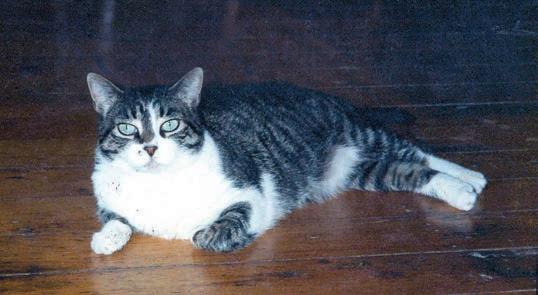
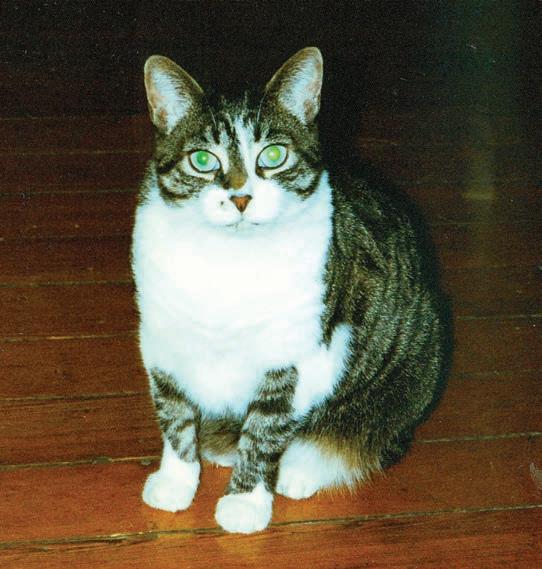
background trace from which he could not and he didn’t wish to escape.
He used to wear one pink sock for one foot and a yellow sock for the other, and always very conspicuously colorful socks so one could easily spot who was walking on the streets.
Because he was a photographer, he made one small bedroom as his dark room. Each time I visited Chris, his dark room door started slowly opening and a tiny sweet voice was heard, and a tiny little face of a kitten peaked out with big blue eyes almost bigger than her own face. I asked Chris about this new family member. He told me that he had found her on the street coming home late at night and she tried to follow his colorful socks. Of course, it was inevitable for Chris to bring her home. However, Chris already having his 2 cats in his apartment they dominated and bullied the tiny creature and got to be so mean to her that the tiny one shrunk away and hid herself in the dark room. According to Chris, the only the time she tried to come out from her dark hideaway was the time I made a visit to Chris. One day he held up this tiny one and said to me, ”Yuko, this belongs to you. She loves you, her name is Vulva,” I told him that I always had dogs as my friends but not a cat. I said, “I don’t know what to do with this little one.” His answer was “Just simply take care of her, she loves you and you will get to love her,” and he put her in a brown paper bag and said “Call me when you need my help” I had no choice but to hold this tiny brown paper and I headed home. That was the beginning of
my story of how this little one became an important part of my life.
I had to change her original name, Vulva to Miss Marble, because she had big green blue eyes and they were like round and shiny like big marbles I used to play with at my young age. She had a pure white soft haired chest and she always wore pure white socks never got dirty. Her big ears pointed up-ward never missed any sounds. Her ears twitches when enjoyed the music I favored including classics, Jazz, Indian, etc. The tip of her nose was shaped like a perfect pink colored heart, and she had a small black “Beauty” mark very noticeable on her white cheek on her right side face. She was a small “Elegant Beauty” (grew up to be 13.5 pounds), and she was not a great athlete, but a sensitive artist and a profound thinker, which distinguished herself from the rest of her own species. I started feeding her twice a day, dry food in the morning and canned food at night. She was the sweetest little one I could ever dreamed of. She hopped on my lap and started scratching one of the arms of my reclining chair while I was intensely watching TV. I had to stop her from scratching my chair and confronted her by saying, “Miss Marble, no scratch!” She looked very sad showing a bit of guilt by shrinking away, and then she came ever gently to sit on my lap, and started purring and fell sleep. To her, misbehavior was something she never did or experienced before and when she was forgiven by my gentle acceptance, she was so relieved that she fell asleep with content.
How sensitive and how adorable she was! I fell in love with my MISS MARBLE. She never scratched any thing again after that one incident! She surely needed my close attention and affection which I poured like any mothers do, “unconditional love” that creatures on Earth give to their children. I usually watched the 7 pm news on Cannel 13 for one hour during which time I ate my supper. Miss Marble would wait sitting on a stool where my feet were rested quietly until the evening news ended and she came over on my lap and two of us watched TV together. Her back was in front of me and I started giving her Shiatsu massage while my eyes were still on TV screen. After a while my hands needed a bit of rest, and I stopped giving her Shiatsu for a while, and she turned around with a grumpy face with her puffing cheeks, and I had to start Shiatsu again. And the next routine was feeding her canned food in a plate and fresh water. I left her alone till she finished eating. But sooner or later with
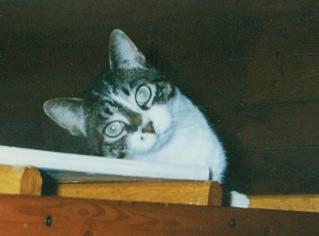
her happy hops she came back to me and meowing something, which I didn’t know what she was hinting at. Then she walked away and naturally I had to follow her. She stopped in front of her dish, which contained a tiny portion of the leftover food. She was apparently pointing out to me, looking at my face. I had to scoop that tiny left over food in my hand to feed her. That was the beginning of the routine service I had to give my Master Miss Marble every day. We had a regular life now. Meanwhile my friend Chris checked in to see how we were getting along, kind of like a family doctor, and my answer was always “Great!” Miss marble got to know my weaknesses and soon I became a submissive servant under her domineering dictatorship! Chris said “I told you that she would love you and she would make sure that she would belong to the person who would love her more than anyone else. Cats are very clever that way.”
Thus, I started learning the difference between dogs and cats. When Terry came into my apartment she showed her definite “unwelcome” sign and was not at all happy about his visit. While sitting around a table we talked and Miss Marble would also sit on the table and listened to our conversations like a judge of a family court. But when Terry raised his voice, Miss Marble’s ears stood up and immediately came around to my side of the table in order to defend me or protect me, and when Terry tried to reach out to touch her, she immediately jumped away from the table. You should have seen Terry’s feeling of disappointment by Miss Marble’s disapproval gestures in reaction to his behavior, which he himself didn’t know why. But, Terry’s reaction to that incident was always, “Oh Shit, Dog Gun it!” Only Miss Marble knew how to react instinctively.
During the summer I went to visit my parents in Japan for a month, leaving Miss Marble alone in care of Terry. On the night of departure Miss Marble knew that I was leaving, and she hid herself in my luggage and never came out. Trying to find out where she went, I looked for her frantically calling her name, she answered with faintly sweet voice, but I couldn‘t tell from where her voice was coming. Only when I opened my luggage in trying to put more of my belongings inside to take for the trip, did I find Miss Marble in the luggage refusing to come out. The next morning was a painful experience: Miss Marble was sitting facing the fireplace mantle her neck was down a bit, not looking at me at all. I had to come and pet her, saying “good-bye,” but she looked down and never showed me her face…I was so sad to leave her alone. My main concern was how Terry and Miss Marble could tolerate each other during my absence. Terry’s job was to feed her twice a day and change the litter box once a day, and clean up her environment once in a while. Terry called me at my parents on the third day after I left and said that Miss Marble had not been eating at all and Terry was
worried. I told him that she was either on a hunger strike or she was doing fasting for a while. I said, “If she became hungry enough she will start eating again.” Sure enough she knew the serious game of “Live” or “Die” and so she decided to live! She decided to forgive Terry’s misbehavior toward her servant, Yuko! They got along fine thereafter.
Upon returning to my Brooklyn home, the first thing I looked for was my darling Miss Marble. And I found her sitting with the same position as when I left, in front of the fireplace not looking toward me and still showing how upset she was for my leaving her alone, which made me feel very guilty. But sooner or later she showed how happy she was to have her servant back giving her that wonderful Shiatsu massage, feeding her and talking to her constantly. Every trip I made to Japan was the same repetition for several years
When I started painting, it was her ritual routine, that she sat on a cushion next to me, observing very quietly and closely each move I made until I stopped, and when she needed to go away for a while, she always meowed, saying “Excuse me” and returned back to the cushion and announced with another sweet voice, saying “Here I am, I returned.”
When I brought some sculptures or paintings home, she sat in front of them examining them very closely with watchful eyes from the top to the bottom like an art critic or an
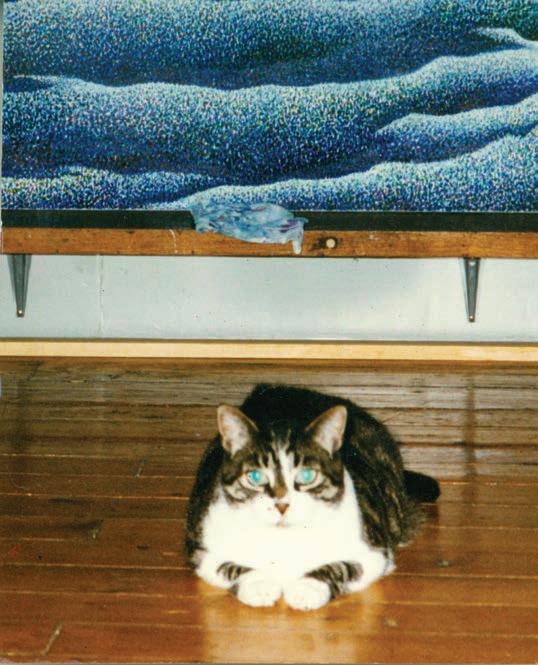
auctioneer until she was satisfied totally. I always wonder what she saw and what she liked/disliked….That’s the mystery….I could never know about her opinions on art.
Because I was renovating my living room I had to replace the old floor boards with the new oak wood floor, during which time Miss Marble found a happy hideaway to adventure under the floor and enjoyed the newly discovered underground playground. One morning I missed Miss Marble’s wake up call, and I came down and had a cup of coffee. And went to my studio to pick my tools to start working on the floor. Here she was, Miss Marble sitting right next to my carpenters’ tools neatly lined up just the way I always leave after using them including a couple hammers, crow bar, screw drivers, saw, electric drill, circular saw, etc,, Miss Marble always observed how I placed all tools neatly lined up on the floor. When I came to my studio and I was almost ready to reach my tools, here she was, how strange and almost shocking to notice Miss Marble sitting very still and quietly next to my tools, and I didn’t notice at first what she was doing and why she was there. Upon looking more carefully, Miss Marble was holding something moving under her paw trying to hold on tightly, but looking at my face with curious but a kind of proud look. That moving creature was a small alive mouse! I was almost fainted to see the horrible scene. A moving little creature was struggling to escape from the captivity. After showing off the victory of her captivity, Miss Marble quickly carried the mouse away with her teeth and disappeared underground dark world. She stayed there for a long while. By the time she came back to the real world, she looked like a beaten up soldier who lost the battle having lost her pride and dignity…and she didn’t hop on my lap, but went straight to her basket to sleep. Whether she had a great fun or she had a misery, I could not tell. But, I assumed that she had fun for a while, but she became unhappy later. Even though the floor was up for a few more days, Miss Marble never attempted to go back to the dark underground world again. Her frantic behavior lasted for a few more days until I put the new floor.
My bed is on the upper level like a bunk bed so that one had to climb several steps to get there. I had to put a protective board to prevent from Miss Marble climbing the steps so she would not come to try to sleep with me. Miss Marble learned quickly enough that I didn’t allow her sleep with me as most of her species normally like to sleep with their loving masters. But when morning would come, she sat on a couple steps up below the protective board and called me with sweet quiet voice, “time for you to get up.” She was my alarm clock, always there punctually at the same time to wake me up. When I needed more sleep, all I would do was to tell her, “Miss Marble, I want to sleep more,” and she would go away quietly. She was always respectful in
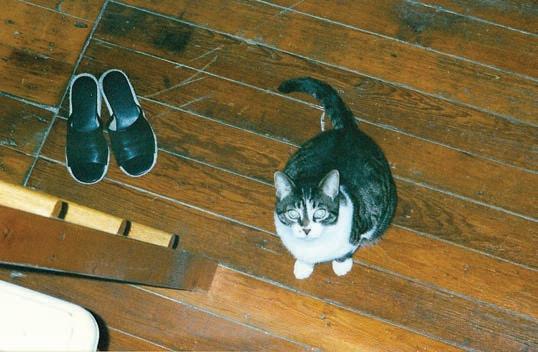
showing her as a well mannered family member. We knew each other’s needs and we respected each other’s position and we knew how to make a space between us so that we didn’t end up “choking each other to death” in a cloying relationship.
One late at night or early in the morning, I heard a loud noise coming from below my bed as if a carpenter was started working the middle of the night that I couldn’t fall asleep. I thought that my tenant who lived below me started building something, and I felt urgent enough to make him to stop making the noise. I thought I would have to go downstairs to knock on his door. But quickly realized that since my tenant was a deaf, he could not hear the sound of my knocking his door, so I forgave him working hard on his project all night during which time I could not sleep even a wink of a minute. I had to wait until the sun comes out and would go to eave a note under his door, saying, “Dear Chris, you were making so much noise all night that I could not sleep at all. Could you kindly stop making the loud noise after 11 PM? Thank you for your kind co-operation. Your Landlady, Yuko.”
I got up from bed without Miss Marble alarm clock wake up call I was puzzled but, I heard loud snoring sound coming from some where. It took me a while to find where the snoring sound was coming from. Below my bunk bed was my closet and the snoring sound was coming from the hallway where the closet was located and the snoring sound was from behind the halfway opened door of the closet. I found the nearly dead Miss Marble making the sound of a giant man’s snoring sound.
I also found so many scratched marks on the door of the closet. Marble was making such noise while trying to slide the tightly closed closet door. She worked all night trying to open the heavy door and finally succeeded it. And with that great success and the total exhaustion she had to crawl in the closet and was sleeping making a giant man’s snoring sound! She was always curious to find out what was behind
the tightly closed door of the closet. She always wanted to get in there, but I always shut the door quickly and tightly before she hopped in the closet. Finally she wanted to adventure herself at middle of the night attempting to find the secret behind the closed door. With her small paws but her strong will and determination and persistent hard trial she had to satisfy her long sustained curiosity. She struggled hard to near death, never gave up her wish until she finally discover the hidden secret behind the closet door. She slept continuously making the loud giant man’s snoring sound for several hours.
I was very glad that I didn’t have to complain to Chris about the noise I heard all night.
Miss Marble started showing signs of sickness, I had to take her to a vet. There I let her out of her cat cage. While many cats and dogs were restlessly waiting for the doctor’s calls while attached to a leash or in a cage, Miss Marble just sat quietly looking at the other animals with great curiosity, and some animal owners were amazed to see Miss Marble not showing anxiety or any discomfort sitting ion my lap among many restless animals at the hospital.
When Miss Marble’s turn came to be called into the doctor’s office, she was well prepared to be examined by the doctor and gave all the cooperation the doctor needed to let him examine her with no sign of resistance. When I gave her a pill, she disliked it so much she never swallowed it and would spit it from her mouth, but the situation was totally opposite with the doctor, she swallowed the pills very willingly, and lay on bed as she was told and let the doctor examine her thoroughly. The doctor couldn’t get over this special cat’s total trusting surrender to the hand of her life-saver, the animal doctor. When we came our from the doctors office, people who were watching Miss Marble’s remarkable behavior said to me, “How did you train your cat so well.” My answer to them was, “My cat, Miss Marble has trained me so well, she is my teacher!” And some of them were surprised to hear the name, and laughed, “Miss Marble!! What a name!” and they all said, “Good-bye, Miss Marble!!”
That was the first and the last visit to an animal hospital. Ever since she continued to be weaken suffering from her cancer, getting so thin, losing eye sight, but she knew how to find me and I had to hold her to put her on my lap, and ever gently gave her favorite Shiatsu until she ended her pain and suffer. She lived with me a wonderful life together for 14 years! I had a great rapport and affinity with this living being and I missed her and still think of her from time to time wishing her to come back so that I could be an obedient servant once again!
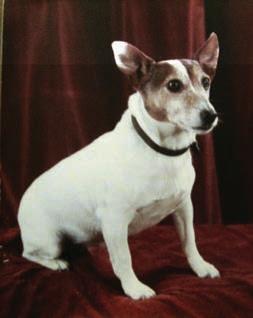
Yes, you cannot imagine how I fell in love with that dog. His name was Turner. He was so polite, sitting with good posture showing a great dignity, and trying to shake hands with me to introduce himself. So, I greeted him by shaking each hand with him. He looked happy and content. That was the beginning.... We stated conversing with each other for a long while: sometimes he would tilt his head like a profound thinker questioning me something, and sometimes he nodded... Well, finally the dog owner came out from the pharmacy. Looking at her, she looked very much like her own dog, a very sweet and kind looking woman. I often find that a dog owner looks like his or her dog. A woman with a French poodle looks like her dog. The German Shepherd looks like his or her master. Both not only look alike, but also even behave similarly.
She told me that her dog’s name was Turner, and she learned so much from him. She said Turner could always spot his friends immediately and wanted to talk. When the time for Turner to say “Good-bye” to me, he was extremely sad to the point he had tears in his eyes and he continued to be sad about departing from his attached human friends. She told me that Turner would often stay very sad even after arriving home. To Turner, finding good friends was like a permanent security, and separating from his friend was the cutting of a strong bond he thought he had established with his friends. I was almost crying to hear about this sensitive friend, Turner.
And finally the time for us to leave each other came when the owner told Turner, “Say Good-bye to your friend. Very sad, indeed. When I said “Good-bye” to him, he showed me a sad face looking down with a sound of sobbing, no joke!... When I turned around to take a look at him, he was also turning his head towards me to see me going away. We were both very sad, and I almost cried.
Yes, that is true, especially in Williamsburg and Bushwick we come across all sorts of dogs walking with their owners day and night. I always look at the dog’s face and shape to compare with their owners. They are so much alike that sometime we don’t know who are taking a walk for whom.
“In every bit of honest writing in the world there is a base theme. Try to understand men, if you understand each other you will be kind to each other. Knowing a man well never lead to hate and nearly always leads to love. There are shorter means, many of them. There is writing promoting social change, writing punishing injustice, writing in celebration of heroism, but always that base theme. Try to understand each other.”
John Steinbeck, 1938
I have befriended several mice in my lifetime. The first was while I was attending Pratt Institute in the 1960s. A friend of mine gave me a white mouse in a cage as a pet. As I didn’t care too much about having a mouse as a pet, I refused to accept my friend’s gift. She insisted that I try it first, and if I didn’t like the pet, I could always return it to her. She left the mouse in the cage in my apartment. Ever since then, the white mouse became my family member for whom I became a slave…feeding her with food and water, cleaning her cage, keeping a watchful eye over her at least 2 or 3 times a day.
One night I saw a black mouse clinging to the cage. I tried to chase the black mouse, but it refused to move. Later, I found that he was making love to my white mouse. Soon, there were several small new creatures in the cage. The white mother mouse must have been quite unsure about her own manufacturing of those tiny moving gray creatures. The next morning when I came to see the cage, I couldn’t believe what I saw. It was a massive massacre, beyond what I could have ever have imagined to be possible. No more were there tiny moving creatures, now there was only many small ripped pieces scattered all over in bloody pools in the cage. The white mother mouse was transformed into some kind of pinkish creature, painted with red all over her body, looking nervous, frantic, and insane, running wildly all over the cage. I was so utterly shocked to see the wild scene that I couldn’t go back to see the cage afterwards. I left the nightmarish scene in the cage with the pink mother mouse and the tiny pieces of meat scattered all over the cage. The next day when I came to see the scene, some pieces were gone. I assumed the frantic mother mouse must have eaten some. It took several days for the mother mouse to calm down, and it took me more than several days to get back to my normal life.
I had to leave out of town, traveling by bus, and I decided to take her with me in the cage. I got on the bus with the cage covered by a cloth so that nobody would notice that I carried
a mouse with me. I put the cage down next to my feet in the bus and I fell asleep. While I slept, the mouse must have escaped from the cage (how was she able to get out from the cage?). I woke up with a man’s screaming voice, telling the passengers in the bus that there was a white mouse running all over. I looked at my empty cage below me, and I almost fainted. But, I had to make an announcement, informing the passenger, “The running white mouse belongs to me, but she somehow escaped from the cage. If you find her, please let me know.” Everybody was shocked to hear my announcement and some laughed and some screamed.
The passenger who informed everyone about the running mouse looked all over in the bus, and finally he captured her by holding the mouse’s tail, and proudly said to everybody, “Ladies and Gentlemen, I captured the lady’s loving pet!” Again, everybody screamed. He surrendered “my loving pet” to me and tenderly put her in the cage. All of the passengers praised him and clapped their hands. He told me that he was from Israel, and he loved mice, and he knew how to capture them. It was an amazingly lucky incident that a mouse lover from Israel saved my little family member in a crowded bus in middle of the night with no lights, the white mouse dancing up in the air like a swinging pendulum lifted up by the kind Israeli fellow.
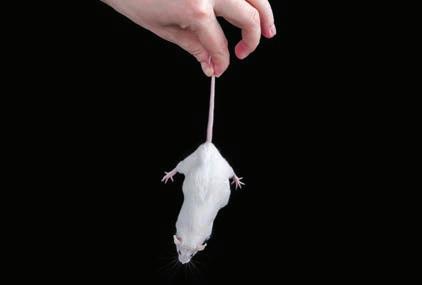
The second time a mouse became my family member was when I hired a plumber to work on the drainpipe in my kitchen. Because the plumber couldn’t finish the job that day, he left the floor hole unplugged and went home with the intention of coming back next day to finish the job. I didn’t know there were mice in the building, so I didn’t think twice about the unplugged hole on the floor. Apparently the unplugged hole on the floor was an open invitation to welcome a mouse or mice to my apartment. The plumber didn’t come back next day to complete the job. In the middle of the night, I woke up and went to drink water in the kitchen. I switched on the light, and to my great surprise, I found a smallest creature sitting still on the kitchen counter. He never seemed to be frightened enough to escape from
the counter top. He was calmly looking at me with a kind of smile on his face, trying to say something. I felt very puzzled and even more curious about this calm creature. I started thinking that there must be some profound kinship that the little creature found in me. So, I reached out a big empty glass jar (which was an empty clean pickle jar) sitting on the countertop, I put a sheet of paper napkin and small torn pieces of seaweeds, a small portion of uni (sea urchin) and several grains of cooked brown rice in the jar, and went back to sleep.
Next morning I went to the kitchen and saw an unbelievable scene. I found the mouse in the jar making himself quite comfortable at home with no intention of leaving. Ever since the jar became a home for my new family member. Terry came along and saw the amazingly calm creature inside the jar. With a possibility that the mouse might run away from home, Terry punched several holes on the metal lid of the jar to keep him inside the glass house.
We started calling him “Rodney.” Rodney made so much noise for his size that it echoed in the kitchen late at night and I had to get up and check to find out what was going on. He was happily eating dry seaweeds by holding them with his thin fingers so that they would stay in his hands till he finished eating them. I would put uni (sea urchin) on my finger and he would lick it off with his raspy tongue. He loved brown rice and some green vegetables. He loved everything I ate. He was a macrobiotic food lover.
His fur became so shiny and smooth like a silky velvet cloth, and when he ate too much peanut butter, he got fat, but kept himself quite lightweight and stayed as a delicate sensitive handsome boy!
An amazing discovery was Rodney’s creative talent and engineer’s skill. Each day I had to change a new paper towel and left it in the jar. He spent all night building his own house out of the paper towel by folding into a three dimension hard edged origami house standing straight up in which he hid himself and slept. He tore a perfect round hole on the house to peak out. He was always looking out from the small window of his paper house. Sometimes we put an eggshell in the jar, and we found him just sitting happily in the round eggshell peeking out!
Eventually Terry and I decided to let him run for a good exercise in the big bathtub. He was so happy to jump up and down and go back to sleep in his glass house in the tub. Terry trained him to come up to his hand and crawled all over his shoulder.
One summer we had to go to my county house in Long Island taking Rodney with us in a cage. After arriving the house, we put him in the bathtub leaving the glass house
in the tub as we always did at home in Brooklyn, and went to sleep. Rodney was not found in the tub next day. He had finally run away from home! He must have gotten frightened in the new bathtub environment and jumped so high over the rim of the tub and escaped. He felt the call of the wild! You have no idea how sad I was. Rodney never came back to us. It was sadder that when we went back to my Long Island house we found a dried mouse in the garden. It must have been Rodney looking for his loving glass house and daily foods of seaweed, sea urchin, brown rice, green vegetable, and peanut butter, but he couldn’t survive any more on his own once he left his own protected glass house.
So Rodney was a fellow creature on this earth, he was so small. If we can love a mouse, so can we love our fellow men.
And Zen teaches us, “When you hear the knocking on the door, go to the door and greet yourself, and when you greet our fellow human we greet animals because we might have been animals in the previous life. We are all One.”
I asked myself, “Was he happy being kept in the protected glass house or was he happy when he left the glass house and jumped out from the bathtub to feel free?” I often think of the question of whether or not there is more happiness in being overprotected or more happiness in the struggle for survival for us humans and for the animals.
I couldn’t believe how that tiny creature came to my place. Somehow this small house visitor sneaked into my apartment and found the goodies (nuts to nibble) to enjoy for a while.
It was July 14th. Terry came in the morning and was trying to sit on a chair to untie his shoes, He found a strange looking fine powder near the cardboard box on a small table. Having been puzzled by this powdery stuff on the table, Terry opened the cardboard box and found the tiny creature sitting at the bottom of the box. He also saw a small hole near the bottom of the box from which this tiny visitor must have entered and started enjoying nibbling the mixed nuts which I kept in a plastic bag for myself nibble late at night when I become hungry. The puzzlement that Terry had was gone. This creature must have been enticed with the nutty smell coming from the cardboard box, and was caught red handed by evidence of his powdery debris.
We named her “Princess” later after getting to know her character. Terry moved her to the bathtub, and let him or her play with the toys for a while. You can tell how tiny she is compared to the marbles and these miniature toys I
happened to have. Compared to Terry’s hand, she is smaller than Terry’s thumb.
We found a big clear plastic jar to put her in as her temporary house and made a small opening on the lid so that she could breath the air, and she could also go in and out from her house to the bathtub.
She looked frightened at first but immediately seemed to think she had found a safe haven. She crawled into the narrow tube handle to feel safe and cozy. We fed her with a small portion of seaweeds, brown rice and black beans, nuts and peanut butter.
At night before going to bed, I went to greet her and guess what! She was perching on the opening of the red lid, with her face looking out of the lid and the rest of her body hanging inside. She stayed still with the same position for about 15 minutes until I made a motion. And I said “Good night” and she got inside of her house. I switched off the light and I went to bed about 3:30am.
Finally we bought her a luxurious new plastic “spaceship” house with a hamster wheel. She was delighted to have exercise every day running with amazing speed to turn the wheel!
Much of the time she wrapped herself in paper and slept. If her head stuck out you could notice her closed eyes. But usually when I came near her home she would come out and sit and stare up at me or stick her nose out of one of the opening and lick my finger. What a delight!
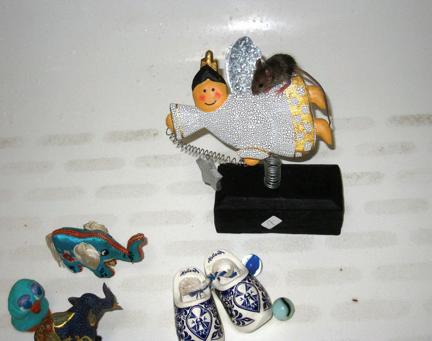
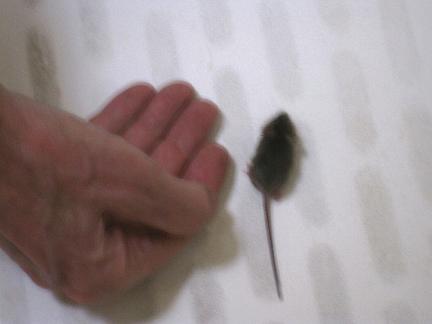
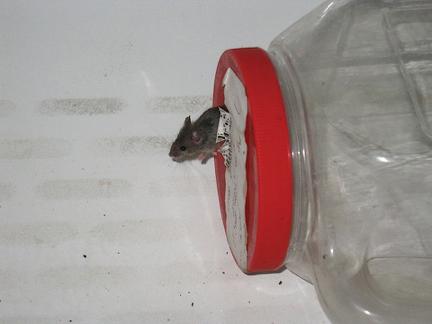

Apollo curiously looks through the opening.





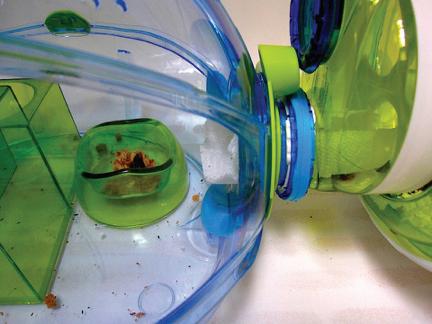
Apollo running towards her new square green house.
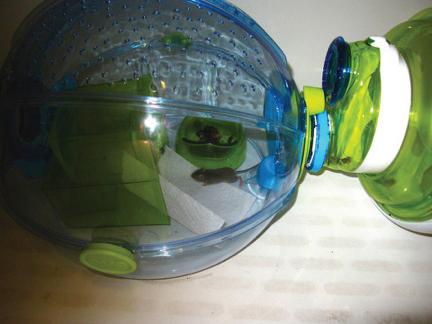
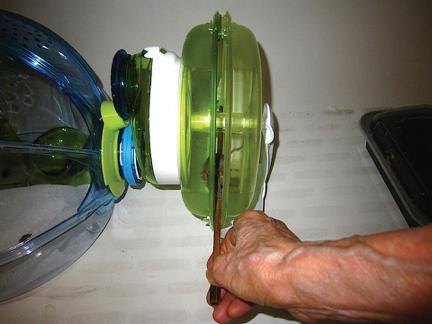
Apollo observes the world from her new green house.
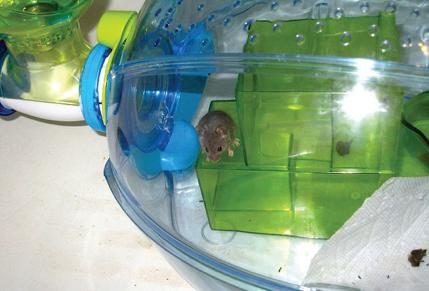
Apollo found a new tool to play with, a thin chopstick, thin enough that it goes through to the other end


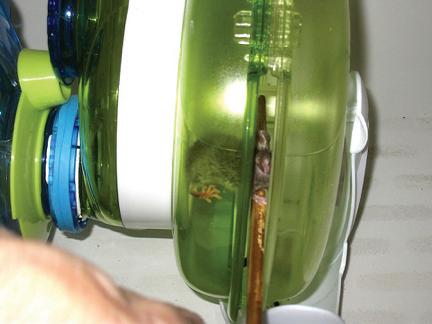
Apollo’s acrobatic skill to seesaw game.
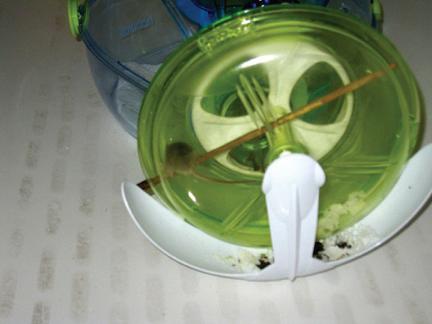

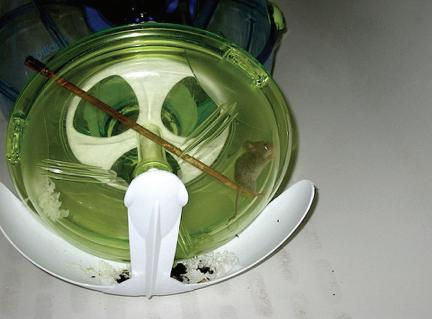
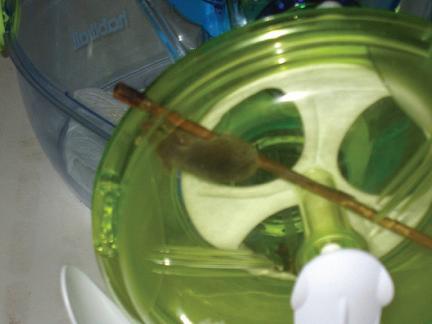
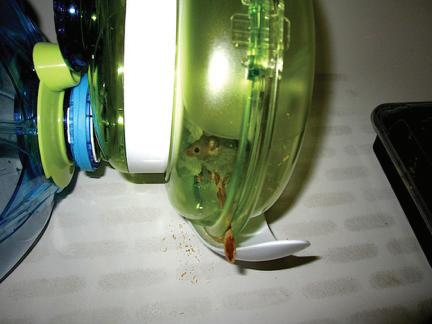

Apollo is showing off her circus skills.



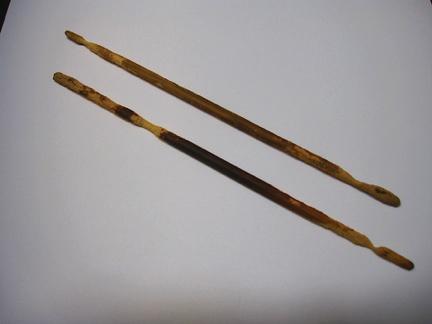

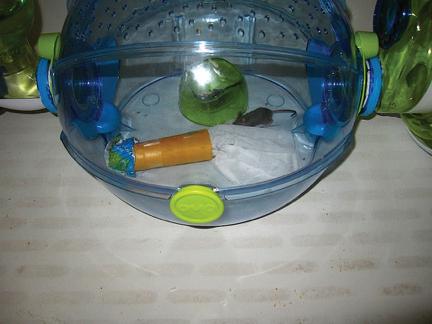
Apollo finding her new tube house, a nice and cozy hideaway with a nice paper blanket inside.
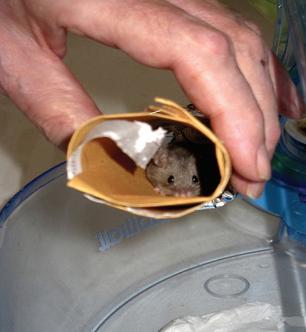

looking up after removing her shredded blanket.
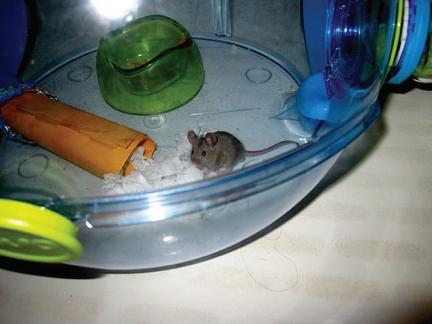

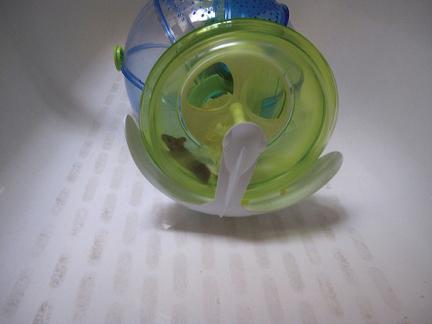
More to continue…
on Working For A Big Company All o f one’s life:
“Walking closely behind an elephant all one’s life does not make for great changes in one’s perspective.”
After noting all of the scatological art in an issue of Art Forum.
“How dull the cutting edge is! How low do you have to go to be Avant-Garde?”
on good Art:
“A good artwork, a good story, a beautiful poem, a wise man’s voice lingers longer and echoes louder to awaken our unconscious minds. They are inspirational because they are real, they are authentic!”
on
When Yuko has problems while working, like a paper jam with her printer, instead of getting mad she recites little sayings, “paper jam and paper jelly, scratch my back and rub my belly.” She does not get upset then!
At the opening of a major retrospective at the Museum of Modern Art in New York City in 1976 called “The Wild Beast: Fauvism and it’s Affinities,” a television crew was walking among the crowds interviewing people about their response to the exhibit. They spotted Yuko, who always attracted attention when she appeared at parties or receptions, and their question to her was, “Why do you think there are only male artists in the Fauve movement?”
Yuko replied, “Well...’Fauve’ means ‘wild beast’ and only men are beasts!”
Yuko said: “It is like punching Tofu. No reaction, No bouncing back response, but hearing only the unsounded voice of splashes.”
Wine is Fine
Beer is Dear
Brandy is Dandy
Gin is Sin
Liquor is Fritter and Quicker
Rice is Nice
Is Rum on Rhyme?
Sake is Forsaken
Schnapps is Snappy
Vodka is Gottcha
Whisky is Frisky and Risky

Why are limes green?
So the can hide in apple trees.
Have you ever seen a lime in an apple tree? See? It works!
Definition of a lime: A seasick lemon
How do you make a lime out a lemon? That does not get seasick?
You kiss an orange till the lemon turns green with envy.
1) A lime in time saves none
2) A lime day keeps a lemon away
3) One a lime, always a lime, but once a lemon is enough
4) To pick a lime you have to climb
5) This lime is mine, which van mime like a, lemon
6) Do not aim at a slimy lime, just claim for a prime lime
7) A frosted lime drink is called limy limeade.
It’s a crime to step on a sublime lime It turns to slime
The penalty is a dime
A grimy lime is also a crime
It’s also a dime
I’m not a lime, But that’s no crime And you’re not a lime
But that’s OK You’re prime
If you were Coffee,
You’d have to be as strong as Iron
If you were Cream
You’d have to be as smooth as silk.
If you were Sugar,
You’d have to be as sweet and Honey.
And
All I would make is perfect Strong Coffee As rich as a Rockefeller
And If you drink it
It would make you as smart as Einstein
But, some do not like Coffee
So, then,
We have to pass it on to a Coffee Lover
And a Coffee Lover Drinks it
But,
He becomes nervous and intense Keeping himself wide awake
All night and afterwards. Keeps complaining like hell
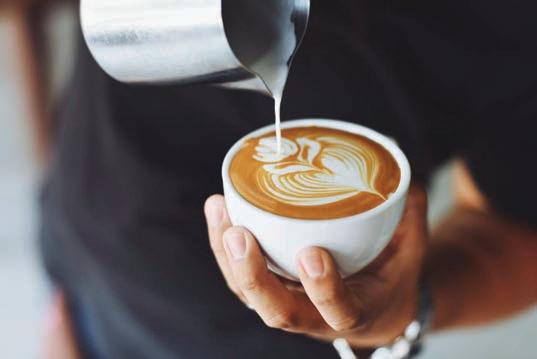
What has my mother given me, Holding me up to the blue autumn sky? Why has she given me this longing? I sense a place for me, Beyond the trembling ginkgo tree.
My love and I will walk there Arm in arm, In a moment only we understand. There will a stream gently flow past flowers, And you will caress my cheek.
His kiss the scent of ocean breeze, From spicy far flung orient gardens, From far beyond the seas.
His smile – sun drops on my eyes, Touching my heart, making it blossom.
If only I could stay here a little longer. Life is brief and fragile, One day I will be too weary, To hold onto the light.
Then we must then part my love. Should I lose you, What would I do?
Burying my face, I would cry forever.
Crossing the wide world
With a young travelers mind I will ask the stone
Only one white yacht And black shadows on the sea The moon’s quietness
Afternoon nap.
Reality or dreams?
Sound of a pine tree
One the way, alone
Gazing at the frosty sky
Pale, a lonely moon.
Continuing wind, The changeless waves of the sea Sound without pity.
This rim of the world:
One vast bluer stretch of ocean And one white bird at play.
At night waves lapping Softly at the ships side Put me fast asleep.
A letter from my parents. How long since I’ve thought of Remembering, I weep.

Once Upon A Time, We Were Together As One.
Once Upon A Time, We Played Together As a Pair.
Once Upon A Time, We Lived Together In One House.
Some Time Later, We Lived Separately In Two Places.
But We Met Each Other Everyday As If We lived Together As Before.
We Read and We Wrote Quietly, And We Sang and We Talked. We Played Together.
We Giggled and Laughed Together But Sometimes We Wept and Cried Together.
But We Were Happy. Because We Were One In Spirit.
Will We Live Together Again As Once We Did?
And Will We Be Together Forever In Silence But Much Happier This Time Than Ever?
Friendship is like a dream where you are flying through the air without knowing where you might land. But, when you do, you know for sure that you hit the bottom!
Life is too painful and only Death terminates the long painful life. Life is perpetual nightmare until Death awakens it.
I always thought that I could make a perfect round dot by myself But, I found that I was wrong! It takes two perfect ones to make that particular dot Thank you for your contribution!!
This big heart is like billions of starts It sparks me, delights me charms me, warms me and lights me. It also whispers to me In the darkest night. The difference between the heart and the stars is: the heart is only for me, but the starts are for everyone.
We fly high with joy In the infinite blue sky Forever and ever until We hit nothing!!

Where have you been? You flew from my garden, You know that's a sin! When you kindly return, I won't let you in!
Have a good day!

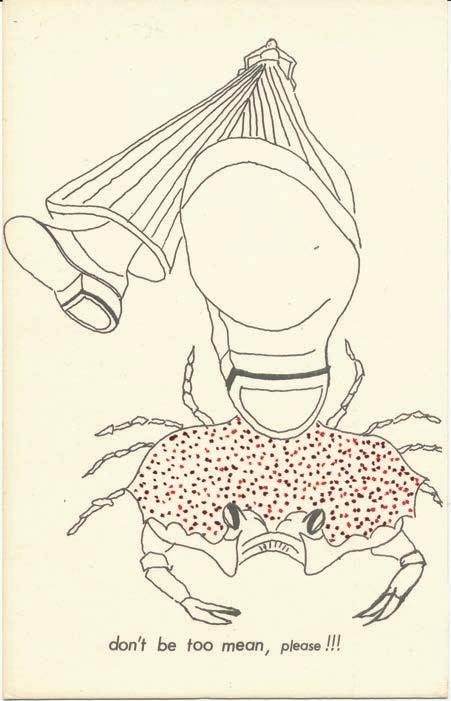
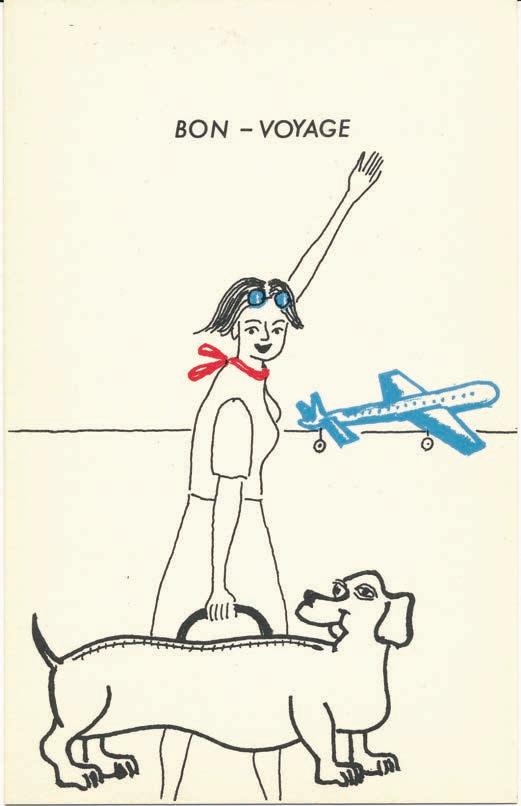
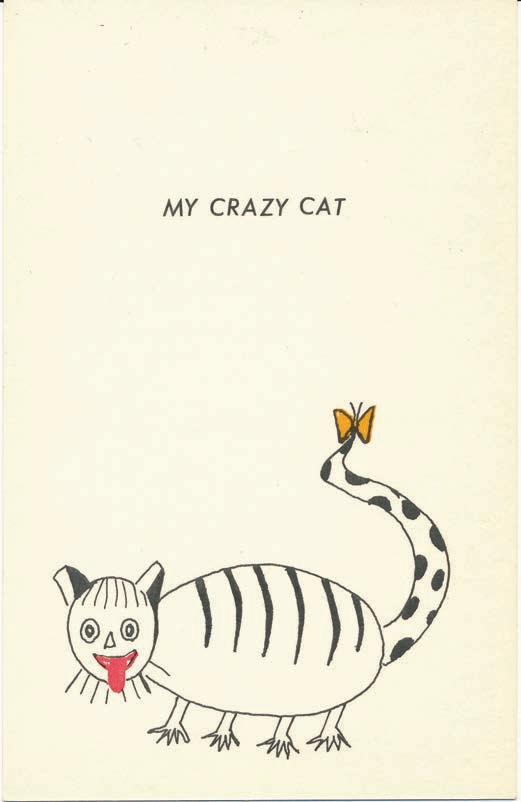
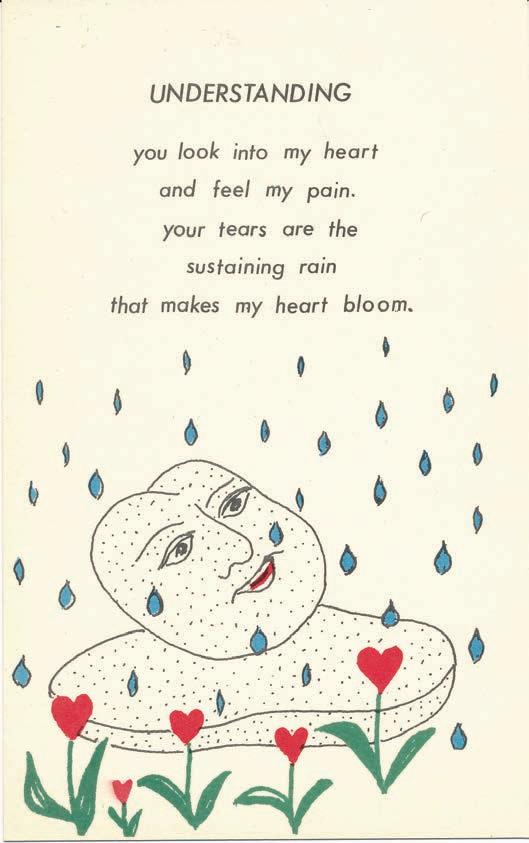
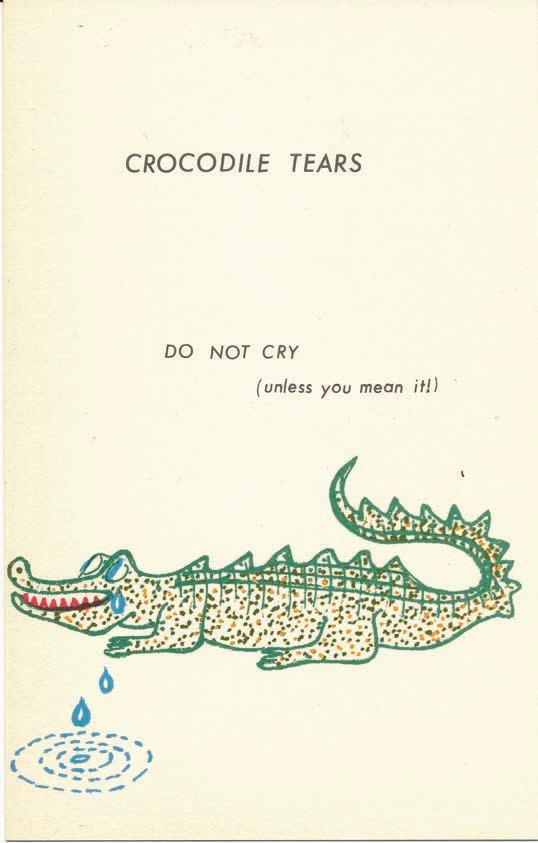


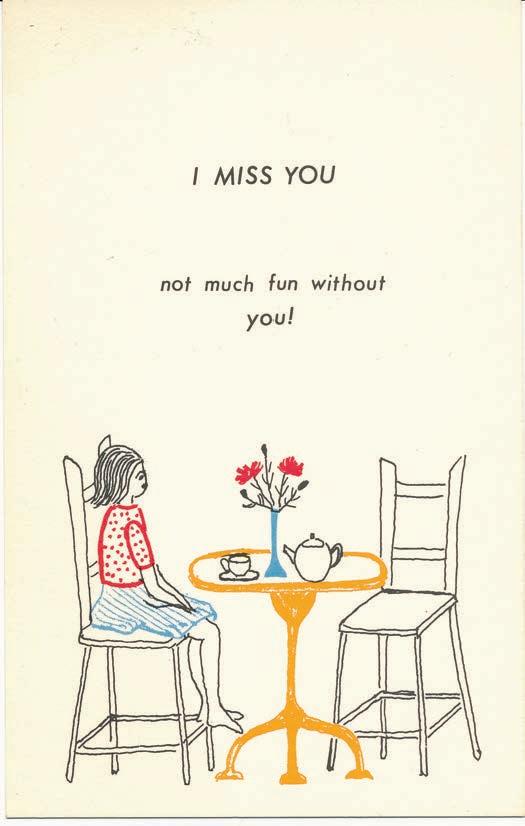

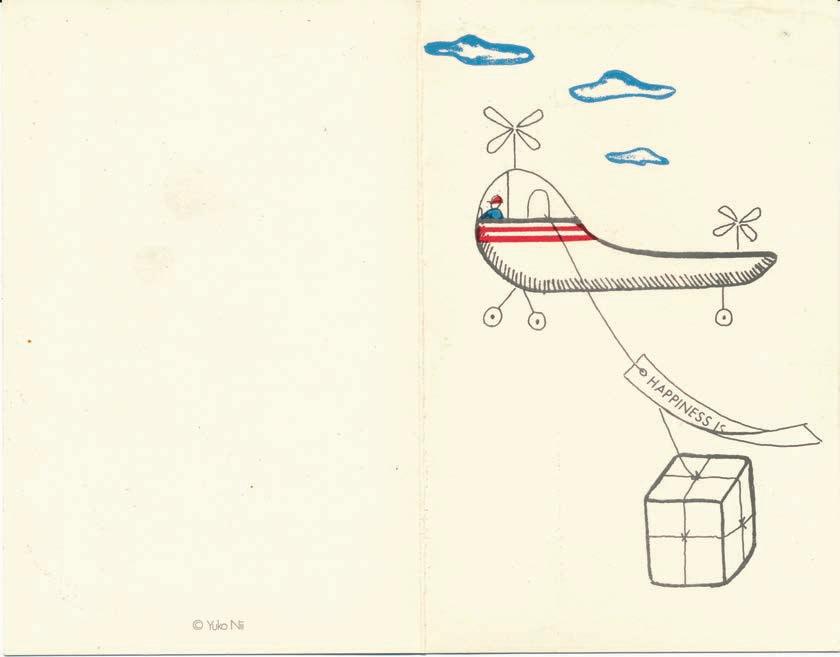
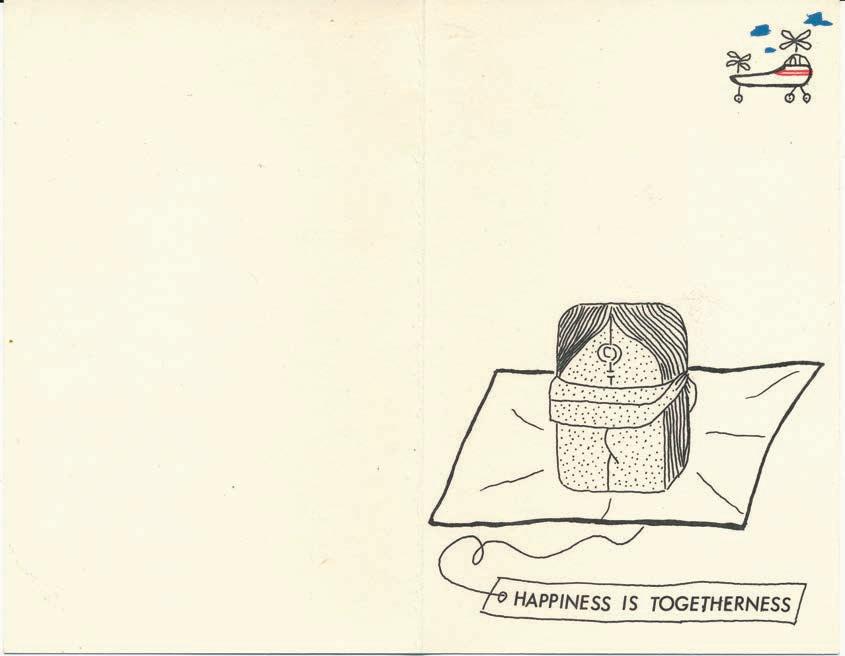

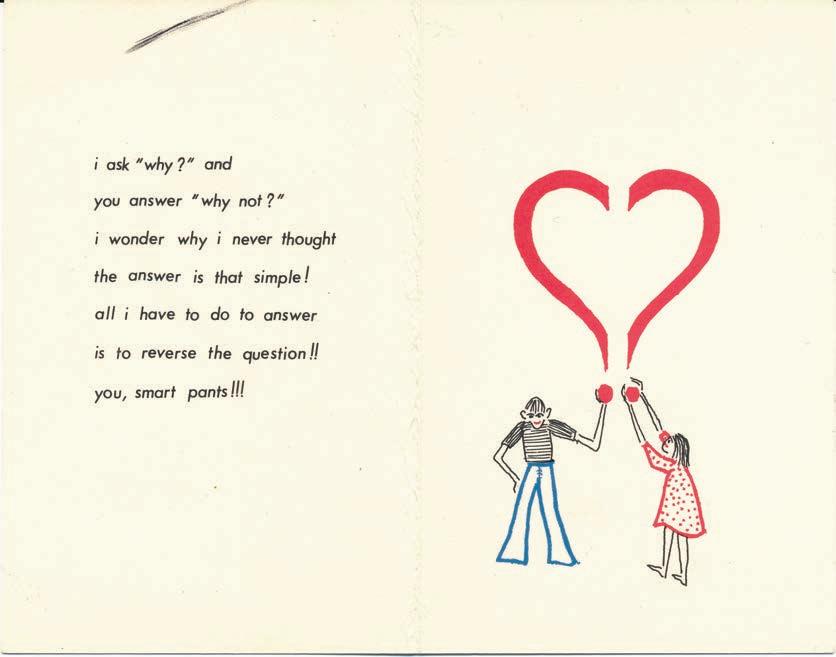
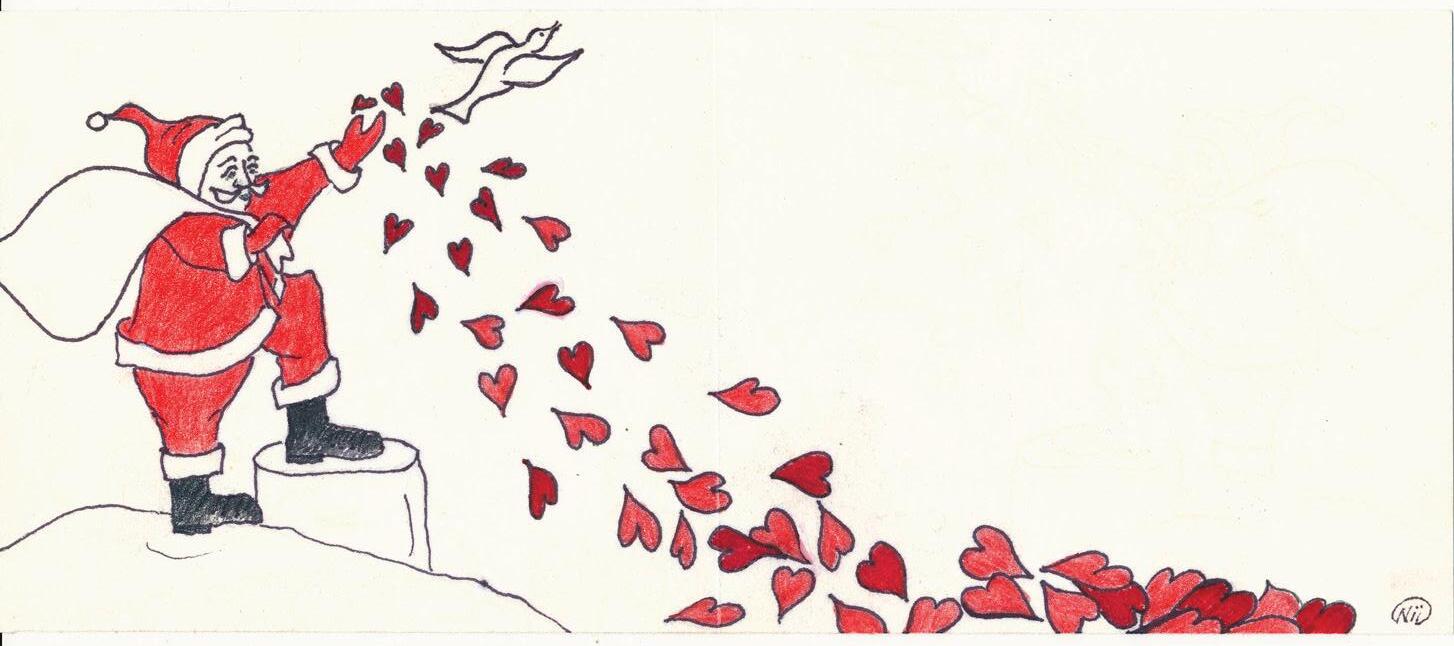


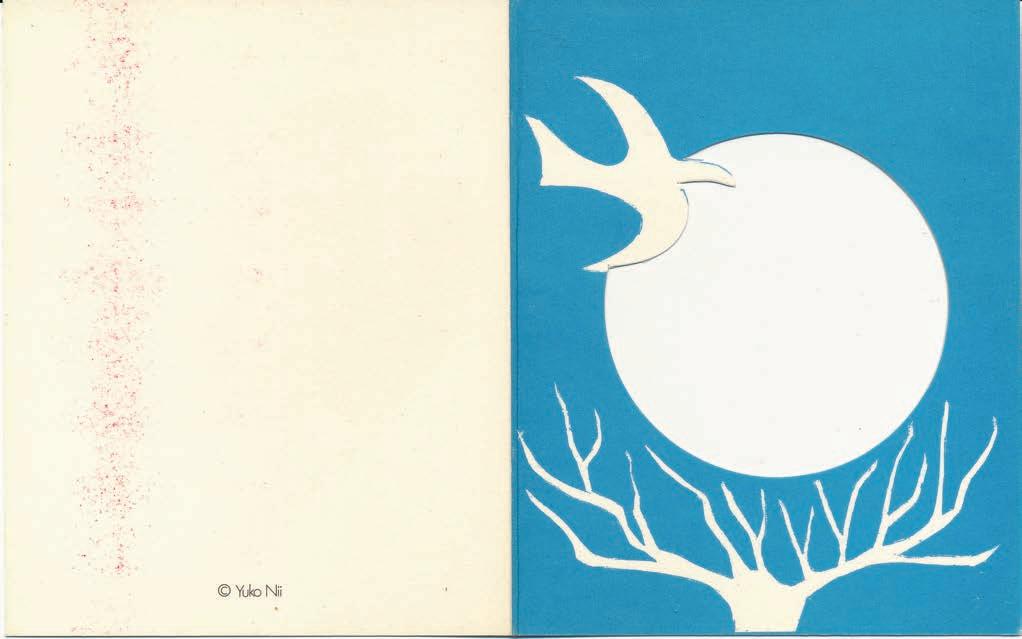
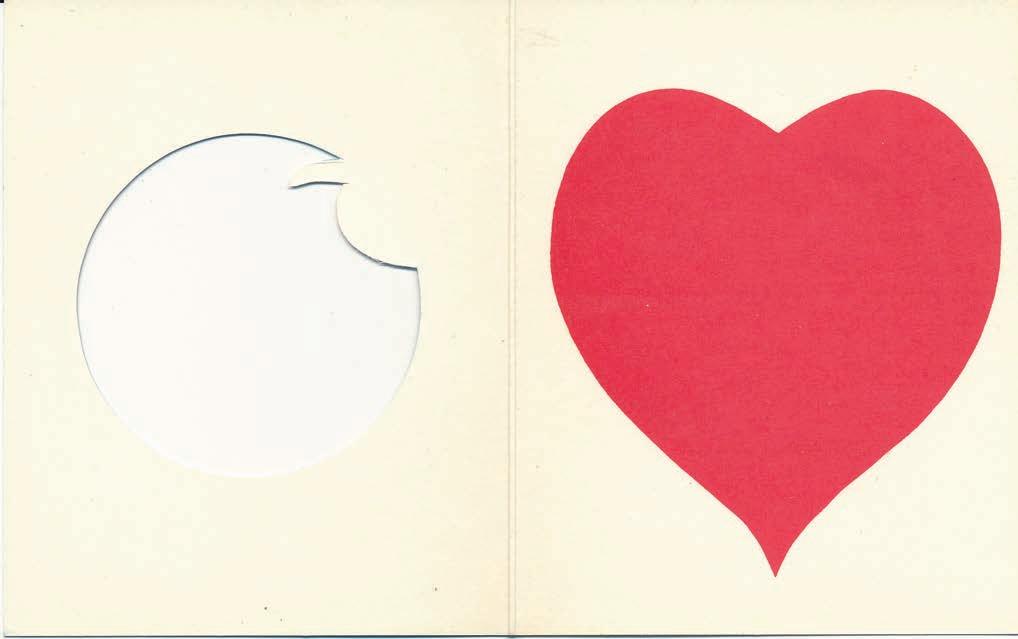
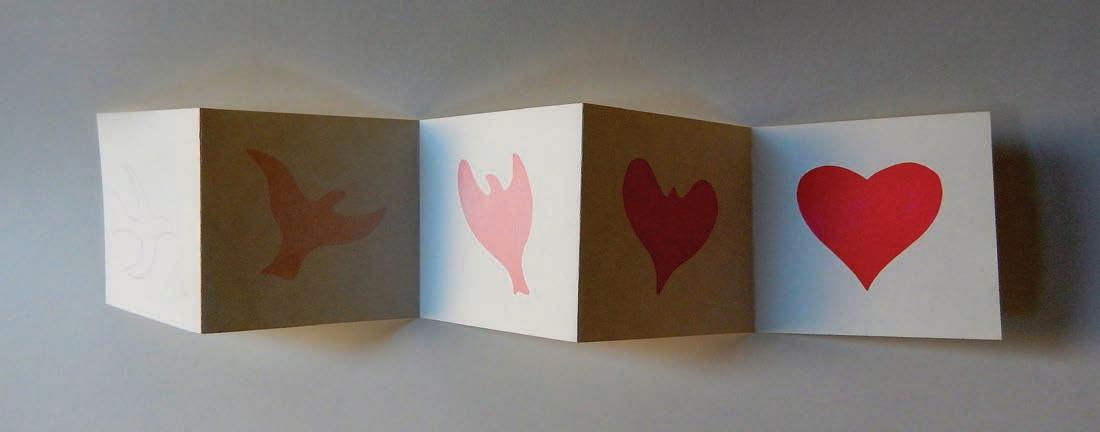

Life never repeats itself. Artwork is a historical record of the artist’s accumulated felt life that cannot be repeated. It is a personal valuable treasure that can be shared with the others visually, and the viewers receive the message about what the artist expressed on her or his canvas. That’s the time the art becomes the universal language.
I wanted to let our audience experience what I experienced (“Other Worldly Experience” as I call it) in your studio upon seeing your work. Good art has that kind of special power to bring the viewers to another world where they have never been, never seen or experienced before, and opens our mind’s eye to see, feel and think things from different angle. To me, that’s the meaning of visual art.
I do not mean to lecture you, but just want to share with you my own thought about “life” based upon my own life experiences.
Life is not as easy as one wishes. There are so many rough and tough bumps on the road, and each pump is a new challenge for us to overcome.
No matter how successful one is in his or her chosen career, a short term success doesn’t mean much. In one’s long life, while trying to achieve one’s dream, one should not forget that he or she is a human being, living in a human society with many other human being by following certain rules and social order. How you behave yourself and how you treat the others and things reflect who you are and what you think.
The saying goes, “Life without self examination is not worth living.” To look at your inner self (who you really are), and to look outside of yourself (how you see yourself in relationship with the others/the world) is the most difficult and challenging life-long challenge.
It is so difficult for most of us, but it is a worthy effort for us to make. After all what is the meaning of life? Not just to live,
but how to live...
You have a bright future ahead of you.
To her assistant:
We, human beings, are meant to make mistakes. The Almighty God made us different from God Himself.
Fred Astaire said, “The higher you go, the more mistakes you are allowed, right at the top. If you make enough of them, it’s considered to be your style.”
Founder & President of Honda Motor Co, Soichiro Honda used to tell us (his son, Hiro and me—we were very close class mates), “If you want to succeed, make many mistakes.” I’ve followed his advice ever since, but no success has come yet even at my good old age! I always wanted to tell him, “You forgot to add the important last phrase, ‘but you have to learn something from each mistake.” Now it’s too late, he’s gone!!
I just realize that his missing that last phrase was his own mistake in teaching us. And furthermore, I hate to admit my stupidity of not having learned anything from the many mistakes I’ve made in my whole life. Do I have to agree with Fred Astaire, “If you make enough mistakes, it’s considered to be your style?”
Your memory is not that bad. You got the meaning of the old Egyptian Proverb, “If you speak the name of the dead, they will come back to life.” I like it very much.
Your composer friend’s composition, “Unstruck” sounds quite interesting, although I cannot understand it well enough to appreciate the concept behind his attempt. It is a musical experience depicting the degeneration of the mind from bits of recognizable music alternating with white noise. The sections of white noise become longer, turning into complete white noise at the end.
If I listen to the music, I’m sure I’ll be astonished and maybe speechless.
In 1966, I heard for the first time John Cage’s unsound music with Merce Cunningham’s performance. It was very refreshing to listen to the unsound sounds and observe the non-movement movement. But, I somehow felt a kinship between their performance and the Japanese “Zen” concept and the Japanese “Butoh” dance. And found the fact that the experimental musician John Cage studied “Zen” and he was attempting to apply “Zen” to his music. And Merce Cunningham’s body language must have be influenced or inspired by the Japanese “Butoh” dance. This I don’t know for sure,
but there is a similarity between them.
Much Love, Yuko
“Yuko, please tell me how to make myself known in the art world?”
My answer is: It is sad, but it’s most of the time true. Great art alone does not bring any fame or success. Some other important elements help to make your art known and recognized, such as powerful commercial galleries who can promote you through major art magazines/newspapers and social media, by bringing wealthy art collectors who might like to buy your work, bringing famous art critics/writers who can write about your work so that the public will be convinced by the critics’ positive write-ups. Or if you won an award through outstanding art competitions or foundation grants, which will make you quite famous, and you will have a better chance to be invited to prestigious shows.
An artist’s fame does not come overnight. It is a slow “step by step” process just like building a brick wall.
To claim oneself as an artist is easy, but to become a known/ famous artist is harder. To be a respectful artist, and question is who is judging whose art, is the hardest.
Hi, Susan,
Thank you for your kind words and sharing your thoughts on “ambitions.”
How did you find the WAH Center or me? How well you express about the young generations of this country (and the young generations of Japan, I have to add).
Dr. William Clark’s famous words, “Boys, Be Ambitious” resonated in the hearts of minds of the young Japanese generations after the war. They were a strong encouraging force behind us that kept us going to recover out of the ashes.
Today’s young Japanese who were born during Japan’s economical prosperity periods don’t know anything about the hardships our parents and our generation have gone through. They have so many luxuries and have been spoiled by today’s easy life that they tend to take for granted everything they get! The same is true among many American youngsters. As they haven’t had a bad time after 1929’s Economical Depression, they are not as ambitious as some of people in the up and coming nations in the world.
Maybe we humans can learn (in the best meaning of the word, “LEARNING”) only from a real felt experience. In that sense, we cannot blame too much on the seemingly lazy people in America or, worse yet; those who have lost “HOPE” in life altogether...that will be the sad case!
Only “Hope” and “Faith” give us the positive energy to keep us going forward!
Hope to meet you in person someday.
With Warmest Regards, Yuko
I can almost feel vibrant energy coming out from you, penetrating into my whole being!
Halona mentioned that some people danced to your music in the previous gig, which means that some change is happening in your music. Of course, I know that nothing stays the same as all beings are changing, some slowly and some quickly, some being still, but it is also a part of change. This reminds me of what John Cage said, “the unsound is a part of sound.” Zen teaching says, “ Being and Non-Being are the same thing.” Of course John Cage was a good student of Zen teaching.
All the best to you on Sat!
Much Love, Yuko
You looked so wonderful in YUKATA. I imagined myself going through some streets in Shitamachi in Tokyo and seeing women in YUKATA cooling off with a UCHIWA in a hot summer day or evening. But, of course it is my only imagination because my going to Shitamachi had always a specific purpose, and I missed a chance to observe the daily life of the Shitamachi people. It is quite fascinating to me, because I was told that their life style is totally different from what we experienced in the Yamanote district. As far as I remember, I was taken to see beautiful fireworks on the boat on the Sumida River, to see Sumo-wrestling at the Kuramae Kokugi-kan, to enjoy Kabuki plays many times at Kabiki-za, to shop at Takashimaya and Mitsukoshi Department Stores and to visit the world famous biggest fish market Tsukiji Uo-Ichiba, to visit the Asakusa Shrine, to dine out at special Sushi/ Sashimi restaurants, to visit the Edo Bijyutsu-kan, etc. They are all natsukashi and beautiful memories to me.
Now I saw your fabric work, which is quite different from
your previous abstract paintings. I sensed in your work a mixture of nostalgic innocent girlhood sentimentality and your current stage of matured female sexuality. I wonder how you’ll develop further!
Much Love Always!
Just remember: there is nothing wrong with adjusting or changing, or postponing, or extending or even canceling the show.
Life is a constant flow of “Up and Down.” It is often beyond our control.
Only us human beings make life so rigid and stiff. If a better situation arrives, or if we come up with a better idea, we should be able to accept it as a gift from the heavens. I always believe fate is leading us in the right direction.
Thank you for your heart-warming, kind words about what I have done with Keaton and some other young artists.
I’m just doing what I’ve decided to do when I opened the WAH Center 19 years ago. But, even today I cannot be sure of myself about how well and how successfully I’ve been doing with my targeted job. But when someone like you, so dear to me, is telling me this with such kind words, I’m overwhelmed... and very thankful...because those words are sincere with a meaningful message from my sincere friend. The kind words I’ve received from time to time have been one of the strongest encouraging forces behind me that have helped me be able to keep going forward until today.
We have known each other for so many years, during which time you’ve been always kind and generous to me and to the WAH Center. Whenever I needed you, you were always there. Your presence is my security guard.”
“Hi Yuko,
Hope everything is wonderful and you are having a nice day. No worries—a lighthearted kidding nature is needed in times of pain and sadness sometimes to lighten the mood! You always make me smile even when I want to cry!”
Yuko’s response:
Bitterness, sadness, sweetness, happiness, and joy are the ingredients of life. Unless we have experienced all of these
emotions our life would be quite dull, don’t you think so?
Similarly, in Japanese cooking there are 5 basic seasonings ingredients that are essential. They are Sa (sweet from Sato in Japanese for Sugar), Shi (salty from Shio for Salt), Su (sour from Su for vinegar), Se (Shoyu for soy sauce) and So (Miso for miso).
They are listed according to light to strong flavors and it is important to follow this order. Sa, Shi, Su, Se, So is the “S” row of the phonetic alphabet in Japanese. We have 51 phonetic alphabets altogether. We use these ‘S” row when cooking the Japanese foods, because it is easier to remember to follow the order.
Now “Life and the Japanese Cooking Lesson, #1” is over…
Have a good day!
Assistant’s response:
“Thank you for your Japanese cooking lesson, I enjoyed it very much! Now I am in the mood for Japanese cuisine!
“All the best,”
Further exchange with the same assistant:
Assistant:
“Yes! That is very true! One must experience all the different ingredients of life or else there is no point. Reminds me of a Rumi poem, “The Guesthouse,” are you familiar with it?:
“My own personal understanding of Rumi’s poem “The Guest House” is that the “guests” are the emotions, feelings and experiences that we go through each day—and no matter how uncomfortable, joyous or saddening they may be we should welcome these experiences with open arms as they are fleeting and can teach us something.”
Yuko:
Your understanding of “guests” in the Rumi’s “The Guest House” is correct, not meaning “the human guests,” but “human experiences.” I didn’t misunderstand what Rumi meant by “The Guest House” in his poem.
But, just because the word, “guests” appeared, my mind stretched to the “ZEN” teaching, which also teaches about “The WAY” in life. The saying in “ZEN” is how to treat your “House Guests,” which is different from Rumi’s meaning of “The Guest House.”
But, when you think metaphorically, welcoming/accepting “guests,” either various human experiences or your human guest, it is the same thing in their teachings.
Simply because I went on “ZEN” teaching which is originated from Buddhism, my mind jumped into Christianity, which teaches the basic principal/discipline/rule in human life.
Because I tend to jump all over, I might sound like a scattered brain kid, misunderstanding everything, but I am quite orderly in my mind. Or, am I not?
Much Love, Yuko
Terry and I send you our sincerest sympathy for the loss of your dear mother. We have been always delighted to see her, her husband, and your sister attending the plays you produced and directed in the past at the Center. Your family members’ presence meant so much to us. We felt affinity with them as if they were our own supporting family members. Realizing that she is gone, and we won’t be able to see her any more, her absence will remain as an empty mark in our mind. We’ll miss her dearly.
I know that she struggled for the last few weeks as hard as her strength could sustain, and no matter how much support and prayer you and your family members have given to her, her body finally found release. God was kind enough to let her go so that she could be free from the pain and agony. Now she is blessed to be with her God and free from the burdens of life. We know that the loss of the beloved mother is the one of the worst grieving one could ever have in one’s whole life.
However, the numerous beautiful precious memories that you had with your mother for many years will be a treasure that will stay with you for all your years, and which will be a sustaining force behind you.
Time slips away when I am doing something or even when I’m doing nothing. When I’m doing something, I cannot catch time, and when I’m doing nothing, I’m not catching time! No matter what, time slips away. That was happening, that is still happening and that will happen!
Before it happens, we better nail down the time if possible. How about sometime afternoon on Tues. Nov. 5 or Wed. Nov. 6?
Let me know which day works for you!
Much Love, Yuko
I can almost feel vibrant energy coming out from you, penetrating into my whole being!
Halona mentioned that some people danced to your music in the previous gig, which means that some change is happening in your music. Of course, I know that nothing stays the same as all beings are changing, some slowly and some quickly, some being still, but it is also a part of change. This reminds me of what John Cage said, “the unsound is a part of sound.” Zen teaching says, “ Being and Non-Being are the same thing.” Of course John Cage was a good student of Zen teaching.
All the best to you on Sat!
Much Love, Yuko
15 to Yuko’s assistant
I wanted to express in front of everyone tonight my special thanks for the kind generous spirit you’ve extended to the benefit event for Japan. While all of the volunteers in the art exhibition were Japanese, I was very moved and impressed by the fact that you as a non-Japanese person joined our goodwill spirits and worked as hard as any others and as well as anyone just to make sure that the event would be a great success. While you were working two outside jobs your total commitment and dedication to my project were truly remarkable such that I cannot thank you well enough for what you have done. Your sincere concern for humanity at large was felt throughout the event.
Besides your sincere concern for humanity, your willingness and open-mindedness to challenge and learn something new from the experiences was outstanding. Forward thinking and actual hard work are the important forces behind a successful result. You seemed to know clearly or maybe intuitively why you voluntary took this heavy duty and you wanted to see how much of your effort together with the others could bring a final result in the end. There is always a good reason behind a success story. You were making your life experiences rich and knowledge deep. I appreciate that kind of positive spirits which have helped the seemingly impossible big project brought it to its fruition.
…And non-constructive talking during the working hours is a
waste of time and money. I notice that people talk too much and accomplish little during their working hours. Talk, talk, talk, and too much noise everywhere. It’s a cultural difference. It is my personal view that many people need to talk to inform the others that they exist. It seems that they cannot tolerate silence. I set a constructive discussion time as I do with Terry before he goes home. I want to do this with you toward the end of the season, which is more meaningful for both of us.
Please know I am willing to listen to anyone’s opinions or ideas openly and objectively, and take what I think is good. But it has to be done through clear understanding. I try to be direct and straightforward in dealing with anybody because I do not have time, energy, and patience to spare. It is essentially important and it is the only way for me to maintain a good healthy human relationship. I have taken that kind of simpler approach in running the WAH Center in the past 19 years. Some do not like my blunt approach, and they leave, but some appreciate it. I cannot please everyone!
18 to an assistant selecting work for a show re: “less is more” except where more is better
I was delighted to hear that you have received 15 entries, and he said that both of you agreed that it’s better to have less work shown on the wall to be able to appreciate each work closely. But, he doesn’t know how the viewers appreciated your previous show and ours with many works on the wall. As you know well enough that most of our audience do look at each piece closely and appreciate the big shows. I always observe our audience carefully whenever I sit at the gallery.
He is talking about the commercial galleries where “the less is more beautiful and more sophisticated” which was originated from the Japanese “Zen” concept. But, we are a not for profit organization, and we try to give many artists a chance to explore their talents. Those who were given a chance to exhibit their works are very proud and grateful. We have to and should support many artists who are not accepted “elsewhere” even though they have unique talents, and we have a larger gallery space than most of the galleries in the city. So we can afford to show many works in the gallery.
And the more choices the curator has, the better and richer the show one can put together.
I have this particular idea for the WAH Center, which is different from many other galleries. And especially an Open Call show is different from any shows which specially assigned curators handle all curatorial tasks.
It saddens me so much to hear such devastating news! I simply have no proper words to express my deep sympathy for all our Pratt community for this tragic incident. Luckily enough no one got injured, but the destruction of the historical building, and the water damages to the rest of the buildings and to students’ artworks are an enormous loss, beyond measure!
You and everybody concerned must have been going through one of the most difficult times in Pratt history. I still do remember when I heard 15 years ago that a fire destroyed Higgins Hall where my studio used to be and where our classes were held during my graduate study at Pratt. Then my heart broke down completely, and another tragedy is too much even for me as an alumnus. I can imagine how you must feel, having contributed so much to bring Pratt, making it as we see it today, as the most exemplary with the highest standard for arts education. You must feel unimaginable pain and sorrow.
I join with the rest of the alumnae to pray for a quick recovery so all can get back to the normal campus life.
With sincere sympathy!
You have no idea how much I appreciate your well expressed writing on your internship experiences with the WAH Center. Your insightful reflection on it is a learning lesson for me as I often lose the clear sight of how to guide our interns so that they can learn valuable lessons by adding some worthy experiences. I am not a good theoretical instructor, but I am rather a practical doer. So, what I do is to show them what and how I operate our daily activities and work with them directly.
Because the WAH Center is a small organization with just a few volunteers who help us with certain duties such as web-site manager, theater director, and technicians, WAH Salon Coordinator, but with no employees who work for specialized departments, I have to operate quite organically to accomplish whatever the necessity demands of us. So, just as I did to you because I noticed that you had a camera when you were serving at the concession, I asked you to
take some photos of the dance performance. And you did. What you showed me were amazingly great photos! I discovered your talent unexpectedly.
I always believe that the more different exposures one has, the better learning experiences one can add to enrich one’s life. You were always willing to do whatever I asked you to do, and you did everything so well. It was my great pleasure to have you as our intern and one of the WAH family members. And I’m glad to hear that you learned a lot from working with our volunteers and interns. Yes, Rebecca was my excellent assistant intern from whom you learned a lot. Terry and I were blessed to have all hardworking and intelligent interns with great human qualities. Every one of them was so dear to my heart that letting you leave us was very painful. Life keeps me quite busy as usual, but I think of you dearly and how you’ve been doing.
You mentioned that your interest was to curate a show. I have a suggestion. Why don’t you come back to us again in the fall as a curatorial intern. It is a challenging job, but it gives you a great satisfaction and pleasure. It’s so much fun to get to know artists and their artworks and you learn so much from the experiences of organizing and curating a show, including fund-raising, promotion, etc. I wholeheartedly welcome you back!
You pointed out something very important when you noticed that we are not doing too well in promoting shows and having more active programs such as artist talks, lectures, discussions, etc. We used to do all of these for each show in the past, but we haven’t done it recently. We now direct our energies fully to the things we do best and that are received most favorably by the public to everyone’s benefit, artists, audience and ourselves.
We had a full house opening of the Salon show on Jan. 27. The show looks great and everybody is enjoying the rich show. I hope you can come and see it.
After the opening Terry recited Paradise Lost and he is a great painter. And Bienvenido Banez played the piano! That was a fantastic evening program!
“And we usually have a special traditional program to which we invite a poet who recites his poems about the works in the show. This is a very unique event to which we always look forward, but unfortunately we are not going to have it this year, because the Hurricane Sandy destroyed the poet’s house and he cannot pick up his strength to come back to his normal well being. “
1) I watched the “My WAH” video, which I’m sorry to say I didn’t watch sooner. I just never had a free moment! It’s truly inspiring how far the WAH Center has come under your leadership, Yuko. I sent it on to some friends and family so they can see as well. By Richard Sanchez, 2.28.15
2) Dear Yuko,
I was so moved and impressed by the film featuring your magnificent paintings. You are so gifted. You must make time to get back to the studio. I would love to see those big paintings sometime.
I wrote a comment and left it on my Facebook. It is an honor to call you my friend. Thanks you for all the wonderful work you do for us fellow artists.
Love, Linda, By Linda Smith, 12.2.14
3) Thank you for sending this most wonderful piece. It was done so very well.
I loved seeing Yuko’s paintings which I never had. Beautiful. Mary, By Mary Wresting, 11.16.14
4) I watched “My WAH” documentary & was so inspired!!!! it is such a beautiful video & you are such a beautiful person! I had tears in my eyes watching. I posted the video to our facebook & twitter. By Rebecca Cuomo, 11.2.14
From Tokyo Japan, she studied English and American literature at Aoyama Gakuin University (1961-1963) [http:// www. aoyama.ac.jp/en/] in Tokyo. In 1963 she transferred to Macalaster College [http://www.macalester.edu/], St. Paul, Minnesota, majored in Fine Arts and earned her BFA in 1965. She attended Pratt Institute Graduate School [http:// www. pratt.edu/], Brooklyn, New York as a fellowship student, majored in painting and minored in art history and earned her MFA in 1969.
After graduating from Pratt Institute, she taught for seven years (1969 -1976) as a part time teacher of studio art and art history at a private high school in Manhattan, and she also taught woodworking in Brooklyn. She quit teaching in 1976 to dedicate herself totally to the creative fields, pursuing painting as her main career, and supporting herself as a printmaker, a graphic designer, a stage set and costume designer, a fashion designer, and as a writer in journalism (newspapers and magazines), poetry, fiction, essays and philosophy.
Even in her youth in Japan she was interested in the architecture, design and construction fields, and she learned them from observing the renovation of her own home in Tokyo and learning from her elder relatives and friends in design, and her interests stayed with her for many years.
From her early 30s, while still pursuing her painting career and a part time art teacher, Yuko wanted to have her studio away from New York City during the summer so that she could concentrate on her work in the quiet and much cooler northern part of the country.
She bought old run down buildings for reasonable prices, and renovated them with her own designs and labor, changing them into functional buildings, her studios and residences in the store front and the second floor rented out. Even after completing the renovations of the buildings, she was not totally satisfied with the environment of her summer studios. She had to look for some other places. She repeated this several times: first in Michigan, twice in Upstate New York, next in Long Island. Each time she sold the renovated property, she gained some profit. She started realizing that her wish to express her sincere thanks to her kind American benefactors might come true someday. She decided to establish her own foundation for artists in need of help.
The most recent site for herself and for some other artistin-residence buildings was Williamsburg Brooklyn, which, at the time she bought them in mid-1980s, was a ghetto with high crime rates and violence. By working closely with local
community members, officials, and the local police precinct, the area slowly began to be much safer. While walking around the Williamsburg neighborhood, she noticed an old beautiful but mysterious vacant looking building standing at the corner of Broadway and Bedford Avenue, which haunted her so much that she wanted to find out more about the building. One day she saw a “Building for Sale” sign on the window of the building. She called the contact number immediately, and she was able to get inside of the building. Her vision became crisp clear: an ideal small size museum! Having decided to put off her initial dream of establishing her own foundation, she went ahead to purchase the national and city landmark Kings County Savings Bank Building. It was in late 1996 when the area was still very distressed. Terrance Lindall came along to support Yuko’s idea to found the not-for-profit, multipurpose art center. The WAH Center (Williamsburg Art & Historical Center) was born in October, 1996. The transformation of the neighborhood increased rapidly with more artists moving in practically every day.

Chris Gray of the New York Times said in October, 2000, that the WAH Center “...has pursued a furious schedule, with symposiums, chamber music concerts, art exhibitions, juried shows, poetry series, dance festivals and related presentations.”
In the past twenty years, the WAH Center has produced over 250 fine art shows and more than 150 performance programs and events including dance, music, theater, lectures, and symposiums, involving more than 3,500 artists.
The WAH Center was started and continues even today to be as a volunteer organization, and recently began utilizing the help from college student interns. Some of the artist volunteers have stayed to help the WAH Center for over 18 years of that 20-year existence. They have stayed because of their strong faith in Yuko’s charismatic inspiring leadership. Seeing her hard working and sincere dedication for this great ideal inspired them to help.
Because Yuko’s responsibilities kept her busy, she needed an assistant to ease her heavy duties. In the fall, 2011, the WAH Center hired a part-time paid employee for the first time who started working as Yuko’s assistant, allowing Yuko to focus on the long term success of the WAH Center.
1
“A remarkable person, dedicated to the art world and her fellow artists, as well as being a fine artist herself.” —Curtis Harnack, President, School of American Ballet and Former President, Yaddo
2
“A clarity of vision and mastery of technique so characteristic of the best Japanese artists.” —Stuart C, Henry, Director, The Berkshire Museum
3
“The work of Yuko Nii carries a feeling of intensity and personal poetry. Her landscapes are in fact a landscape of her inner self.” —Tamon Miki, Chief Curator, The National Museum of Modern Art, Tokyo
4
“During 20 years of solid friendship, Yuko and I have worked on several projects together, building a bridge of the arts between Japan and the United States. She is a seriously hardworking, totally committed and great artist. Additionally she is also a free spirited, fun loving person with a great sense of humor! Because she is so well balanced and because of her creativity and energy, I have no doubt that the Williamsburg Art & Historical Center will be a great success!” —Kenneth Noland, artist
5
“I have known and worked with Yuko on various projects over the years and she is a person of great intelligence and integrity as well as a great artist.” —Robert Panza, Executive Director, Visual Artists and Galleries Association
6
“Yuko Nii’s giant contributions of energy, vision and generosity transformed almost overnight a disintegrating landmark building into a vital center for the arts in Williamsburg, a historic Brooklyn community that now enjoys the largest concentration of resident artists within the art capital of the world, New York City. Yuko’s extraordinary achievement is itself a landmark for Brooklyn and marks her for recognition as a living treasure of Brooklyn and the nation!” —Robin Radin, Harvard Law School, Program on International Financial Systems, Associate Director
7
“An exceptionally gifted fine artist, a farseeing visionary… sincerely concerned about the well being of the human race.” —Max Roach, jazz percussionist
8
“A person of great ability and integrity as well as a fine artist.” —Shoji Sadao, Honorary Life Trustee, Isamu Noguchi Museum
9
“I have known her for 20 years as a fine artist, friend and a very lively, active, and committed person who gets things going and gets them done.” —Esteban Vicente, artist
1) February 7, 1997, New York State Governor George Pataki presented Nii a “Congratulations Letter” on funding the WAH Center, which provides innovative programs and exhibitions by turning the historic Kings County Savings Bank into a multipurpose arts center that serves the need of artists and art aficionados of diverse backgrounds. Presented by Assistant to Governor, James Barcia.
2) March 26, 1998, Brooklyn Borough President Howard Golden named Nii one of “Brooklyn’s Women of the Year” for her “unparalleled devotion to her art and commitment to the artist community of Williamsburg/Greenpoint.” And he said that the WAH Center’s activities have resulted in “tremendous cultural and economic activity throughout the northern Brooklyn area, an area recently designated as an ‘historic district’ and an ‘economic development zone.’”
3) March 8, 2001, New York State Governor George Pataki named Nii one of “New York State’s Women of the Year,” and awarded her, honoring her as a “Woman of Excellence with Vision and Courage.” He also congratulated Nii on turning the historic Kings County Savings Bank into a multipurpose art center that serves the needs of artists and art aficionados of diverse backgrounds.
4) March 13, 2003, Brooklyn Borough President Marty Markowitz gave Nii the “Betty Smith Arts Award” for her dedication to the preservation of the rich artistic and cultural community of Brooklyn.
5) March 13, 2003, New York City Councilwoman Tracy Boyland gave Nii the “Outstanding Citizen Award” for her being worthy of the esteem of both the community and the great City of New York.
6) May 29, 2008, during Asian Heritage Month, Brooklyn Borough President Marty Markowitz gave Nii the “Asian Cultural Award” for her “dynamic leadership and demonstrating outstanding commitment to the betterment of our community.”
7) July 31st, 2008, the official Brooklyn Historian, John Manbeck, said in an article in the Brooklyn Eagle, “Art in Williamsburg has made great strides. In fact, all Williamsburg has progressed undoubtedly because of its attraction to artists. Much of the credit must be placed on the doorstep of the director of the Williamsburg Art and Historical Center, Yuko Nii. The Center operates out of the former Kings County Savings Bank Building (1867) and celebrated an infusion of a $500,000 capital funding grant from the city.”
8) February 16, 2009, New York State Governor David
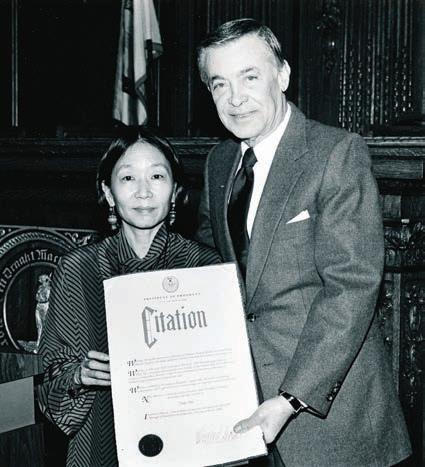
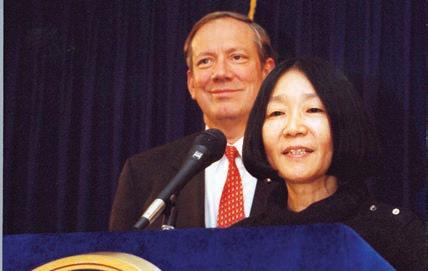

Paterson named Nii one of New York States’ “Women of the Year” and awarded her for “being an influential role model who made historical contributions to the growth and the strength of the nation.”
9) March 7, 2009, New York City Mayor Michael R. Bloomberg presented Nii a proclamation on the occasion of her “Women Forward” art exhibit, recognizing “the invaluable contributions of women artists by broadening women’s opportunities in the arts and creating new possibilities.”
10) June 19, 2011, Brooklyn Borough President Marty Markowitz presented a “Proclamation” congratulating Nii on the success of the important fundraising event, “Artists Rescue Team for Japan” for the victims of the earthquakes, the tsunami and the Fukushima nuclear plant disaster in Japan on March 11, 2011, and thanking her for allowing all to enjoy the vast richness of the arts community and raise a culturally-aware family.
11) October 27, 2012, Brooklyn Borough President Marty Markowitz congratulated Yuko Nii on “The 16th Anniversary Grand Harvest Celebration,” noting that “The WAH’s local, national and international programs have inspired, educated and entertained the public at large, and have demonstrated how a single organization can play a transformative role. It is due to the many outstanding organizations such as the WAH Center that Brooklyn now stands as the cultural capital of the nation.”
12) March 21, 2013, Pratt Institute President Thomas F. Schutte and the Office of Alumni Relations awarded Nii Pratt Institute’s 2013 Alumni Achievement Award, specifically the “Community Commitment Award” as one of the Pratt Institute’s outstanding graduates who have “distinguished themselves in their fields, having earned a high degree of respect among their colleagues and the general community, and whose impact has been felt on a regional, national or international level. Credit should be placed on the doorstep of the director of the Williamsburg Art and Historical Center, Yuko Nii. The Center operates out of the former Kings County Savings Bank Building (1867) and celebrated and infusion of a $500,000 capital funding grant from the city.”

5) March 13, 2003, New York City Councilwoman Tracy Boyland with the “Outstanding Citizen Award”
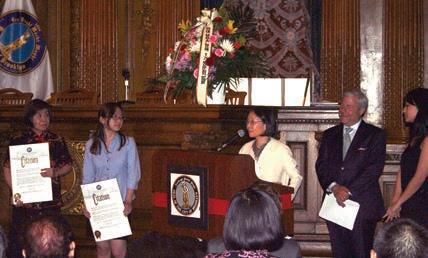
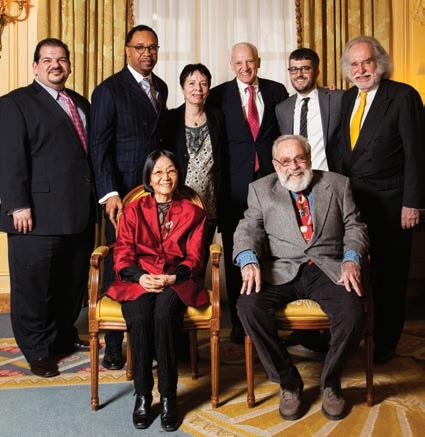
Yuko’s creative activities include painting, printmaking, graphic design, stage set, costume and fashion design. She distinguished herself also as a writer in journalism, poetry, fiction, essays and philosophy, publishing a book with Terrance Lindall, entitled Blue Eyed Satori, and writing for newspapers and magazines.
Nii’s work has been shown at numerous museums, art galleries and universities in the USA and Japan, including one person shows at the Berkshire Museum, Massachusetts; Fairleigh Dickinson University, NJ; International Monetary Fund, Washington DC; Ginza Kaiga-kan, Tokyo; and including many group shows in such venues as the Brooklyn Museum, New York; the Bronx Museum of Art; New York; the Hudson River Museum, New York; the Parish Museum, Southhampton, New York; the World Trade Center, New York; Lincoln Center, New York; and the United Nations General Assembly Building, New York.
Nii’s works are in public and private collections including those of the Cincinnati Art Museum, the Berkshire Museum, the Alternative Museum, Equitable Assurance Collection, JP Morgan Chase Bank Collection, Bankers Trust, Security Pacific Bank, N.L. Industries, the U.S. Army Corp of Engineers, Bony Corp., Nihon Davis Standard Corp., and many outstanding public and private collections.
Nii’s works are included in a number of publications, including Looking at Landscapes (Criterion Press) and she has been reviewed often in publications including the New York Times, the Chicago Tribune, and many newspapers. She has appeared on several television and radio programs here and in Japan.
Nii was an advisory panelist for the 1978 CAPS Grants under the Cultural Council Foundation of New York City and JPMorgan Chase 2007 Regrant Program. And she was twice (in 1981 and 1983) an artist in residence at Yaddo in Saratoga Springs, New York.
Nii’s “Friends and Mentors” belong to an established circle of the international art world, and include Jack Lenor Larsen (textile designer), Isamu Noguchi (sculptor), Toshiko Takaezu (ceramist), Ansei Uchima (printmaker and painter), Toshiko Uchima (collagist and box assemblage artist), Esteban Vicente (painter and collagist).
Nii’s “Personal Close Artist Friends” (some since the 1960s) include Siah Armajani (conceptual artist, sculptor), Doug Beube (book artist), Lili Bita (poet and performer), Riv Bulgari (painter & sculptor), Gulsen Calik (multimedia artist), Judy Chicago (installation artist, painter & sculptor), Mark
Daniel Cohen (writer & art critic), Beatrice Coron (book artist, papercut artist & public artist) Amin Gulgee (sculptor, jewelry designer, & performer), Karen Gunderson (painter), Samia Halabi (painter), Hillary Harris (filmmaker), Kunio Iizuka (painter & printmaker) Leon Kirchner (composer), Terrance Lindall (painter & philosopher), Kazuko Miyamoto (minimalist artist & owner of Gallery Onetwentyeight), Naoto Nakagawa (painter), OLEK (yarn artist), Max Newhouse (new media artist), Kenneth Noland (painter), Faith Ringgold (painter, quilter, sculptor, & performer), Max Roach (jazz percussionist), Jack Roch (painter), Douglas Safranek (painter), Kenjiro Sasaki (painter & writer), Masaaki Sato (painter & printmaker), Jeff Shapiro (ceramist), Linda Stein (sculptor & founder of Have Art: Will Travel! Inc.), Petar Talijancic (filmmaker), Robert Zaller (author & playwright), and some more.
Nii is listed in Marquis’ “Who’s Who in America,” “Who’s Who of American Women,” and “Who’s Who in the World.”
In late October, 1996, Yuko Nii purchased a New York City Landmark Kings County Savings Bank and founded the non-profit WAH Center (Williamsburg Art & Historical Center) based upon her “Bridge Concept.” That concept envisions a multifaceted, multicultural art center whose mission is to coalesce the diverse artistic community, and create a global bridge between local, national and international artists, emerging, mid-career and established artists, and artists of all disciplines. Thus through the international language of art we come to understand each other to create a more peaceful and integrated world. The WAH Center is a force for peace and understanding and its concept is incorporated in its acronym: “WAH” in Japanese means “peace” or “harmony” or “unity.” Yuko Nii also wanted to preserve the WAH Center’s building, a French Second Empire masterpiece built in 1867, a New York City Landmark that is also on the National Register of Historic Places, and she wants to make it a functional part of the cultural community of Williamsburg, Brooklyn, New York.
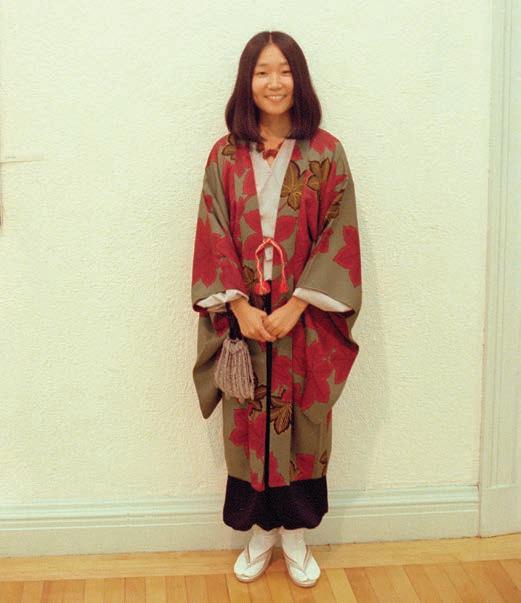
Yuko Nii finally achieved her initial dream to establish her own foundation, which had been postponed, because founding the WAH Center to pursue her envisioned mission had become her priority (immediate need). While the WAH Center’s mission is to “present” art programs to the public, the mission of the Yuko Nii Foundation is to hold, maintain and preserve the contemporary art and the historical artifacts and properties, including the landmark building, which Yuko purchased in 1996 and later donated to the foundation in 2008. The YNF loans the art and artifacts in its permanent collection to other institutions such as museums, galleries and art organizations for their special exhibitions.
The WAH Center’s permanent collection was transferred to the foundation’s permanent collection. In 2009 the WAH Center presented to the public the permanent collection show in two parts from October to December. It was a rich, panoramic show of excellent contemporary artists.
The WAH Center is planning on the next “Permanent Collection Part 3 & 4” shows in the near future. A full color catalogue will accompany the exhibition.
Yuko has pursed her wish to establish a permanent collection as an important historical record of the constantly changing artistic climate of the contemporary New York art world. Thus, she started acquiring contemporary works in 1998, mainly from the exhibitions held at the WAH Center,
and also works not exhibited at the Center but donated by our generous friends. And while many works are from artists in New York City, the collection also has works by artists from across the United States and abroad. Yuko is most thankful to have received so many works donated by generous artists, working professionals of high talent, some who have been already recognized, having had wide exposure in the New York art world and beyond, and some who have started receiving recognitions since they had their first exhibitions at the WAH Center. Yuko follows the progress of these artists’ careers with great interest. She is especially delighted and honored to have works by some particularly outstanding artists who are highly respected in the international art world such as Ilya Bolotowsky, Judy Chicago, Yayoi Kusama, Faith Ringgold, Jerry Rudquist, Toshiko Takaezu, Ansei Uchima, Toshiko Uchima and more.
The collection has increased gradually over the years to more than 700 artworks.
First Floor, reception Hall
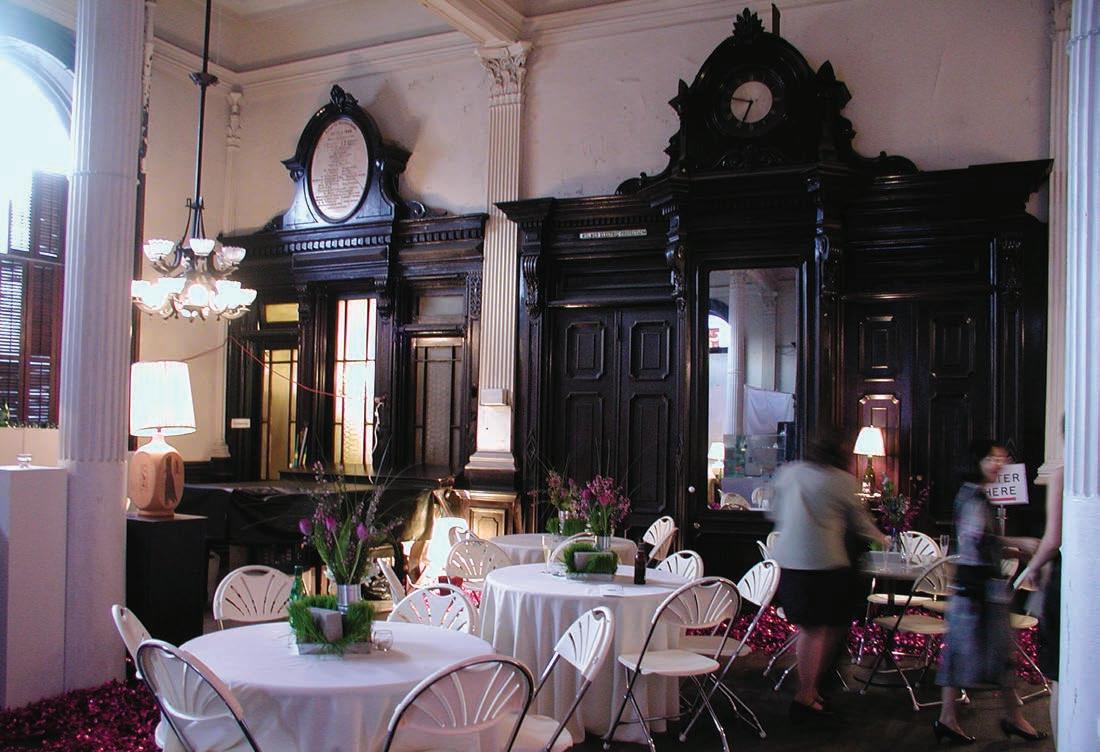
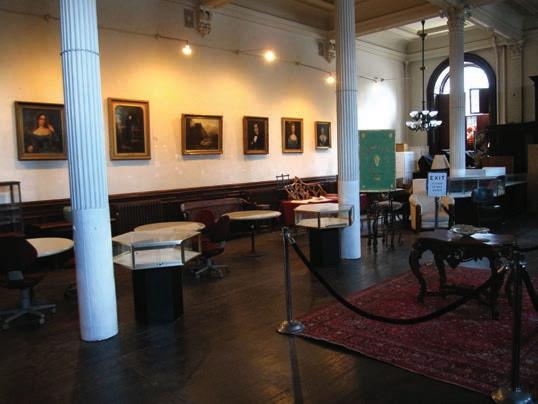

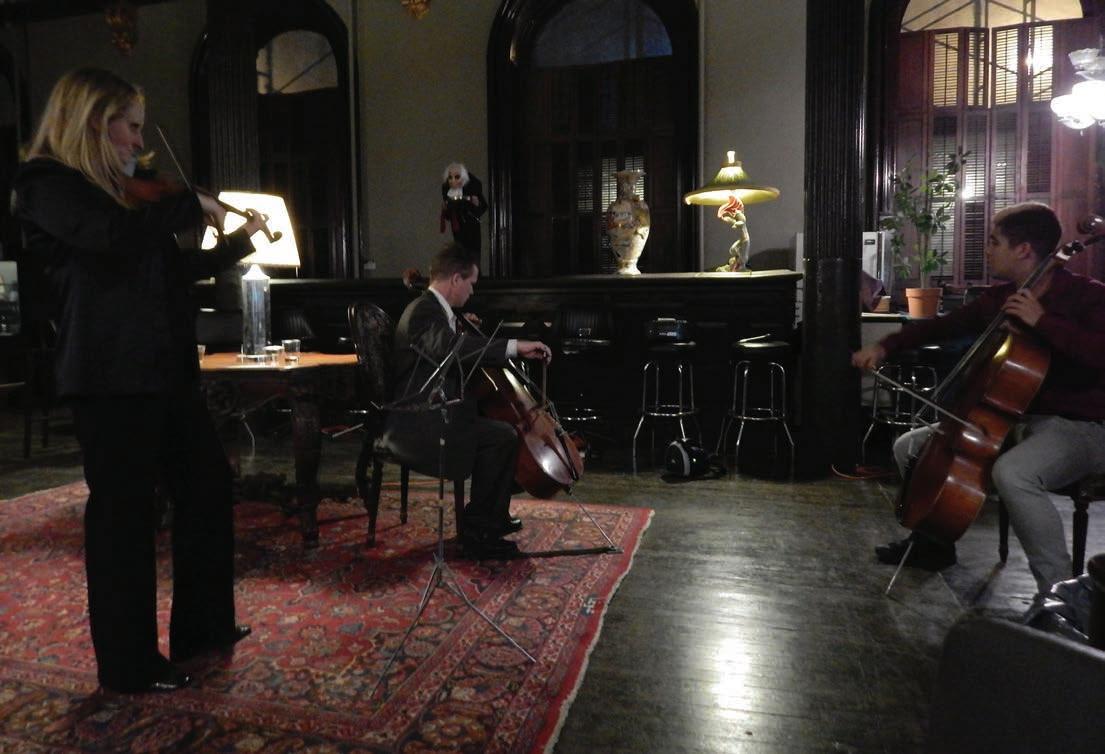
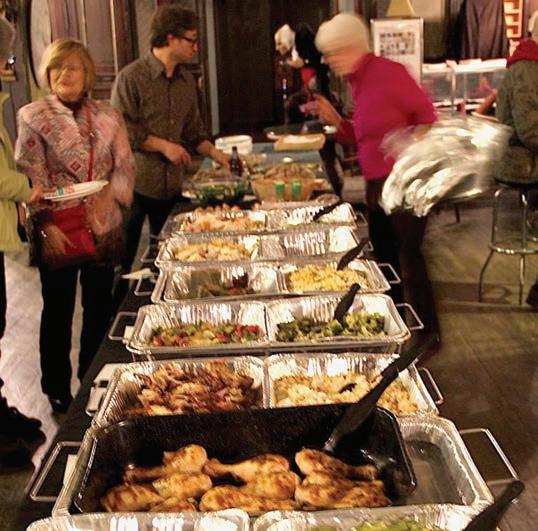
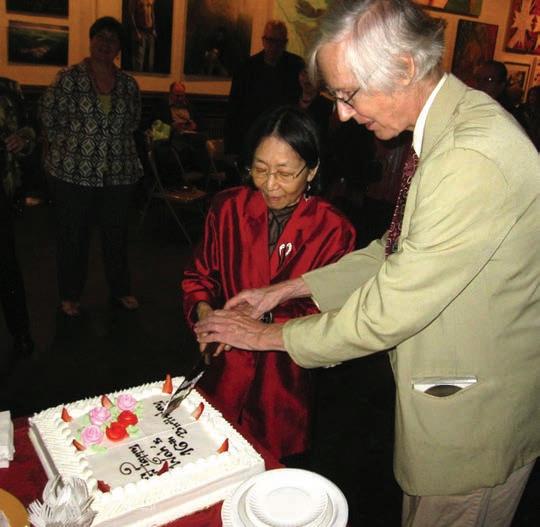
Second Floor, Art Exhibition Space
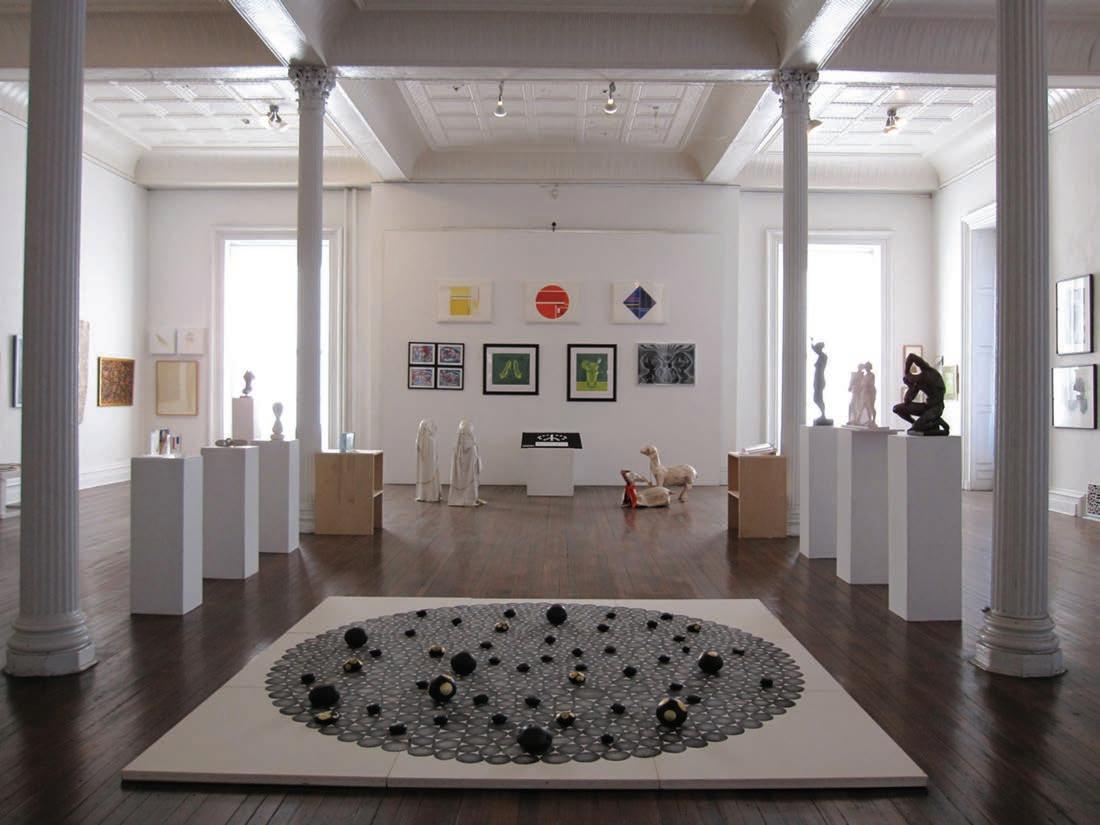
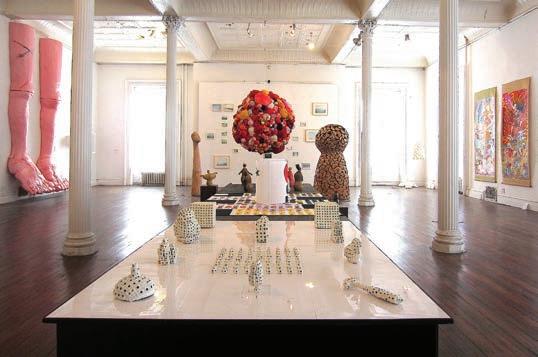
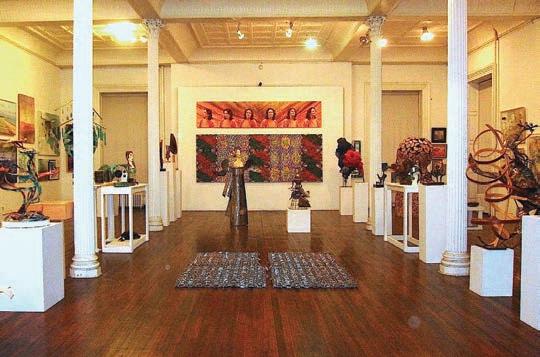
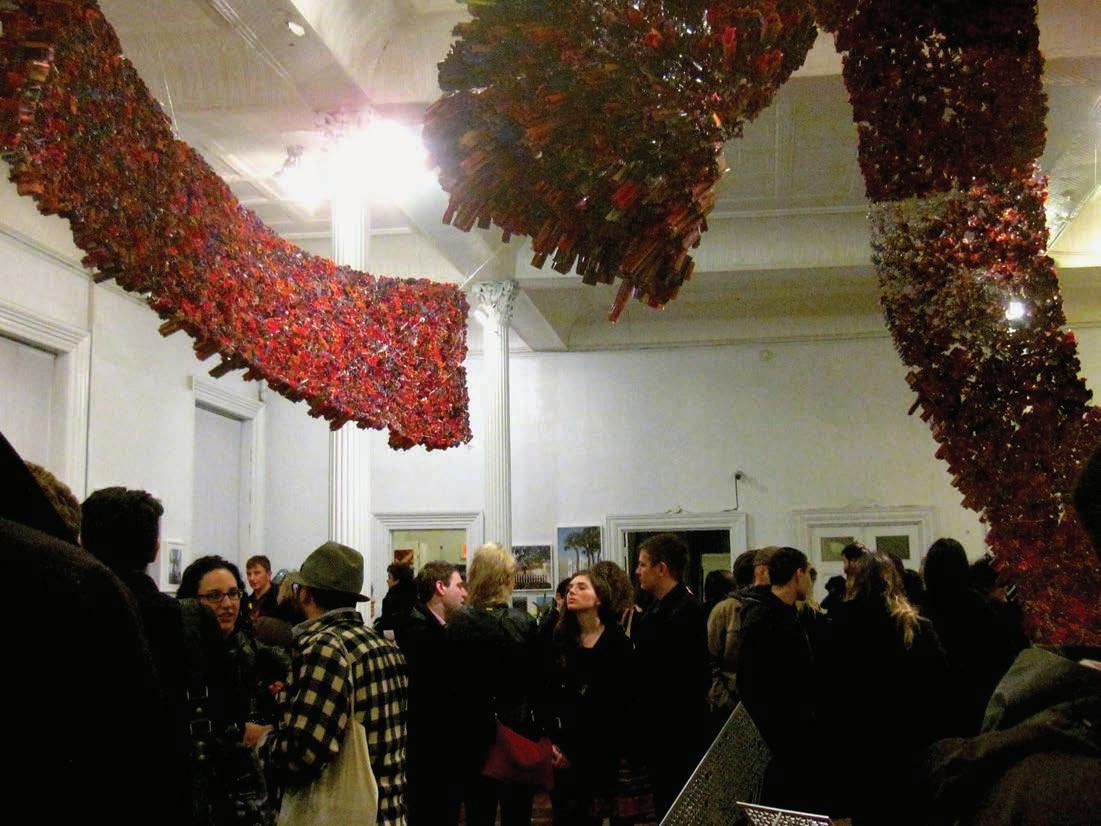
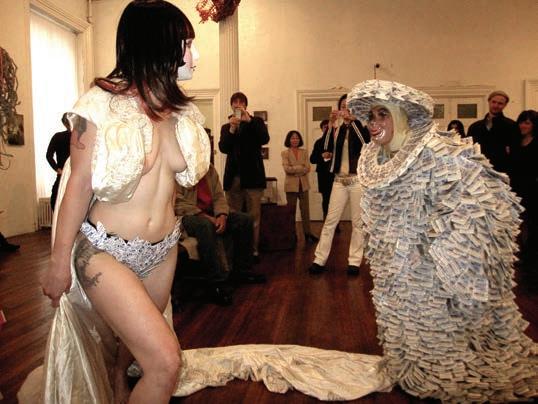
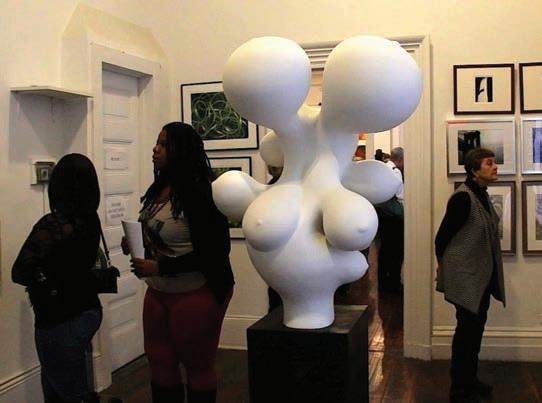


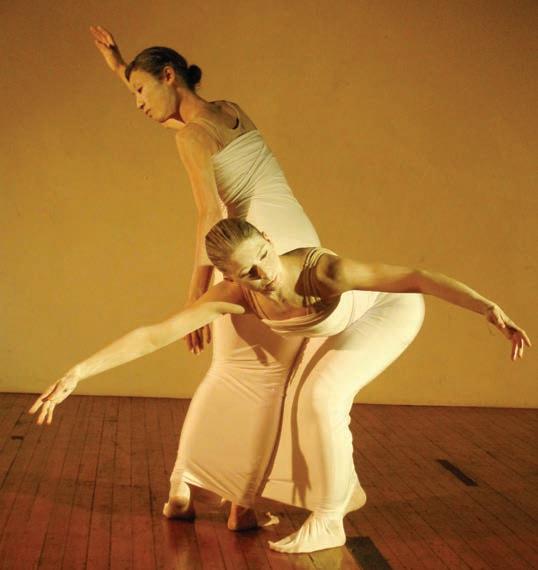
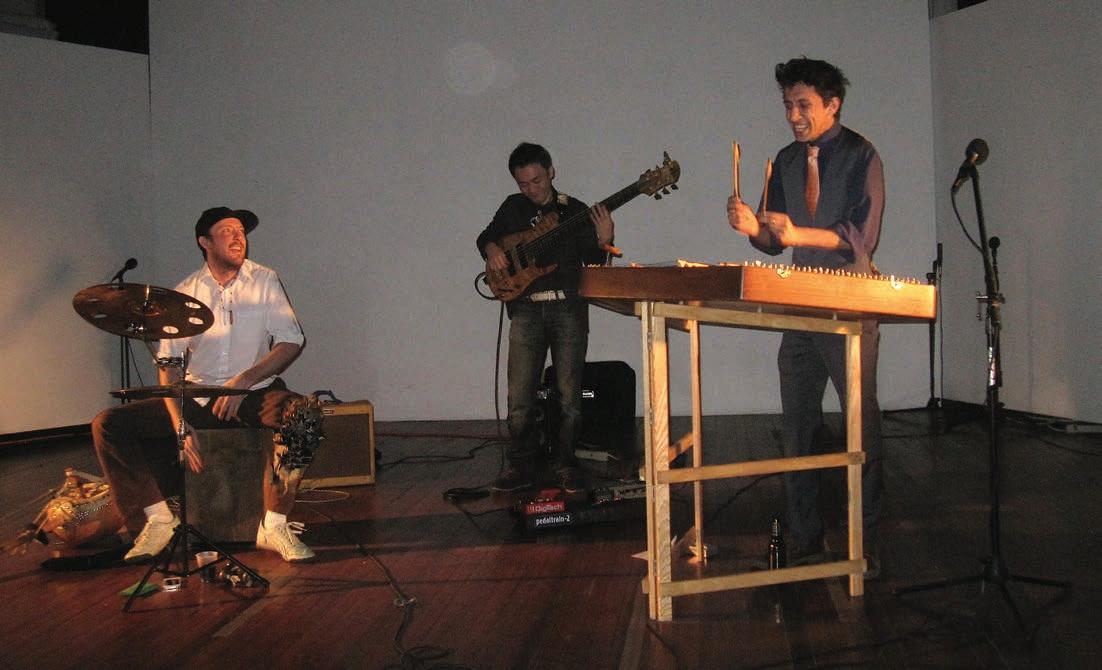

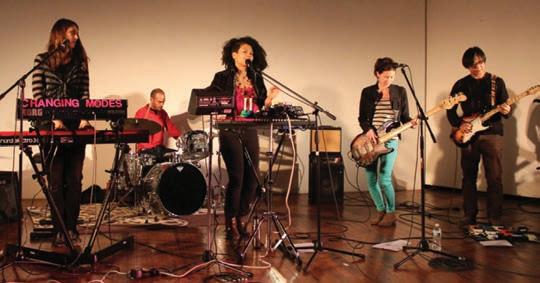
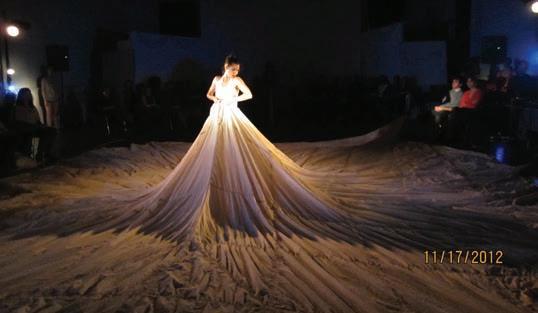
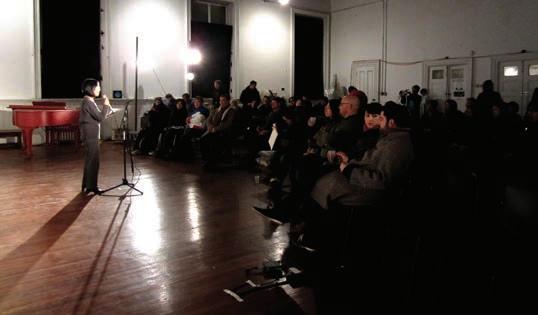
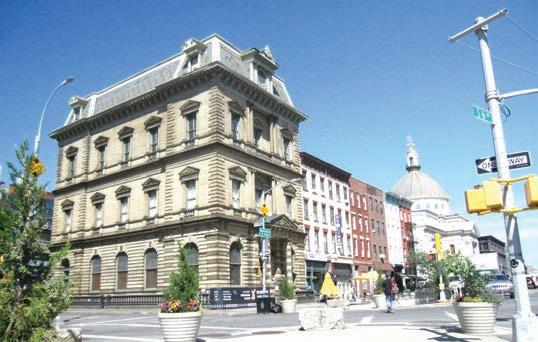

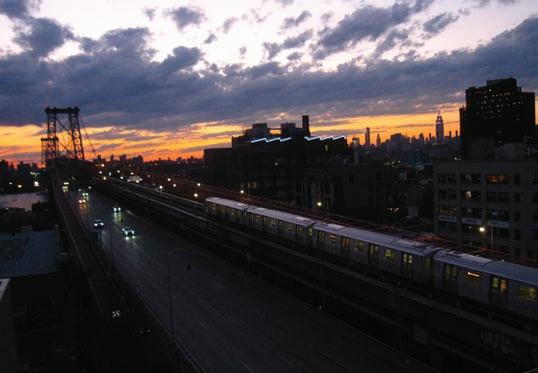
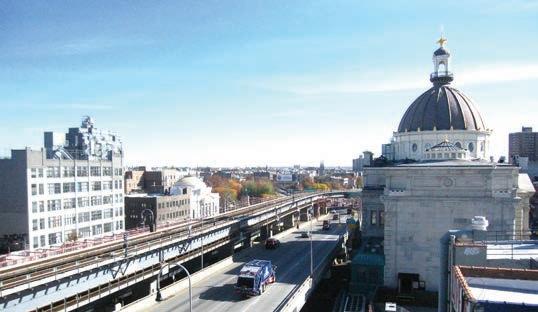
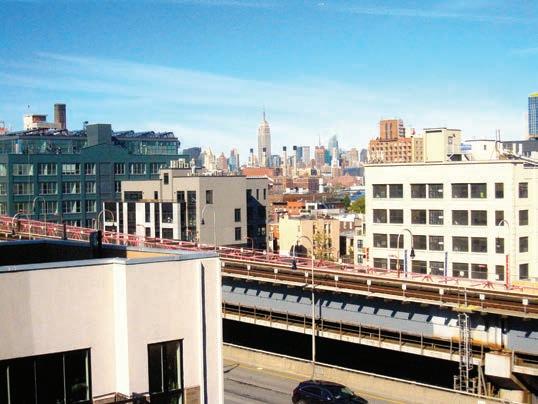
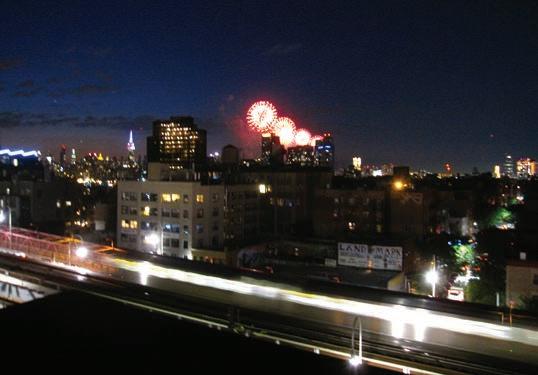
Members and friends may support the WAH Center in a number of ways. The most common forms of giving is outright gifts of cash and securities, but there are other types of assets that may be donated, as well and planned giving options that have favorable financial and tax benefits. Today planned gifts are more important than ever to the WAH Center’s stability and future success. The term “planned giving” refers to any major gift that involves financial or estate planning. Such gifts can provide important benefits both to you and to the WAH Center. The different types of planned gifts include bequests, life income plans (charitable gift annuities and charitable remainder trusts), charitable lead trusts, gifts of life insurance policies, and gifts of tangible personal property. We would be pleased to work with you and your advisors to structure a gift that best fulfills your charitable goals. Before making a gift to the WAH Center, you should consult with your financial, tax, and legal advisors for a thorough analysis of your individual situation and the tax consequences and to decide which of these ways of giving might work best for you.
Please contact us at 718-486-6012 or email us at wahcenter@earthlink.net or write to WAH Center, 135 Broadway, Brooklyn N.Y. 11211 USA.
Many thanks to the following for their generous support:
Former Brooklyn Borough President Howard Golden, Former Brooklyn Borough President Marty Markowitz, Former New York State Governor George Pataki, Former New York State Governor David Paterson, Former New York City Mayor Michael Bloomberg, Former NYC Councilman Ken Fisher, NYC Councilwoman Tracy Boyland, NYC Councilwoman Diana Reyna, NYC Landmark Commission, New York Landmark Conservancy, New York Foundation for the Arts, NYC Department of Cultural Affairs, New York State Council on the Arts, Asian Cultural Council, Brooklyn Arts Council, Brooklyn Historical Society, Consulate General of Japan, Consulate General of Denmark, Milton & Sally Avery Foundation, George Backer Family Foundation, Dorothy Levitt Baskind Foundation, Fifth Floor Foundation, Independence Community Foundation, Mandelbaum Foundation, Peco Foundation, Tamarack Foundation, Joseph Donnor Charitable Trust, Gillespie Global, New York Community Trust, Dime Savings Bank, Greenpoint Savings Bank, Signature Bank,
British Petroleum Corp., Verizon, Crest Hardware, Materials for the Arts
Many thanks to the major individual contributors for their generous financial support: Paul Axelrod, John Geraghty, Dr. Horace Jeffery Hodges, Reginald & Lois Howard, Amanda Husberg Dr. & Mrs. Arnold Lindall, Terrance Lindall, Ted Matsumoto, Hubert & Susi Neiss, Satoshi & Chieko Nii, James Nolan, Barbara Radin, Robin Radin, Franyo Shindler, Anju & Yoko Uchima, Bradley & Jania Vanderwerff, Dr. Robert J. Wickenheiser, Jay Weinstein, CY Wilder, and many others.
Many thanks to the following for their generous support by donating their delicious foods and drinks to our special events: Brooklyn Brewery, Roebling Wines & Liquors, Japanese restaurant Samurai Mama, Japanese restaurant Zenkichi, Italian restaurant Patrizia’s, Thai restaurant Amarin Café, Thai restaurant Khao Sarn, and others.
Many thanks to the following for supporting our exhibits by collaborating or lending works to make them very special:
Dorian and Jeff Bergen at ACA Galleries, Kathryn Buck at PPA (Pictorial Photographers of America), Katherine Griefen of A.I.R. Gallery, Eli Kline at Sun Kline Gallery, Heidi Lange of DC Moore Gallery, Jack Lenor Larsen, Crystal Cooper & Miry Pak of Cowran and Tout, Larsen Design, Powen Lee at Powen Lee Gallery, Melissa Lujian of El Museo del Barrio, Jonas Mekas of Anthology Film Archives, Shoji Sadao, Executive Director of the Isamu Noguchi Foundation, Hazel Santino at Thomas Barr Dodd at BFP Creatives, Kyoko Sato (Independent Curator & Producer), Hiro Shiraishi at Pepper Project, Aroon Shivdasani at Indo-American Art Council, Toshiko Takaezu and the Charles Cowles Galleries, Leslie Tonkonow of Leslie Tonkonow Artworks + Projects, Anju & Yoko Uchima, Harriet Vicente & Ameringer Howard Gallery, Doug Beube, Beatrice Coron, Steven David, Eric Ginsburg, Liberty George, Jerry Rudquist, William Wegman, and others.
Special thanks to the following local gallery directors who extended their warm friendships: Randall Harris at Figureworks, Paulien Lethen at Holland Tunnel, Richard Timperio at Sideshow Gallery.
Many thanks to our loyal WAH artists, volunteers, interns, and local, national, international artists, and the countless number of performers who have supported the WAH Center throughout the years.
Dr. Brian Rosenberg, President of Yuko’s alma mater, Macalester College, who has provided partial underwriting for this catalog and has sent us a Letter of Commendation.
Dr. Thomas F. Schutte, President of Yuko’s alma mater, Pratt Institute, who has provided constant financial and spiritual support throughout the years and he sent a Letter of Congratulation for the WAH Center’s 20th Anniversary Celebration
New York State Governor Andrew Cuomo, who has sent us a Proclamation Letter for the WAH Center’s 20th Anniversary Celebration
New York City Mayor Bill de Blasio who has sent us a Proclamation Letter for the WAH Center’s 20th Anniversary Celebration
Brooklyn Borough President Eric L. Adams, who has sent us a Proclamation Letter for the WAH Center’s 20th Anniversary Celebration and made a speech at the opening ceremony on November 5th
Carlos Perez San Martin, Director of Weylin, who has sent us a Letter of Appreciation
t hank you
Ryoichi Miura at New York Seikatsu Press, Inc., who has provided constant support for our programs in his newspaper.
Richard Humann: WAH logo design
Orin Buck: Yuko Nii Foundation logo design
Petar Talijancic: “MY WAH” documentary film production
Yuko Nii, Founder & Artistic Director
Terrance Lindall, President & Executive Director
Richard Sanchez, Assistant to Yuko Nii
Orin Buck, Website Manager, Videographer, Graphic Designer
Peter Dizozza, Theater Director
Tasneem Shahzad, Photographer
Yana Schnitzler, Dance Curator
Mary Westring, The WAH Salon Pot Luck Dinner Supervisor
A.J. Tissian, Sound Engineer
Giacomo Ginammi, Light Technician
Page 154 photo:
Kara Walker
A Subtlety, or the Marvelous Sugar Baby, an Homage to the unpaid and overworked Artisans who have refined our Sweet tastes from the cane fields to the Kitchens of the New World on the Occasion of the demolition of the Domino Sugar Refining Plant, 2014
Polystyrene foam, sugar
Approx. 35.5 x 26 x 75.5 feet (10.8 x 7.9 x 23 m)
A project of Creative Time, installation view: Domino Sugar Refinery, Brooklyn, NY, 2014
Photo: Jason Wyche
Artwork © 2014 Kara Walker
Page 145 photo: Michael Maggs, Wikimedia Commons

The Kings County Savings Bank Building, 1867, King & Wilcox, Architects A New York City Landmark (1966) and on the National Register of Historic Places (1980) Home of the WAH Center and the Yuko Nii Foundation
ISBN 978-0971387409